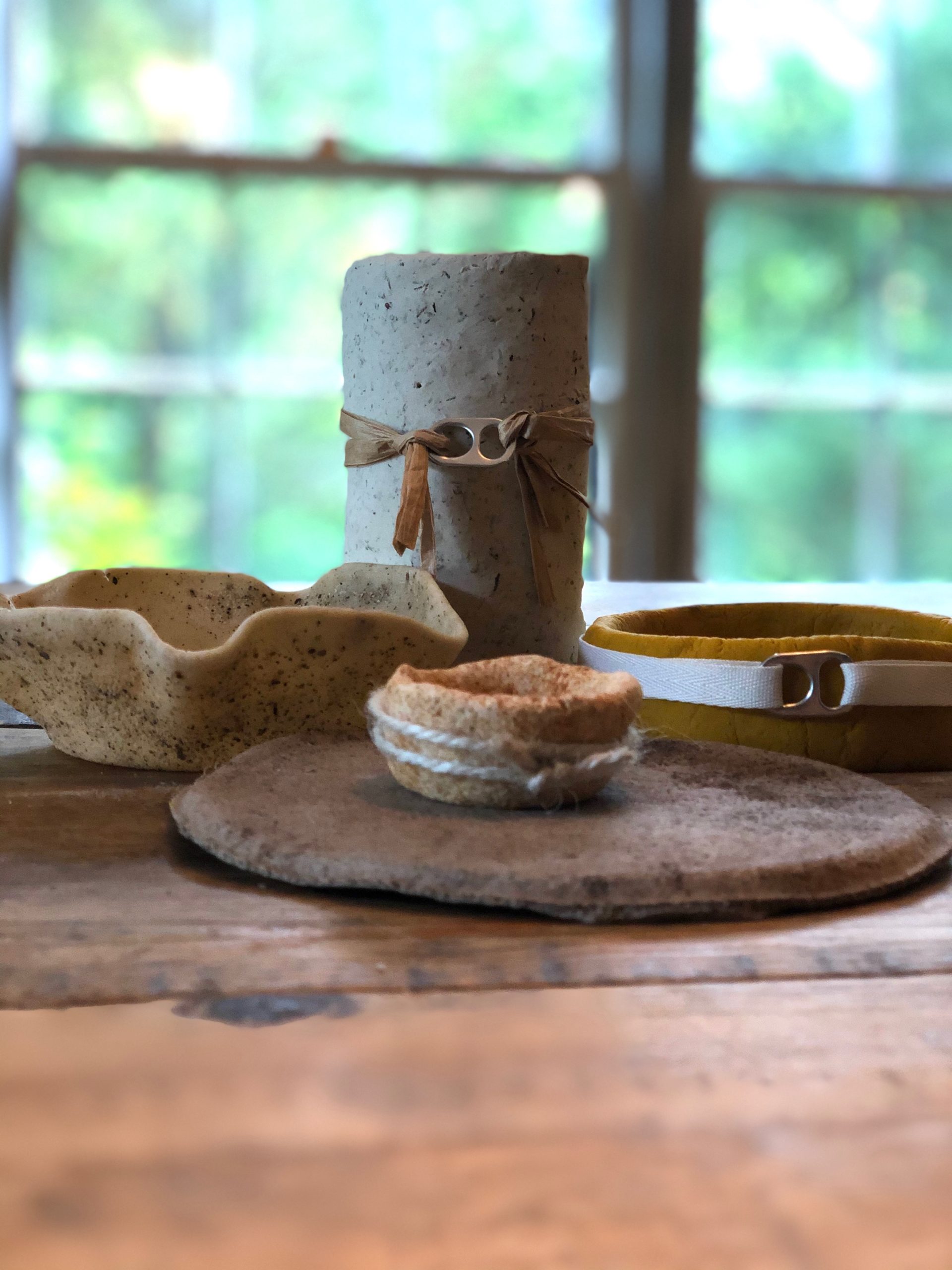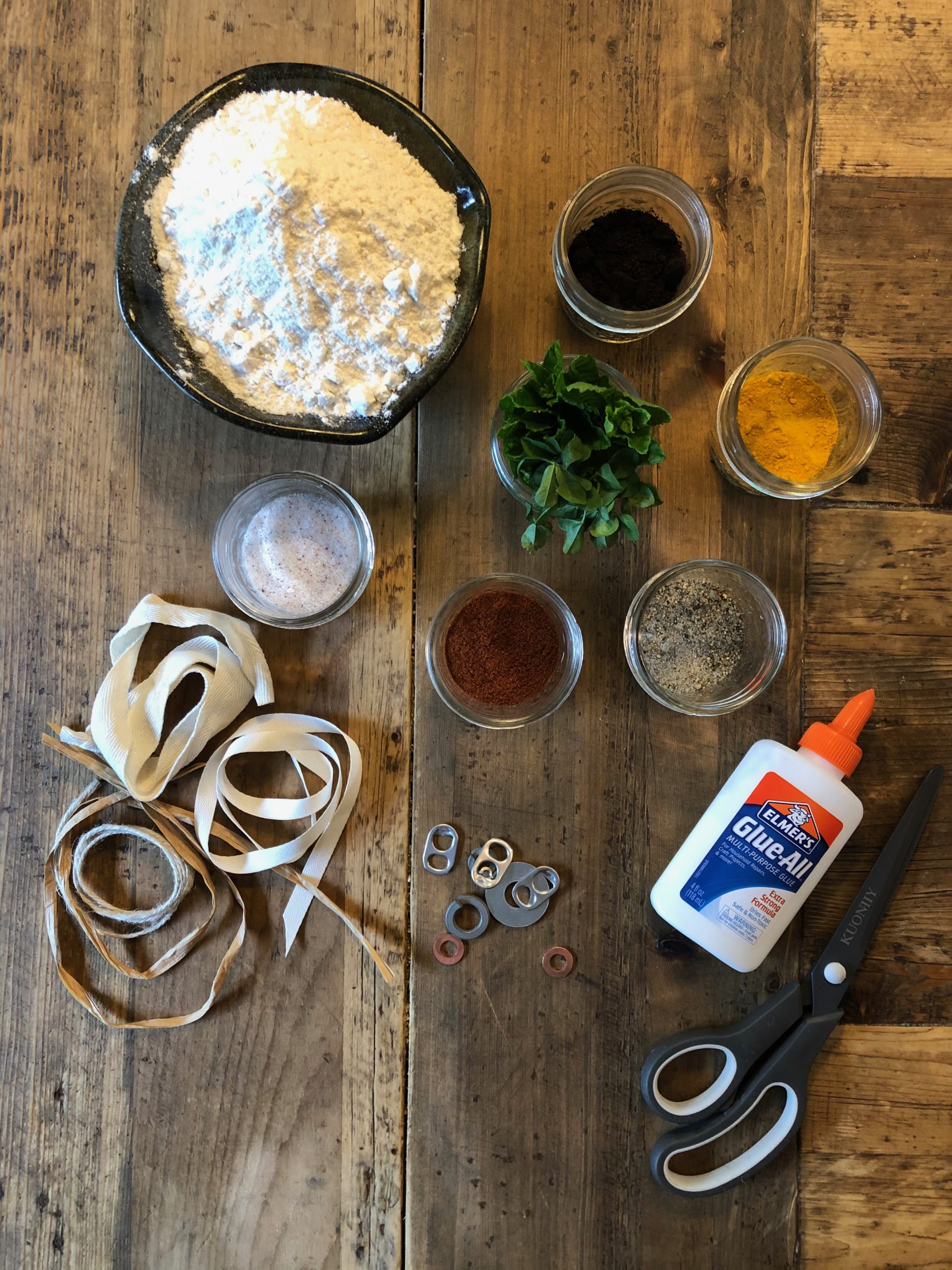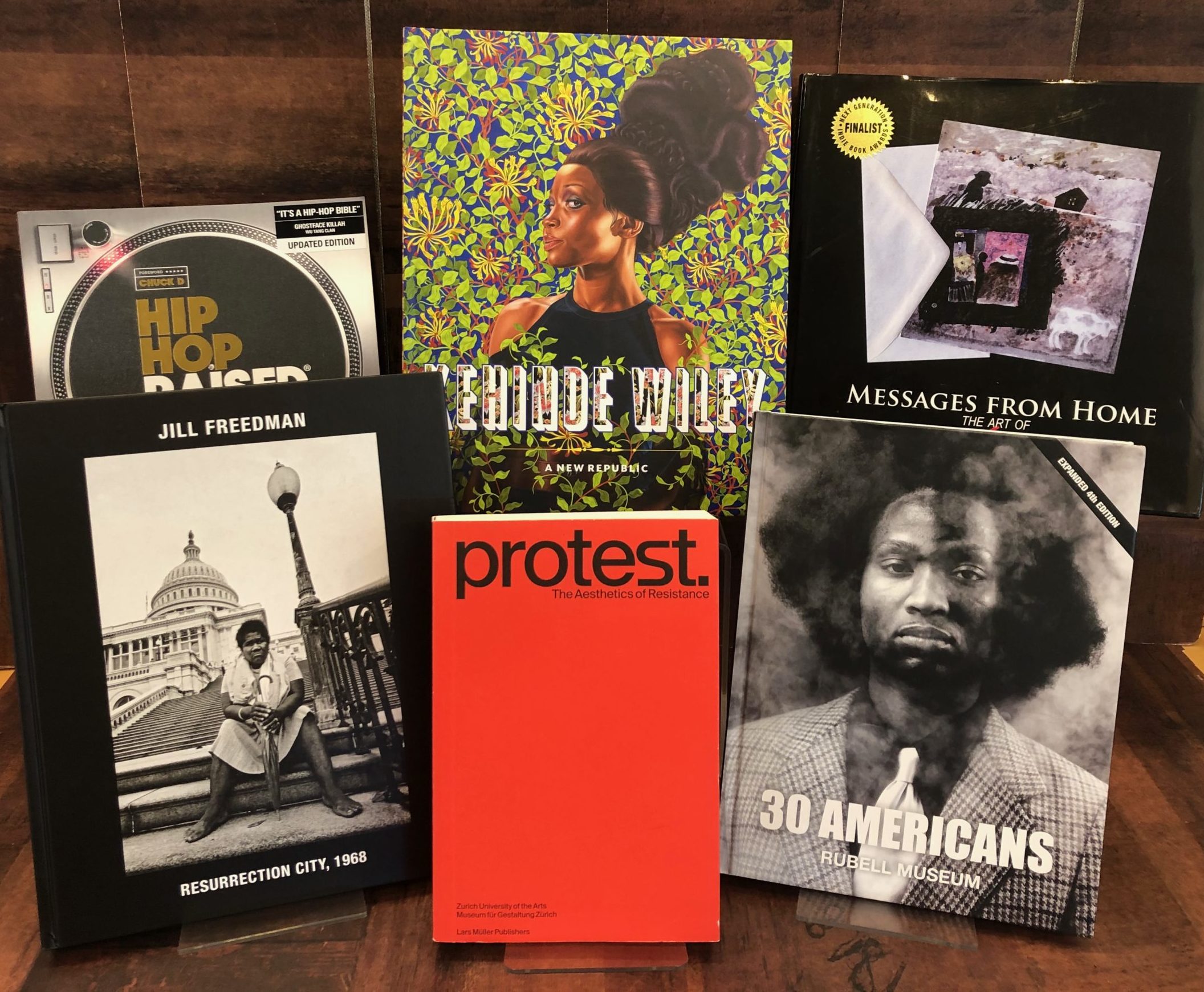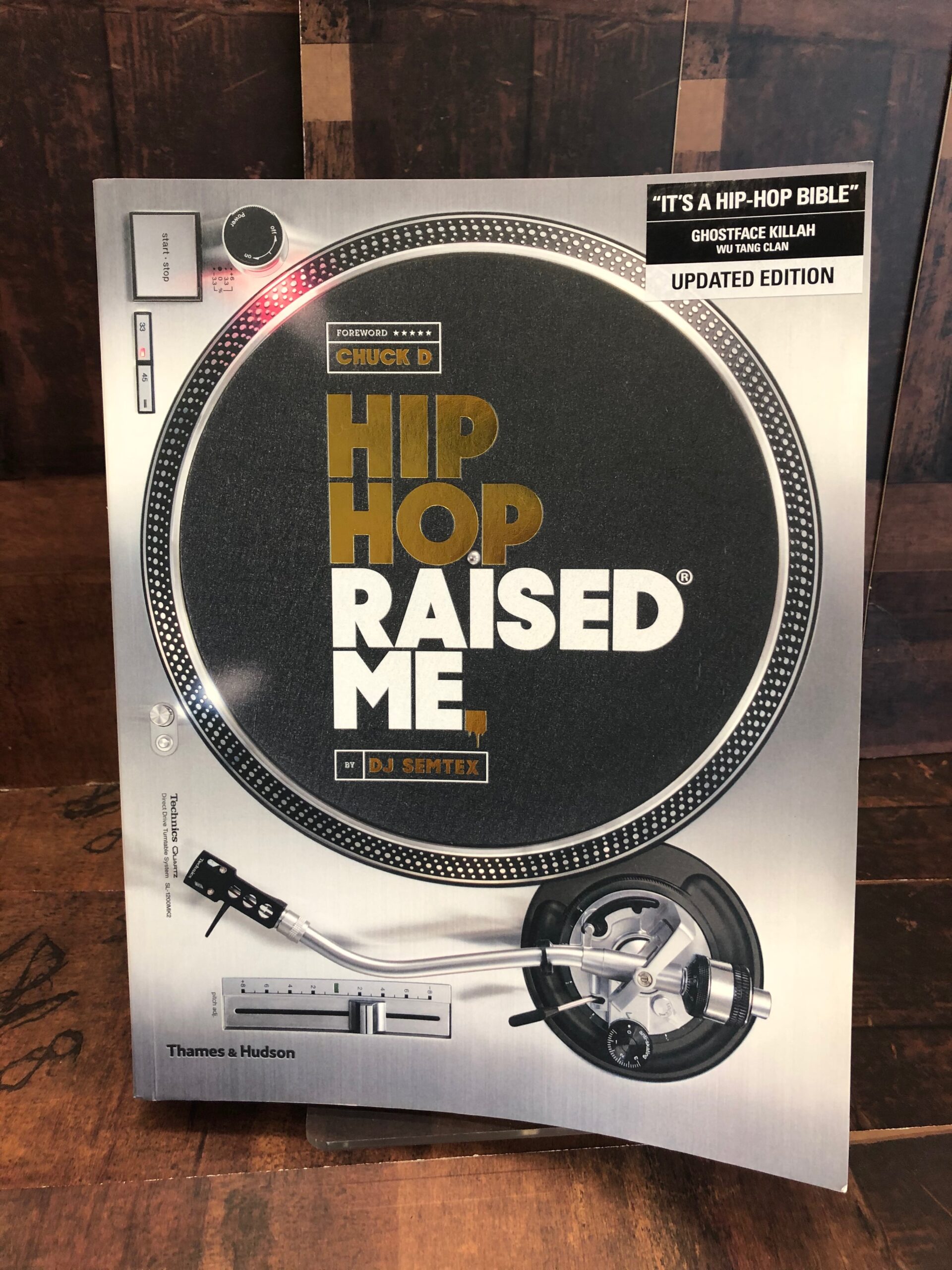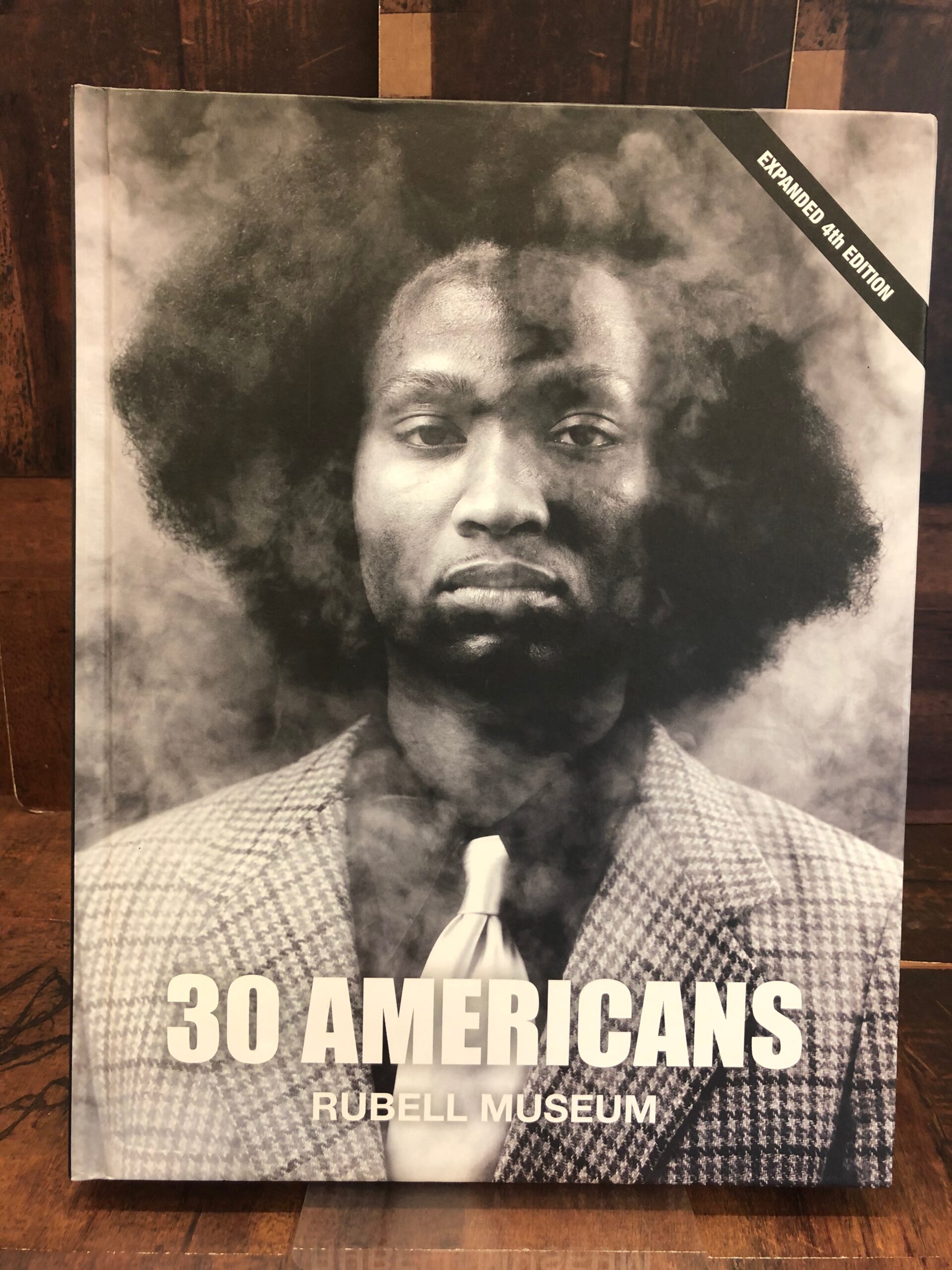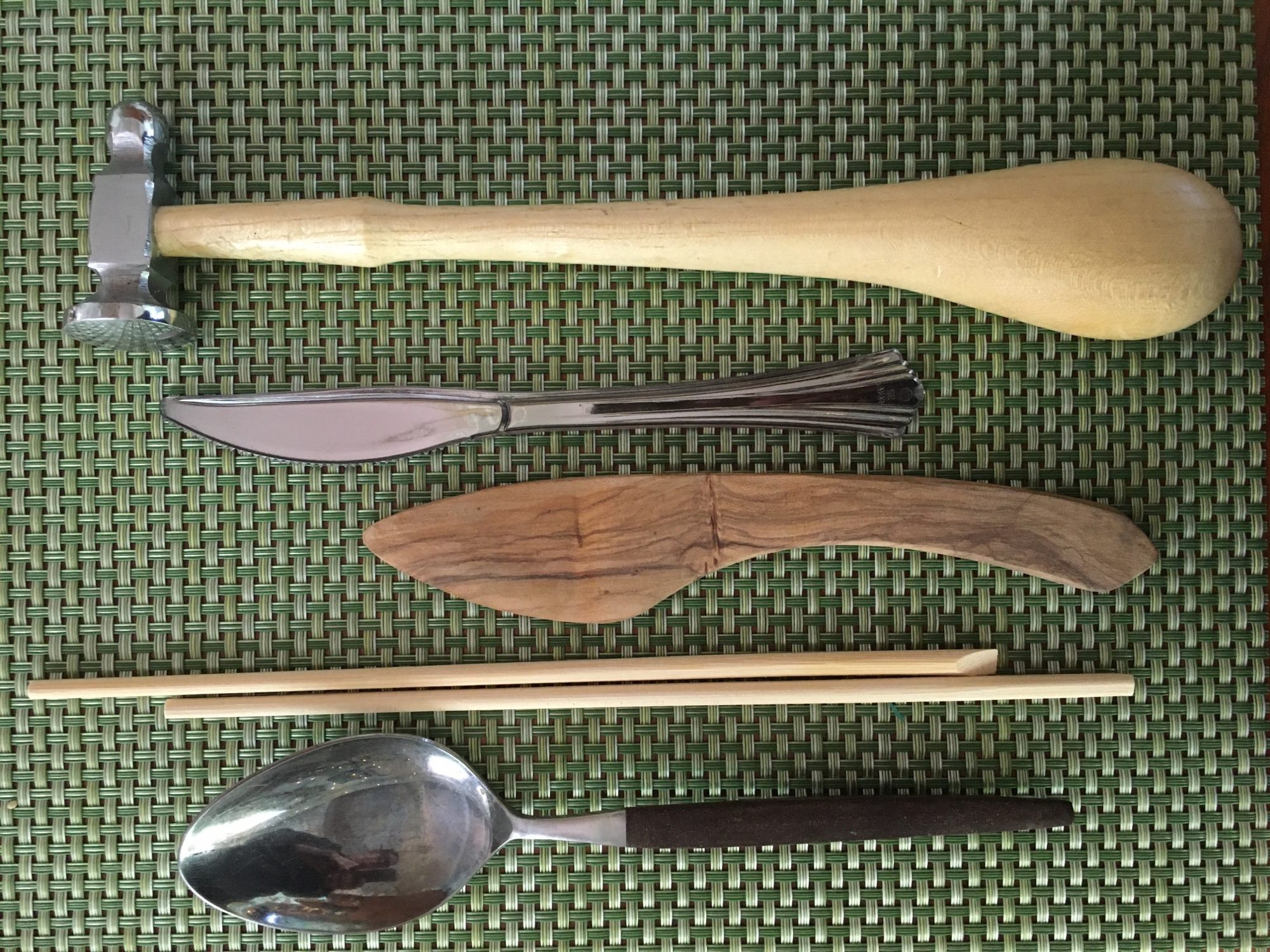Personalize your space with a tissue paper initial
Use small squares of tissue paper to create a colorful, textured initial to personalize your desk or room. This project is inspired by Pilar Albarracín’s Ceiling of Offerings, a sculptural installation made of 724 flamenco dresses suspended from the ceiling. From below, the ruffled material looks like a floating bouquet of colorful flowers.
About the Artist:
Spanish artist Pilar Albarracín creates performance, video, and installation art. She often creates challenging art about identity, culture, gender, and heritage.
Supplies:
• Cardboard cut-out of your favorite initial (or other symbol/shape)
• Colored tissue paper squares (1” and 2” work well)
• Glue
• Pencil
• Tarp or table covering that can get dirty
Steps:
Choose tissue paper colors that best represent you, and cut into small squares. Wrap the squares (one at a time) over the eraser end of a pencil to create a flower-like shape. Dab a small amount of glue to the bottom of the tissue paper, and lightly press onto your cardboard. Repeat the process until your cardboard is covered. The closer you place them together, the fuller the effect.
You can clump colors together or go with a random approach – either way, have fun! This process is simple, but you will find that it helps with focus and relaxation.Option:
Draw a block-letter initial or a symbol onto a piece of cardboard, instead of cutting out a shape. Fill in the shape first, and then fill in or paint the background area.
Challenge:
Glue a smaller size tissue square inside of a larger one to create dimension. Use a complementary color for variation.
Simplify:
Purchase pre-cut tissue paper squares.
Learn More:
• Brush up on your Spain facts with National Geographic Kids
• Watch superstar singers, musicians, and dancers in the 1995 documentary, Flamenco
This idea brought to you by Maggie Burgan.
The Mint Museum From Home is Presented By Chase.
In Vivid Color: Pushing the Boundaries of Perception in Contemporary Art investigates the power of color on our everyday perceptions and shared experiences
Charlotte, NC – Colors are linked to memories, experiences, and our environments. To celebrate the world of color and its effects on our perceived realities, The Mint Museum proudly presents In Vivid Color: Pushing the Boundaries of Perception in Contemporary Art. The exhibition is on view Oct. 16 at Mint Museum Uptown and features four innovative contemporary artists—Gisela Colon, Spencer Finch, Jennifer Steinkamp, and Summer Wheat. Installations in the exhibition are experiential by design, allowing each viewer to feel and engage with the works of art based on individual perceptions of color.
“We are so pleased to be able to share these powerful, engaging works of art with our visitors,” says Jonathan Stuhlman, PhD, senior curator of American art at The Mint Museum. “Not only do they demonstrate the wide range of innovative ways in which artists use color, but they also inspire us to reflect upon the many ways in which color infiltrates our memories, functions symbolically in our everyday lives, creates shared experiences, and sparks conversations and connections.”
Visitors are first greeted by Summer Wheat’s monumental installation Foragers in the Robert Haywood Morrison atrium. The four story, 3,720-square-foot installation fills 96 window panels with vibrant hand-cut layered vinyl gel panels that combine to tell the story of women as makers and providers. The presentation bathes the space in jewel-tone colors and hues that shift with natural light, enveloping the visitor. Foragers was commissioned for the Mint and generously funded by Wells Fargo Foundation Women Artists Fund.
Located on Level 3 in the Gorelick Gallery, immersive installations Daisy Bell and Orbit 12 by pioneering digital artist Jennifer Steinkamp explore the symbolic power of color through video technology. Using repeated floral patterns and hyper-saturated colors, Daisy Bell, which is part of Bank of America’s corporate art collection, challenges viewers to rethink their relationship with the natural world. Orbit 12, a gift to the museum from the Mint Museum Auxiliary, guides viewers through four seasons in which leaves, branches, and blossoms constantly morph through cycles of growth, abundance, decay, and renewal.At nearly 40-feet wide, Spencer Finch’s Sunset (South Texas, 6/21/03), also on loan from Bank of America, recreates a sunset on the Texas plains with green, pink, blue, yellow and orange filters fitted over fluorescent lamps. The horizontal stretch of the piece mimics the vastness of the plains and allows viewers to settle into the distance of space and color. Gisela Colon’s Hyper Ellipsoid pushes the boundaries of materials and sculptural form. Her objects, self-described as organic minimalism, use suspended pigments in acrylic to create forms that seem to shape-shift with light and motion.
The exhibition also includes 11 paintings and works on paper by artists Jennifer Bartlett, Annette Cone-Skelton, Peter Halley, Juan Logan, Harvey Quaytman, T.J. Reddy, Brian Rutenberg, Julian Stanczak, and Donald Sultan from the Mint’s permanent collection. In addition, local artist Juan Logan has loaned a painting from his Elegy series. Visitors can also play with color and light in the color shadow experience just inside the gallery.
About The Mint Museum
Established in 1936 as North Carolina’s first art museum, The Mint Museum is a leading, innovative cultural institution and museum of international art and design. With two locations—Mint Museum Randolph in the heart of Eastover and Mint Museum Uptown at Levine Center for the Arts on South Tryon Street—the Mint boasts one of the largest collections in the Southeast and is committed to engaging and inspiring members of the global community.
Contact: Michele Huggins, Communications and Media Relations Project Manager michele.huggins@mintmuseum.org, 704.564.0826
Collaged Memory Box
In this collage project inspired by Romare Bearden’s Evening of the Gray Cat, you can create an artistic Collaged Memory Box to celebrate a special person, place, or journey. Cut, paste, and collage your story on the lid, and keep favorite mementos inside the box.As a child, Romare Bearden traveled to Charlotte each summer to visit his great-grandparents. Many years later, he created a series of art called “Mecklenburg Memories,” inspired by his recollections of North Carolina in the early decades of the 1900’s.
Can you find the gray cat in this scene?
“A work of art can always keep growing. You can always add something to it each time you see it.”
-Romare Bearden
About the Artist:
Romare Bearden was born in Charlotte, North Carolina, in 1911. At a young age, he moved with his parents to Harlem, in New York City to seek opportunities that weren’t available to African Americans in the south. As an adult, Bearden became known as one of the most important American artists of the 20th century. Combining images from magazines, prints, and colored and textured papers to create collage “paintings,” his art told many stories about the Black experience, classical literature and art, and cultural history.
SUPPLIES:
• Shoe box, or any box with a lid
• Piece of paper cut the size of the box lid
• Scissors
• Glue
• Pencil
• Small paintbrush to paint glue onto paper
• Small container for glue (add a drop or two of water)
• Collage material cut from magazines, catalogs, recycled artwork, envelopes, photos, greeting cards etc.
• Optional: White paper and markers or paint to create your own collage paper
Instructions:
When you’re finished gluing, look at your collage and think about the images you chose and how they relate to your memories. What feelings come up? This gray cat feels proud that his picture made it into our collage!
Option: Write a note, short story, or poem about your project inspiration and drop it in the box. Our project was inspired by fun memories of traveling with a good friend.
Challenge: Fill the background with a grid of horizontal and vertical rectangles of different sizes and colors, then build your collage on top of it.
Simplify: Instead of a box, collage onto a colorful piece of paper. This makes it easier to fill your space.
Learn More: There are so many great resources about Romare Bearden! Below are a few. As you view his art, look for some of these themes:
Trains, large hands, birds, musicians, windows, cats, roosters, the sun, the moon
• The Romare Bearden Foundation
• YouTube Video: Trains, Snakes, and Guitars- The Art of Romare Bearden
• Family Guide for Southern Recollections, a 2012 Mint Exhibition
The Mint Museum From Home is Presented By Chase.
Celebration photos of our reopening
Mint Museum Uptown and Mint Museum Randolph re-opened to the public with a celebratory weekend of music and free admission. Look back at photos captured during the celebration.
Photos by Alex Cason. All weekend celebration activities were sponsored by Chase.
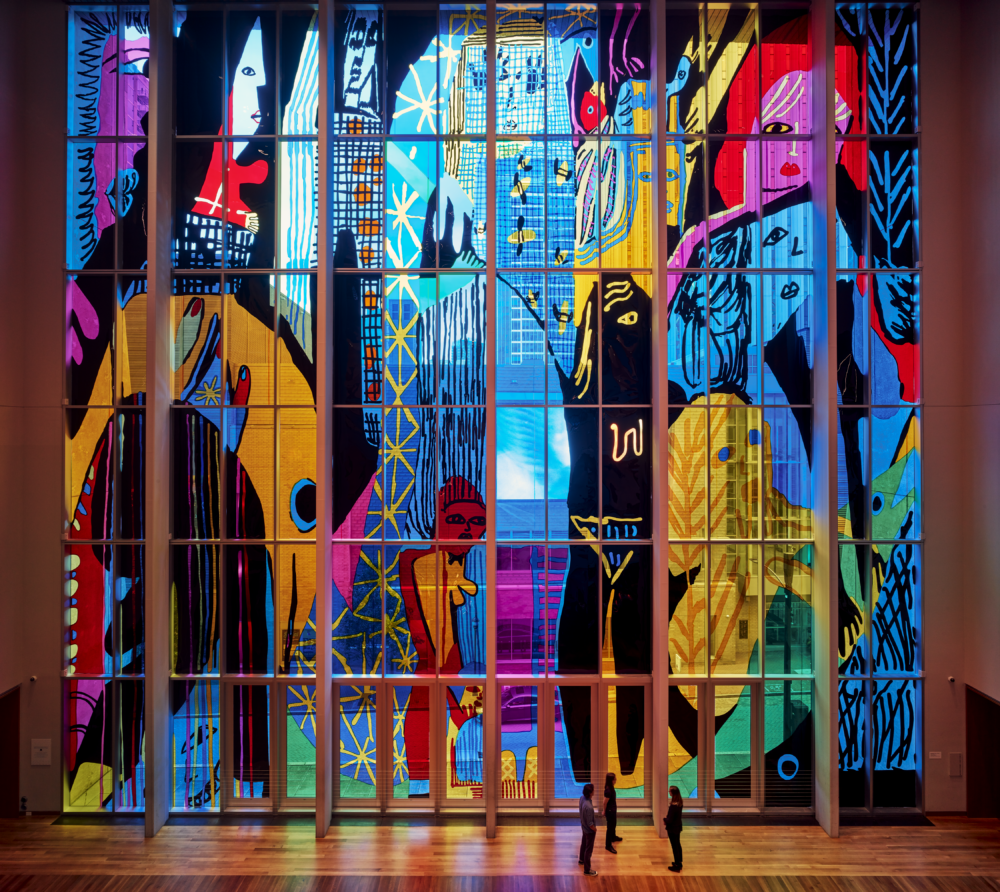
Summer Wheat (American, 1977–). Foragers, 2020, colored vinyl on mylar, 805.5 x 738.5 inches. T0263.1a-qqqq. Photo credit: Chris Edwards
September 10, 2020, Charlotte, NC — Unlike anything ever seen at The Mint Museum before, Brooklyn-based artist Summer Wheat’s Foragers is a monumental piece of public work of art spanning 96 windows, four stories, and 3,720 square feet at Mint Museum Uptown’s Robert Haywood Morrison Atrium. The myriad of vibrant panels that give the illusion of stained glass and celebrates the tradition of women as makers and providers. In so many ways, Foragers is a monumental tribute to all those anonymous female makers and laborers who have made North Carolina the place that it is today: the Catawba clay workers, the Cherokee basket makers, the enslaved and freed African-American fishers and farmers, the countless woodworkers, weavers, and quilters, says Jen Sudul Edwards, PhD, the Mint’s chief curator and curator of contemporary art.
Foragers is part of a larger exhibition In Vivid Color that opens Oct. 16 at Mint Museum Uptown. In Vivid Color brings together four innovative contemporary artists—Wheat, Gisela Colon, Spencer Finch, and Jennifer Steinkamp—who create works celebrating the power of color and its ability to permeate the space around us. Their work is juxtaposed with a selection of paintings and works on paper, drawn primarily from The Mint Museum’s permanent collection, which showcase artists’ more traditional exploration of color.
The magnitude and brilliance of Foragers turns the typical museum experience on its head and creates a transcendent space of contemplation and beauty at a time when a weary public craves an escape—and a spacious, social-distancing-friendly one at that. While standard admission rates apply to the museum’s Level 3 and Level 4 galleries, access to Mint Museum Uptown’s atrium and the Foragers installation is free.
“This gorgeous work will transform Mint Museum Uptown’s atrium space with color and light, making it a must-see destination in Charlotte,” says Todd A. Herman, Ph.D., President and CEO of The Mint Museum.Summer Wheat’s installation was commissioned by The Mint Museum. The installation and purchase of Foragers was funded by the Wells Fargo Foundation Women Artists Fund, which aims to address and rebalance gender representation in museum collections.
“The Wells Fargo Foundation Women Artists Fund is designed to address and help reconcile the imbalance of female representation in museum collections,” says Jay Everette, Wells Fargo’s senior vice president of philanthropy and corporate social responsibility.
“Just 11 percent of all acquisitions and 14 percent of exhibitions at 26 prominent American museums over the past decade were of work by female artists. According to a joint investigation by In Other Words and artnet News, a total of 260,470 works have entered museums’ permanent collections since 2008. Only 29,247 were by women.”
Foragers celebrates North Carolina’s creativity and industry—those named and anonymous.
About Summer Wheat
Contemporary artist Summer Wheat (b. 1977, Oklahoma City, Okla.) lives and works in Brooklyn, New York City. She received a Bachelor of Arts from the University of Central Oklahoma and a Master of Fine Arts from Savannah College of Art and Design. She is known for being an innovator, constantly blurring boundaries between traditional art forms and mediums. Consider the way she pushes acrylic paint through fine wire mesh to create large-scale paintings, like her With Side, With Shoulder, part of the Mint’s permanent collection and on view in the Mint’s new exhibition New Days, New Works.
Wheat has had solo exhibitions with lauded institutions, galleries and museums across the nation, including the Kemper Museum of Contemporary Art in Kansas City (2020); KMAC Museum, Louisville (2019); Shulamit Nazarian, Los Angeles (2018); Smack Mellon, New York (2018); Henry Art Gallery, University of Washington, Seattle (2017); and Oklahoma Contemporary, Oklahoma City (2016).
Wheat will also have her first solo exhibition with SOCO Gallery in Charlotte—entitled Lather, Rinse, Repeat—September 16 through November 6, 2020. The exhibition will feature ve large-scale paintings and two “pebble seats” focusing on the theme of bathing and grooming. The theme, drawn on throughout art history, frequently depicts idyllic figures and scenery, but in Wheat’s work, the women portrayed are imperfect and defy traditional notions of beauty. Wheat will have a solo exhibition with Shulamit Nazarian, Los Angeles in 2021.
Additional museum exhibitions include Institute of Contemporary Art, Boston (2013–14); deCordova Museum and Sculpture Park (2013); and Torrance Art Museum (2013). Wheat received the 2016 New York NADA Artadia Award and the 2019 Northern Trust Purchase Prize at EXPO Chicago. Wheat’s work is in the permanent collections of the Dallas Museum of Art, Texas; de Young Museum, San Francisco, CA; Peréz Art Museum Miami; The Henry Art Gallery at the University of Washington, Seattle; The Mint Museum, Charlotte, NC and the Speed Art Museum in Louisville, Kentucky.
About The Mint Museum
Established in 1936 as North Carolina’s first art museum, The Mint Museum is a leading, innovative cultural institution and museum of international art and design. With two locations—Mint Museum Randolph in the heart of Eastover and Mint Museum Uptown at Levine Center for the Arts on South Tryon Street—the Mint boasts one of the largest collections in the Southeast and is committed to engaging and inspiring members of the global community.
Recreate Ancient Ruins with leftover cardboard
You’ll just need a cardboard box and a few basic tools to create these ancient architectural ruins, inspired by the wood sculpture Pompeii by artist, architect, and furniture designer Po Shun Leong. This project can serve as a launching point to design your own imaginative architectural realm from cardboard scraps!
About the artist:
A man of many talents, Po Shun Leong creates complex wooden sculptures and boxes reimagining ancient sites like Mesa Verde, Pompeii, and Petra. He works with many different types of wood, and encourages artists to recycle their scraps into new art.
“Be joyous, use all your … scraps, and add to the sum total of beauty in this world.”
-Po Shun Leong
Supplies:
• Corrugated cardboard
• Medium- large bowl to trace
• Scissors
• Strong glue, like Elmer’s Glue-All or Alene’s Tacky Glue
• Masking tape
• Paper towel for wiping hands
Optional:
• Ruler
• Extra cardboard (paperboard like cereal boxes, paper towel tubes, etc)
Tips:
• To glue cardboard, add glue then hold the pieces together and count to 20.
• Use a small piece of masking tape to temporarily hold cardboard together while glue dries.
• Wet a cardboard box and leave it outside to dry to easily separate the corrugated layer from the smooth layers. The water dissolves the glue!
Steps:
Option: For younger artists, provide cereal boxes, tubes, and lighter paperboard, which is easier for young artists to cut and manipulate. Pre-cut some basic corrugated cardboard shapes to help trigger creative thinking.
Challenge: Start with a larger base and incorporate other recyclable materials into your design.
Simplify: Don’t worry about measurements and rulers, just start cutting shapes and let the process happen organically!
Learn more: Po Shun Leong’s website is a treasure trove of interesting information!
This idea brought to you by Leslie Strauss.
The Mint Museum From Home is Presented By Chase.
The Mint Museum presents new and never-before-seen objects from its collection in the exhibition New Days, New Works
Charlotte, N.C. When The Mint Museum is once again able to open its doors, we welcome visitors to experience a dynamic exhibition New Days, New Works that features more than 80 works of art from the Mint’s permanent collection. Many of the works of art were recently acquired or have never been on view at the Mint before.
The exhibition, on view through January 3, 2021 in the Level 4 Brand Galleries at Mint Museum Uptown, is a collaboration between all of the Mint’s curators, featuring works from the American, contemporary, craft, design and fashion and decorative arts collections. New Days, New Works is a striking juxtaposition of color, material, time and place, and the exhibition design showcases the broad diversity of pieces that define the Mint.Mere feet from African textiles made from bark by Bakuba weavers in the Democratic Republic of the Congo is a sprawling abstract sofa by Brazilian brothers Fernando and Humberto Campana. A stunning collection of 19th-century British ceramics are installed around the corner from a striking suite of black-and-white photographs from a collaboration between artists Carolyn DeMeritt and Pinky/MM Bass. And Pilar Albarracín’s Ceilings for Offerings, a large-scale installation made up of hundreds of colorful flamenco dresses, echoes the bright hues of Brooklyn-based artist Summer Wheat’s contemporary acrylic painting With Side With Shoulder that greets guests upon entering the exhibition.
“A harmony, not dissonance, resonates amongst all these disparate and different objects, and that speaks to the commonality we all have as human beings,” says Jen Sudul Edwards, PhD, the Mint’s chief curator and curator of contemporary art. “No matter the human condition, people want to find a way to live their best life, with beauty and security, and no matter the technological innovations we may invent, human beings are always intrinsically tethered to the natural world.”Each object in New Days, New Works celebrates the relationships with individual donors, corporations, foundations and support groups that are all part of The Mint Museum community.
“New Days, New Works is an opportunity for us to show some of the new works that have come into the collection in the last few years, as well as to highlight those donors who have generously shared their treasures with the Charlotte community by donating them to the Mint,” says Todd A Herman, PhD, President and CEO of The Mint Museum. “The work is diverse and demonstrates the many areas of interest among our supporters. We also hope that by reading about the various collectors, it will inspire others to begin their own collections, which can start at a wide range of price points, styles and materials.”
About The Mint Museum
Established in 1936 as North Carolina’s first art museum, The Mint Museum is a leading, innovative cultural institution and museum of international art and design. With two locations—Mint Museum Randolph in the heart of Eastover and Mint Museum Uptown at Levine Center for the Arts on South Tryon Street—the Mint boasts one of the largest collections in the Southeast and is committed to engaging and inspiring members of the global community.
The Mint Museum plans to re-open to public for free weekend Sept. 25-27
September 1, 2020, Charlotte, N.C.— In light of Gov. Roy Cooper’s decision to allow museums to re-open at 50 percent capacity in Phase 2.5, The Mint Museum is thrilled to announce it plans to welcome the public back with a free weekend and celebration, presented by Chase, at both museum locations the weekend of Sept. 25-27. (Mint members will be able to return beginning Tuesday, Sept. 22.) A strategic planning team has been working for months on re-opening plans and precautions. The museum is excited to open its doors again with a host of exciting new exhibitions and installations to share.
The Mint is also talking with several other museums in the city to possibly coordinate re-opening events.
“This is the great news we’ve been waiting for over the last five-and-a-half months,” says Mint President and CEO Todd A. Herman, PhD. “We appreciate the governor’s recognizing the special place museums hold in the community.”
Guests to The Mint Museum will be met with new exhibitions and installations, including:
- Foragers by Brooklyn-based artist Summer Wheat: This monumental four-story “stained glass” work of art will cover all 96 windows of Mint Museum Uptown’s Robert Haywood Morrison Atrium. Foragers is a tribute to all of the female makers and laborers who helped make Charlotte the thriving metropolis it is today. Foragers is generously sponsored by the Wells Fargo Women Artists Fund. It will be on view when the museum re-opens.
- New Days, New Works: The exhibition showcases 80 works of art from the Mint’s permanent collection, many of which have never been on view before. New Days, New Works is a striking juxtaposition of color, material, time and place—from a suite of black-and-white photographs done in collaboration by artists Carolyn DeMeritt and Pinky/MM Bass to artist Pilar Albarracín’s Ceiling for Offerings, a work made up of hundreds of colorful flamenco dresses that hang from the ceiling.
- Local artist de’Angelo Dia is the latest Constellation CLT artist, whose work is on view in the public spaces of Mint Museum Uptown. His works portray characters with bold expressions and elements that explore African-American culture and the hybrid culture of the African diaspora.
Classic Black: The Basalt Sculpture of Wedgwood and His Contemporaries, on view at Mint Museum Randolph, has been extended through January 3, 2021. The exhibition features 100 black basalt sculptures made by Josiah Wedgwood and other Staffordshire potters in late 18th-century England, and is set against the distinctive linework and colorful gallery walls painted by local mural artist Owl.
Museum tickets will be available for purchase through our website, as well as iinformation on safety protocols. We encourage guests to purchase online, though in-person ticketing is still available.Contact: Michele Huggins
Media relations and communications project manager
michele.huggins@mintmuseum.org, 704-564-0826 (c)
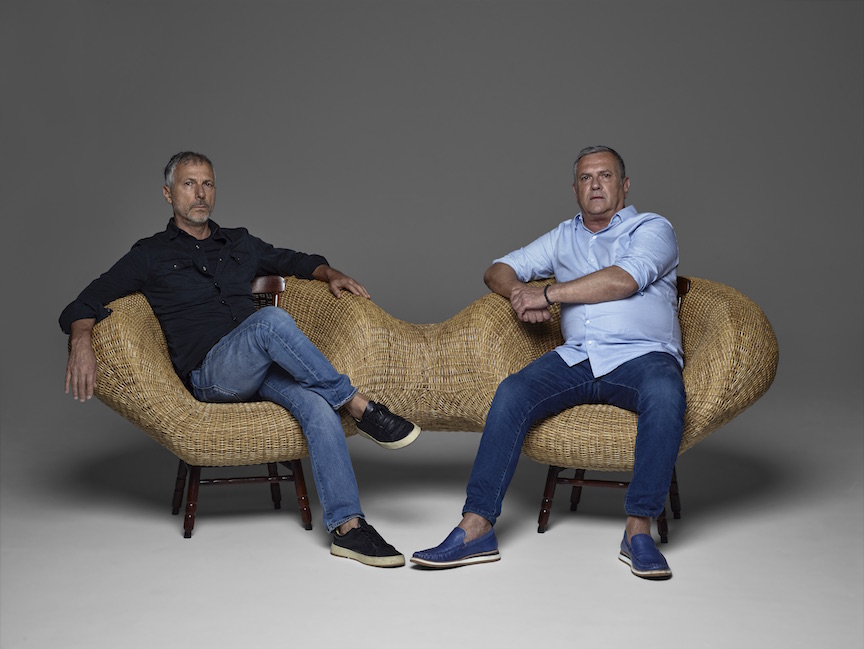
Humberto and Fernando Campana. Photo by Bob Wolfenson
“Through experimentation and our life experiences, we allow the creative chaos to take over and, eventually, we discover combinations of colors and materials”
Pioneers of disruptive design, the art of Fernando and Humberto Campana is strongly rooted in Brazilian culture and traditions, and carries universal values in its core, such as freedom and human dignity, by searching self-identity through life experiences. By incorporating the idea of transformation and reinvention, their creative process raises everyday materials to nobility, bringing not only creativity into design, but also Brazilian characteristics — the colors, the mixtures, the creative chaos — the triumph of simple solutions, in an artistic and poetic way, including the piece “Kaiman Jacare” that is part of Mint’s permanent collection and in the latest exhibition New Days, New Works.
Based in Sao Paulo, Estudio Campana is constantly investigating new possibilities within design: from furniture making to architecture, landscaping, fashion, scenography and more, and are represented throughout the world. Below the brothers share about how they work together, their creative processes and inspirations, and hope for the future.
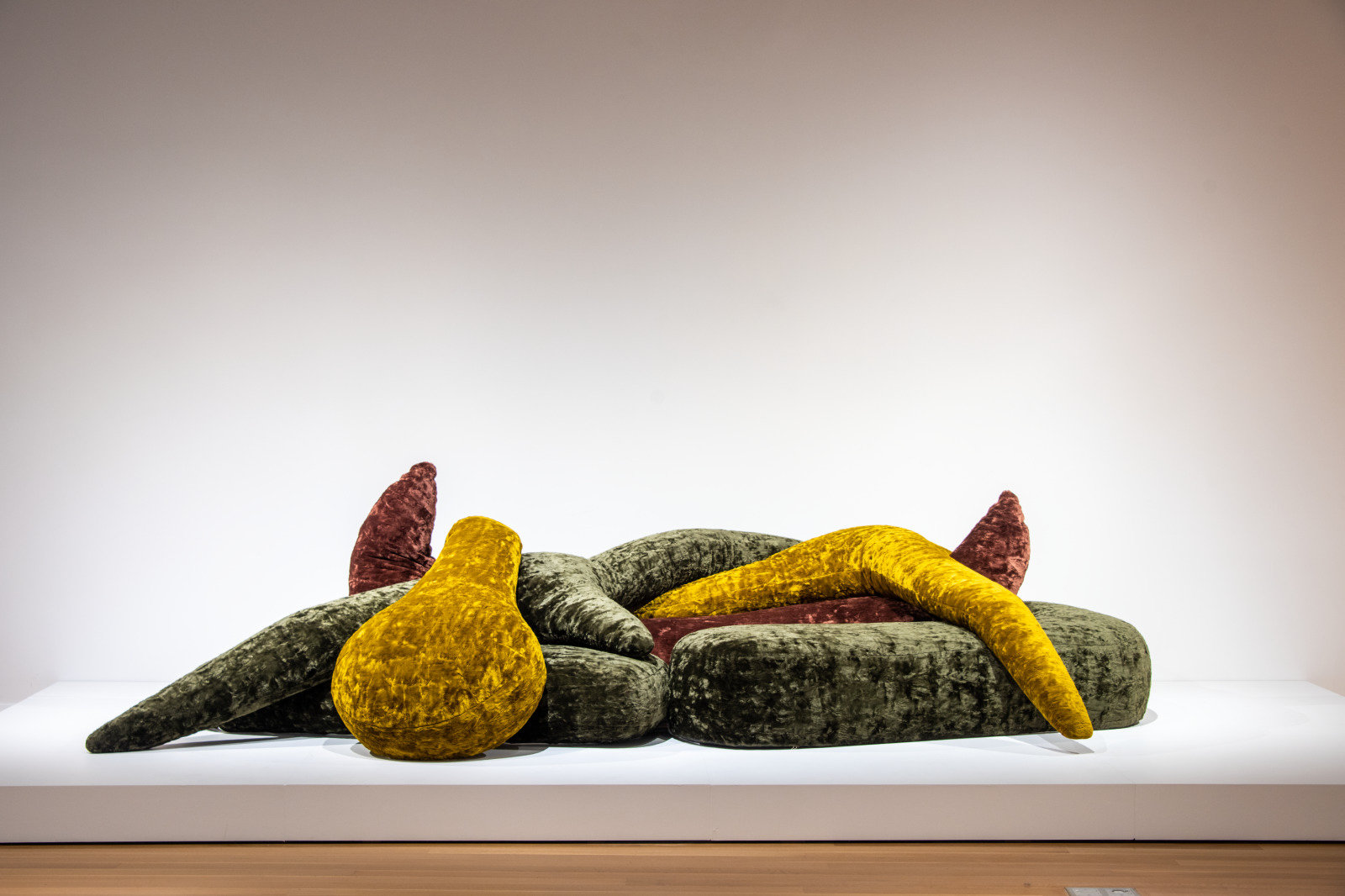
Fernando Campana (Brazilian, 1961–). Humberto Campana (Brazilian, 1953–). Kaiman Jacaré Sofa, velvet, polyurethane. Gift of the Tony Podesta Collection. 2014.75.12
Tell me a bit about yourselves and the type of art you specialize in.
We are storytellers, we like to bridge disciplines and try not to define ourselves by a particular type of art. Our mantra is to let materials “speak” to us, from which point we discover what shape and function it can take. Through experimentation and our life experiences, we allow the creative chaos to take over and, eventually, we discover combinations of colors and materials (many times overlooked by most designers) that tell the stories from that experience, artistically and poetically.
Where is your studio located?
Our studio is located in São Paulo, Brazil, in a neighborhood called Santa Cecília. Today it is considered a cool place, thriving with hype galleries, bars, shops and restaurants, right next to mom-and-pop shops, discount clothes stores, little hardware stores. When we started our practice there, back in the 1990s, it was considered a “no-go” zone due to the humble buildings and working-class population, but that’s exactly why we were attracted to it, for it was genuine and grassroots.
What’s it like working together from creation to execution of your artwork?
Humberto: Fernando and I complement each other very well. He starts from a bi-dimensional concept, making drawings, and often I bring that idea to life by researching materials, establishing a process, until it takes shape and comes into existence. I am interested in this process, and what happens behind the scenes, the role of the piece as it occupies a place in people’s homes. Fernando offers a distant gaze to my ideas, bringing a fresh outlook.
Fernando: It’s fair to say we have almost like a twin connection, certainly a spiritual one, although our thought process is different. When we are developing a new piece, there is an unspoken agreement between us, which is not always that smooth, but always with mutual respect. We also count with the support of our team at the studio, to help settle any standoffs.
What was your inspiration for Kaiman Jacare?
Our inspiration was the pre-historic animals, the dinosaurs. The idea was to create an oversized piece of furniture that resembles a tangle of giant scary creatures from that era. Each piece can be detached and reattached, allowing you to come up with several combinations. It’s a very comfortable, inviting, huggable composition, yet, it plays with the sense of being surrounded by these dangerous creatures, which we find quite provocative.
What is your favorite piece you’ve created?
Fernando: My favorite piece is still a very classic one, the Vermelha armchair, from 1998. We were fiddling around with different materials trying to come up with unusual upholstering when we picked up this roll of 500 meters of red rope and began to wrap it around a metal structure. It is our signature piece, produced by Italian manufacturer Edra, and part of several museums around the world.
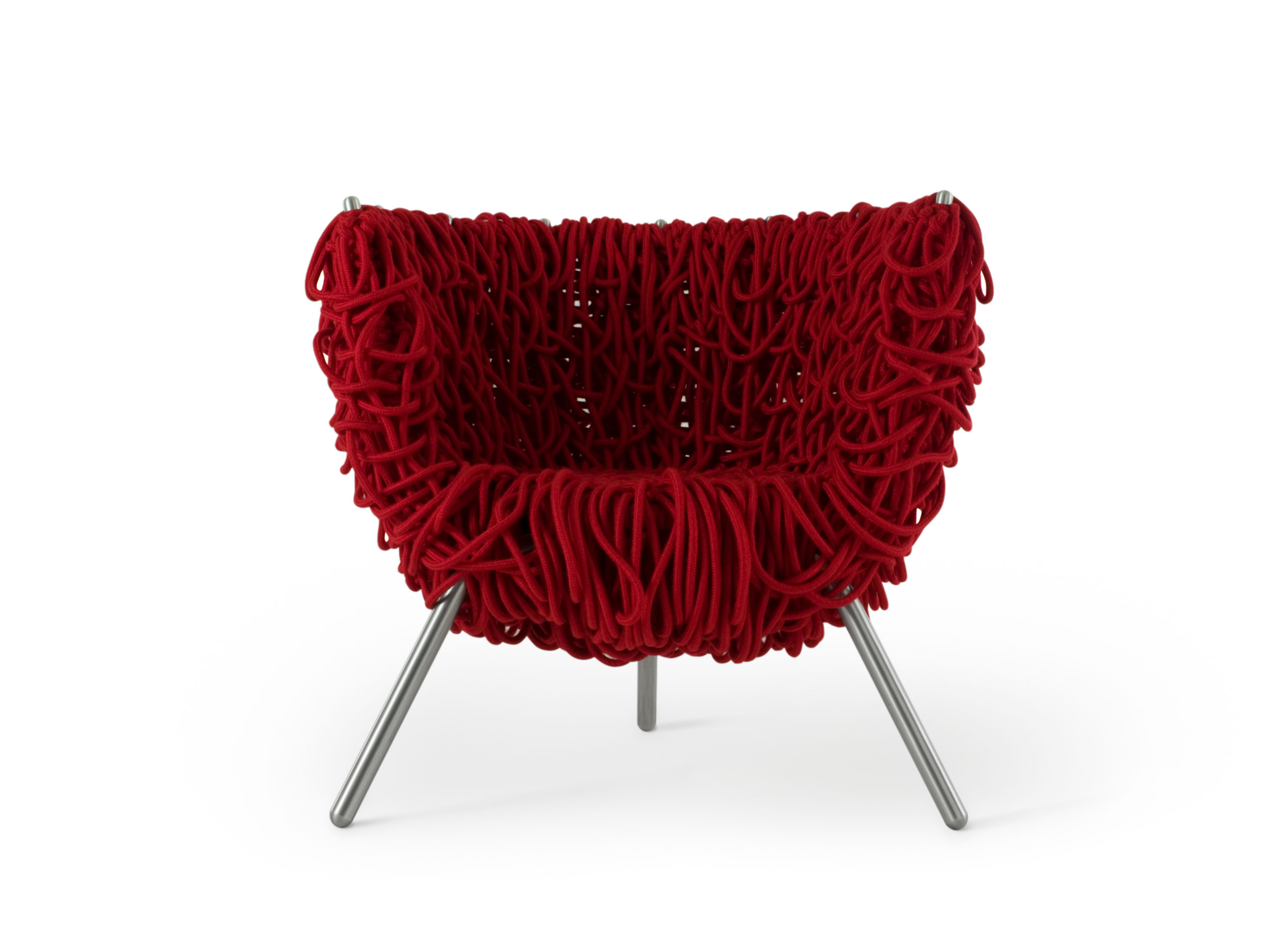
1998, Vermelha Armchair @ Edra.
Humberto: I am very fond of our Plush Toy collection (2002) because it has a deep connection with affection. It started as an experiment to find new ways of upholstering, and soon it transformed itself into this whimsical universe reminiscent of our childhood, the memory of a favorite stuffed toy, and the sense of protection and comfort.
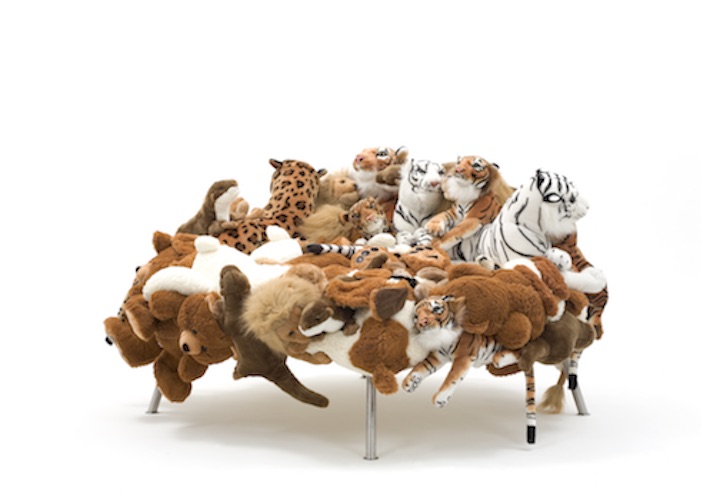
Cake Stool, Courtesy of Estudio Campana. Photo by Fernando Laszlo
How do people and your environment influence your art?
Fernando: These are an enormous influence for us, no doubt. We portray what we experience in our daily lives, especially in a country so culturally rich such as Brazil, with a unique viewpoint. Also, we grew up in the countryside, and nature was our main source of inspiration. Time had a different pace, giving us the chance to observe the landscape and animals in every season. That gave us the ability to pay attention to life as it unfolded. Once we moved to the city, we applied that same gaze towards people and their way of living, giving us a solid foundation for our design practice.
Humberto: Our work is like a snapshot of the world we experience. Places like the outskirts of São Paulo, Shanghai, the Amazon, the Sahara Desert, plus the people we encounter along the way. All of that fuels our imagination which is then materialized into objects.
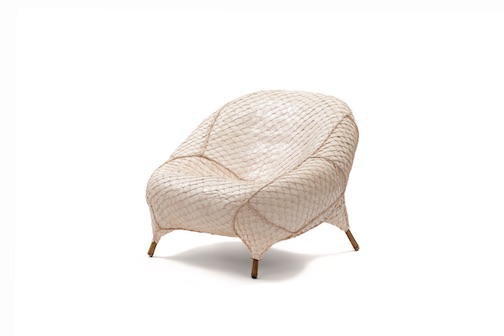
2016, Pirarucu Armchair Pink. Courtesy of Estudio Campana. Photo by Fernando Laszlo (4)
Are you finding new inspiration for your art during these current events in the world?
Fernando: It’s been pretty hard to find inspiration, but I had the chance to travel to the countryside and the seaside during the quarantine, keeping a distance from the industrial world and immersing myself in nature. This period will gradually percolate and eventually, something will come out of it, creatively speaking.
Humberto: At the beginning of the quarantine, I was quite upset like everyone else. Aside from the tragic loss of life, we also have terrible leadership in Brazil. After a while, I began to come to terms with the fact I had to stay at home, and suddenly my house became my universe. I discovered ways of creating with what I had at hand, in the space I had. Lately, I have been doing collages and assemblages, and it has helped me a great deal to stay creatively active.
What positive-perspective changes in society would you like to see evolve from the protests, pandemic and social struggles of now?
Fernando: I would like humanity to be more respectful of the environment. And a more fraternal society, where we look out for each other. We had enough destruction, deforestation and pollution on this planet. It’s time we take responsibility for our actions and stop producing waste that keeps corroding our home.
Humberto: I think the world today is too divided. This antagonism doesn’t take us anywhere, it only leads to destruction with no clear way out. I wish people would become more united, have more respect and affection for each other, leaving their ego aside, so that we can find and follow a path to coexistence.
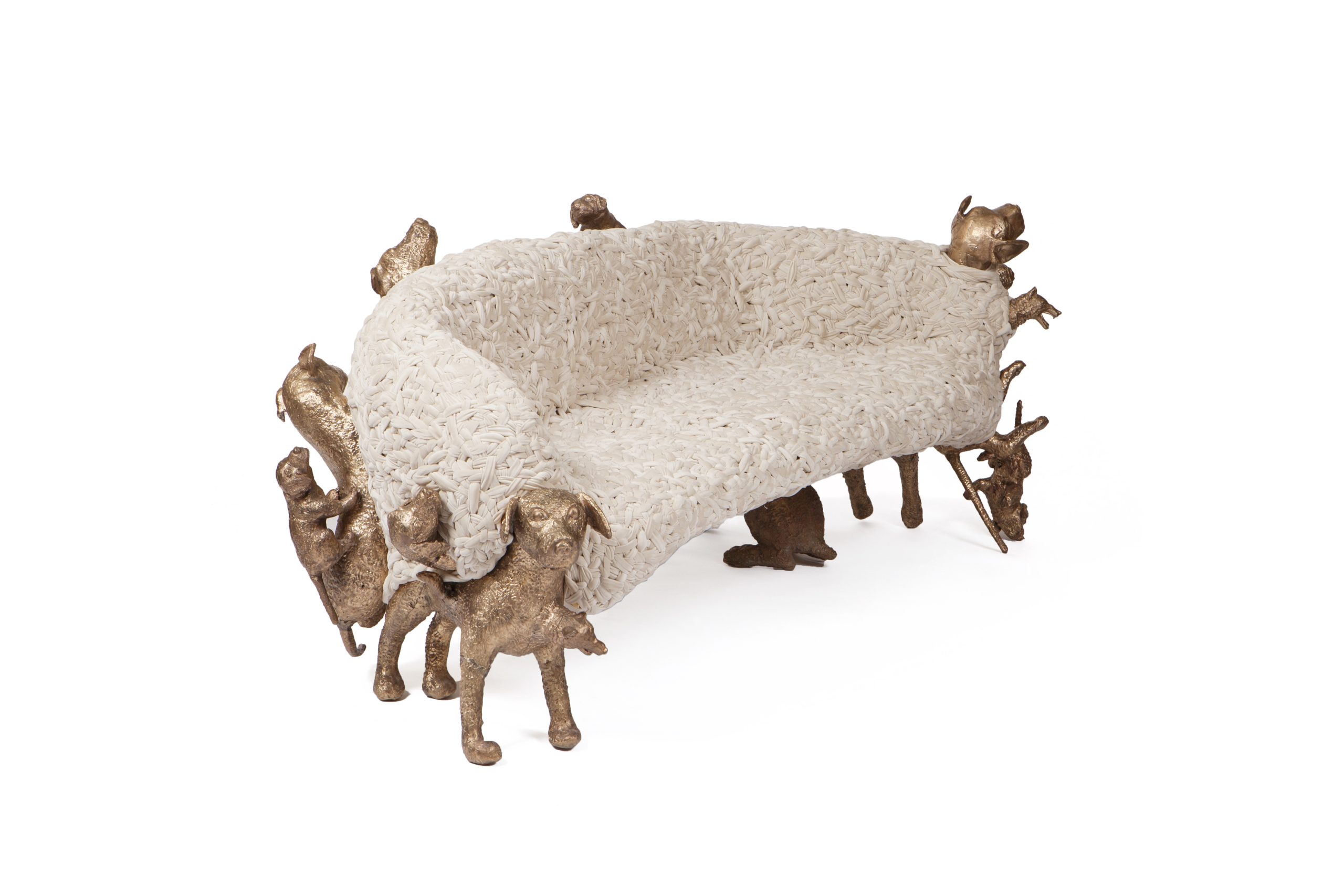
2018, Noah bench 2. Courtesy of Estudio Campana. Photo by Fernando Laszlo (13)
What are you reading, watching, and listening to these days?
Fernando: I just finished reading Les Misérables by Victor Hugo. I am also watching a few series on TV. One is called Girls from Ipanema which takes place in the ’60s, in Rio, during the Bossa-Nova years. I like to listen to all kinds of music, but Brazilian Popular Music (MPB) is always on top of my list.
Humberto: I have been reading articles about iconic designers and architects in English. I enjoy learning more about their life trajectories while reading them aloud and practicing the language.
Who are you following on social media right now?
Fernando: I am a bit of an outcast when it comes to social media. I don’t have any accounts on any platform. I am not attracted to this type of thing. I am much more interested in the real world.
Humberto: I am currently following Design Academy Eindhoven on Instagram (@designacademyeindhoven), from The Netherlands. I admire not only their outstanding conceptual design program, but also their intrinsic concern with training students to produce work in favor of a better planet.
The Mint Museum From Home is Sponsored by Chase.
Unique art prints made from bubble wrap
Who doesn’t love bubble wrap? Here is a simple printmaking activity using just bubble wrap markers, and paper. Children of all ages can color designs onto any type of bubble packaging and make prints. The prints can then be used to make cards, wrapping paper or displayed as art! The possibilities for creativity are endless. If you can keep yourself from popping the bubbles, you can rinse them off and use them again and again!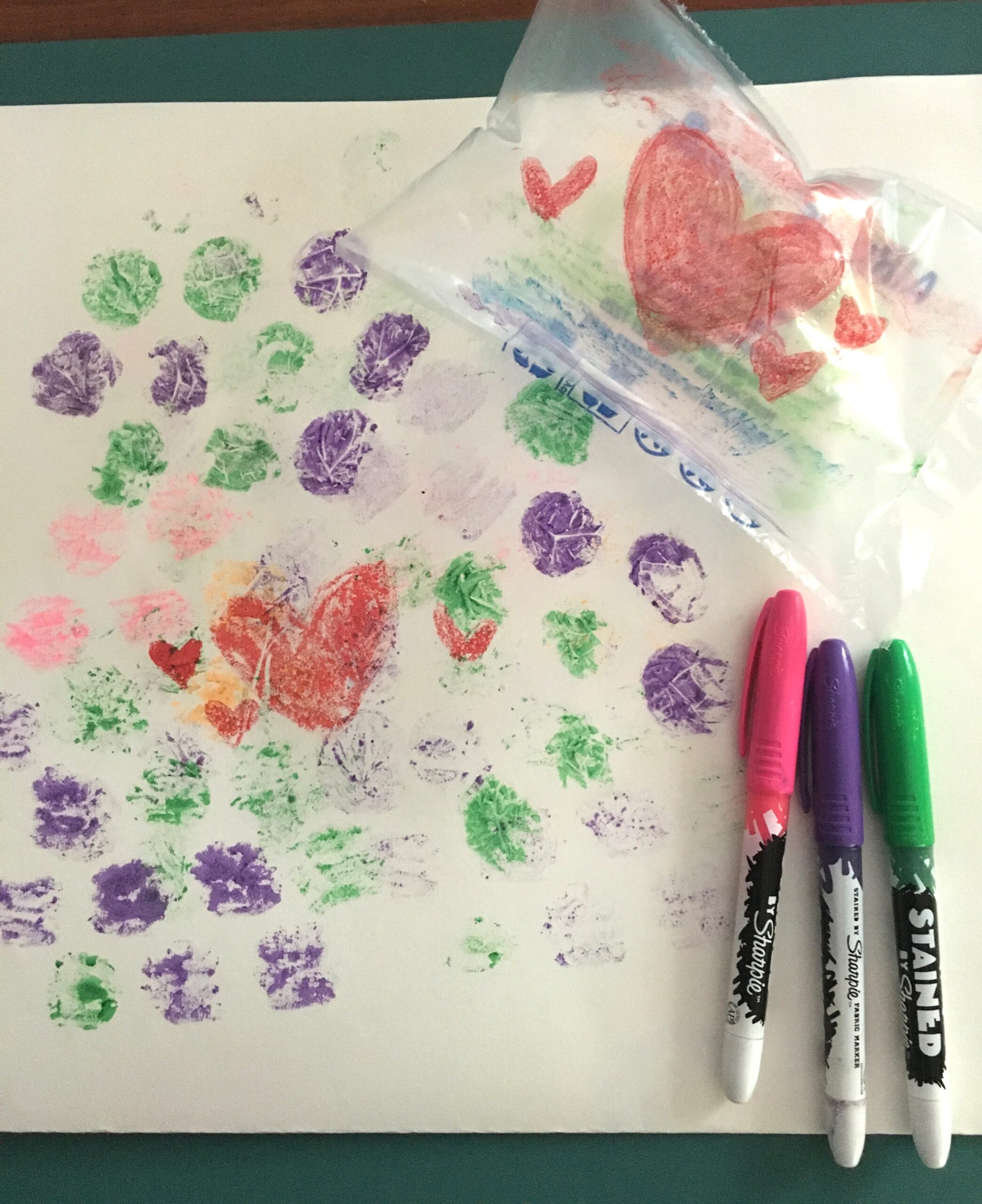
This project was inspired by Bubble Wrap by Courtney Starrett, on view at Mint Museum Uptown.
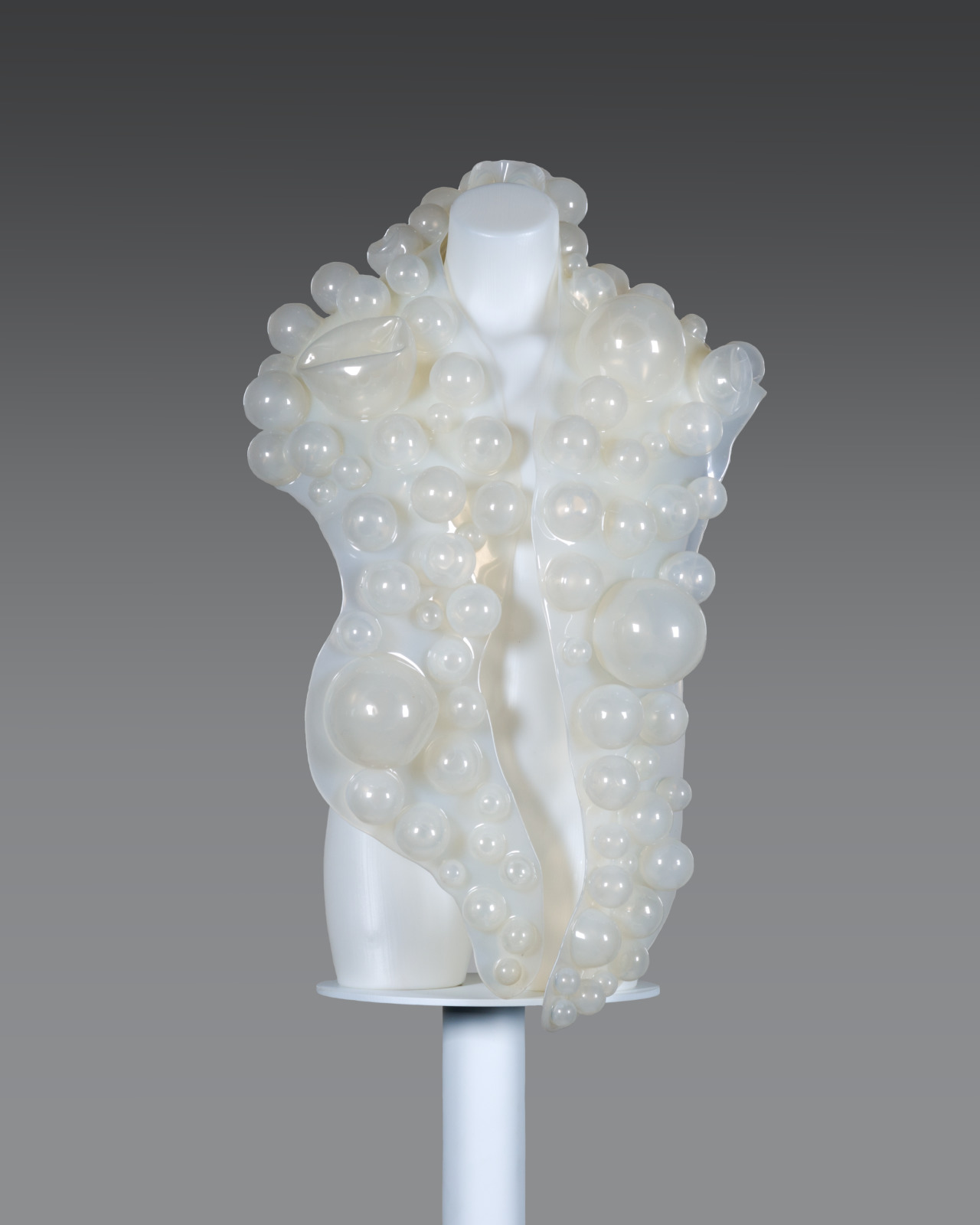
Courtney Starrett (American, 1977–). Bubble Wrap, 2008, silicone. Gift of the Artist. 2015.47
SUPPLIES:
- Copy paper or construction paper
- Scissors
- Bubble wrap in assorted textures/sizes, cut into pieces or shapes
- Assorted colored markers
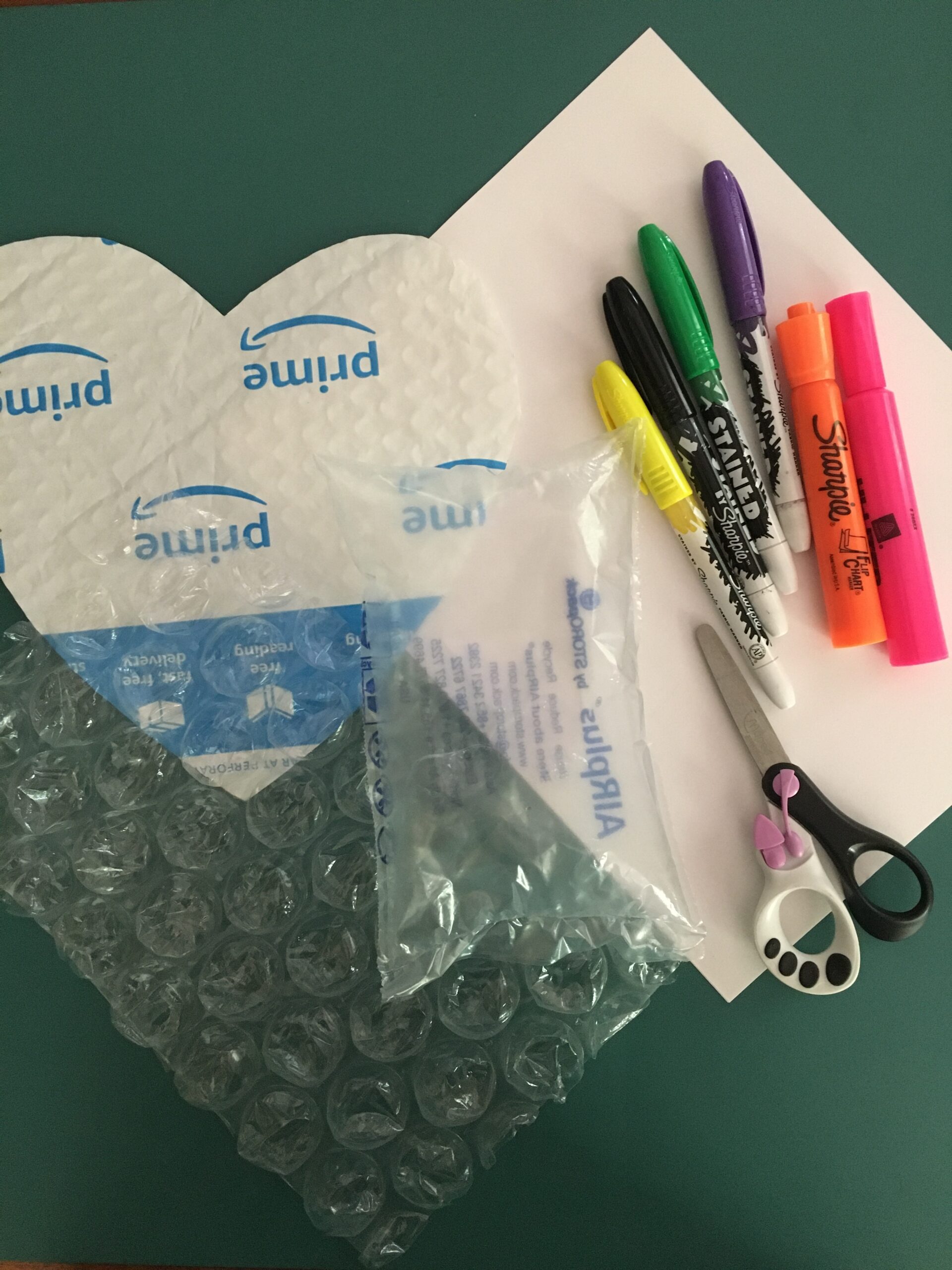
Instructions:
The Mint Museum From Home is Presented By Chase.
Three ingredients plus three steps to make your own signature clay pots
Baking is one of the little things that brings us joy while at home during the pandemic. Creating objects from common baking ingredients bridges the relationship between industry, craft, and consumer. A basic clay can be made from flour, salt, and water. Have fun using spices, such as turmeric and paprika, along with compost like coffee grinds to add texture and color to your clay.
This project is inspired by Autoarchy on view at Mint Museum Uptown.
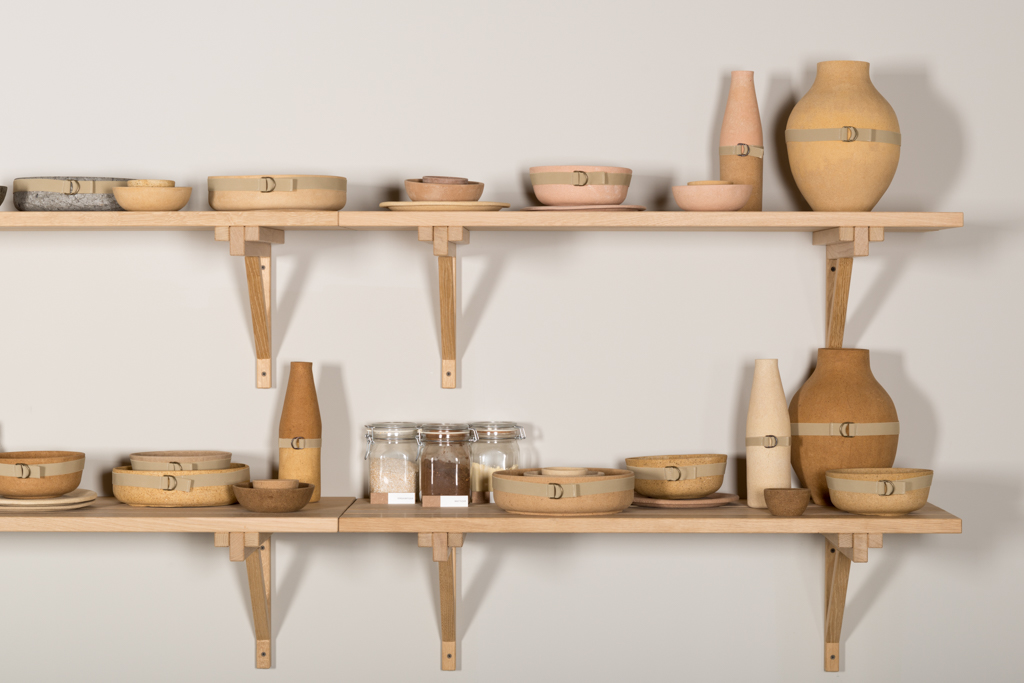
Studio Formafantasma (Eindhoven, The Netherlands, 2009–), Andrea Trimarchi (Italian, 1983–), Simone Farresin (Italian, 1980–). “Autarchy,” 2012, flour, agricultural waste, vegetable dyes, beeswax, pine tar. Museum Purchase: Funds provided by Missy Luczak-Smith and Doug Smith. 2013.18.1-158
[cs_divider color=”#b7b7b7″]
SUPPLIES:
- Flour
- Salt
- Cold water
OPTIONAL ITEMS
- Spices or kitchen compost
- Rolling Pin
- Wax paper
- Ribbon or rope
- Metal tabs from soda cans or washers
- Glue
- Scissors
[cs_divider color=”#6e6e6e”]
STEPS:
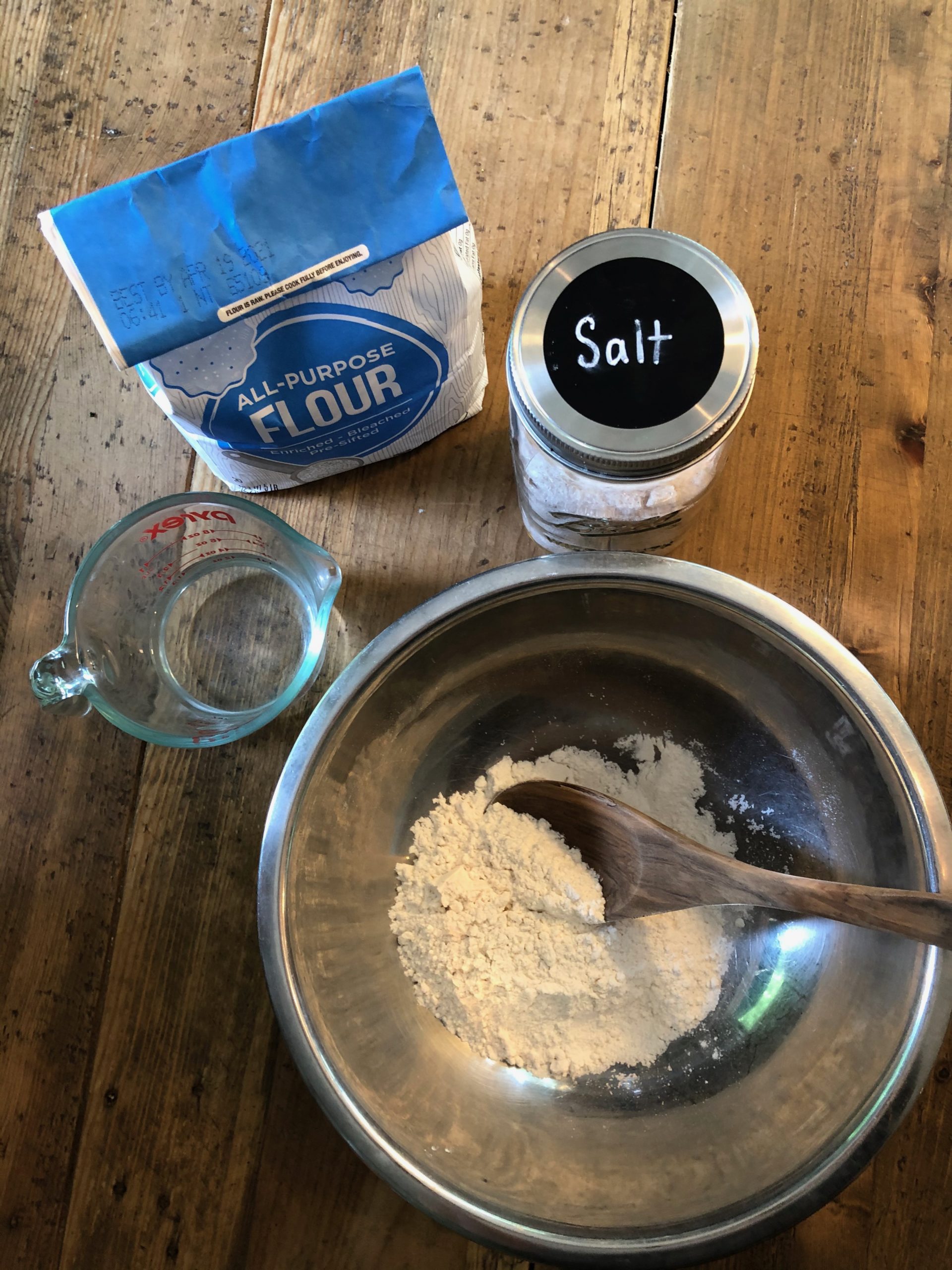
Start with 1 cup flour and 1 cup salt. Add spices or other kitchen ingredients for color and texture. Slowly add up to one half cup cold water while mixing together to form a ball. It helps to knead the clay for several minutes. Add a few more drops of water if the clay is not holding together.
Consistency will vary depending on what type of flour you use and what you mix in.
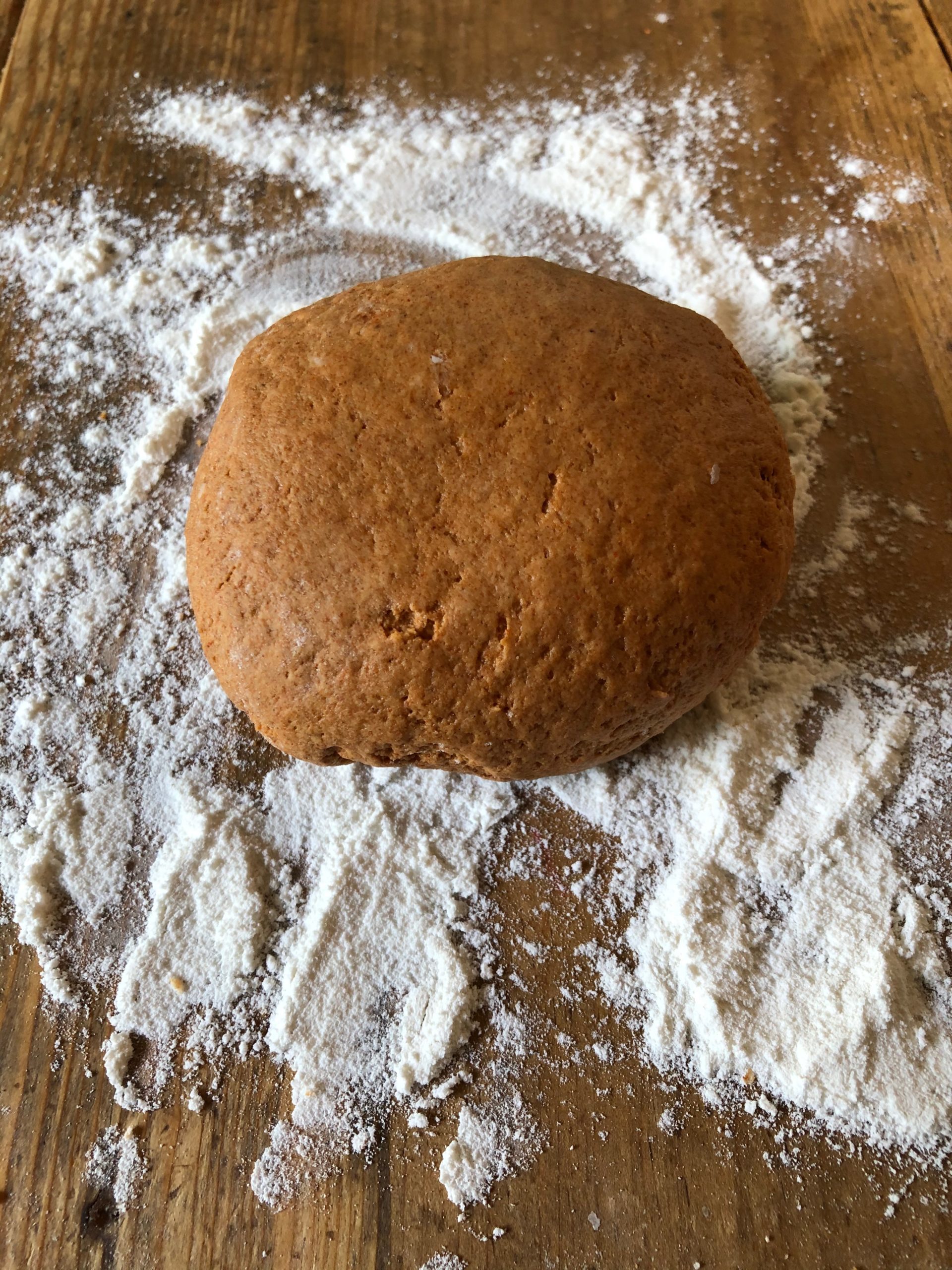 If the clay is too soft, knead in more flour until you have a clay that can stand when shaped. Divide dough and form into pots, bowls, or plates.
If the clay is too soft, knead in more flour until you have a clay that can stand when shaped. Divide dough and form into pots, bowls, or plates.
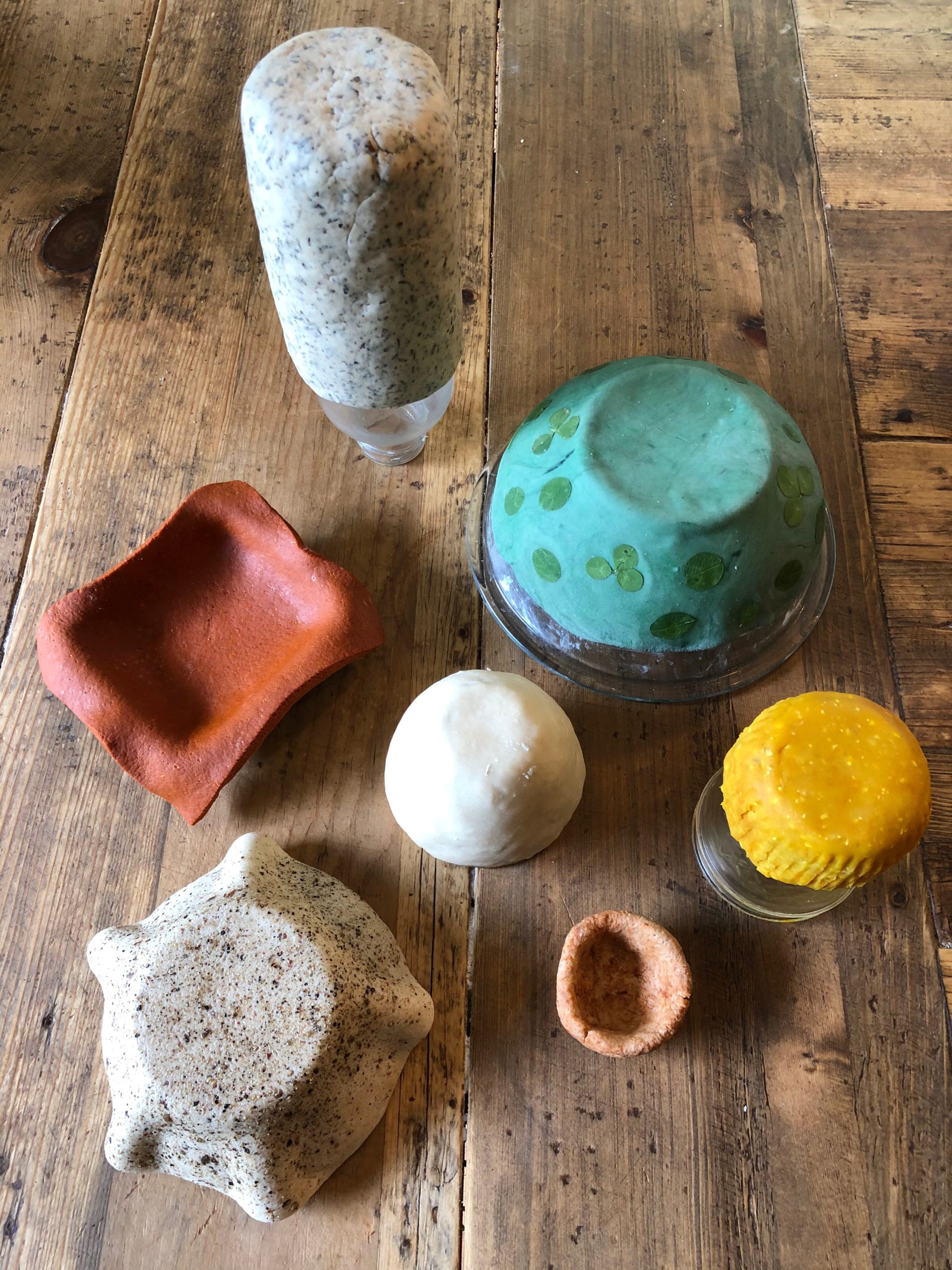 Make small pinch pots from balls of clay and allow to dry on their own. Make larger bowls by rolling the clay into a slab and draping over containers with a piece of wax paper between the clay and container to keep it from sticking. Once the outside of the clay is dry, carefully remove it from the container and take off the waxed paper. The inside will need additional time to dry. It can take up to 24 hours total to dry depending on size.
Make small pinch pots from balls of clay and allow to dry on their own. Make larger bowls by rolling the clay into a slab and draping over containers with a piece of wax paper between the clay and container to keep it from sticking. Once the outside of the clay is dry, carefully remove it from the container and take off the waxed paper. The inside will need additional time to dry. It can take up to 24 hours total to dry depending on size.
Option: Drape clay over a greased, oven-proof container and bake in a 300-degree oven for 20 to 30 minutes depending on size and thickness. Younger children should ask an older sibling or adult for help with the oven.
Challenge: Decorate the outsides of your pieces with materials you have at home.
Simplify: Let younger children use as play dough. The clay can be stored in an air-tight container for up to three days. Food coloring can also be used as a colorant.
This idea brought to you by Maggie Burgan.
The Mint Museum From Home is Presented By Chase.
5 things you may not know about artist Summer Wheat, plus a virtual tour of her Brooklyn studio
One silverlining of being quarantined at home is the opportunity to see and share experiences that we might not normally be able to experience. Enter our favorite new video pastime: artist interviews and studio tours. Mint’s Chief Curator Jen Sudul Edwards, PhD, joined Brooklyn-based artist Summer Wheat in her studio for a bit of show-and-tell on her technique and processes.
Wheat’s painting With Side With Shoulder is part of the newest New Days, New Works exhibition, and her atrium installation Foragers will be on view throughout the fall. Here are a few fun facts that we learned during Wheat’s studio tour.
- Summer Wheat is originally from Oklahoma City, OK, attended Savannah College of Art and Design, and has been living and working in Brooklyn, NY for the past 11 years.
- She has created in many mediums, from painting and sculpture, to even making custom salt and pepper shakers. Wheat says that she “likes the idea of taking a drawing and making it something usable.”
- Her creative process is two-fold: First, she always starts with a drawing, which she does alone and views this as an intimate space. Then she brings the drawing to the studio where she and her team make the ideas come to life.
- Her installation on the windows of the Mint Museum Uptown’s atrium will be her third large-scale piece using this material, and reminds her of stained glass. “I wanted to start telling stories in this format,” says Wheat, who is excited to tell impactful stories through visuals, color, and dimension.
- When the Mint opens, you’ll get to see not only Wheat’s atrium installation, but also her painted piece With Side With Shoulder that uses mesh in our newest exhibition New Days, New Works.
View this post on Instagram
The Mint Museum From Home is Sponsored by Chase.
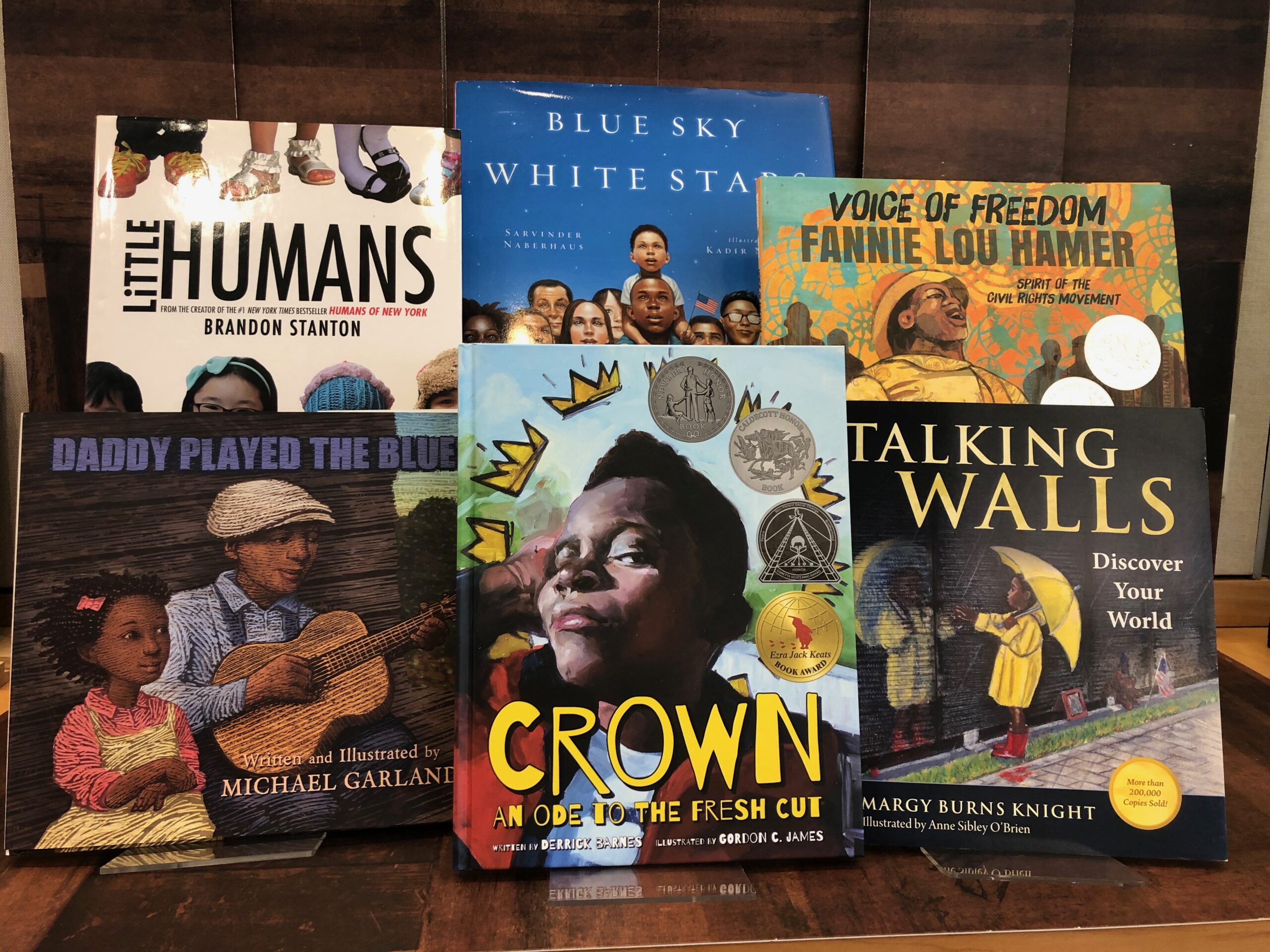 6 books for children that teach about Black history, cultural differences and similarities
6 books for children that teach about Black history, cultural differences and similarities
The journey to a more just world grows with children. Books open up a view of the world to children outside their own neighborhood. These six books, and many others, are available at Mint Museum stores, which are open for business.
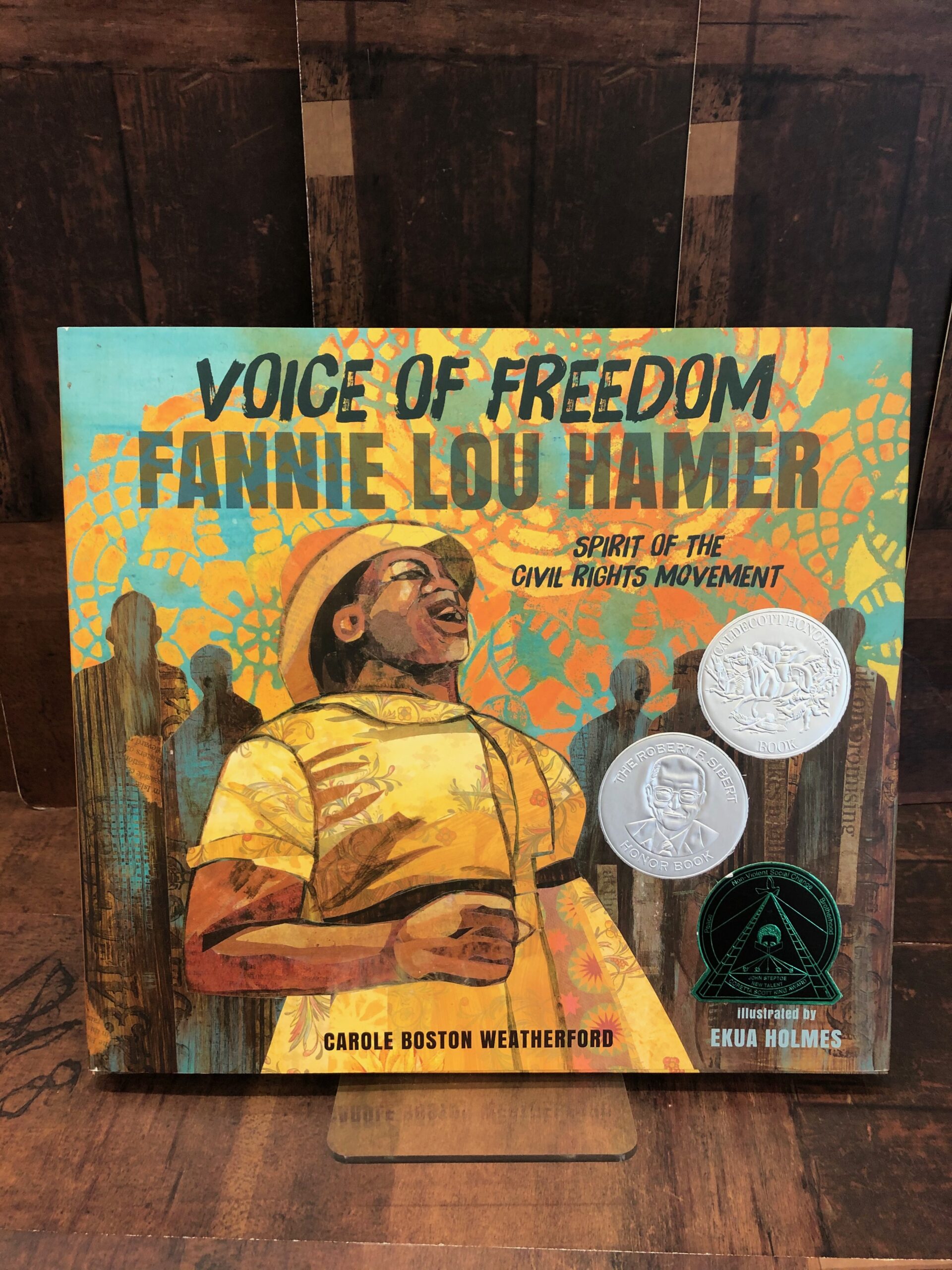
Voice of Freedom: Fannie Lou Hamer, Spirit of the Civil Rights Movement
A Caldecott Honor Book written by Carole Boston Weatherford and illustrated by Ekua, Voice of Freedom: Fannie Lou Hamer tells the story of civil rights hero Fannie Lou Hamer who participated in marches, sit-ins, and voter-education training. She also endured police brutality, time in jail and bullets shot into her home. Malcolm X called her “the country’s No. 1 freedom-fighting woman.” This book celebrates Fannie Lou Hamer’s life and legacy with a message of hope, determination, and strength. (Candlewick, $17.99).
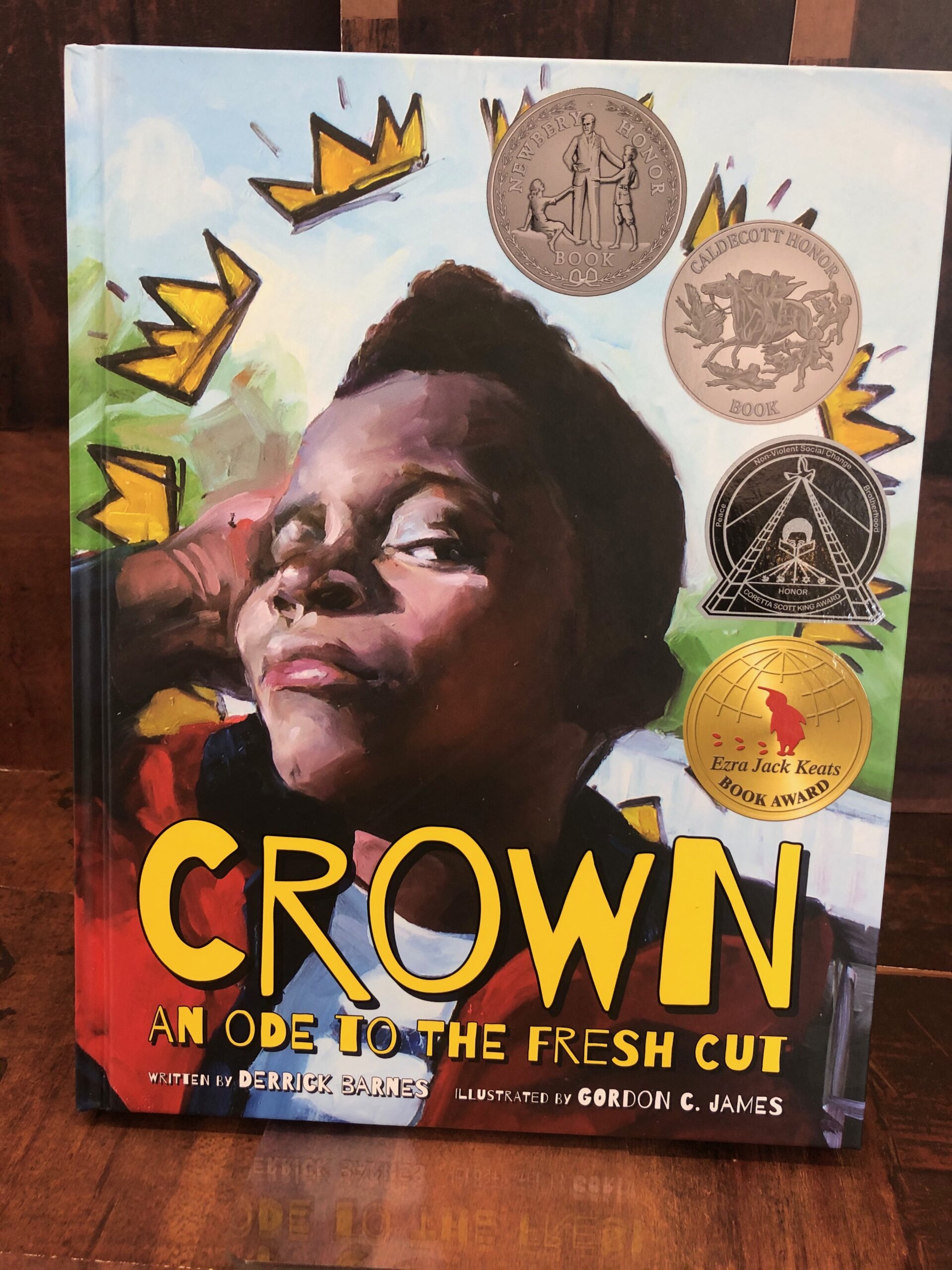
Crown: An Ode to the Fresh Cut
This rhythmic, read-aloud title by Derrick Barnes, illustrated by Gordon C. James, is an unbridled celebration of the self-esteem, confidence, and swagger boys feel when they leave the barber’s chair. Winner of a Coretta Scott King Author Honor, Newberry Honor, and Caldecott Honor, and named a best book of 2017 by NPR Books, Huffington Post, Publishers Weekly, Kirkus Reviews, the Los Angeles Times, the Boston Globe, the Horn Book Magazine, and the News and Observer.. (Agate Bolden, $18.95).
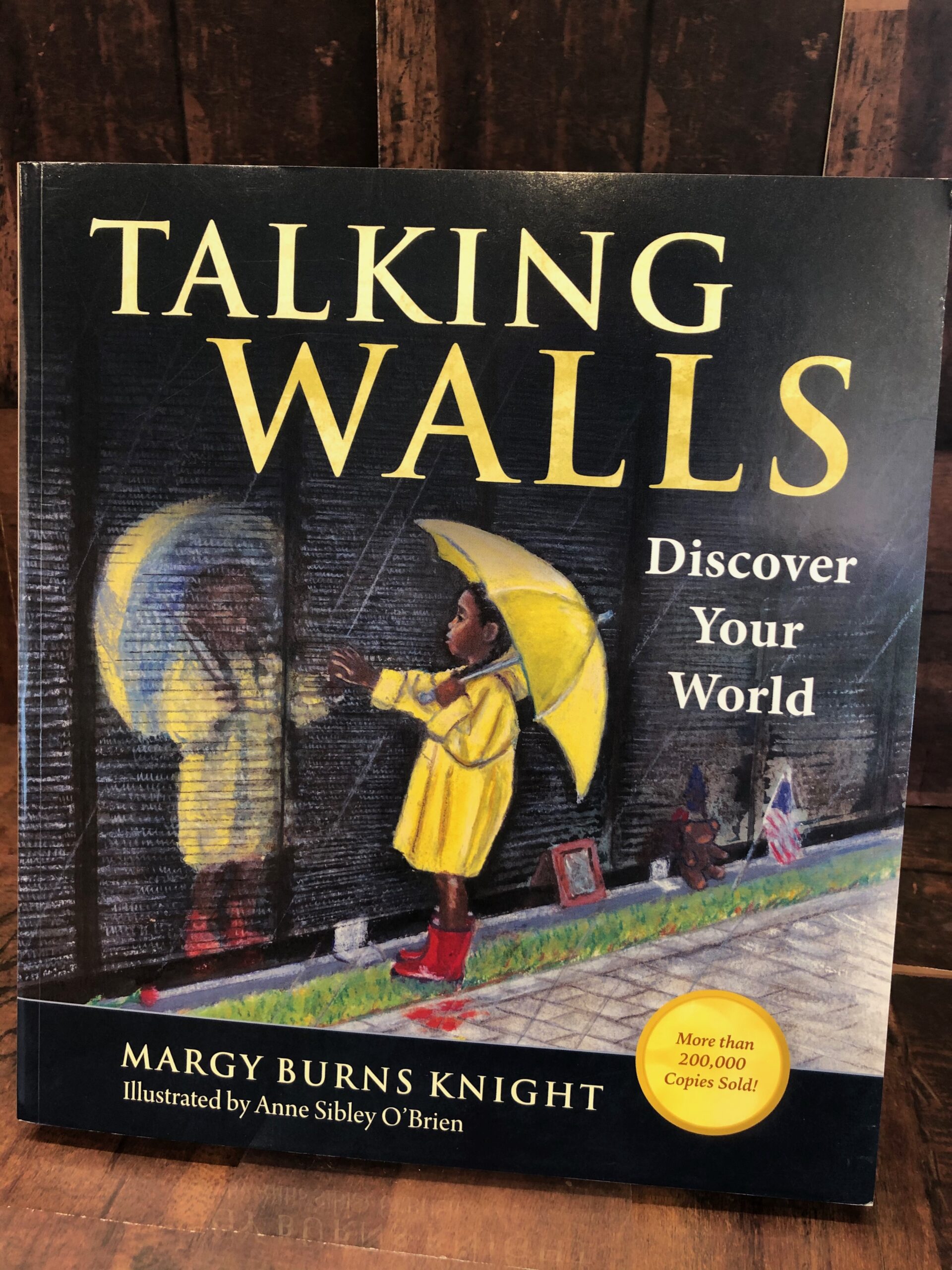
Talking Walls: Discover Your World
Written by Mary Burns Knight and illustrated by Anne Sibley O’Brien, is a story about walls the stories they could tell if they could talk, from how some walls kept people out to how they became symbols of dreams, memories and fear. Talking Walls has won honors, including the Boston Globe’s Top 25 Non-Fiction Children’s Books, and winner of a Mom’s Choice Gold Award. (Tilbury House, $9.95).
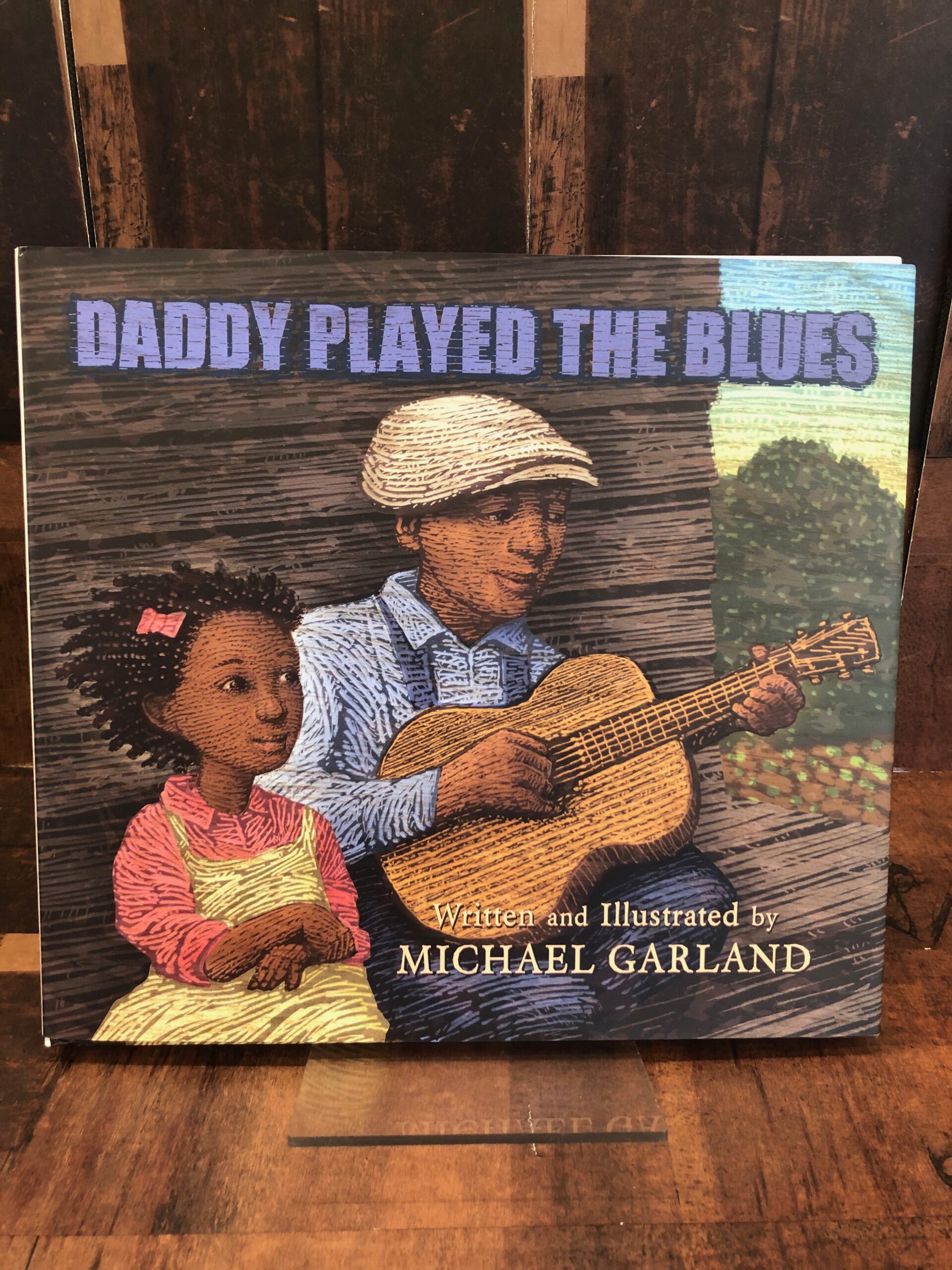
Daddy Played the Blues
Follow Cassie as she travels with her family moves to Chicago from the South, and music, particularly Blues, travel with them throughout their journey. Daddy Played the Blues is a picture book tribute to the African-American odyssey for social and economic justice, and how music was a rich part of the daily lives of Black people. Written and illustrated by Michael Garland. (Tilbury House, $17.95).
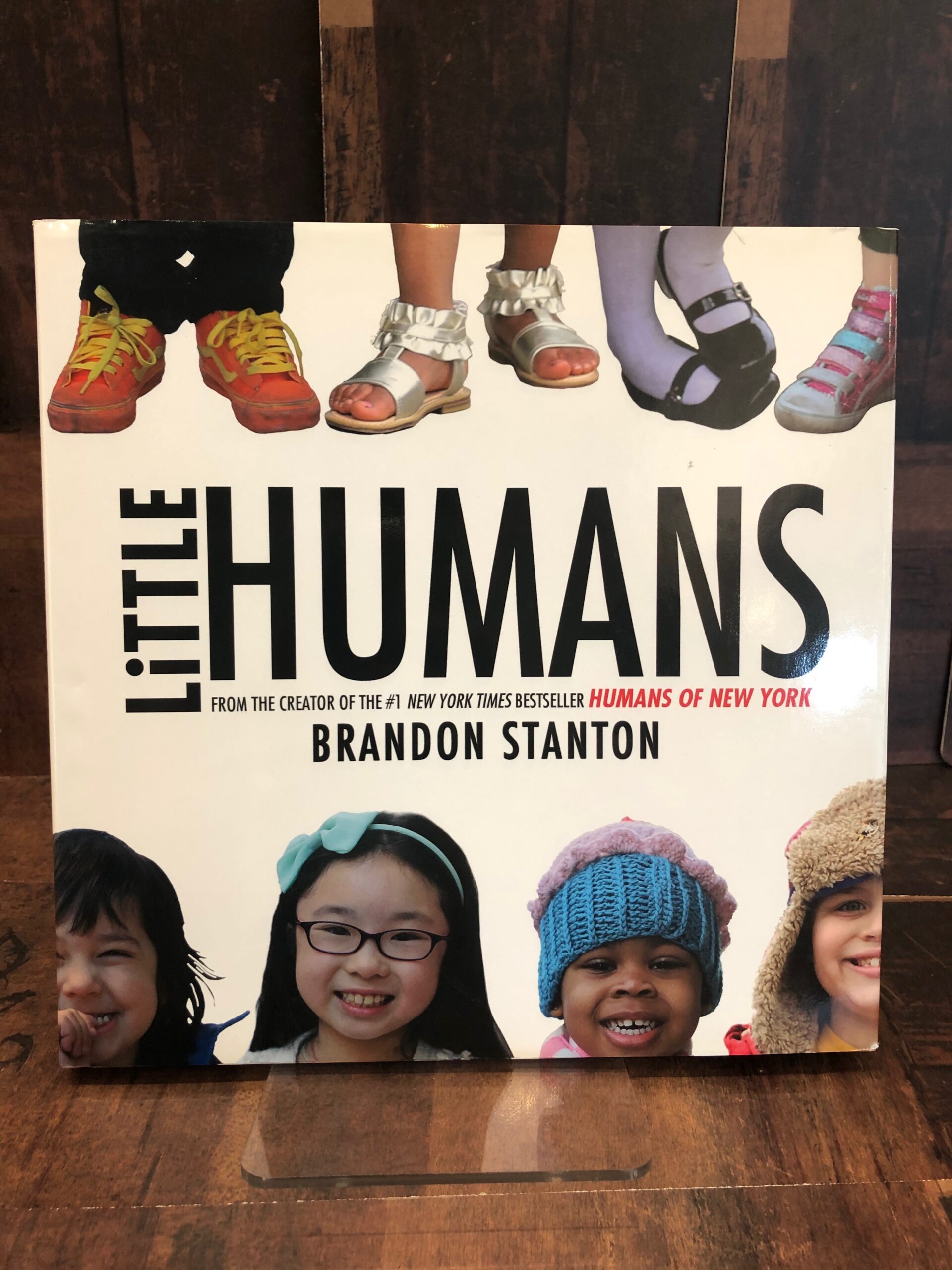
Little Humans
Written by street photographer and storyteller extraordinaire Brandon Stanton, this 40-page picture book combines some of his favorite children’s photos with a heartwarming ode to little humans everywhere. (Farrar, Straus and Giroux, $17.99).
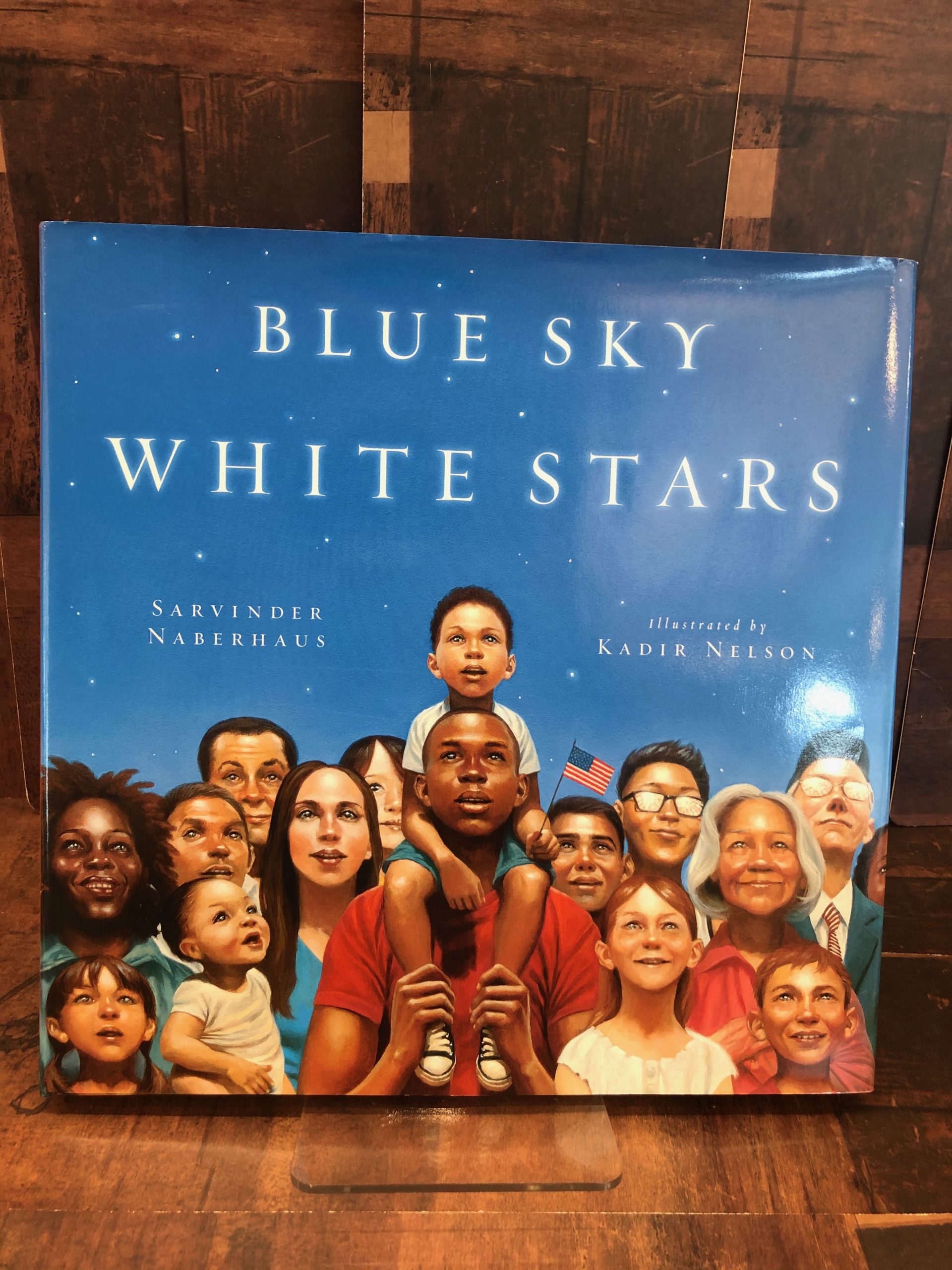
Blue Sky White Stars
Written by Sarvinder Naberhaus and illustrated by New York Times bestselling and Caldecott-honor winning artist Kadir Nelson, Blue Sky White Stars is an ode to our nation’s greatest and most enduring symbol — our flag. Nelson’s artwork brims with iconic American imagery, including majestic landscapes and the beauty and diversity of its people. From an image of the Statue of Liberty to a depiction of civil rights marchers banded together, the art for each spread depicts a sweeping view of America. (Dial Books, $17.99).
Show your love with tie-dye hearts
This is a fun and easy project that can be used to share messages of hope and support with those you love. SUPPLIES:
- Paper coffee filters
- Markers
- Scissors
- Glue
- Spray bottle for water
- Sharpie (optional)
- Protective table covering (ink from the markers will bleed through the coffee filter)
Instructions:
5. Add glue to the other side of the heart, add a few more pieces of crumbled paper, and press seams together.Let glue dry.
Challenge: Make several more hearts and string them together to form a garland or banner.
Simplify: Pre-cut filters into heart shapes.
The Mint Museum From Home is Presented By Chase.
Must-watch shows that reflect on racial identity, protest, and the ongoing fight for equal rights
Race-born conflict and inequity throughout history affect the turmoil of today. The Mint Museum believes in helping bridge conversations about racial identity and history — especially some of the lesser-known events and people — that have shaped our society. These TV series, videos and movies are stories of heroes, antagonists, protest, artists and collaborators that we hope inspire cultural understanding.
I Am Not Your Negro
Using James Baldwin’s unfinished final manuscript, Remember This House, this documentary follows the lives and successive assassinations of three of the author’s friends, Medgar Evers, Malcolm X and Martin Luther King Jr., delving into the legacy of these iconic figures, and narrating historic events using Baldwin’s original words and a flood of rich archival material. An up-to-the-minute examination of race in America, this film is a journey into black history that connects the past of the Civil Rights. —Todd Herman, CEO of The Mint Museum
Just Mercy
Just Mercy is a great film to really get a sense of what systemic racism looks like in America, particularly relative to innocent African-American men being falsely accused, sentenced, and put on death row for a crime/s they didn’t commit. Without Attorney Bryan Stevenson’s efforts, through seemingly hopeless situations, many would not have been released. Over 140 falsely accused men on death row have been set free, and some had been incarcerated for decades.” —Rubie Britt-Height, director of community relations
Another must-watch: Juneteenth Jamboree (A PBS special)
[cs_divider]
Free White and 21
While working from home, I’ve done some research on artists, one being Howardena Pindell. I was really drawn in by her life story and how it informed her art. As a black female artist in the 60’s and 70’s, she experienced racism and sexism in her work life and in trying to find representation as an artist. In 1980 she was in a near fatal car accident that left her with memory problems. In an effort to try to piece her life and memory back together, Pindell set up a video camera in her apartment and created a piece titled Free White and 21 in which she recites details of her experiences with racism, both personally and professionally, juxtaposed by herself, in whiteface echoing phrases she had heard as a woman of color. The video was not widely able to be seen at the time but is now considered groundbreaking in the realm of video art. At 77 she is still a working artist and activist and her works have been shown all over the world. She also talks about the racism she has experienced throughout her life and some of her thoughts and reactions to it in this Wonderroot podcast. —Patti Schigoda, family and studio programs associate
Another must-watch: Robin DiAngelo discusses White Fragility
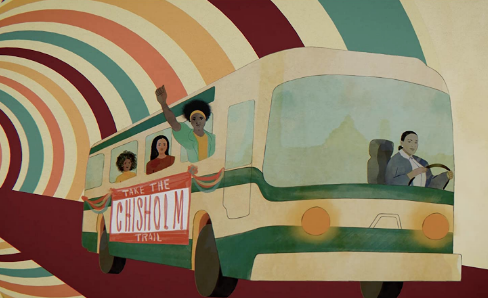
Courtesy of IMDB
Mrs. America
Mrs. America follows the female leaders of the Equal Rights Amendment, as well as the brigade of suburban housewives, led by Phyllis Schlafly, that created a nationwide campaign to keep the ERA from passing. Each episode spotlights a central character in the movement, including Shirley Chisholm (Uzo Aduba), Betty Friedan (Tracey Ullman), Bella Abzug (Margo Martindale), Gloria Steineim (Rose Byrne), and Phyllis Schlafly (Cate Blanchett). It’s story of political challenges, conquests, protests, and setbacks for women—black, white, Latino, gay and straight—fighting together for equal rights. Perhaps more importantly, it’s the lesser-known story of Phyllis Schlafly, who used conservative politics for personal gain, and to preserve things just as they were. (Sidenote: Casting and costume is spot on). —Michele Huggins, communications and media relations project manager
Another must-watch: Watchmen series (free on HBO June 19-21 to celebrate Juneteenth)
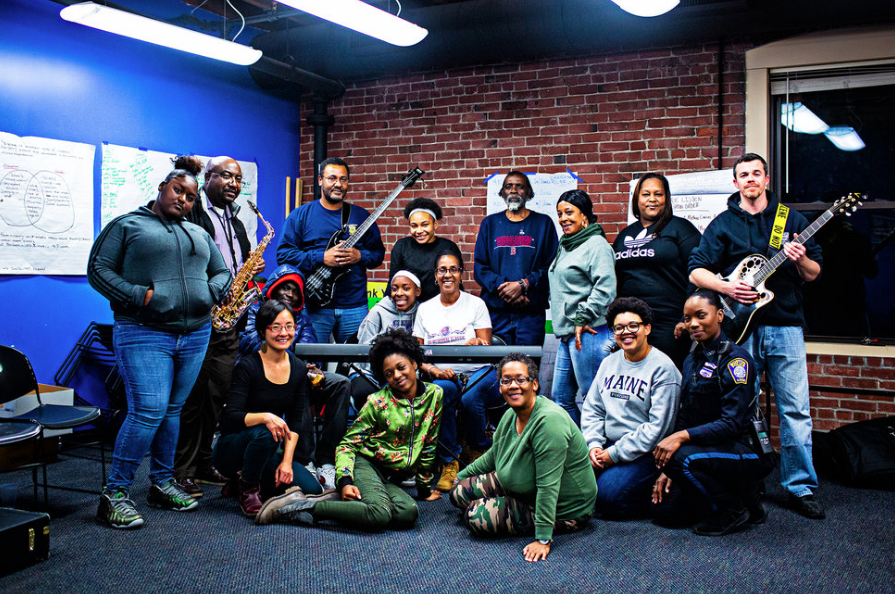
codelisten.org
Code Listen
I’ve been thinking about Gerhard Richter’s quote, “Art is the highest form of hope.” I recently came across the work of Shaw Pong Liu, an artist/musician from Boston. She uses music and performance to encourage healing and dialogue around violence, racism, and police practices. Code Listen is a collaboration with the Boston Police Department, teen artists, family members of homicide victims, and local musicians. Her work breaks down barriers, builds trust, opens conversation, and gives hope to all human beings. —Maggie Burgin, public programs coordinator
Code Listen Police-Youth Music-Dialogue Workshops 2016 (excerpt)
Code Listen: Music for Healing and Dialogue 2018 (excerpt)
Another must-watch: 13th
[cs_divider]
James Baldwin and William F. Buckley Debate
If you’ve never seen the famous James Baldwin v. William F. Buckley debate from 1965, do yourself a favor and watch it here on YouTube. In the highly publicized debate held at the Cambridge Union, Baldwin—a renowned African-American writer and orator—faced off against Buckley, a white symbol of wealth and prosperity known to most at the time as the founder of modern American conservatism. In the debate, Buckley downplayed systemic racism, arguing that the black community itself was largely to blame for its lack of economic growth, while Baldwin argued that “the American Dream is at the expense of the American Negro.” Fifty-five years later, their words are prescient, and the debate will undoubtedly leave you with a lot to think about—and some chills. Baldwin’s performance is masterful. —Caroline Portillo, director of marketing and communications
Another must-watch: Do the Right Thing
Celebrating Juneteenth with community discussions, music, storytelling and more
We are entering a new age in our country, where many are opening their eyes, affirming that #BlackLivesMatter, and educating themselves on the still very current issues of racism in America. With these conversations has come the recognition and awareness of Juneteenth. On June 19, 1865, Major General Gordon Granger brought news to Galveston, Texas that the war had ended and that the enslaved were free. This news was delivered two years after the Emancipation Proclamation, and symbolizes the news finally reaching the whole country.
In honor of Juneteenth, and the continued work that is needed to end systemic racism in America, cultural organizations and community groups across Charlotte are hosting programs from block parties and food drives to panels and family days. We encourage everyone to join virtually or in-person (with social distancing, of course), and let the history, creativity, and celebration inspire you to continue learning and doing the work to put an end to racism in our country.
June 19
The 23rd annual Juneteenth Festival of the Carolinas will be held June 19-21 from 10 AM to 8 PM at House of Africa in Plaza Midwood. Attendees can expect a multi-cultural celebration filled with drum circles, local vendors, performances, as well as an open mic. The event is free, and social distancing measures will be honored.
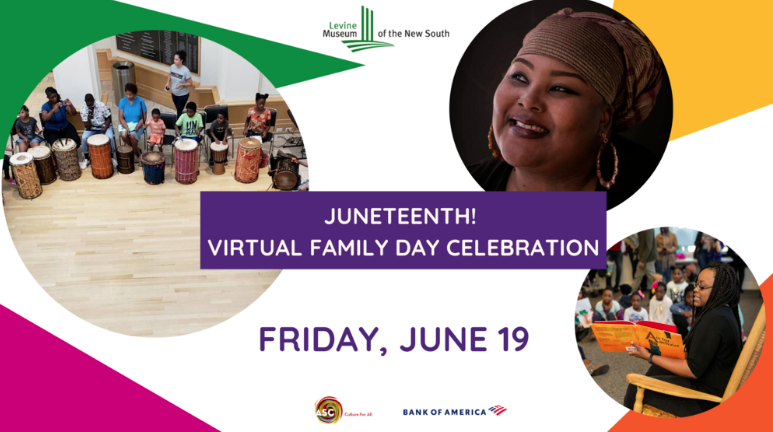
Levine Museum of the New South is hosting a virtual Juneteenth celebration for families from 9 AM to 5 PM. The festivities can be accessed via the museum’s Facebook and Youtube channel, and will feature spoken word, storytelling, history, and music. Visit the website to view the schedule of performances and talks.
Charlotte Mecklenburg Library invites ages 12 and older to the virtual Engage 2020: Juneteenth Lunch and Learn noon to 1:30 PM. Learn more about the past, present, and future of civic engagement. Special guest Elisha Minter will reflect on Juneteenth celebrations in Charlotte. Register with a valid email address and the meeting link will be sent a few hours before the program begins.
The Harvey B. Gantt Center for African-American Arts + Culture is hosting an art workshop with artist and educator Alicia L. McDaniel from 3-4 PM, This event is free and people of all ages are encouraged to participate. For more information on supplies or how to join in, visit the Gantt’s website.

Charlotte Ballet is offering free admission to its regularly scheduled intersession classes (different classes taking place at 3 and 4 PM) and ask that participants donate money that they would have spent on attending the class to an organization that is doing work to advance racial equality in Charlotte or nationwide. More information and class schedules can be found on the Charlotte Ballet website.
From 5-8 PM, the Coalition for a New South is hosting a food truck rally at Hornets Nest Park on Beatties Ford Road. The socially distanced event will be filled with food, music, and speakers. It also serves as a space to remember victims of police brutality and an event to call participants to anti-racist action. More details and park location can be found on the Facebook event page for the gathering.
June 20
SEAS University, Unitymarkets, and Riziki Zafira together are hosting a Juneteenth Social Distance Community Celebration, filled with community vendors, live entertainment, give-aways, and more. The family-friendly event takes place from noon to 4 PM, and then transitions into a day party for adults from 4-8 PM. The event is free, and more information can be found on the event Facebook page.
6 art books that raise the curtain for black artists, racism and protest
As society grapples with unrest around racism and protest, books about black artists and black history shine a spotlight on the struggles and accomplishments of black Americans throughout history. These six books, and many others, are available at Mint Museum Store uptown.
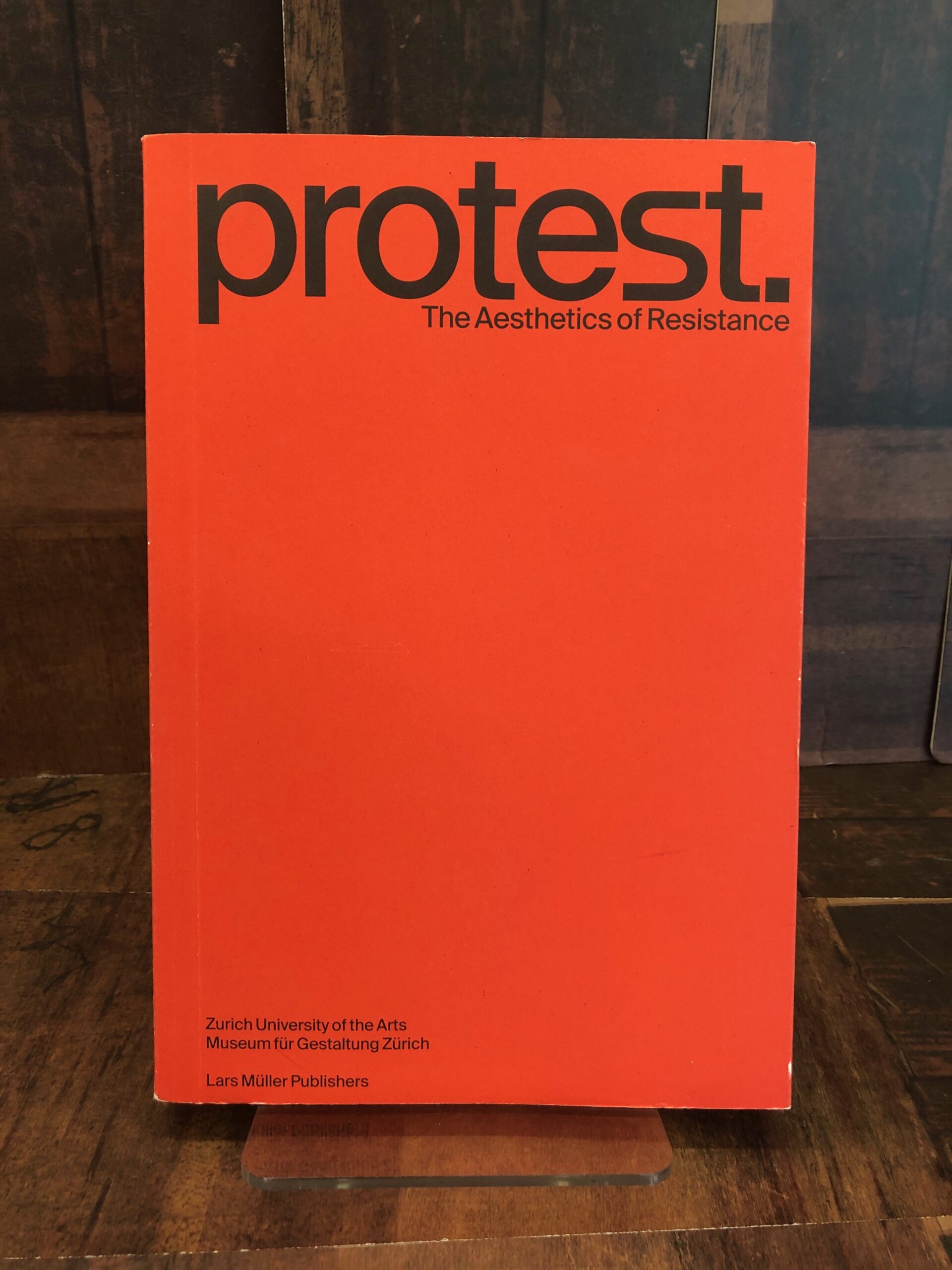
Protest. The Aesthetics of Resistance
Illustrated with expressive photographs and posters, Protest. considers social, culture-historical, sociological, and politological perspectives, as well as approaches that draw on visual theory, popular culture, and cultural studies. In the process, the book takes into account in particular such contemporary developments as the virtualization of protest, how it has been turned into the fictional and its exploitation in politics by power holders of all shades. (Lars Muller Publishers, $29.95).
Hip Hop Raised Me by DJ Semtex
In Hip Hop Raised Me., updated for 2018, DJ Semtex examines the crucial role of hip-hop in society today, and reflects on the huge influence it has had on his own life, and the lives of many others, filling in the gaps of education that school left behind, providing inspiration and purpose to generation after generation of disaffected youths. Taking a thematic approach and featuring seminal interviews he has conducted with key hip-hop artists, Semtex traces the characteristics and influence of hip-hop from its origins in the early 1970s to the impact of contemporary artists and the global industry that is hip-hop today. (Thames and Hudson, $40).
30 Americans: Rubell Museum
30 Americans showcases works by many of the most important African American artists of the last three decades. The artwork focuses on issues of racial, sexual, and historical identity in contemporary culture while exploring the powerful influence of artistic legacy and community across generations. Since the 1960s, Miami’s Rubell family has collected the works of the most relevant contemporary African American artists as an integral part of their broader mission to collect the most interesting art of our time, which is showcased in the book. (Rubell Family Collection, $45).
Jill Freedman: Resurrection City, 1968
“Originally published in 1970, Jill Freedman’s Old News: Resurrection City documented the culmination of the Poor People’s Campaign of 1968, organized by Martin Luther King Jr. and the Southern Christian Leadership Conference, and carried out under the leadership of Ralph Abernathy in the wake of Dr. King’s assassination. Three thousand people set up camp for six weeks in a makeshift town that was dubbed Resurrection City, and participated in daily protests. Freedman lived in the encampment for its entire six weeks, photographing the residents, their daily lives, their protests and their eventual eviction. This new 50th-anniversary edition of the book reprints most of the pictures from the original publication, with improved printing and a more vivid design. Alongside Freedman’s hard-hitting original text, two introductory essays are included.” (Grossman Publishers, $45).
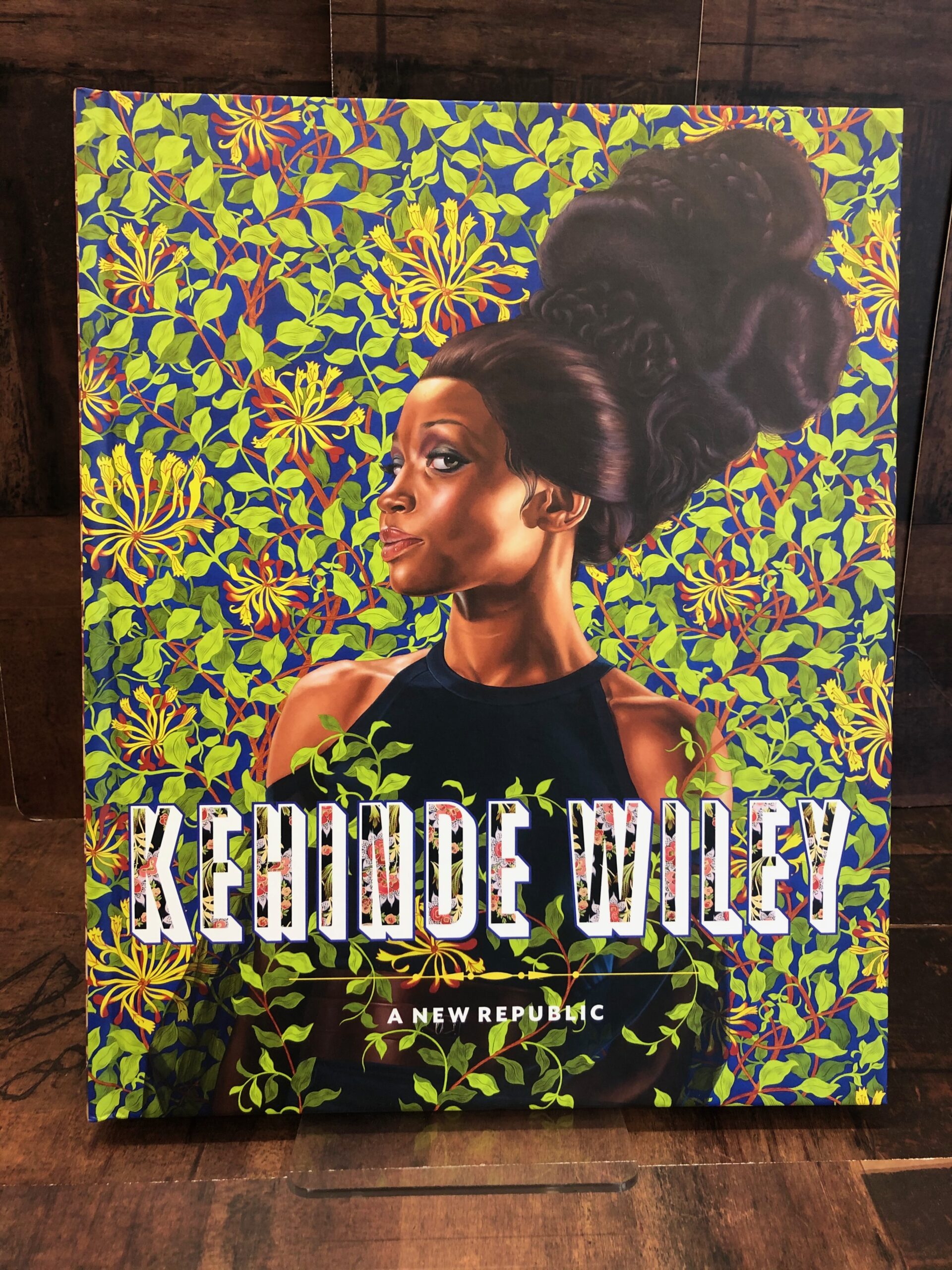
Kehinde Wiley: A New Republic
Filled with reproductions of Kehinde Wiley’s bold, colorful and monumental work, this book encompasses the artist’s various series of paintings as well as his sculptural work, which boldly explore ideas about race, power, and tradition. Celebrated for his classically styled paintings that depict African American men in heroic poses, Kehinde Wiley is among the expanding ranks of prominent black artists who are reworking art history and questioning its depictions of people of color. This volume surveys Wiley’s career from 2001 to the present. It includes early portraits of the men Wiley observed on Harlem’s streets, and which laid the foundation for his acclaimed reworkings of Old Master paintings in which he replaces historical subjects with young African American men in contemporary attire: puffy jackets, sneakers, hoodies, and baseball caps. (Prestel, $49.95).
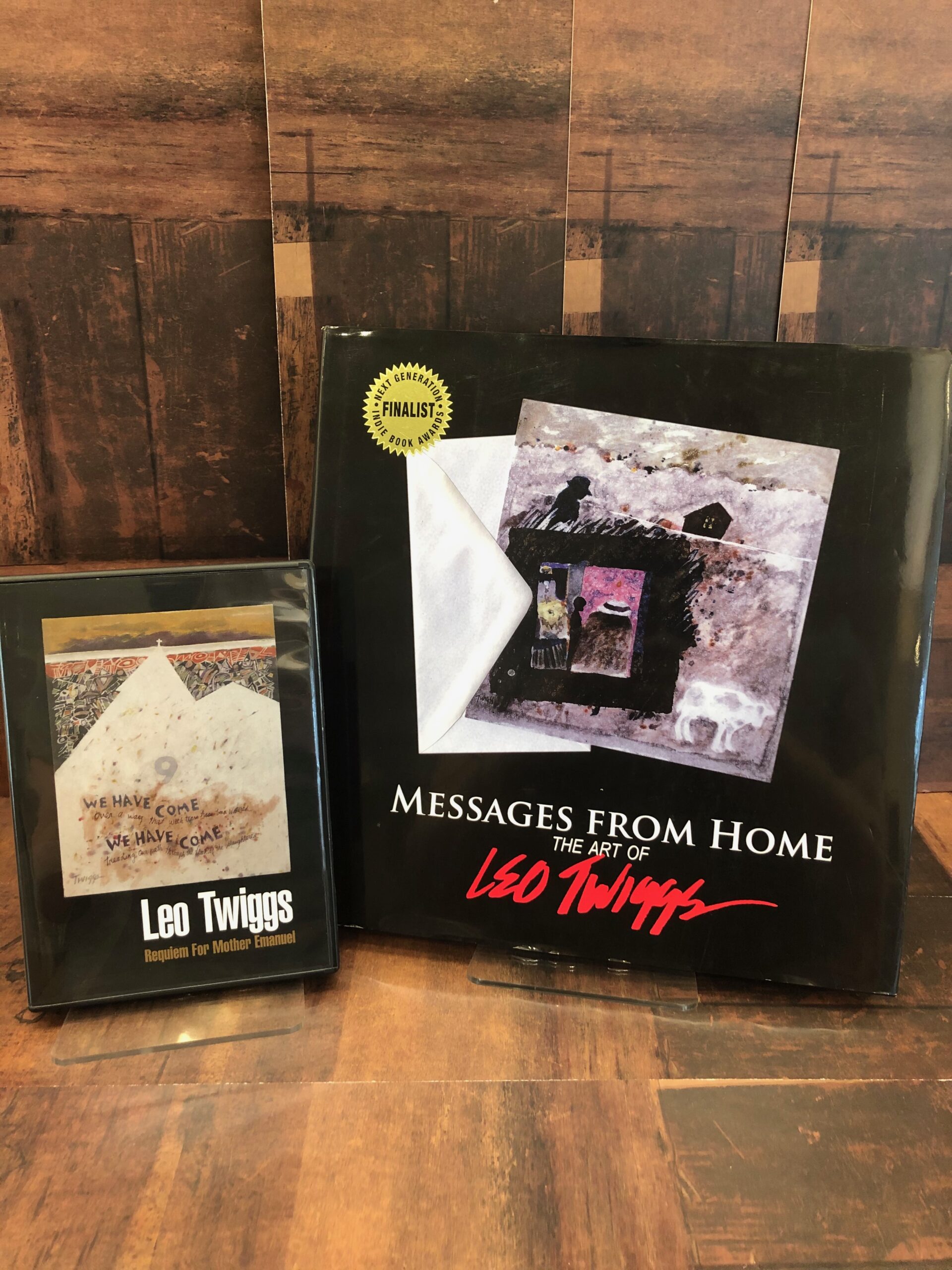
Messages from Home: The Art of Leo Twiggs (Signed Copy)
Foreword from book by William U. Eiland : “In the middle of one of the interminable brouhahas over the Confederate Battle Flag here in the South, I heard of an African-American artist who was using the symbol in innovative ways, painting it in batik to invest it with new meaning. Leo Twiggs’ flags are no paeans to a lost cause, no emblems even of a mythic past. They are, however, in the language of contemporary criticism, ‘comments’ on society through ‘appropriation.’ In this case, theoretical cliché comes close to truth. Twiggs, with gentle but unswerving irony, takes the flag and claims it as part of his Southern heritage. Tattered, disappearing almost, the standard about which so much controversy has been generated becomes in Twiggs’ hand an ambiguous metaphor of unresolved conflict and shared history. Such images on color-infused fabric not only mock the flag as a talisman losing its power, but also present a symbol that in its very mutability and degradation is strangely current, yet jarringly discomfiting in an era when the nation has a black president. In addition to the Civil War, it calls to mind for Twiggs the suffering of slaves, the turmoil of Reconstruction, the indignity of Jim Crow, the promise of the Civil Rights era and its aftermath, when this piece of cloth, venerated by some, reviled by others, continues to inspire argument and dissent. Twiggs transforms the image through shaping a new iconography for it, one in which he finds the possibility, albeit remote, of accord. Twiggs’ art, thus, even with the most explosive of subjects, is intensely personal but never strident. Through depictions of the violence of hurricanes, the complexity of race relations, the romance of Southern rivers, and the bonds of family, he weaves his experiences into a coherent, but occasionally elusive narrative. (Cecil Williams Photography/Publishing / Claflin University Press, $82).
“I think art has the ability [to], if not cure or heal, at least enlighten, slap you in the head, wake you up,” —artist Joyce J. Scott
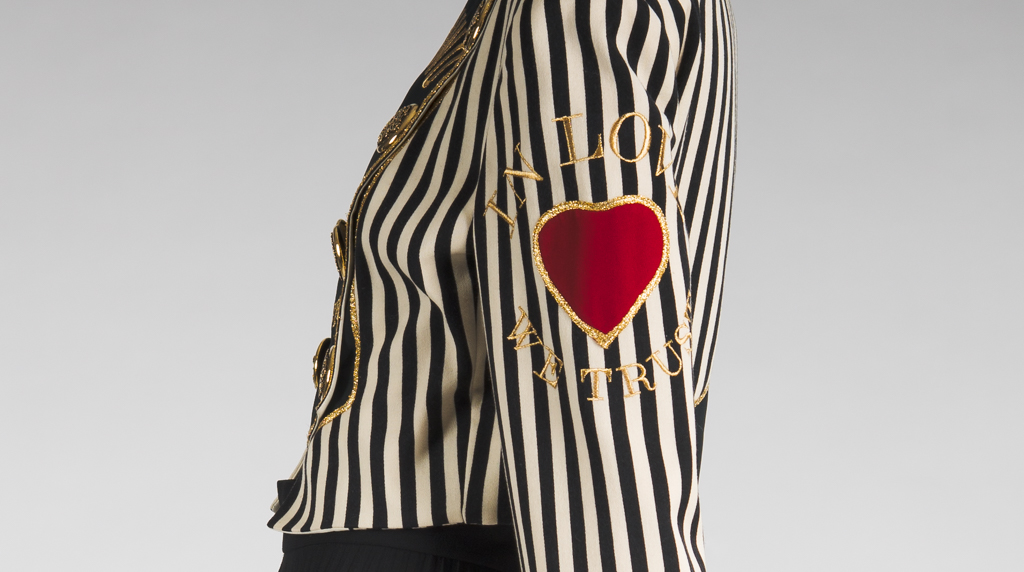
Franco Moschino (Italian, 1950–94), Moschino LLC (1983–). “In Love We Trust Jacket,” 1989, wool and mixed media. Museum Purchase: Funds provided by Deidre and Clay Grubb. 2015.20.4
Art has been created as a response to social unrest and inequality throughout history. It also can serve as a catalyst for hard conversations about racism, the need for cultural understanding and the challenges before us regarding unity and justice. Following are eight curator selections of artwork in the Mint collection that were created in response to violence, racism and cultural disparities that challenge our society.
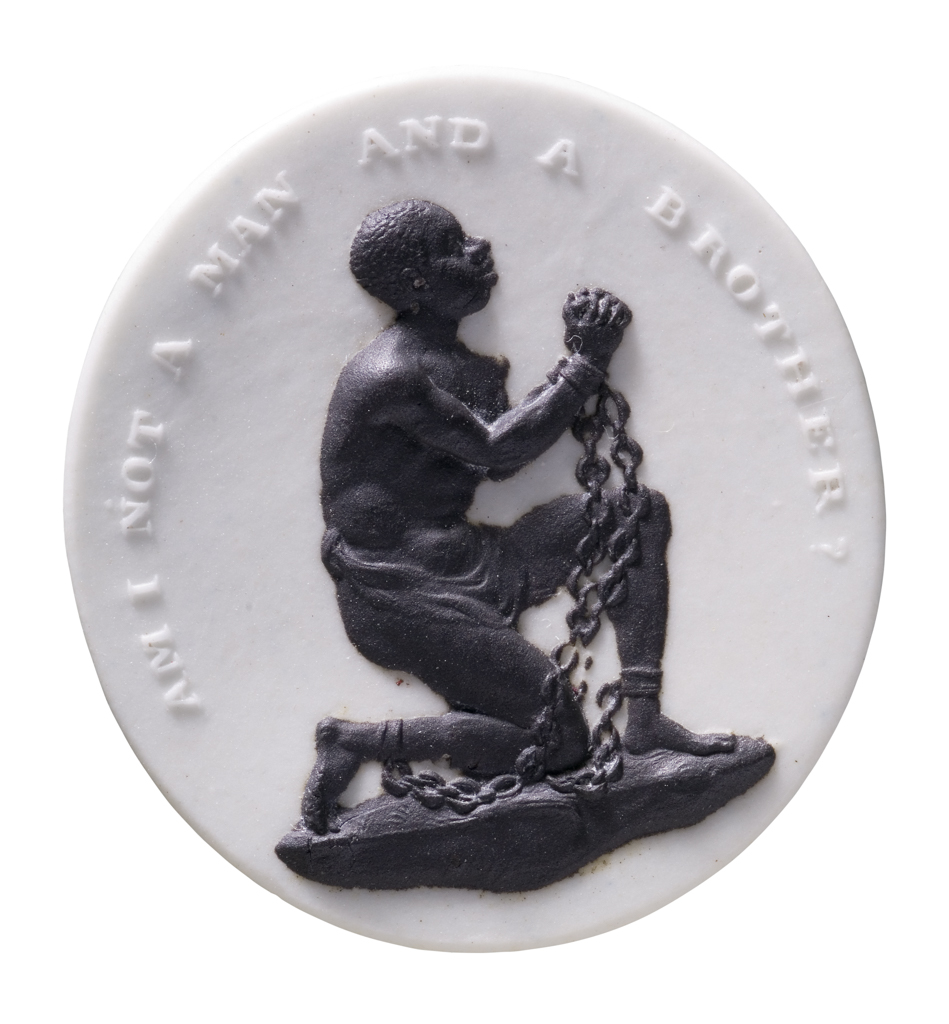
Wedgwood (Staffordshire, England), William Hackwood, modeler (British, circa 1757–1839). “Society for the Abolition of the Slave Trade Medallion,” designed in 1787, jasperware, silver. Delhom Collection. 1965.48.85
This medallion depicts an enslaved black African man, down on one knee with his arms and ankles in chains. Around the medallion’s edge is the inscription, “AM I NOT A MAN AND A BROTHER?” Josiah Wedgwood first produced this in 1787, the same year that the Society for the Abolition of the Slave Trade was founded in London. Wedgwood joined the society and paid for all the other members to receive a medallion at his expense. See more from Josiah Wedgwood in the gallery tours of Classic Black: Black Basalt Sculpture of Josiah Wedgwood and His Contemporaries. —Brian Gallagher, Curator of Decorative Arts
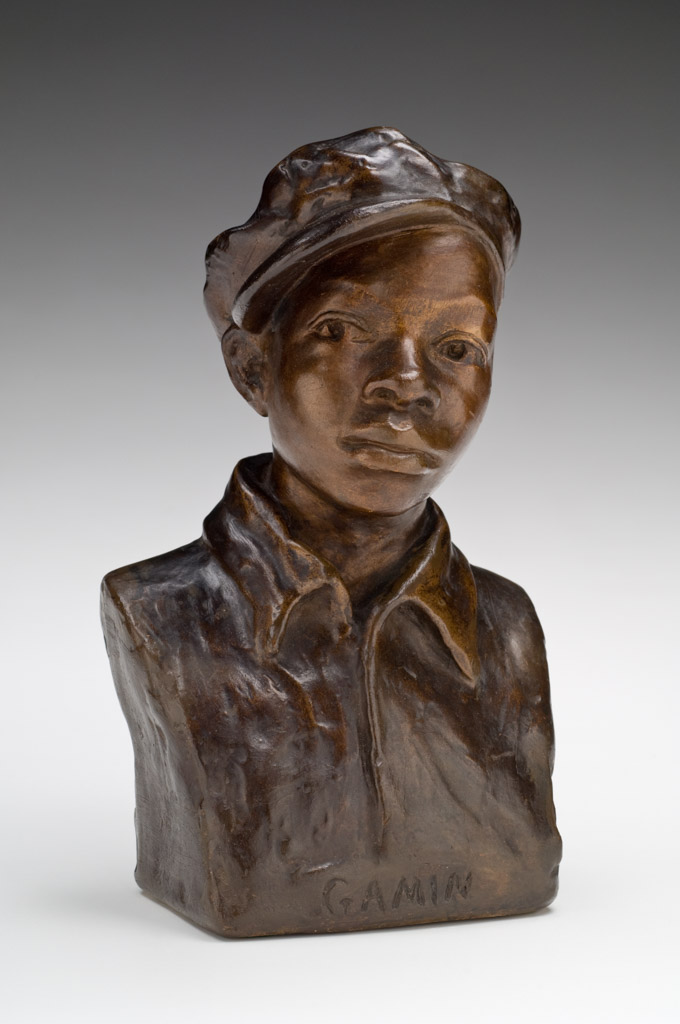
Augusta Savage (American, 1892-1962). “Gamin,” circa 1930, painted plaster. Museum purchase with funds provided by the Mint Museum Auxiliary. 2008.58
Throughout her career, Augusta Savage fought against racism and sexism as she strove to learn her craft. She constantly strove to uplift children and aspiring artists, first at her Savage School of Arts and Crafts, and later as the founding director of the Harlem Community Arts Center. While some of her portraits celebrated leaders in the African American Community, such as W.E.B. Dubois and Marcus Garvey, other, like Gamin—one of her most popular works—found dignity and hope in the children struggling for survival on the streets of her Harlem neighborhood. —Jonathan Stuhlman, Ph.D., Senior Curator of American Art
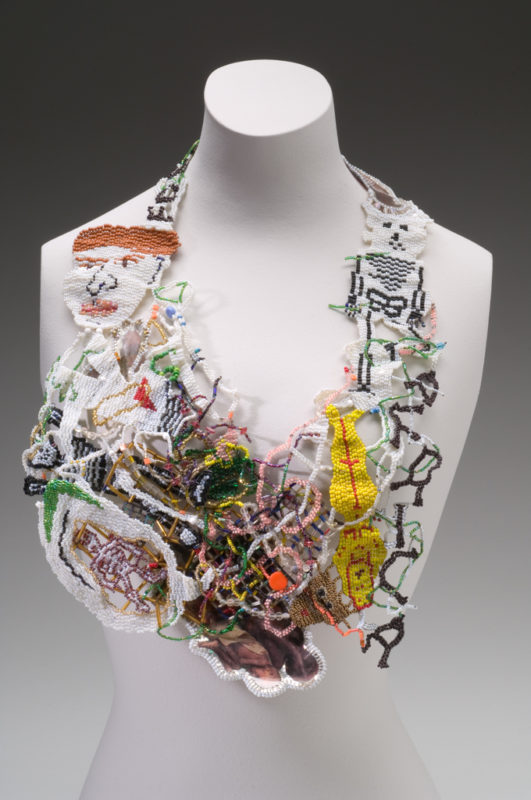
Joyce J. Scott (American, 1948–). “Hunger,” 1991, hand-beaded glass, thread, photographs, plastic. Gift of the Friends of the Mint. 1992.23. © Joyce J. Scott, 1991
Born, raised, and based in Baltimore, Maryland, African American artist Joyce J. Scott confronts racism, sexism, classism, and other issues head-on in art made in a range of media. Her 1991 necklace Hunger addresses famine in Africa—a persistent problem in the 1980s and early 1990s—and white complicity in it. Hand-beaded skeletons and photographs of malnourished children are juxtaposed with a large white face that seems to look away, ignoring their suffering. Hunger is on view at Mint Museum Uptown. In the words of Joyce J. Scott, “I think art has the ability [to], if not cure or heal, at least enlighten, slap you in the head, wake you up.” —Rebecca Elliot, Assistant Curator of Craft, Design and Fashion
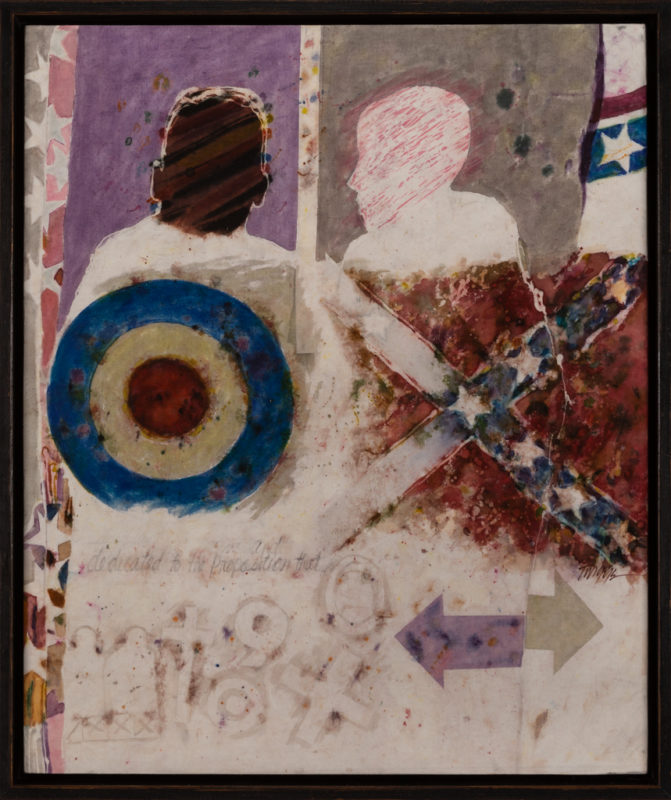
Leo Twiggs. (American, 1934–). “Conversation, 2018,” batik on linen. Museum purchase with funds from the Charlotte Debutante Club. 2018.44
In 2016 The Mint Museum exhibited Dr. Leo Twiggs’ powerful cycle of nine paintings created as a tribute to those who lost their lives in the shooting at Mother Emanuel Church in Charleston, South Carolina. In this series, Dr. Twiggs sought to inspire reflection, redemption, and ultimately, healing. The museum commissioned this painting following its presentation of that exhibition. Conversation was inspired by comments that visitors left for Dr. Twiggs during the exhibition. As the artist has noted, “Since the Mother Emanuel paintings were used at every exhibit venue as a catalyst to create conversations about race and culture, I was inspired to do a painting I call Conversation.” While art can sometimes be an escape from current events, it can also inspire us to have difficult but necessary discussions with those who think differently than we do. —Jonathan Stuhlman, Ph.D., Senior Curator of American Art
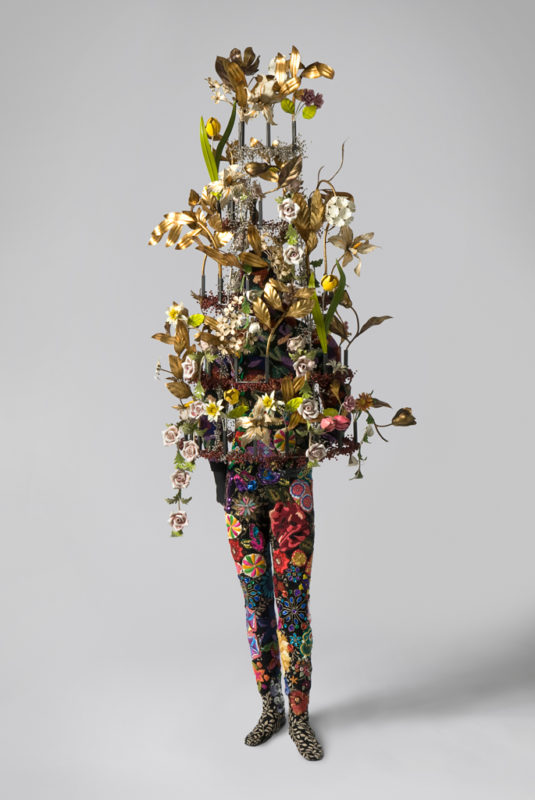
Nick Cave (American, 1959–). “Soundsuit,” 2007, fabricated, beaded, and sequined body suit, metal armature, metal Victorian flowers. Museum Purchase: Founders’ Circle Annual Cause. 2009.19.1A-OOOOO. © Nick Cave
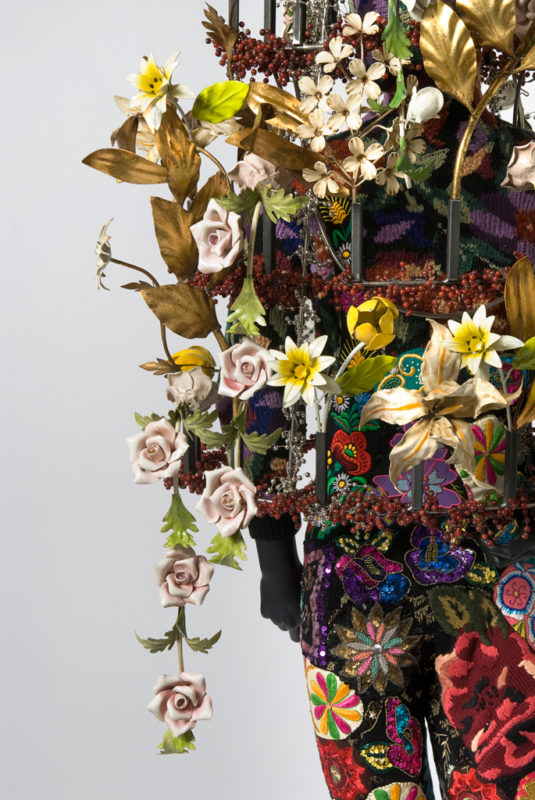
Nick Cave’s first Soundsuit was created in 1992 as a direct response to the shocking event of the brutal beating of Rodney King by 4 Los Angeles police officers and the riots there that followed. As a black man, Cave felt the injustice of racial profiling, recognizing that society dismissed and discarded African-Americans. He began collecting twigs, discarded objects he found at the railroad tracks, textiles and objects from flea markets and thrift shops, undervalued and unwanted things. Such materials became costumes complete with headdresses and masks to conceal the identity of the wearer. A “secondary skin” that disguises race, gender, and class,” the Mint’s Soundsuit is made up of a rainbow of multicultural embroideries and knitting, and a chandelier from a junk shop in Indiana. —Annie Carlano, Senior Curator of Craft, Design & Fashion
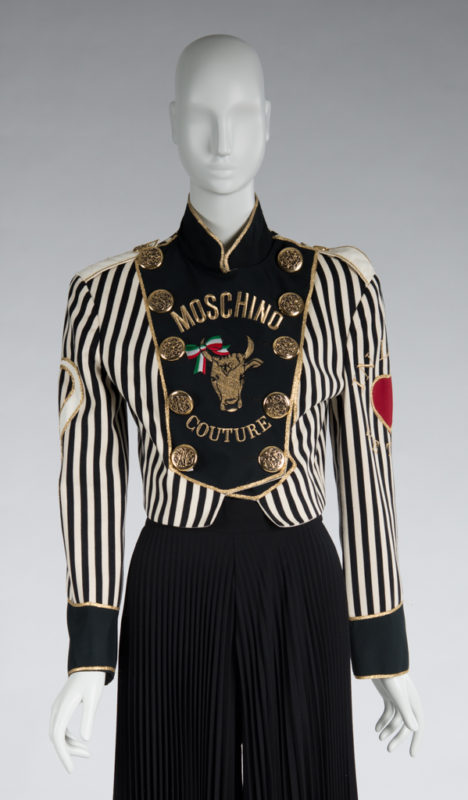
Franco Moschino (Italian, 1950–94), Moschino LLC (1983–). “In Love We Trust Jacket,” 1989, wool and mixed media. Museum Purchase: Funds provided by Deidre and Clay Grubb. 2015.20.4
Best known for his fine tailoring and irreverent fashion designs that often included provocative quotes, Franco Moschino created his eponymous couture and ready wear company at the height of the HIV/AIDS epidemic in Europe, where gay men afflicted with the virus were often ostracized and ridiculed by society. Working within the more conservative fashion industry in Milan, Moschino was dubbed the “enfant terrible” for his extreme creativity and use of clothing as communication for his personal politics and humanitarian causes. In Love We Trust, is a jacket that illustrates the designer’s compassion, with an image of a cow as a symbol of his support of animal rights, and the words and red heart needing no explanation. The year before his death he founded a hospice for children with AIDS. —Annie Carlano, Senior Curator of Craft, Design & Fashion
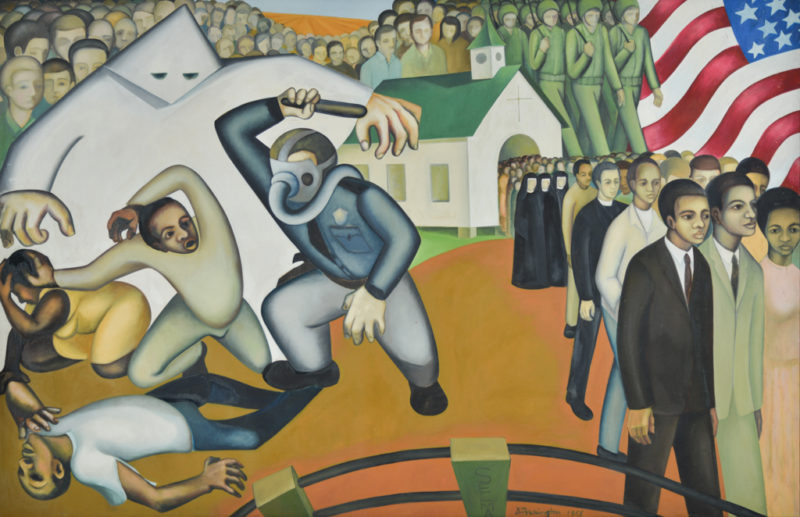
Barbara Pennington (American, 1932–2013). “Selma,” 1965, oil on canvas. Museum purchase with funds provided by Peggy and Bob Culbertson, the Romare Bearden Society, Sally and Russell Robinson, Mary Lou and Jim Babb, and a gift of the Moreland Family. 2014.79
This remarkable painting was created in response to the heart-wrenching events that unfolded in Selma, Alabama, in the spring of 1965. Barbara Pennington, an Alabama native, was training in New York at the time of the Selma marches and attacks. The events unfolding in her home state inspired her to create this monumental canvas. Likely drawing upon images that appeared in the mass media, Pennington wove together various parts of the narrative into a gut-wrenching scene that remains a powerful, moving representation of these tragic events—and the ways in which they can unify people from all walks of life to come together to demand change—more than 50 years later. —Jonathan Stuhlman, Ph.D., Senior Curator of American Art
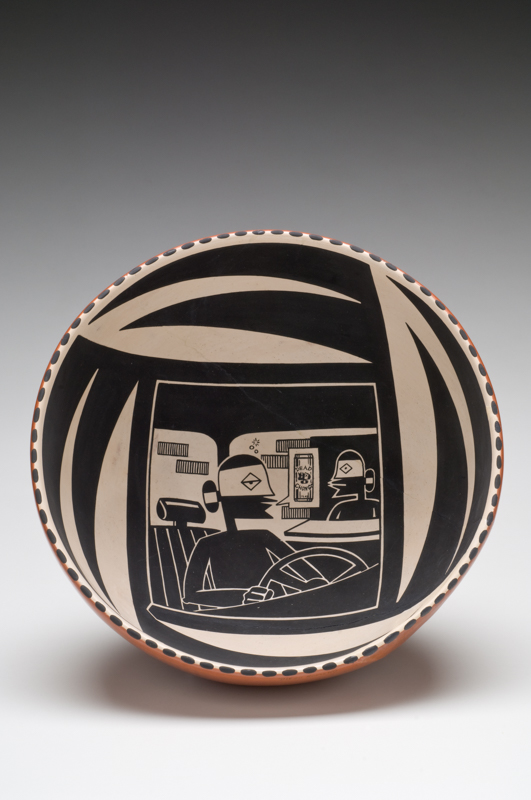
Diego Romero (Cochiti, 1964–). Bowl, late 20th century, earthenware with slip paint. Gift of Gretchen and Nelson Grice. 2017.43.34
Cochiti artist Diego Romero, based in Santa Fe, New Mexico, combines the graphic influences of ancient Mimbres pottery and 20th-century American comic books on his illustrated pots that comment on life as a contemporary Native American, including challenging social issues such as alcoholism and poverty. Seen here are his recurring characters the Chongo Brothers, inspired by the mythical Mimbres hero twins, but also by the artist’s childhood with his brother Mateo; chongo, a traditional bun hairstyle, became a nickname for the two boys. This bowl is on view at Mint Museum Randolph. —Rebecca Elliot, Assistant Curator of Craft, Design and Fashion
Create your own Chihuly-like sculpture
Inspired by Royal Blue Mint Chandelier by Dale Chihuly that hangs in the Carroll Gallery at Mint Museum Uptown, this project incorporates layering and mixing colors while using recycled materials from home. Watch how Royal Blue Mint Chandelier was moved to the Mint Museum Uptown.
MATERIALS
- Old wire hanger (the thinner the metal, the easier it is to bend)
- Recycled plastic bottles
- Paint
- Paint brush
- Scissors (pointed tip work best)
- Corks (optional)
- Pliers or metal snips (optional)
NOTE: This project is geared to older children and teens. To simplify this for younger children, precut the plastic bottles and begin at step 4.
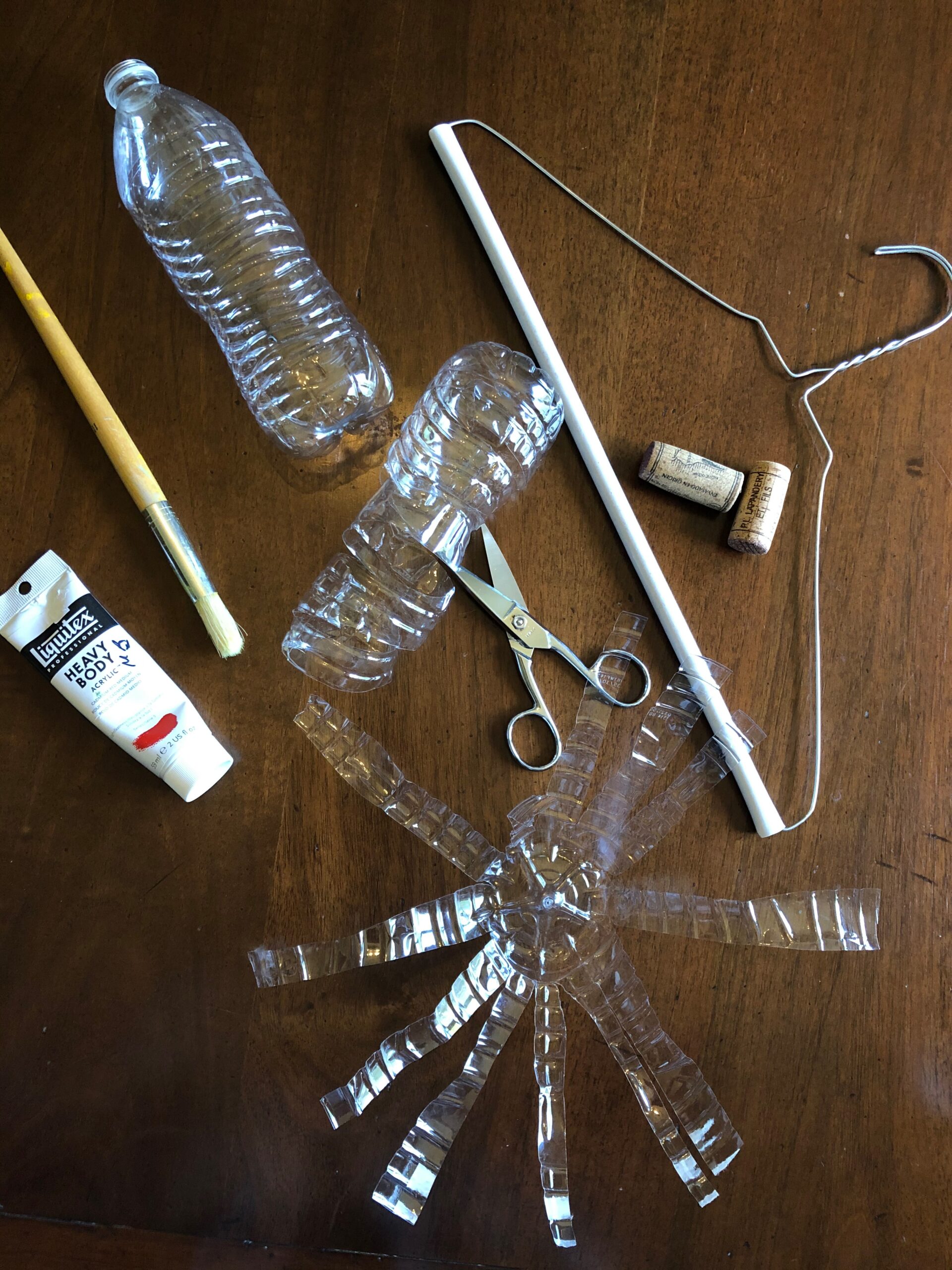
[cs_divider color=”#7a7a7a”]
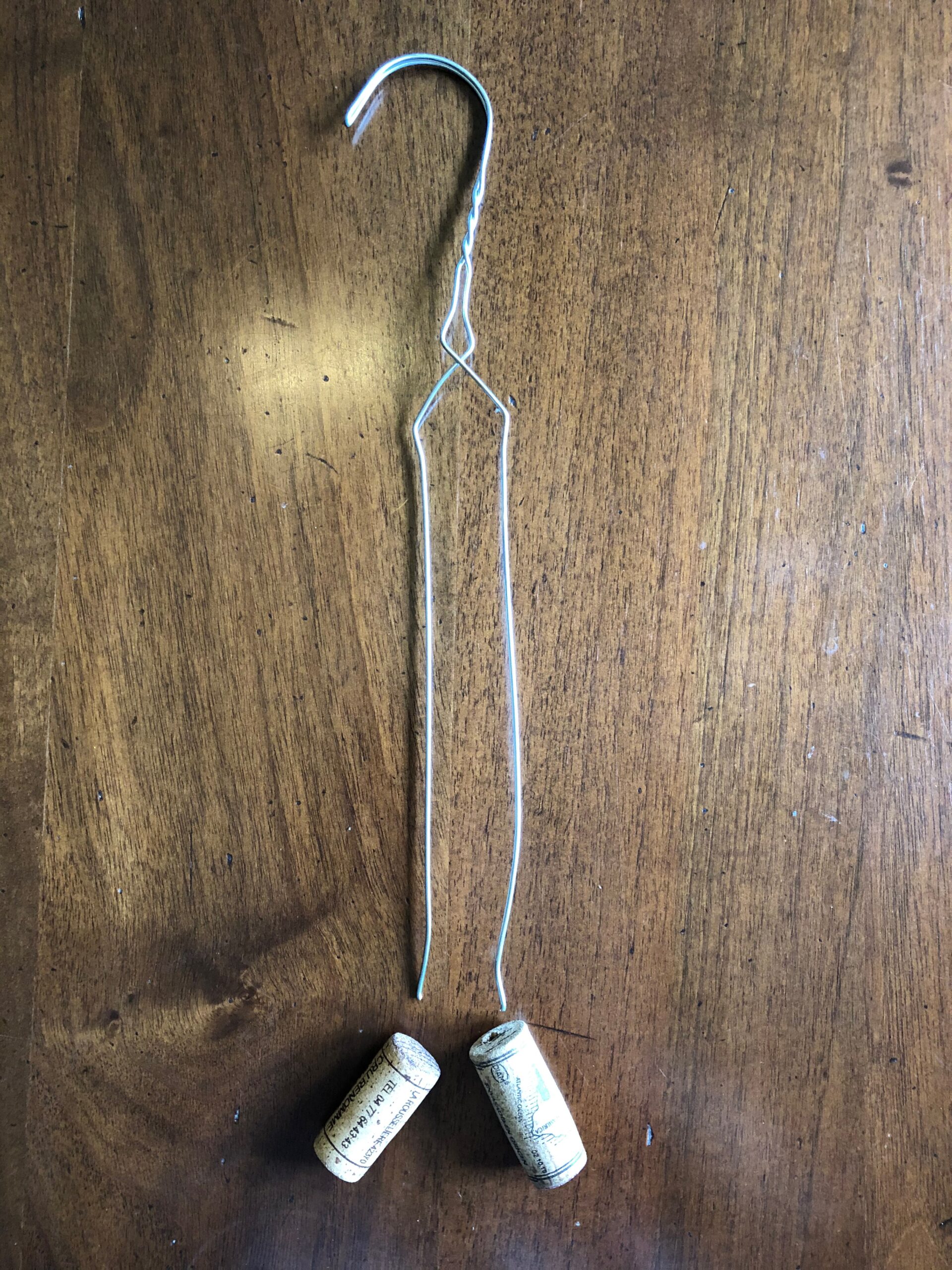
1. Begin by removing the paper rod from the hanger. Either bend or snip off ends of the hanger so that the corks can be attached. If you don’t have any corks or wire cutters, just bend the two ends of the hanger in opposite directions. This will create the bottom of your chandelier and keep the plastic bottles from falling off the hanger. Option: If you don’t have a metal hanger, you can create a sculpture that sits flat.
2. Using scissors, cut off the tops or bottoms of the plastic bottles. Squeezing the bottle flat makes cutting easier. Once that is done, cut on a spiral or in straight lines stopping near the top. Leave enough of the top or bottom of the bottle so that they can be stacked together. Alternating tops and bottoms will create space between layers. Play with both options to see which one appeals to you before cutting all your bottles. (The thickness of the plastic bottles varies by brand; you may need to ask someone for help with the cutting).
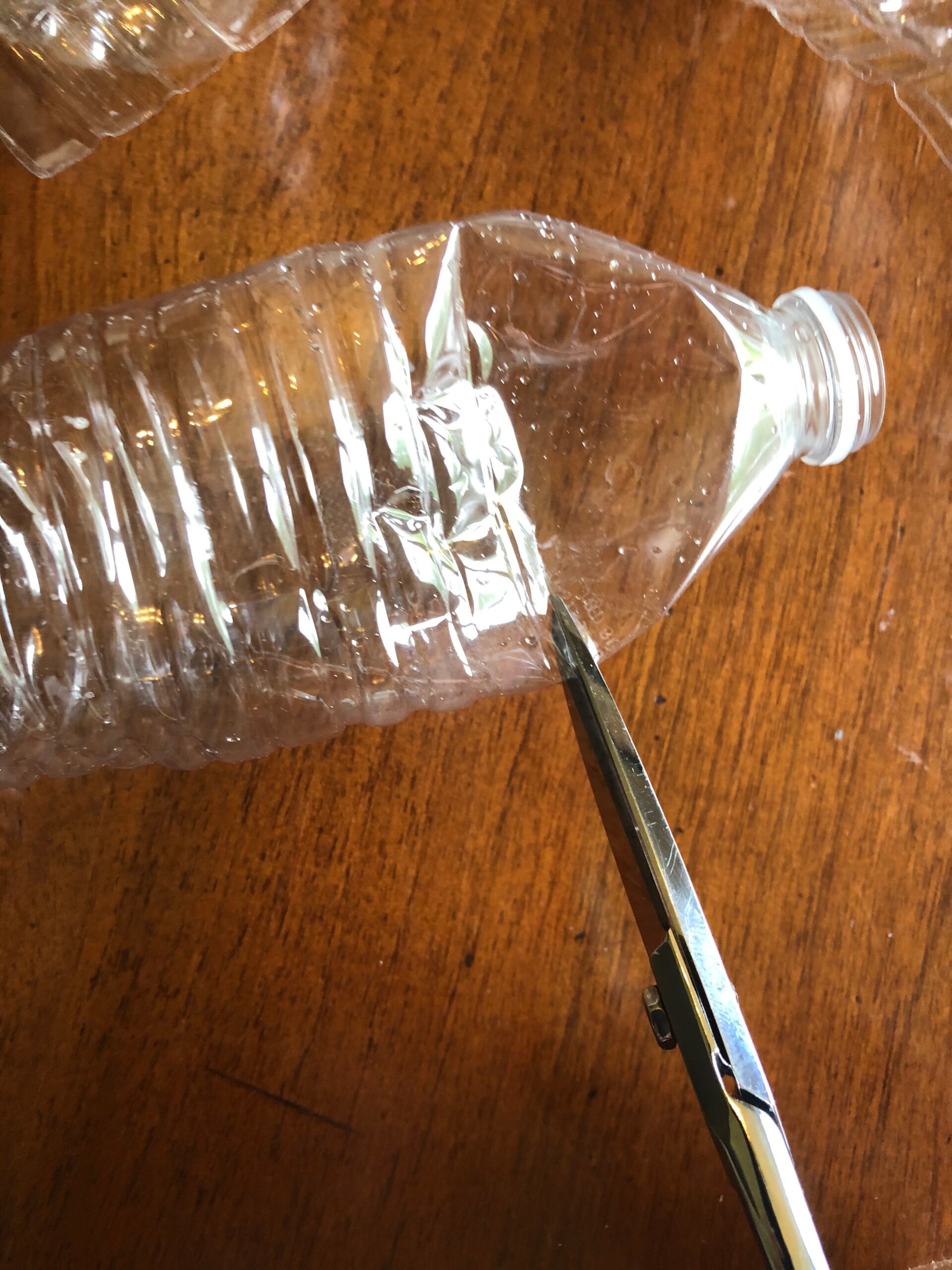
3. If you are using the bottoms of the bottles be careful not to make the hole too big or it will not stay on the hanger. (See lower part of the photo). If you are using the tops of the bottles, cut just below the mouth of the bottle where the plastic becomes thinner. (See upper part of the photo).
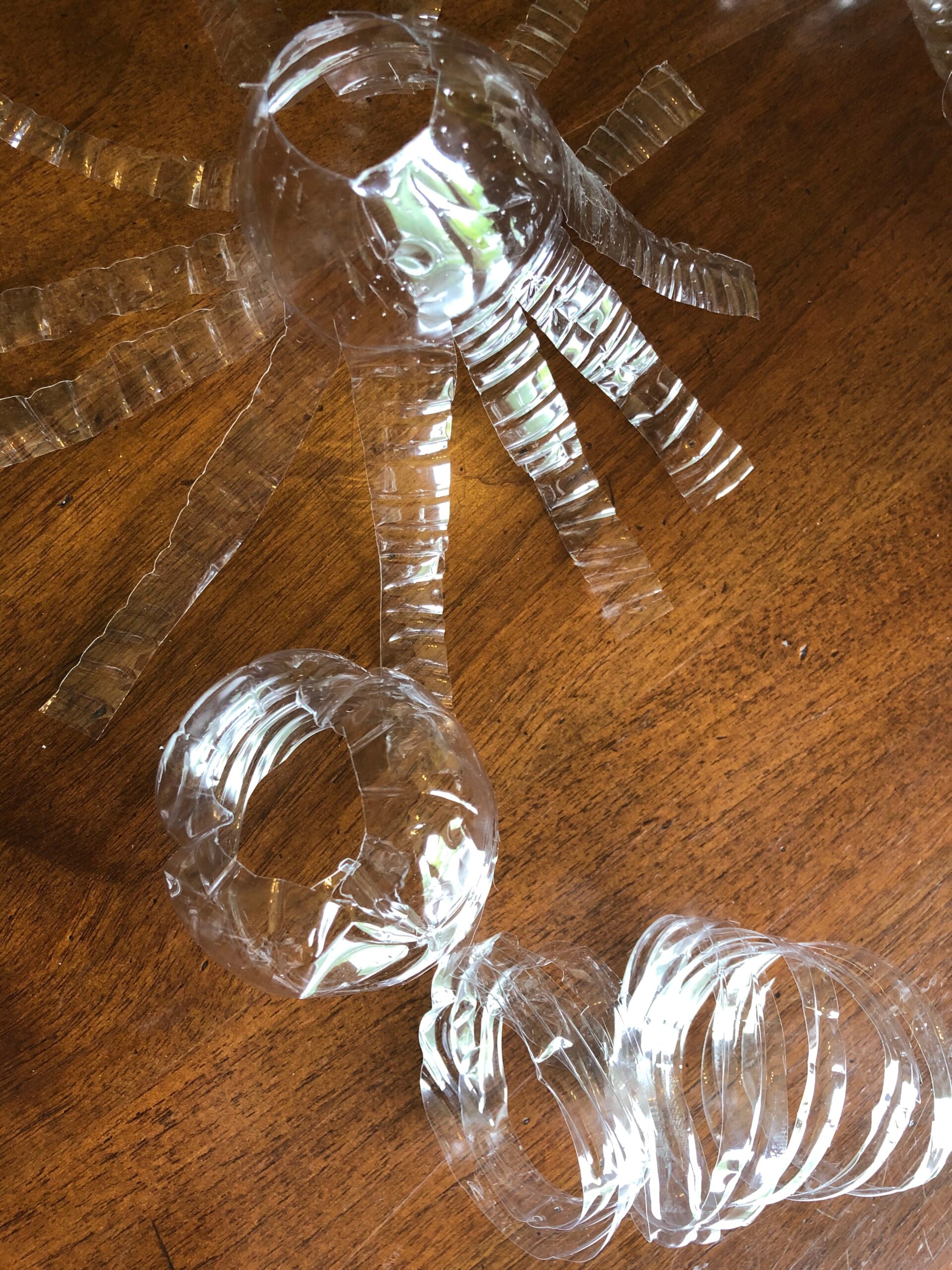
4. After you have decided how many bottles you want to use and how you will stack them, paint them any way you like. If you want the bottom of your chandelier to be seen, paint or decorate your corks. Make sure the paint is dry before assembling.
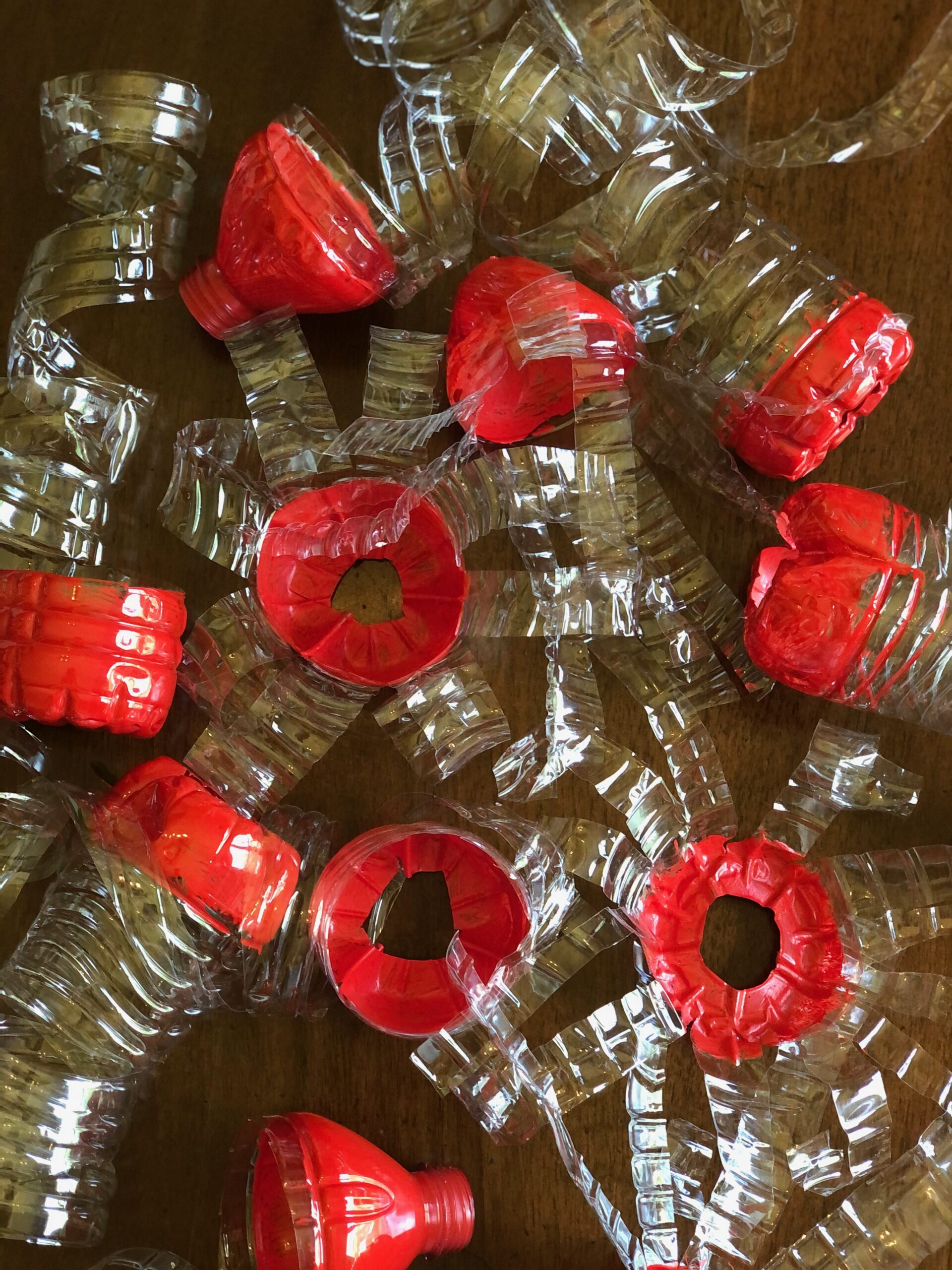
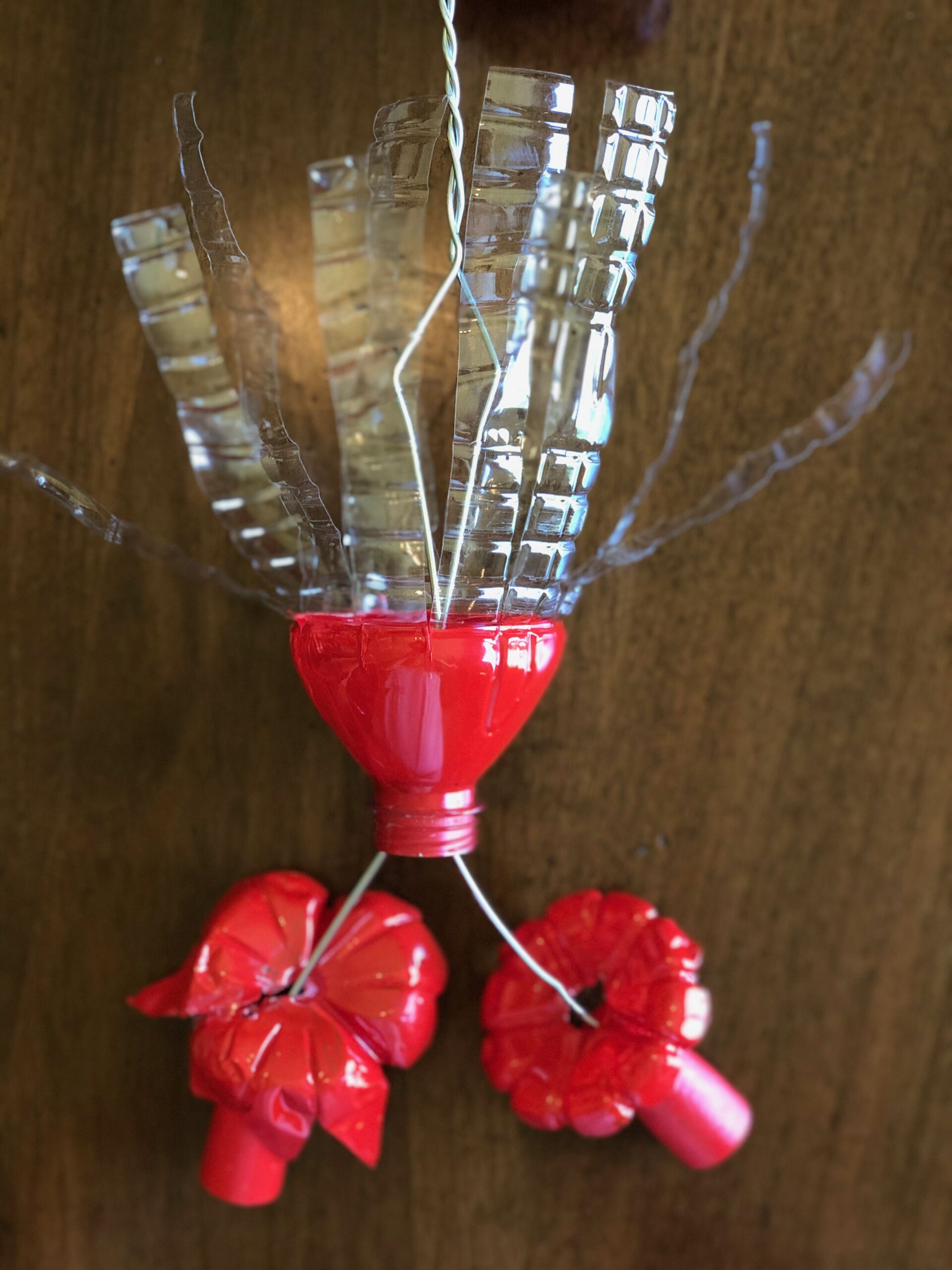
5. Slide each bottle over the top of the hanger, stacking one inside the other. Bending or rolling the plastic strips in the opposite direction will take out some of the curl and create a straighter piece. Have fun creating your own unique work of art!
Challenge: Build a wire armature to create a larger piece. Be sure to watch the video below to see how Dale Chihuly built his chandelier. Add a strand of battery operated mini lights to make this project shine!
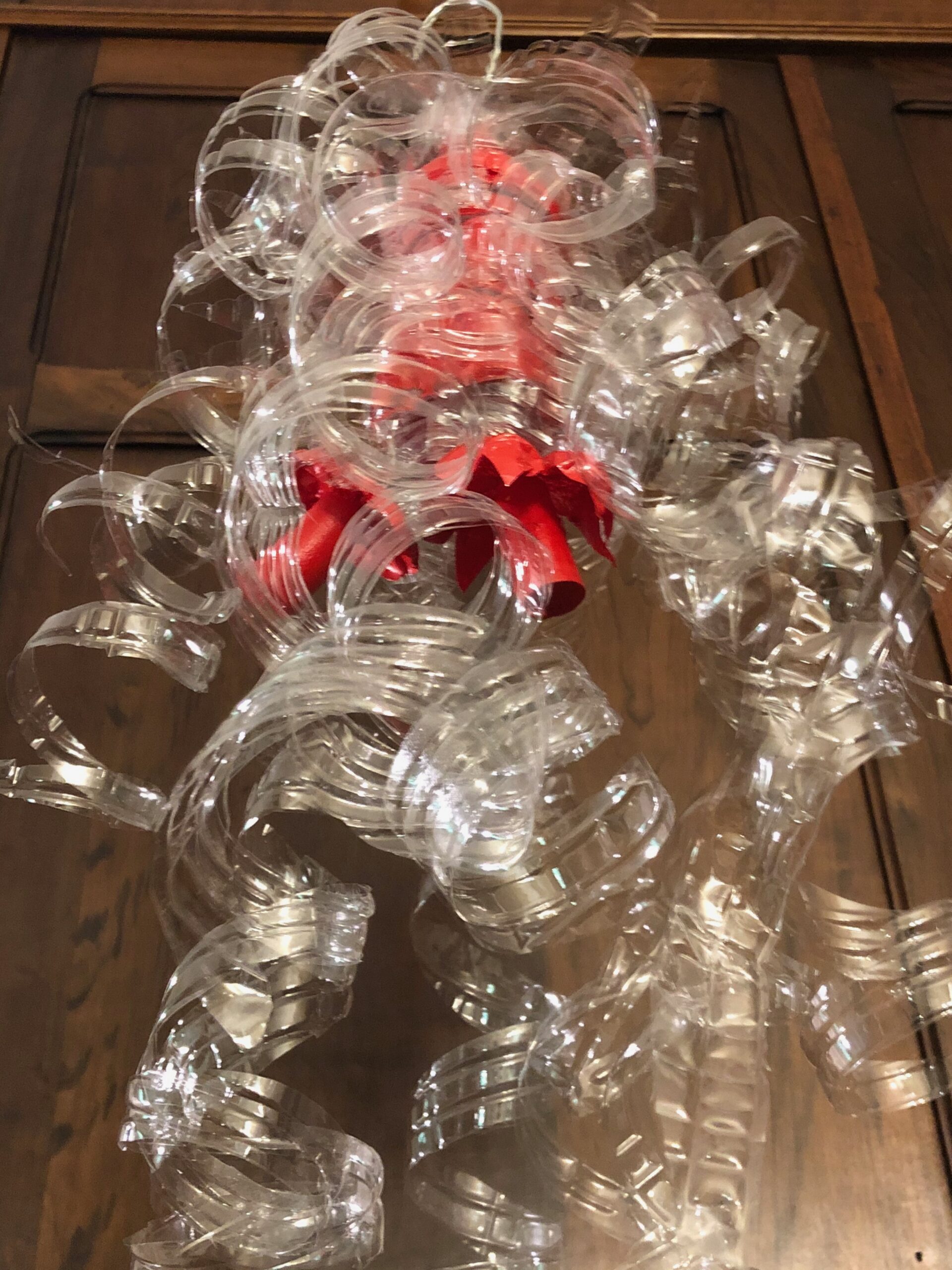
The Mint Museum From Home is Presented By Chase.
‘I would like us to realize we are all interconnected and interdependent, and act with empathy,’ says artist Mark Newport.
Mark Newport is the artist-in-residence and head of fiber at Cranbrook Academy of Art in Michigan. A self-described fiber artist who has worked with print, photography, video and performance art, his most recent work includes traditional European and American mending techniques on used garments. His work Batman in Barcelona is part of the Mint’s permanent collection.
Studio location: Bloomfield Hills, Michigan
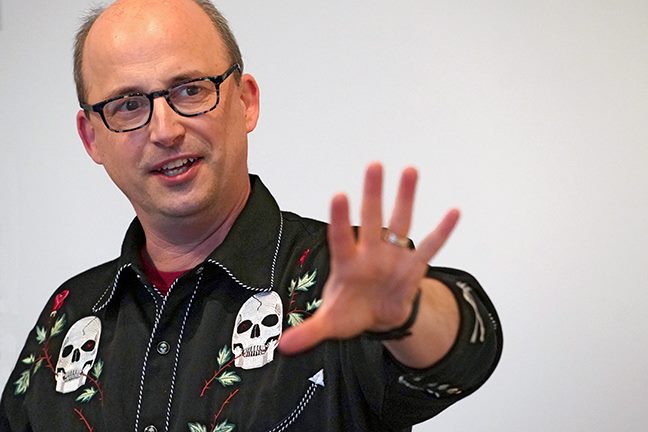
Artist and educator Mark Newport. Photo by Jeff Cancelosi
Who are artists that inspire you and your work?
Louise Bourgeois, Ed Paschke, Lee Bowery, Mardi Gras Indian costumes (Demond Melancon), and outsider art environments (Fred Smith Concrete Park).
What is your favorite piece or artwork that you created and why?
I don’t have one favorite. I am usually most interested in the piece I am working on or the piece I just finished. I think that is because the work is a step in a process of thinking and exploring, so I am involved in what I am doing in the moment. While I am interested in the work when it is finished, I also am already involved in the next thing that grows from what is finished.
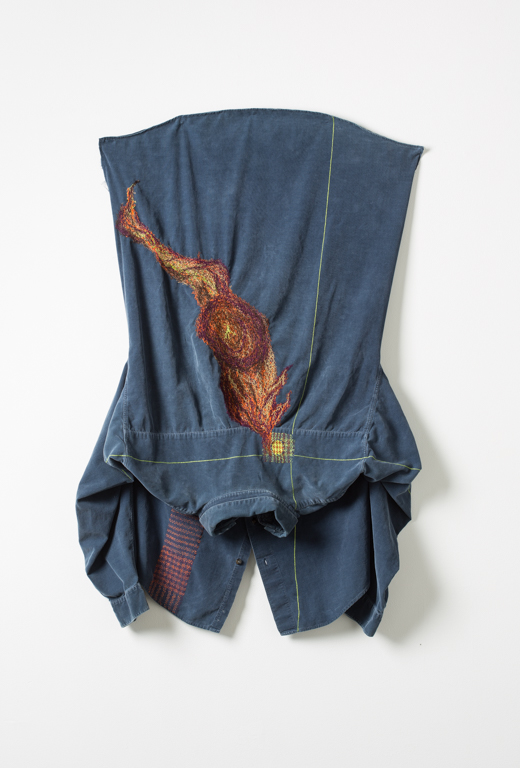
“Redress 4”
How does your environment influence your art?
My work is currently small in scale and portable, so I only need a comfortable chair and good light to work. I prefer a space that is basically a white box with little on the walls beyond what I am currently working on. I also prefer to be able to control the sounds in the space—music, podcasts, movies or television, or silence.
Tell us about your new morning routine.
I wake up around 7 a.m. I usually do some exercise, then eat and read a little. I also play a game of Sudoku or two, and look at Instagram and email. I try to get to the studio by 9 a.m. or so. Between March 13 and last week, I was teaching online, so I was up a little earlier to get to Zoom meetings with colleagues and students.
Are you finding new inspiration for your art during this shift of perspective in the world?
I have been working on projects that started before the stay-at-home order, so I have not really found new inspiration. I am starting to look at the work in different ways because of the virus and the idea of something we can’t see moving between and into bodies. Likewise, I think ideas around healing, mending, and repair are taking on new elements and references in this moment.
Tell us about your afternoon. Are you working from home, going to your studio?
After lunch I work more in the studio for a few hours, take a walk with the dog for about an hour, and then spend some time writing songs and practicing bass and guitar. Before all of this I was in two rock bands. We were writing and developing music, and performing in the area.
What positive perspective changes in society would you like to see come from the pandemic?
I would like us to realize we are all interconnected and interdependent, and act with empathy. I would also like to see us embrace the idea that all tasks and jobs are important, and that people should be able to earn a living wage from all jobs. And how about universal healthcare?
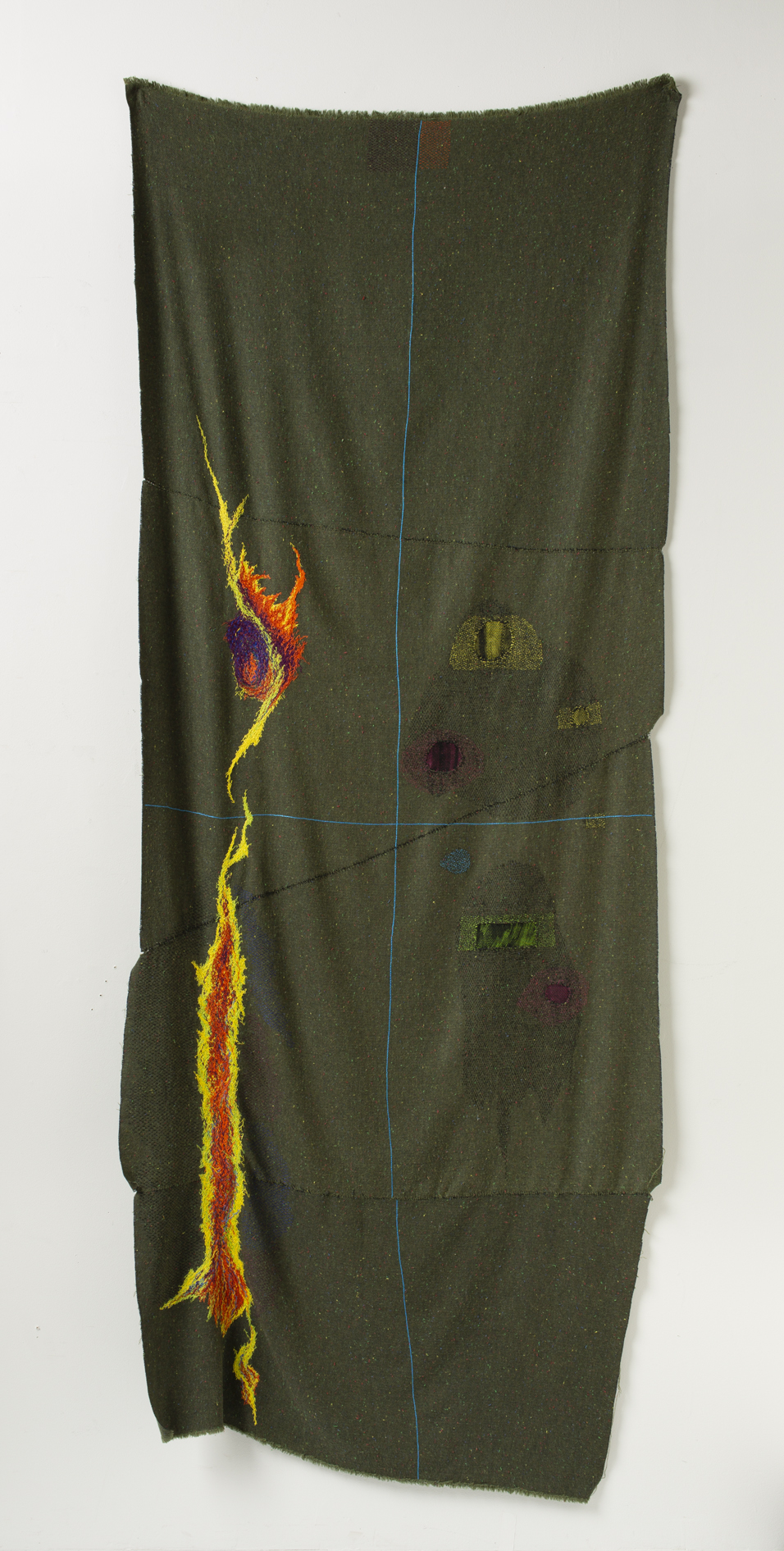
“Amends 2”
How are you winding down your day? Have any recommendations for stress relievers to settle after another day done?
Dinner with my wife, then we watch TV, and I usually knit. Sometimes I play backgammon on my phone. Knitting is my stress reliever.
What are you cooking? What’s your comfort food of choice?
I am a purely functional cook, and the second-tier cook in my family. I did make some cookies using a recipe from Haystack Mountain School of Crafts. They were sharing their recipes on Instagram and I tried to make their chocolate chip macaroons. They were edible, but I didn’t get them right. I will try again and hopefully I can go back to Haystack someday and eat them there.
What are you currently reading?
Working for the Clampdown—The Clash, the Dawn of Neoliberalism and the Political Promise of Punk
What is your favorite music choice?
Punk, ska and rock. I am listening to The Clash as I answer this.
What are your favorite podcasts?
Invisibilia, Hidden Brain, Revisionist History, Beyond and Back
The Mint Museum From Home is Sponsored by Chase.
From war-torn Colombia to the Mint: how one staffer found her home away from home at the museum
A native of Colombia, South America, Murrain joined the Mint team as community programs coordinator in 2018, where she (alongside Rubie Britt-Height, director of community relations) helps organize some of the museum’s most dynamic programming catering to the region’s international audience and anyone who wants a taste of the world outside Charlotte. Murrain is also an award-winning poet, a talented performer (she was part of The Vagina Monologues at Queens University of Charlotte in 2016), and always ready with an easy laugh.
Here’s Murrain’s story, as told to Caroline Portillo. Lightly edited for brevity and clarity.Escobar, narcos and ‘a good place to be’
We watch a lot of American TV and movies in Colombia. I grew up poor, and to watch those TV shows, I thought everybody in the United States lived an abundant life, and had beautiful houses. Plus, in my country, there was a lot of racism. My brother and I were usually the only black students in the school, and we were bullied because we were black. I didn’t see that on the TV shows in the United States, so I thought, “that’s a good place to be.”
I was also living in Colombia during the time of Pablo Escobar and the narco war. I experienced so many horrendous things. They were killing everybody—journalists, artists, important people from the government. They were kidnapping and putting car bombs everywhere. So, yes, I was dreaming about the United States, but I also had another motivation to get out of there.
[NOTE: I am happy to report that Colombia’s former president Juan Manuel Santos won the Nobel Prize for his efforts to bring the nation’s more than 50-year civil war to an end. Colombia is now a safer, more beautiful place.]In 1998, a coworker told me the YMCA was recruiting summer camp counselors from other countries. I was hired to work at a special needs camp in New Jersey for three months. I had my first experience in the United States and wanted to come back. I came back in 2000 to work at another special needs camp in the Catskills in New York.
Afterward, I kept thinking “I want to go back, but I want to work in my field, education.” In Colombia, I was teaching English at several universities and teaching private classes at a bank, so my friend told me about a program called Visiting International Faculty, that hires teachers to come to the U.S. for three to five years.
I called them and told them about my experience, and they said I was the perfect candidate except for one little thing: I needed to have had a drivers’ license for at least two years. I didn’t drive. So I started taking classes, got my license. This was the thing I’d been dreaming of my whole life, so I was like, “OK, it’s only two years.”
I was 32 when I could finally apply to be a teacher in the US. I marked on my application that I wanted to work in California. That’s what I’d seen in the movies. But it was a school in Charlotte that wanted me, South Meck High School. And they wanted me to be there in two weeks. I had a mini panic attack, heart attack, and stroke at the same time. And when I saw the email, I said “Charlotte?”
I even considered not going because I’d fallen in love. And this man was gorgeous. But when I told him, “Hey I got this email and I may go to Charlotte in two weeks,” he started laughing. I said, “What the heck?”
And he said, “I’m laughing because my best friends live in Charlotte.” ‘Like Disneyland’
It was amazing. The guy I was dating made introductions on email, and his friends said I could stay with them at their home off Carmel Road while I settled down. I didn’t even have a car, so they took me to school and picked me up in the afternoon. I taught English as a Second Language (ESL) at South Meck for three years.
In 2005, one of the Spanish teachers, Mr. Lopez, told me there was a poetry contest at the Mint Museum. You didn’t have to sign up for anything. Just show up and read your poem.
We went straight to the auditorium at Mint Museum Randolph. I didn’t win, but there were more contests at the Mint—four a year—and I won three consecutive times between 2005 and 2006.In 2016, I went to teach English in China for a year. I love adventure. But even while I was there, Rubie asked me to send a video of a poem for the Mint’s Día de las Velitas (Day of the Candles) celebration, a Colombian tradition, that December. And a few months later, she had an event at
the museum while I was visiting a cousin in Thailand, and she asked me to read a poem I wrote while I was in China. Because of the time difference, I got up at 5 AM to get ready to connect to Charlotte via Skype.
When I came back to the U.S. I returned to teach Spanish at a school in South Carolina, but I wasn’t fulfilled. Then Rubie gave me a call. She said there was a position open at the Mint for a community programs coordinator and that I should apply.
When they hired me on April 30, 2018, I was ecstatic. The Mint was the best place in the world. Like Disneyland.
Called to be inspired
The Mint is the most beautiful place. It’s quiet. It calls you to meditate, to be inspired. And my coworkers are so kind. Before working at the Mint, I already had strong ties to the Latin community and the artistic community. I’d been on panels and shared poetry at places like Queens University and Johnson C. Smith University. But being at The Mint Museum now is a platform on which I can help others. It’s exciting to plan for them, to talk to the performers, to see them and see the reaction of the people. It makes me feel accomplished, too. After each event I think, “Wow, this was great. And I was part of it.”
What I love about the Mint’s programming is I am able to see such a variety of artists, painters, musicians, dancers, poets. It’s such a great array. Every program is so unique and brings a different public.
The Mint is a big part of the Latin community. At Mint Música & Poesía Café—a biannual event that features talented poets, dancers and musicians from the region— we’ve had a salsa dancer who’s now dancing at an academy in New York. We’ve had a cellist from Colombia play while a PowerPoint of photos from Colombian landscapes played. We’ve had a poet from Puerto Rico share a powerful story about his father. Before I worked at the Mint and heard about Mint to Move—our bimonthly cultural dance night that regularly draws 300 to 400 people—I was like “We can dance at the museum? And there’s a DJ and sometimes a live band playing? Oh my gosh.” So I started bringing all my friends.
Through Mint to Move, I’ve met black people from other Latin American areas and countries, such as Puerto Rico, Cuba. They understand the struggle. For instance, I teach with the Mint’s Grier Heights Youth Art Program on Wednesdays. The children think I’m black before I speak. And then once I speak, they just open their eyes and are like, “you’re not black.”It’s very touching to be able to see and experience artists who are from your country or any Latin American country. It’s like bringing a little bit of home to the community. And the language—to be able to listen to poetry or music in Spanish. The older people especially get so emotional when they can listen to their language and talk to people like me. It’s a great way to stay connected to their community and their country.
Then I also work with people who just want to know more about Latin American culture. We had a group from UNC Charlotte and another at Johnson C. Smith University who started coming to Mint Música & Poesia Café and Mint to Move. They just love these events. Then there’s Bilingual Stories & Music, which draws Latin families, Asian families, African-American families, white families. And there are so many marriages with spouses from the U.S. who want to learn about their spouses’ cultures through our programs. It’s a beautiful connection they make because they have that special person next to them, and they’re experiencing the programs together. They can see through different eyes. And because of the Mint, I get to be a part of that.
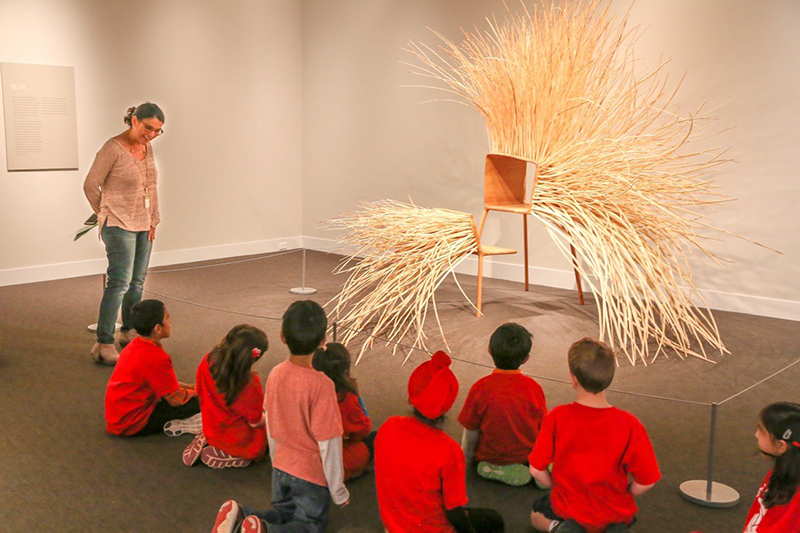
6 common misconceptions about visiting The Mint Museum — and what to know instead
By Rubie Britt-Height and Michele Huggins
An art museum is a building that houses artworks, but moreover it’s a place for anyone in the community who enjoys viewing art to visit. Following are a few misconceptions debunked about visiting The Mint Museum.
Misconception: I have to dress up to visit The Mint Museum
Truth: Come as you are! Just like art is not one size fits all, neither is individual style. From casual T-shirts, jeans and sneakers to suits and ties, skirts or sweatshirts, it’s all good at the Mint.
Misconception: I have to know about art to visit the museum
Truth: You don’t have to know anything about art to visit the Mint. While learning about abstract paintings, fashion, ceramic art, furniture or hand-blown glass, we simply want guests to enjoy exploring the collections and galleries. Thanks to AVO Insights and the Arts & Science Council, we recently unrolled augmented reality into the museum galleries. By hovering your phone over select works of art, a video about the artwork appears. Until you can experience it in person, check out the videos by following @themintmuseum on Instagram.
Misconception: The Mint Museum is only uptown
Truth: The Mint Museum Uptown celebrates 10 years in October 2020 at Levine Center for the Arts on South Tryon Street, but Mint Museum Randolph is the original Mint Museum location, opening its doors 1936. Located at 2730 Randolph Road, Mint Museum Randolph houses Native American, Fashion, Decorative Arts, and Art of the Ancient Americas collections, in addition to the most recent exhibition Classic Black: The Basalt Sculptures of Josiah Wedgwood and His Contemporaries on view through Jan. 3, 2021. Modern and Contemporary Art, American Art, European Art, and Craft+Design collections fill the galleries at Mint Museum Uptown.
Misconception: All the art at The Mint Museum is old and stuffy
Truth: Collections at the Mint are diverse and recognize the talent of artists of all ages and backgrounds. Constellation CLT showcases artists throughout the city and region with installations rotating three times per year in four places at Mint Museum Uptown: in the entrance; at the foot of the atrium escalator; and on the landings of the Mezzanine and Level 4.
Misconception: There’s nothing for my young children to do at the Mint
Truth: Through self-guided ARTventures scavenger hunts, and interactive play opportunities at the Lewis Family Gallery*, there’s something for the young ones at the Mint. Stroller tours are available for parents that want to enjoy art with little ones in tow. Plus there is a specially designated room for nursing mothers. At Mint Museum Randolph, children can run and play in the outdoor park, or plan a picnic under a giant shade tree near the rose garden before touring the galleries.
*Due to many touch points, the Lewis Family Gallery will remain closed after the museum re-opens while we implement safety precautions during COVID-19.
Misconception: You have to be a member to visit
Truth: Single-day admission tickets are available, and museum admission is free Wednesday from 5-9 p.m. at each museum location. Live at the Mint events are free to the public and feature local musicians and performing artists, as well as artist discussions. Check the calendar for the event schedule. Membership does, however, have benefits. From special events to discounts on programming, see if a membership is right for you.
Connecting communities through cultural initiatives
By Rubie Britt-Height, director of community relations
From free, live events to educational engagement with youth, the Mint strives to make art accessible for all community members. Following are just a few of the programs dedicated to welcoming community to explore collections at The Mint Museum.
Grier Heights Community Youth Arts Program
The Grier Heights Community Youth Arts Program guides youth grades 4-12 via art education and artist-led projects in a weekly after school program in the Grier Heights community located across from Mint Museum Randolph. To date over 500 youth have engaged in Grier Height’s unique and intriguing art activities that encourage self-esteem, respect, wise decision-making, critical thinking, and learning that greatness is measured by service. Participants are mentored by a team of community leaders and accomplished artists-educators.
Participants express themselves through art modules on writing, drawing, quilting, and portraiture as they learn about etiquette, financial and cultural literacy, dental and personal hygiene. Participants also visit both Mint locations to view the Mint’s collection and exhibitions, engage in art activities, attend theatrical and music productions at the Blumenthal and the Mint, take spring break trips to the State Capitol, Governor’s Mansion, and State Buildings, and visit city parks and highlights.
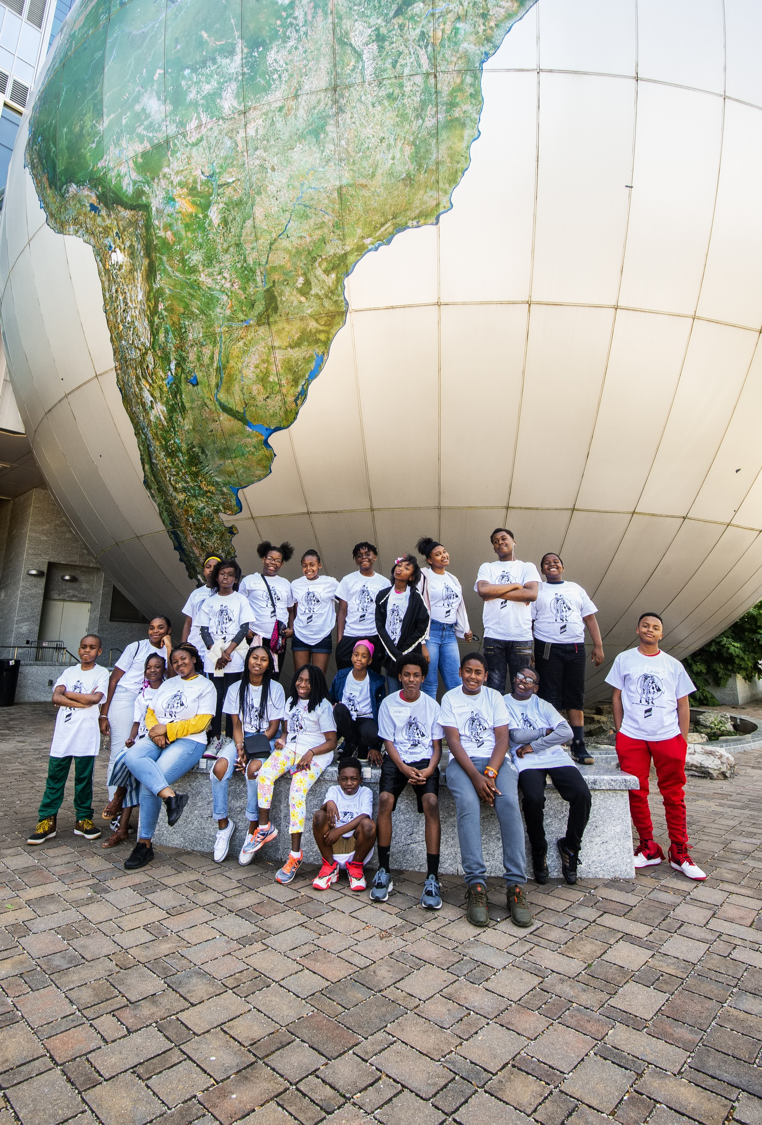
A group from the Grier Heights Community Youth Arts Program visits Raleigh.
Latino Programming
Programs attract both the Latin American community and everyone interested in Latin culture take place at the Mint all year around. Programs like Mint to Move, Bilingual Stories and Music, and Con a de Arte welcome a host of audiences including families, young adults, professionals, adults, and artists.
Mint to Move Cultural Dance Night
One of the hottest events in town held on one of the best dance floors in Charlotte, Mint to Move Cultural Dance Night invites participants to put on their dancing shoes and experience Latin, African and Caribbean music and dance. Based on the artwork May I Have This Dance by Sheila Hicks, the cultural program unites the community on the dance floor with veteran DJ Carols Lebron mixing a repertoire of international music, including Afro-House, Afro-Cuban, and Latin-American dance rhythms. Guests enjoy free dance lessons from local dance companies like Oneaka Dance Company, and Rumbao Dance Company, and samba, salsa, bachata, cha cha, line dance, and step to other dance forms relative to various global communities.
Bilingual Stories and Music
Children age 6 and younger and their families enjoy coming to Mint Randolph for bilingual stories in Spanish and English. And it’s all free! Bilingual Stories and Music allows kids and their caregivers to learn Spanish with musical instruments, puppets, toys and games and songs featuring the musical team, Criss Cross Mango Sauce.
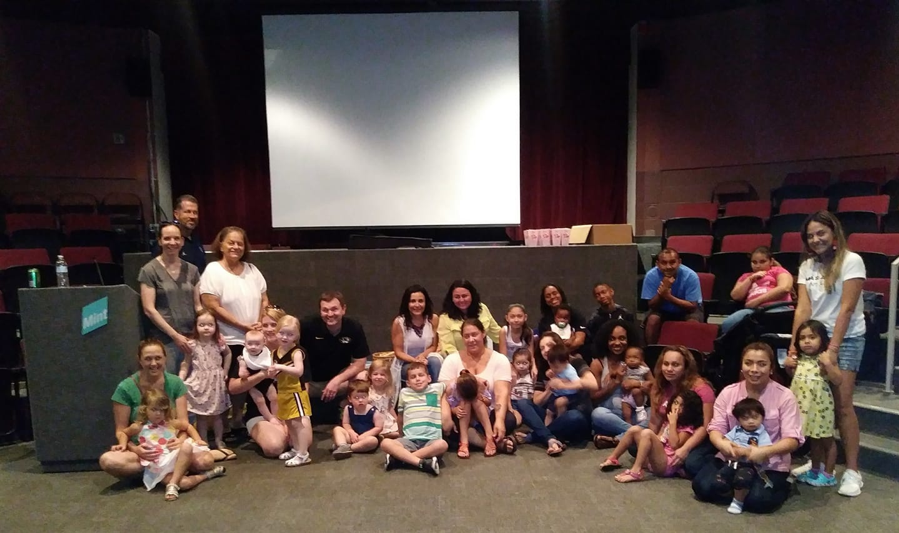
Bilingual Stories with Criss Cross Mangosauce members Ana Lucía Divins and Irania Macías-Patterson.
Mint Musica’ and Poesia
Mint Música and Poesía Café is a bi-annual program that features talented poets, dancers, and musicians from Charlotte’s Latin community. The program celebrates Hispanic Heritage Month with performing artists like Alma de la Luna and the NC Brazilian Dancers. It also ties in with the Latin American artwork in the collection and special exhibitions.
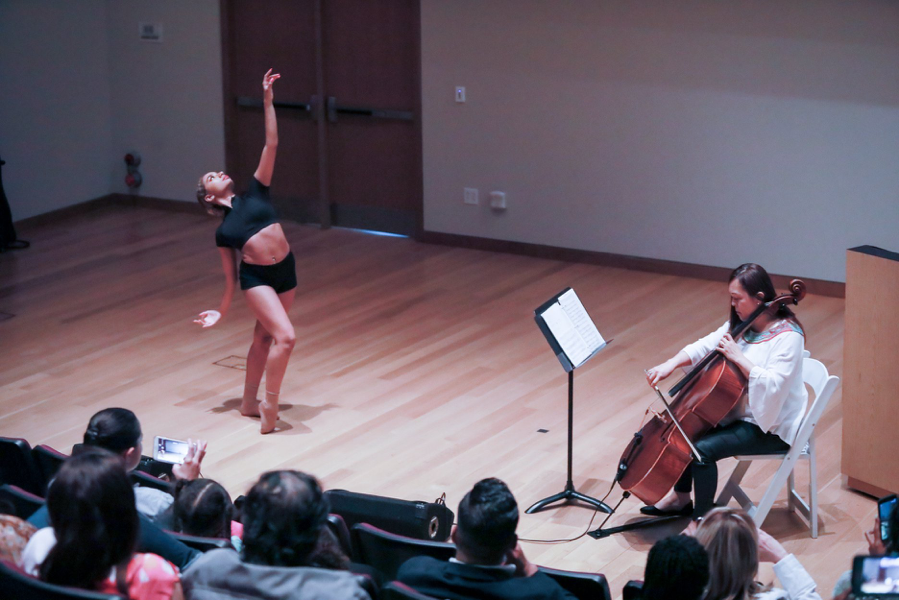
Mint Música & Poesía Café. Dancer Sarah Stafford & Cellist Victoria Yepes McLaughlin.
ArtSí – Con A de Arte (A is for Art)
Through a close relationship with the local Latino arts community, The Mint Museum provides support for the Con A de Arte (A is for Art) event as part of a partnership with ArtSí Charlotte.
Con A de Arte is an annual event that aims to showcase the work of local artists from the Latin American community in the Charlotte area through presentations modeled after the TED Conferences, which include visual art presentations, and performances by musicians, dancers, poets, and actors.
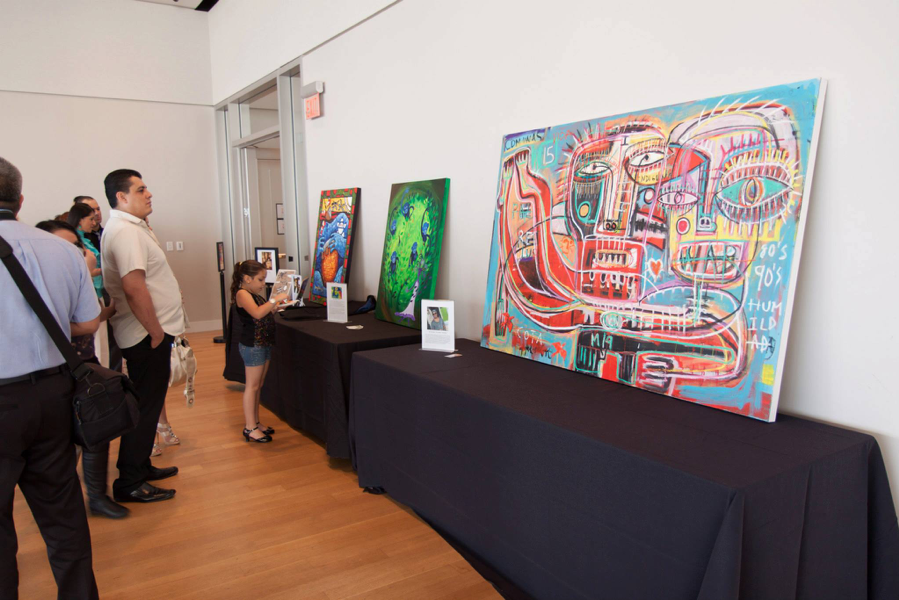
Con A de Arte (far right, piece by Nico Amortegui).
Virtual Programming
Implementing live recordings of community programs has opened a new audience for the Mint. Record viewership has given access to the Mint as it continues to reach more diverse audiences. Live presentations shown on the Mint website include:
- Requiem for Mother Emanuel: From Tragedy to Triumph with Dr. Leo Twiggs
- African Dancing and Drumming with the Oneaka Dance Company
- Pre-Charlotte Jazz Festival: Jazzin’ on the Terrace with The Juke Joint, featuring Vocalist Nicci Canada, Spoken Word Artist Quentin Talley, and Visual Artist & Live Painter Curtis King
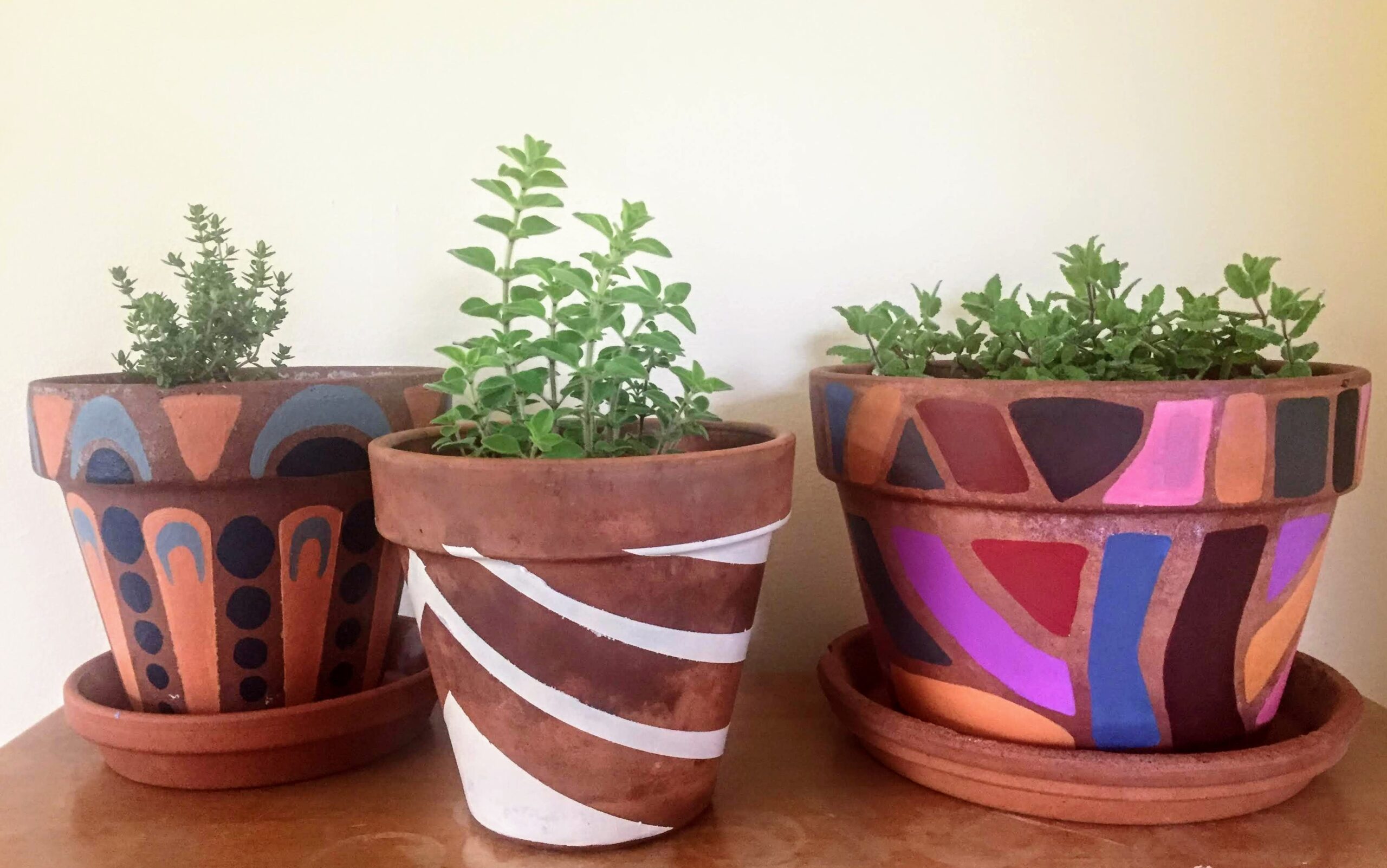 Freshen up with contemporary patterned pots
Freshen up with contemporary patterned pots
Get excited for spring and explore color, shape, and pattern with this fun terracotta pot-painting activity. This project is inspired by Thomas Downing’s painting, Grid 5, which features a circle, repeated in variations of color and subtle patterning within a grid-like structure.
Materials:
- Any old terracotta pot, just make sure to clean it well first
- Acrylic paint (try house paint if you don’t have art acrylics)
- Paint brush
- Water cup for brush cleaning
- Something to use as a paint palette (paper plate, wax paper, etc)
- Paper towels and newspaper to manage mess
- Masking tape or painters tape (not required)
*Note that acrylic paint is not washable. If you are collaborating with a young child, dress for a mess, and supervise at all times. Or, try a similar process with washable materials on paper, instead.
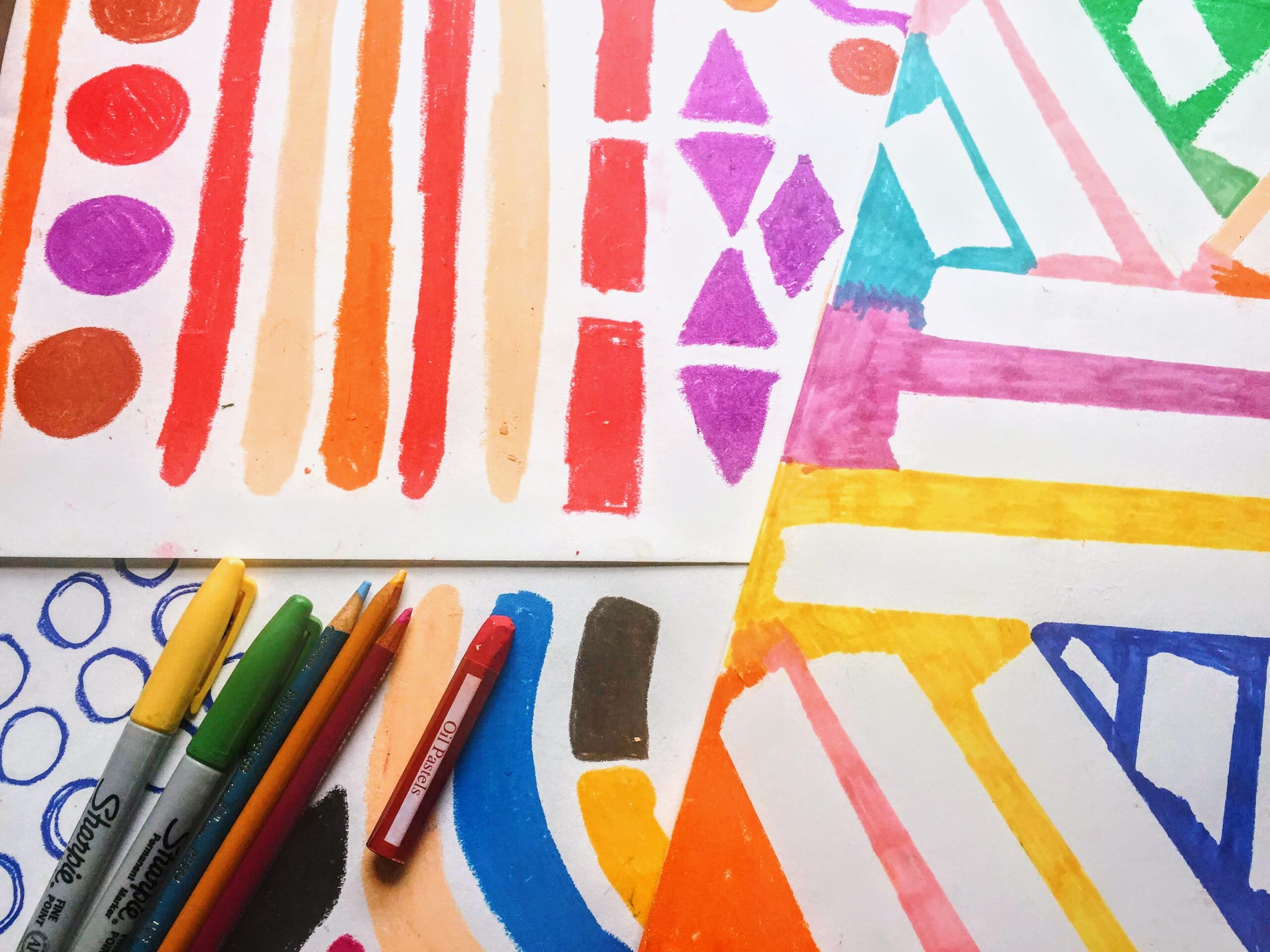
Brainstorm what colors and patterns you want on your planter. Think about using repetition of line and shape to create patterns. Explore how different colors interact with one another.
Map out your design onto your pot. Use a pencil to lightly draw your design onto the pot. Lay out strips of tape if you want to create stripes or clean lines with your design.
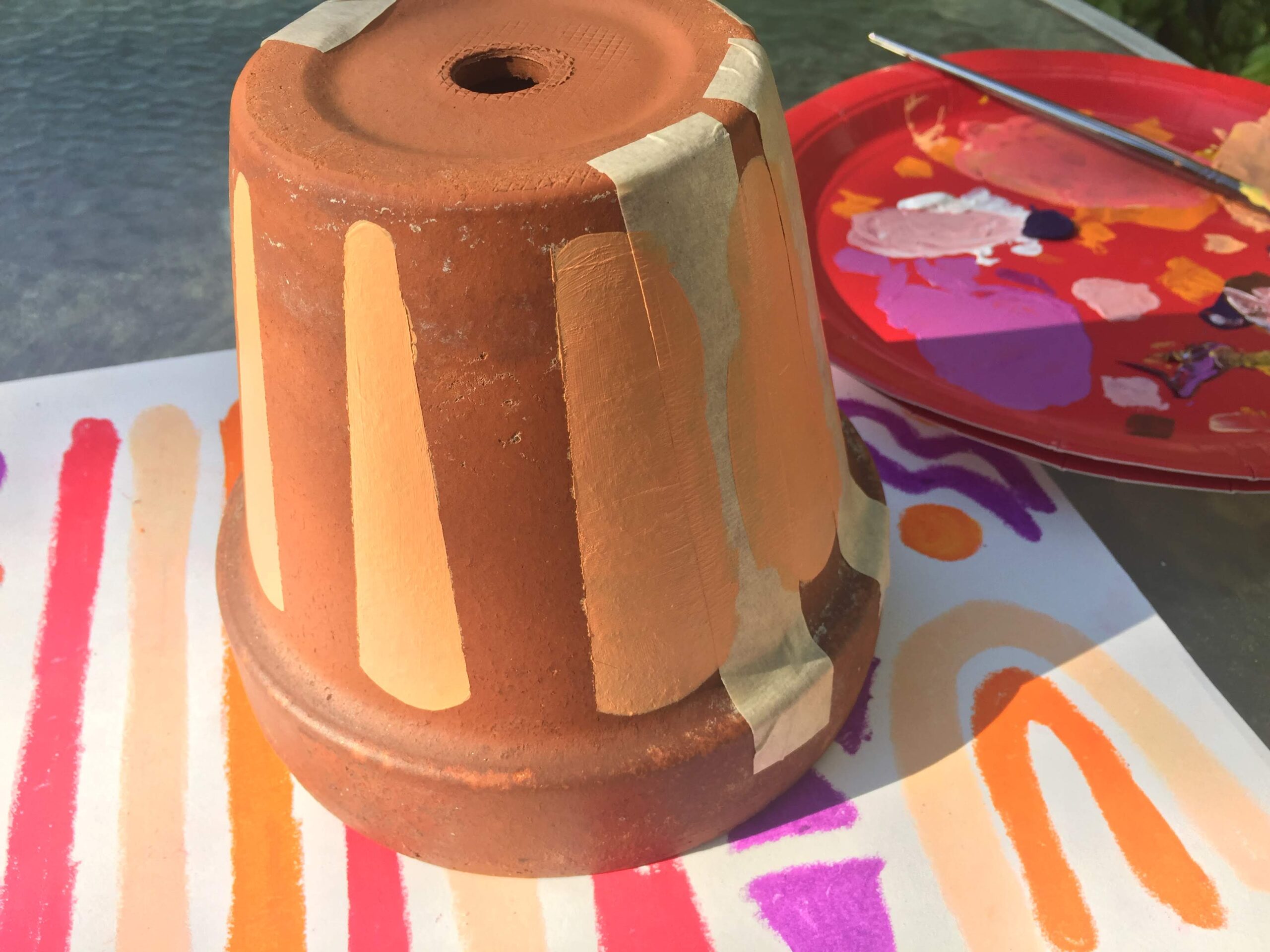
Paint your pot. Start with the large designs, and work your way to the more detailed areas. Be sure to let areas dry between coats. If you make a mistake, you can simply let the area dry and then come back and paint over it. Try to leave areas of your pot unpainted. This will help the soil and pot to dry out between waterings, and mimics Downing’s use of unprimed or raw canvas.
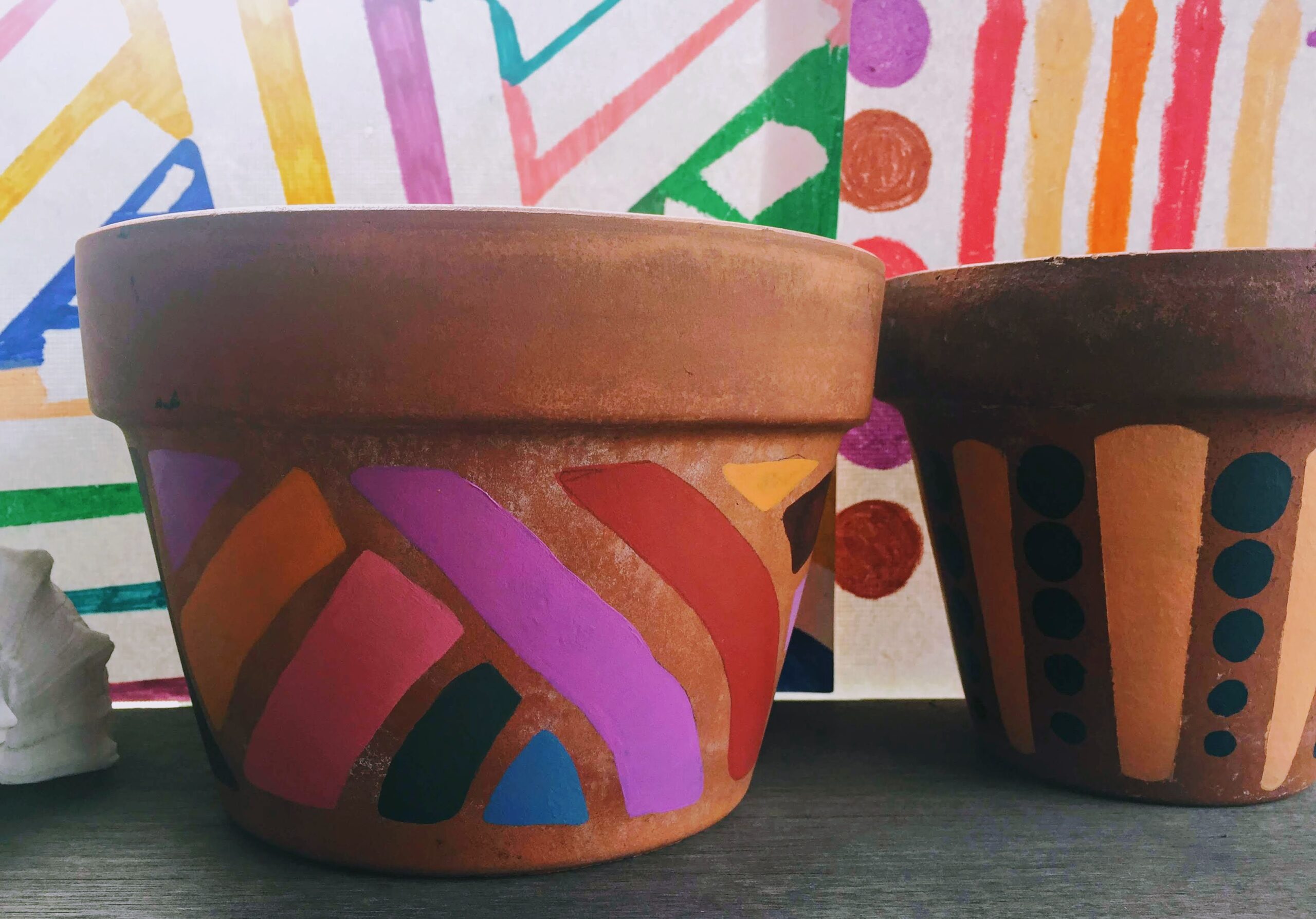
Exhibit your artwork. Once you’re satisfied with your creation, find somewhere special to display it at home.
The Mint Museum From Home is Presented By Chase.
The Mint supports a donor’s desire to give back
By Rubie Britt-Height, Director of Community Relations
The Mint Museum recently provided over $2,000 in gift cards and reusable Food Lion grocery bags to families in need during the COVID-19 pandemic. Funded by an anonymous donor and Food Lion Stores, the cards were given to families of the students of the museum’s 16-year old Grier Heights Community Youth Arts Program, and to members in the west Charlotte community.
A generous gift of $1,500 was given by an anonymous donor to purchase 50 Food Lion cards in denominations of $35, $25, and $20 at the north Wendover Road Food Lion store near the Grier Heights community. The Mint shared the effort with Millette Granville, vice president of talent, diversity and inclusion, learning and organizational development for Food Lion, a U.S. division of Zaandam-based Royal Ahold Delhaize Group. The company quickly responded with an additional $500 in $25 gift cards, two cases of reusable tote bags to help the family recipients, and facilitation with store No. 971 to process the cards.
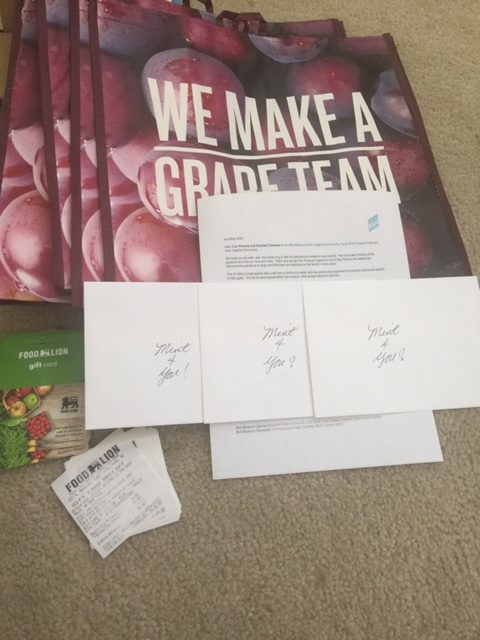
Each family received a tote bag, gift card, and note from the Mint Museum.
“As a child, I grew up in similar challenging yet overcoming circumstances in a Charlotte housing project. I want to give back, and see that the students and families have access to having their temporal needs met, as well as to education and memorable experiences,” wrote the anonymous donor. “You all are doing good community work at the museum and I knew you could successfully facilitate our desire to help families who are trying to hold it together.”
The donations not only helped the Grier Heights community, it supported families of the McCrorey YMCA after-school program and citizens temporarily displaced at two YMCA camps in west Charlotte. Thirty bags and cards were delivered to the McCrorey YMCA, led by Executive Director Dena Jones, a former Mint docent and student of retired Mint master art teacher Rita Schumaker. Jones noted the great need of families there and those displaced.” These 30 cards and bags will be a blessing to them all, and we appreciate it. Hunger is real, even in Charlotte,” Jones says.
The Mint’s program teen team leader Alex Brown and her mother, Stacey Price Brown, PhD, president of the Grier Heights Community Improvement Organization, have deep roots in the community. They delivered the 43 bags to families during Mother’s Day weekend.
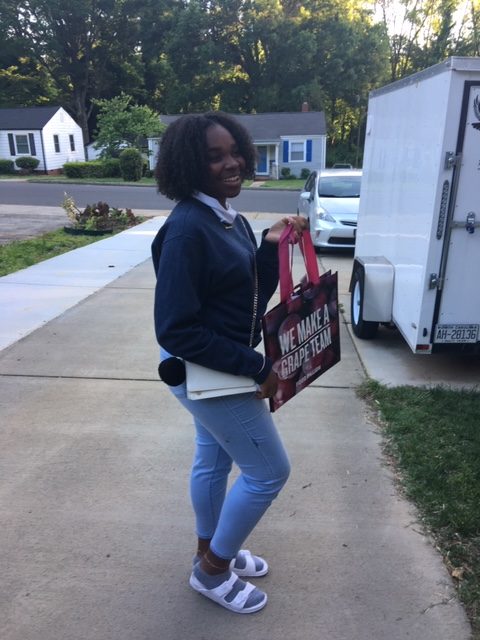
Mint Museum Community Youth Arts Program teen leader Alex Brown delivers a Food Lion tote bag and gift card to a family.
“The Grier Heights community embraces four core values: self-sufficiency, education, empowerment and family! Through our partnership with the Mint Museum you empower our families to educate themselves about their history, their cultures and their health so that they can be model citizens of self-sufficiency for themselves, their families and their communities. Through this COVID-19 pandemic, you have not stopped honoring our community’s core values by sharing care packages, Food Lion gift cards and inspiring messages to empower and educate our families to stay safe and healthy,” Brown says. “We are very thankful for partnerships and neighbors like you who have invested in our community for over 15 years, and the return on your investment has produced many youth and families who are healthier individuals mentally, physically and emotionally so that they, collectively, can go into our society making it a more livable, equitable and just place.”
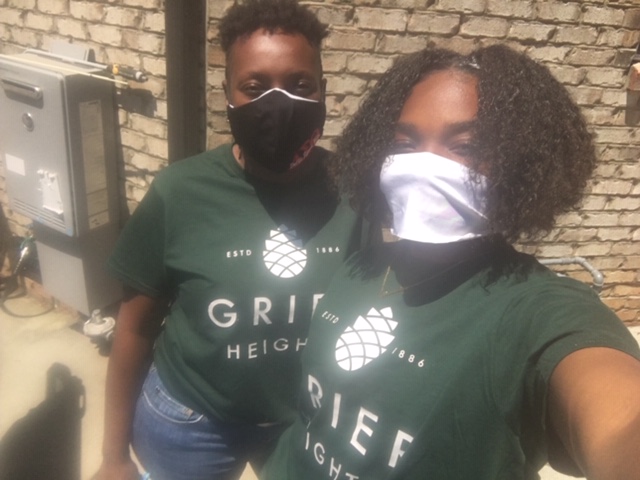
Dr. Stacey Price Brown, president of the Grier Heights Community Improvement Association, gets ready to deliver 43 Food Lion tote bags and gift cards within the community.
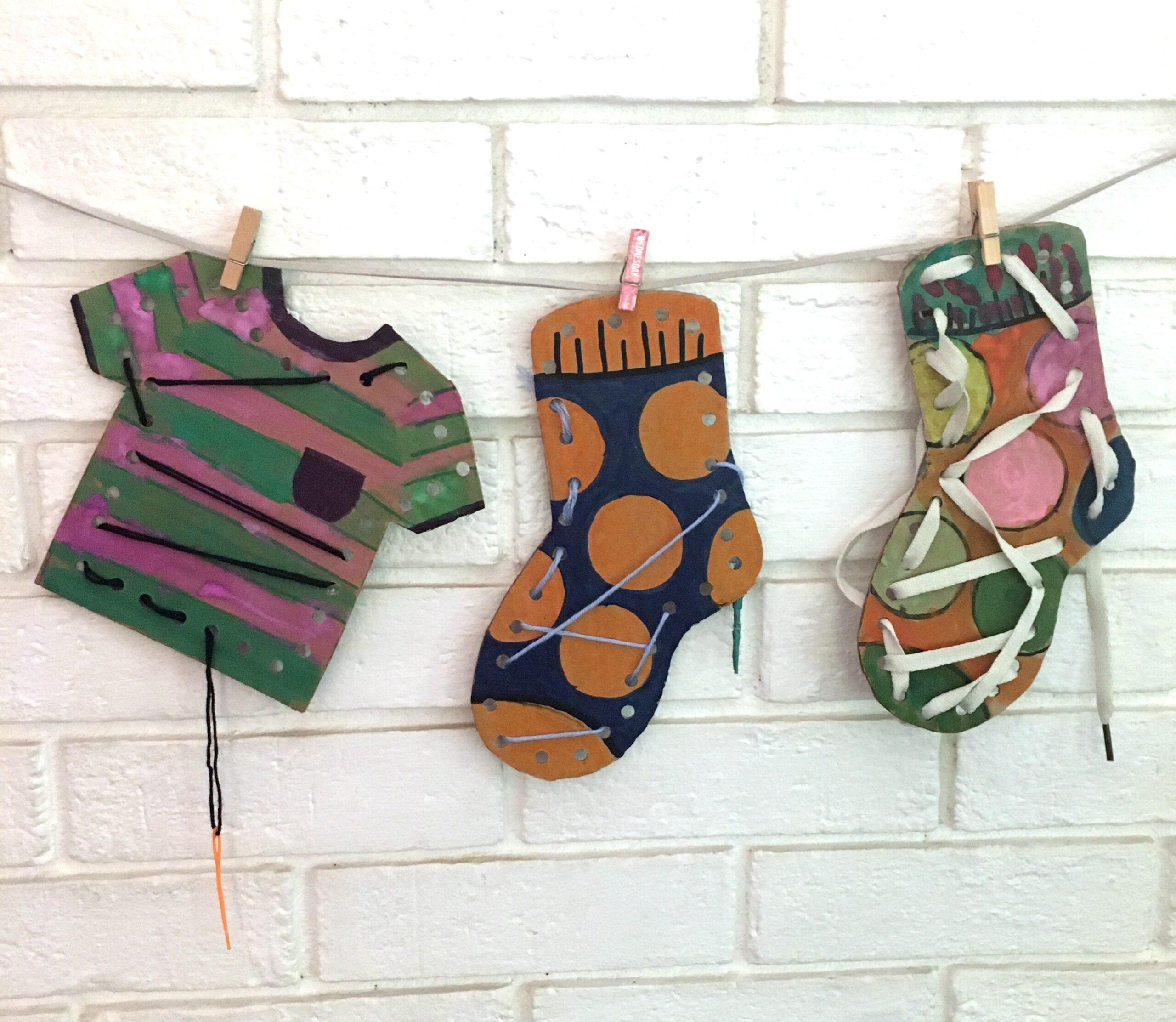
Bring out the fashion designer and craft creator with sewing.
Inspire the young designer with simple sewing
This family activity introduces the art of sewing to young children and is inspired by the Impressionist painting Suzanne Hoschedé-Monet Sewing, by John Leslie Breck. Parents can cut fun shapes from cardboard, punch holes, and encourage children to practice stitching.
Along with the fun and creative opportunities simple sewing provides, it also has many benefits for children including:
- Pincer grasp development
- Knowledge of bilateral coordination (using both hands)
- Motor planning
- Eye-hand coordination and visual scanning
Supplies:
- Scissors
- Cardboard or cardstock to cut into shapes
- Hole punch or pencil to make holes
- Tape
- Yarn, embroidery thread or shoelace
- Markers or watercolor paints
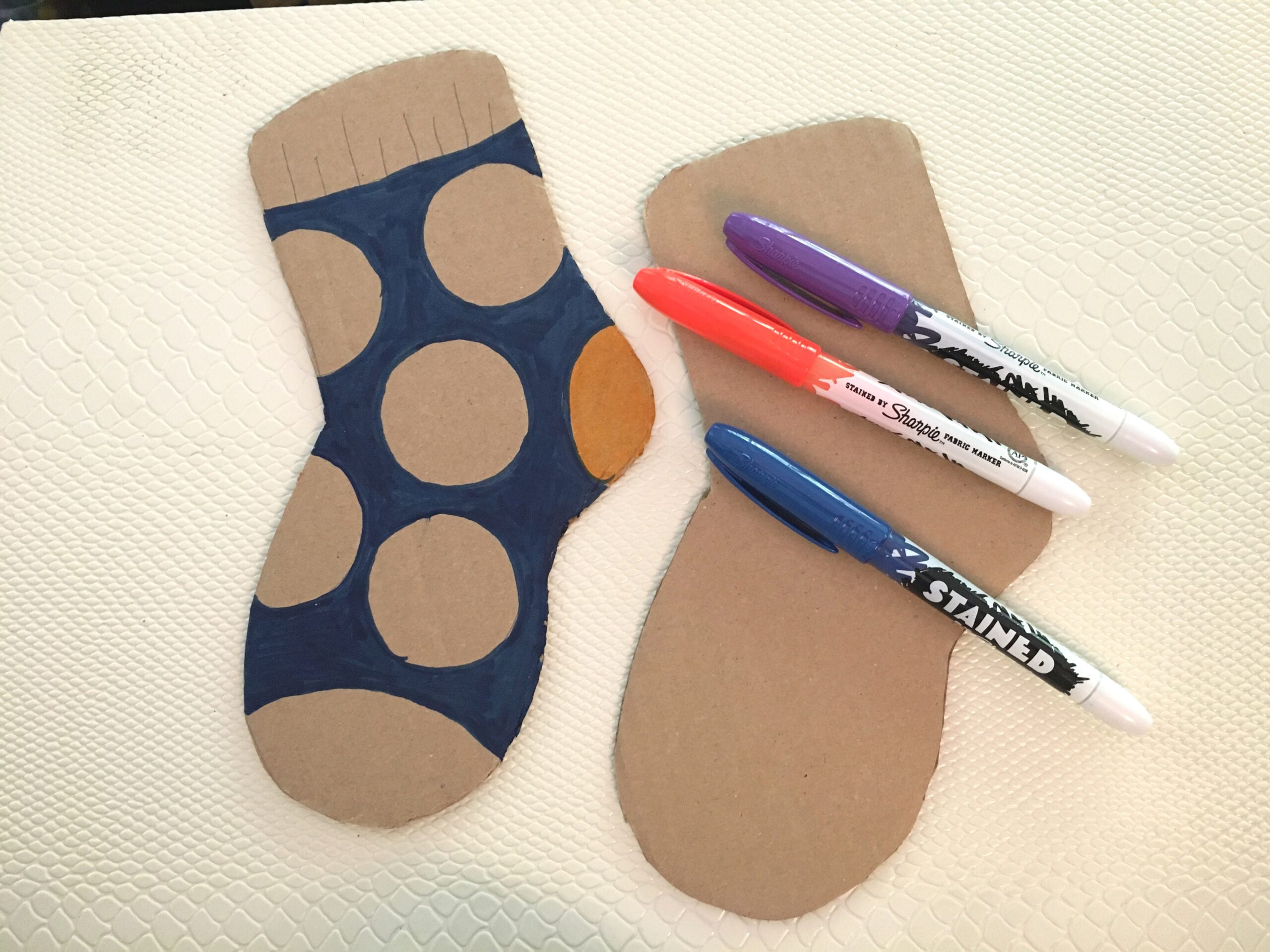
Work with your child to plan a shape to draw on the cardboard. Cut the shape out. We selected a T-shirt and socks to “mend” with yarn. Have fun drawing, coloring, or painting designs and details on the cardboard.
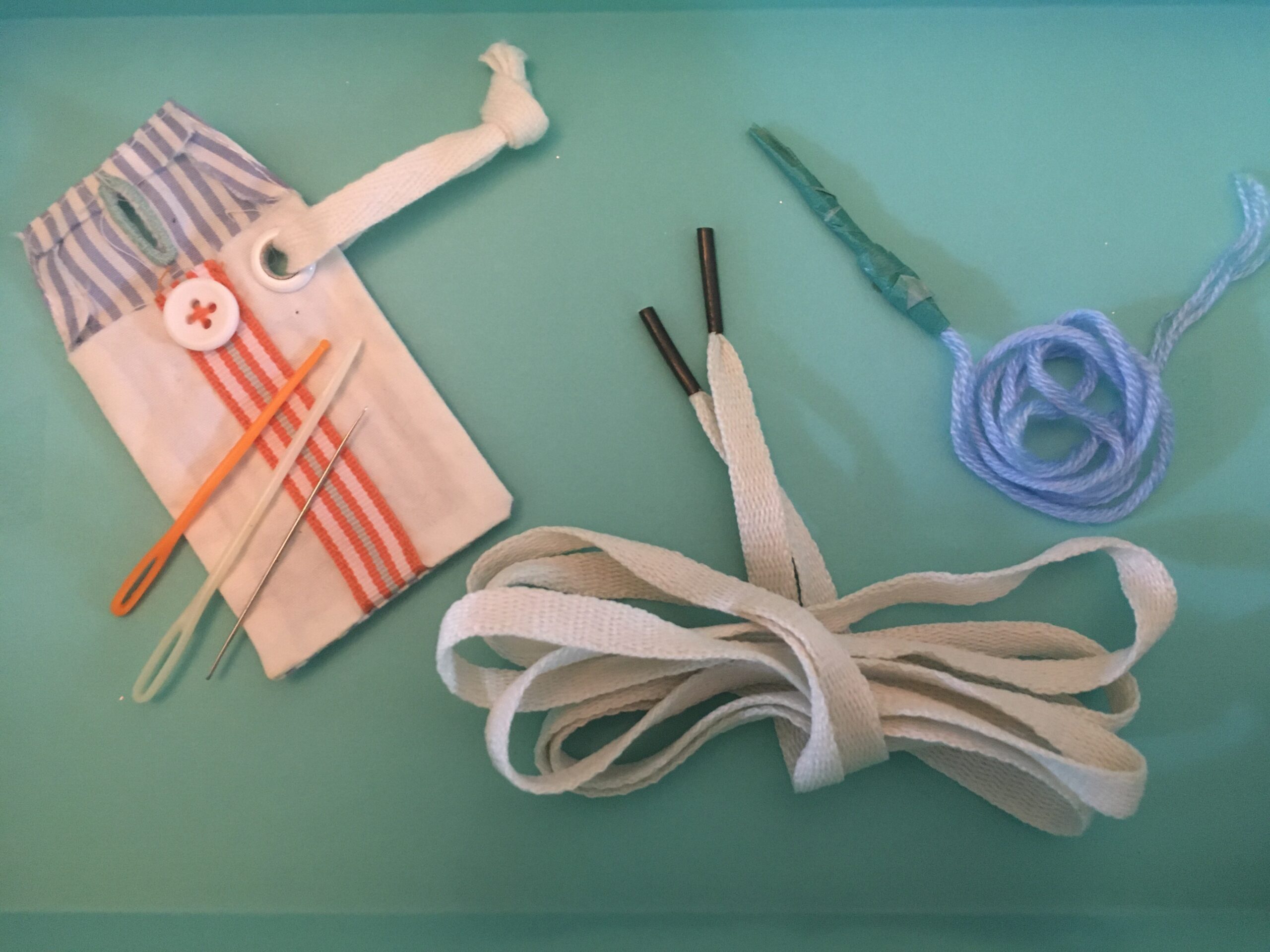
Punch holes throughout your cardboard shape with a hole punch or pencil. Adults should do this part. Cut the desired length of yarn or thread, taping one end to the back to secure it, then use the other end to make a “needle” tip by tightly wrapping tape around it. A shoelace works well for this too.
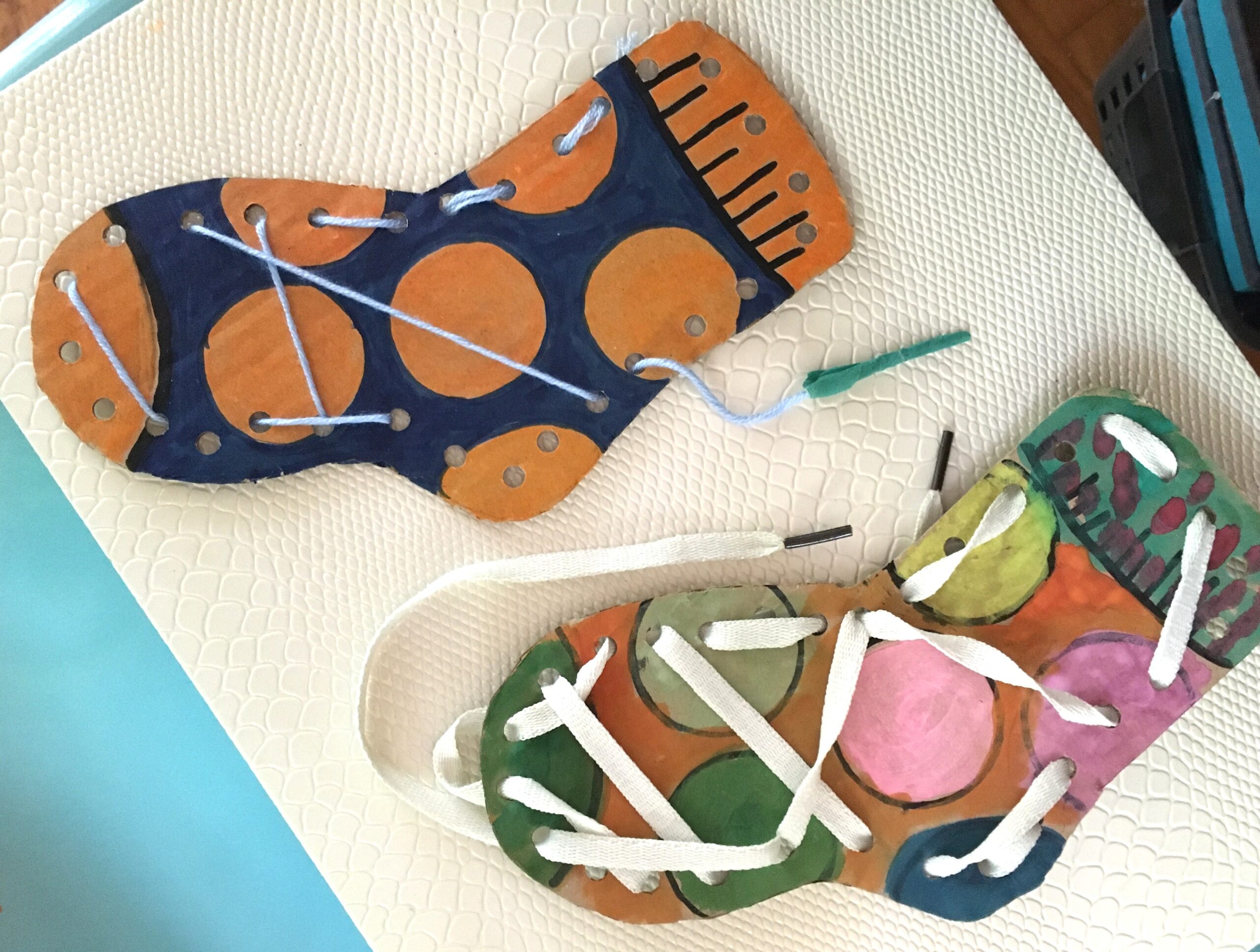
Show your child how to “stitch” in and out of the holes. Let them make their own random designs.This should be a fun exercise for young children, who can pull the yarn out and stitch over and over again.
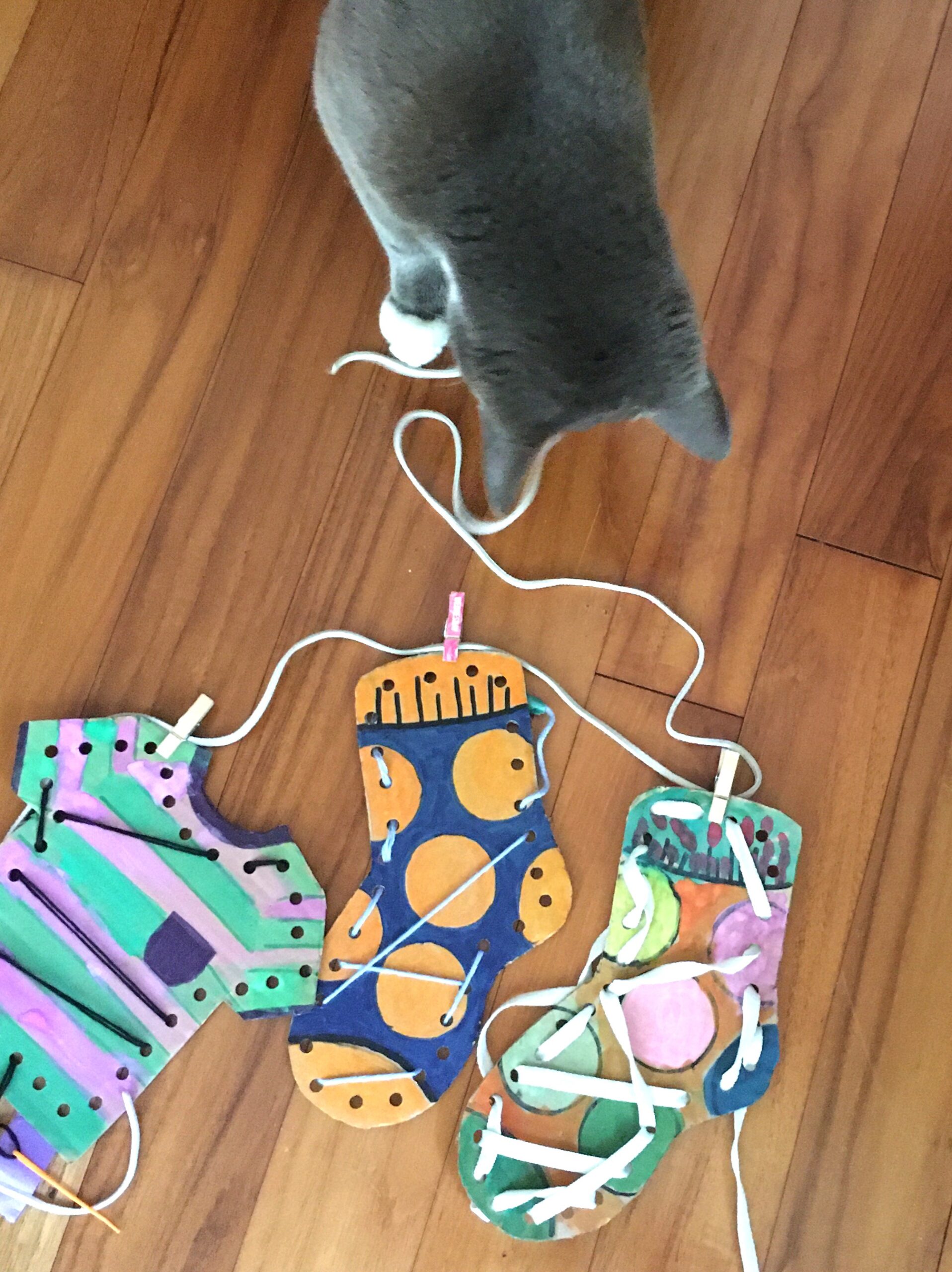
View the painting Suzanne Hoschedé-Monet Sewing together and expand the learning experience. What do you think the young woman is sewing? If you were there with her, what sounds might you hear, and scents can you smell? What is the weather like there? What would you say to her?
The Mint Museum From Home is Presented By Chase.
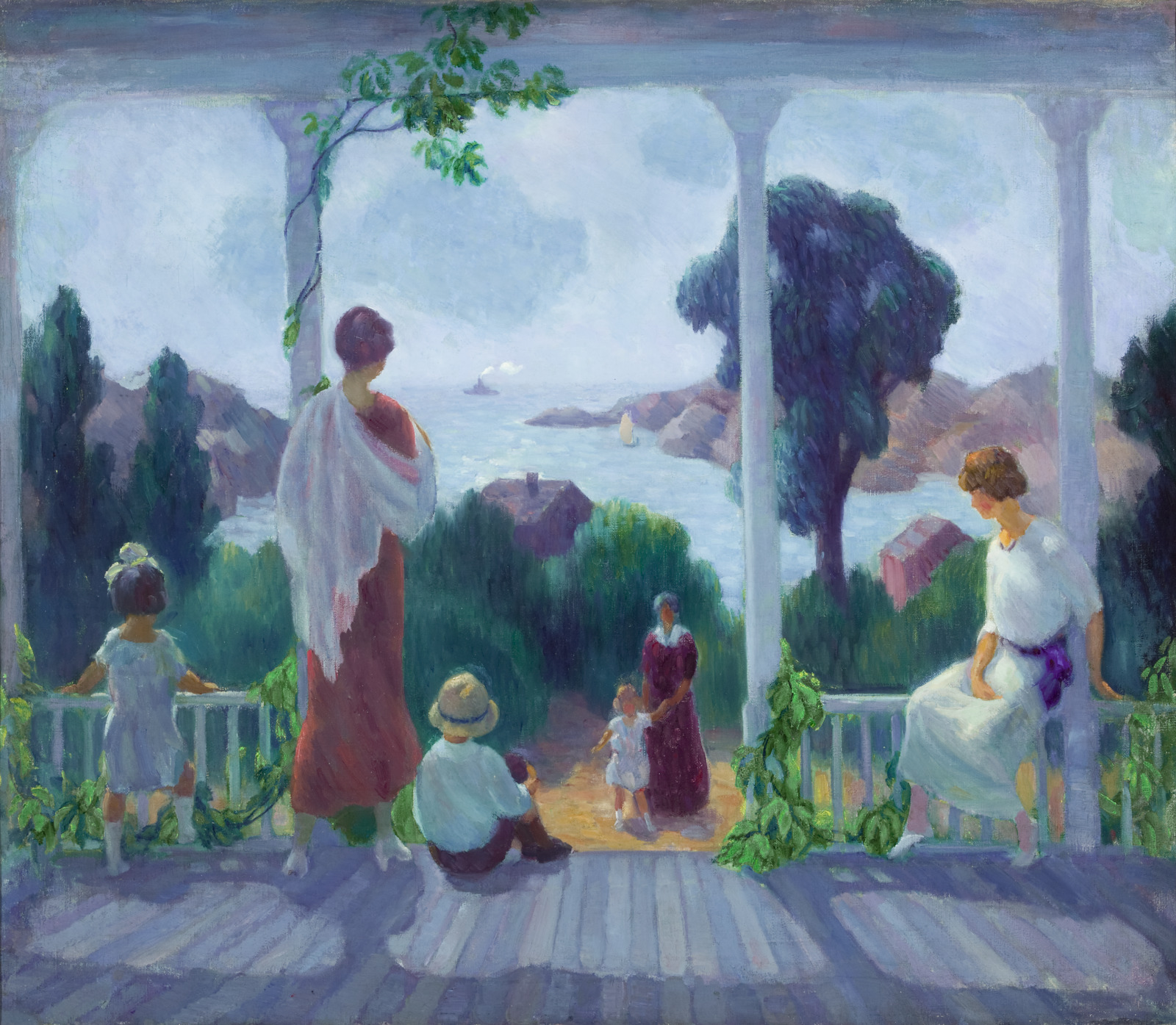
Paul Bartlett (American, 1881–1965). Ogunquit Morning (Morning Conclave), 1925, oil on canvas. The Harry and Mary Dalton Collection. 1990.72.1
6 works of art that celebrate motherhood
Motherhood has inspired art and artists throughout the ages with themes of guidance, love and protection. On the cusp of Mother’s Day, Mint curators Jen Sudul Edwards, PhD, Jonathan Stuhlman, PhD and Brian Gallagher spotlight pieces in the Mint’s collection that give a nod to the beauty of motherhood.
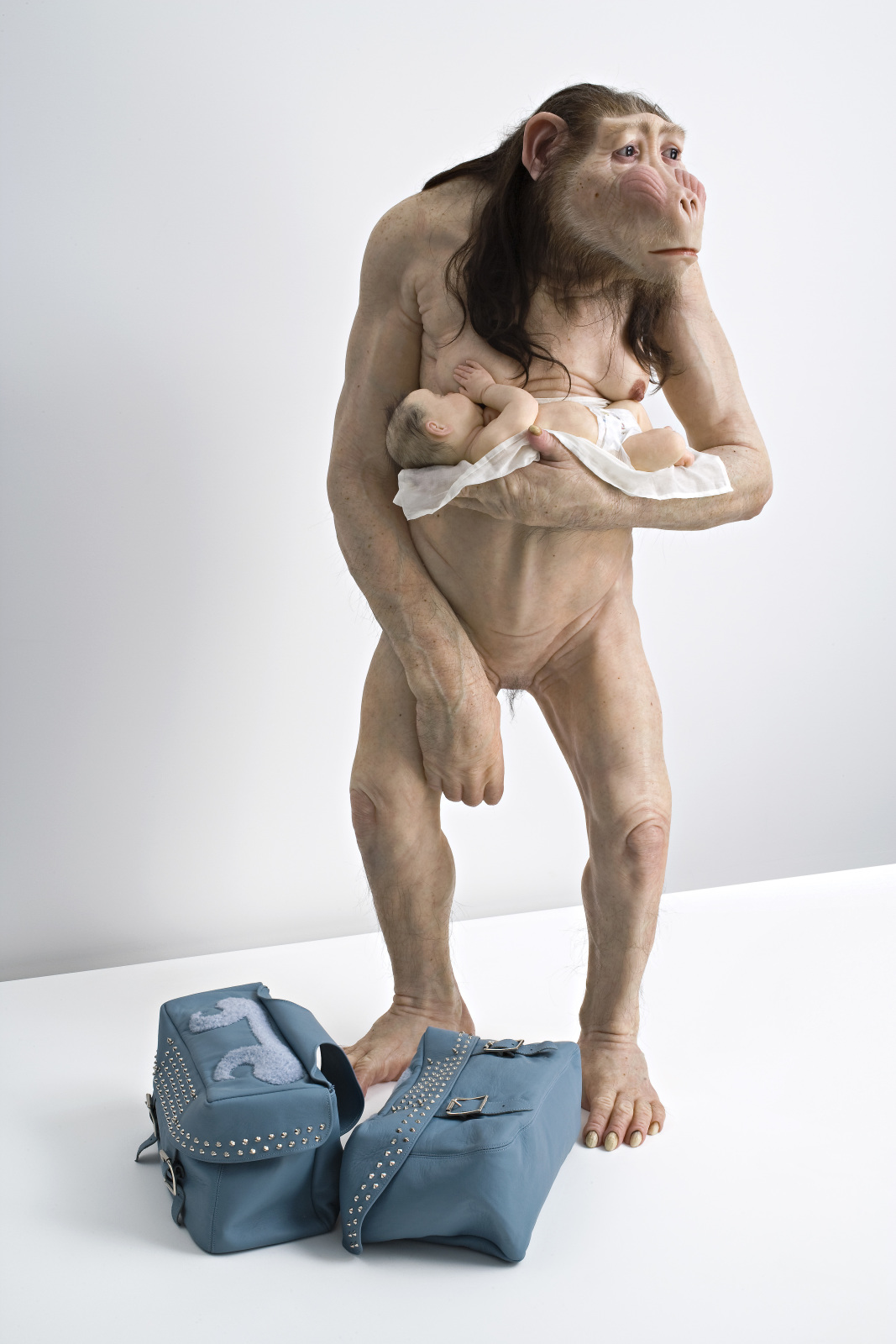
Patricia Piccinini (Australian, 1965- ). Big Mother, 2005, silicone, fiberglass, leather, and human hair. Gift of the Tony Podesta Collection. 2014.75.18. © Patricia Piccinini, 2005
Big Mother
Australian artist Patricia Piccinini was inspired to create Big Mother after watching a documentary on baboons that included the passionate intensity with which a mother would grieve the loss of a child. The parallels between species instantly became evident to her and as with all of her work, she sought to unite the gap between living forms with a bridge of compassion, recognizing that new scientific innovations are breaking down those barriers, as well.
Piccinini has described Big Mother in this way: “She encapsulates what it means to be human today, how we define our humanness, and the ethics and the advocation of new medical technologies like genetic engineering. She also embodies that amazing push-pull of difference. We can recognize her, but she is something else, which is strange for us. … In the end, what the work is really about, is how important it is to maintain the distinction between animals and ourselves and how fragile that distinction really is.” —Jen Sudul Edwards, PhD, Chief Curator and Curator of Contemporary Art
[cs_divider]
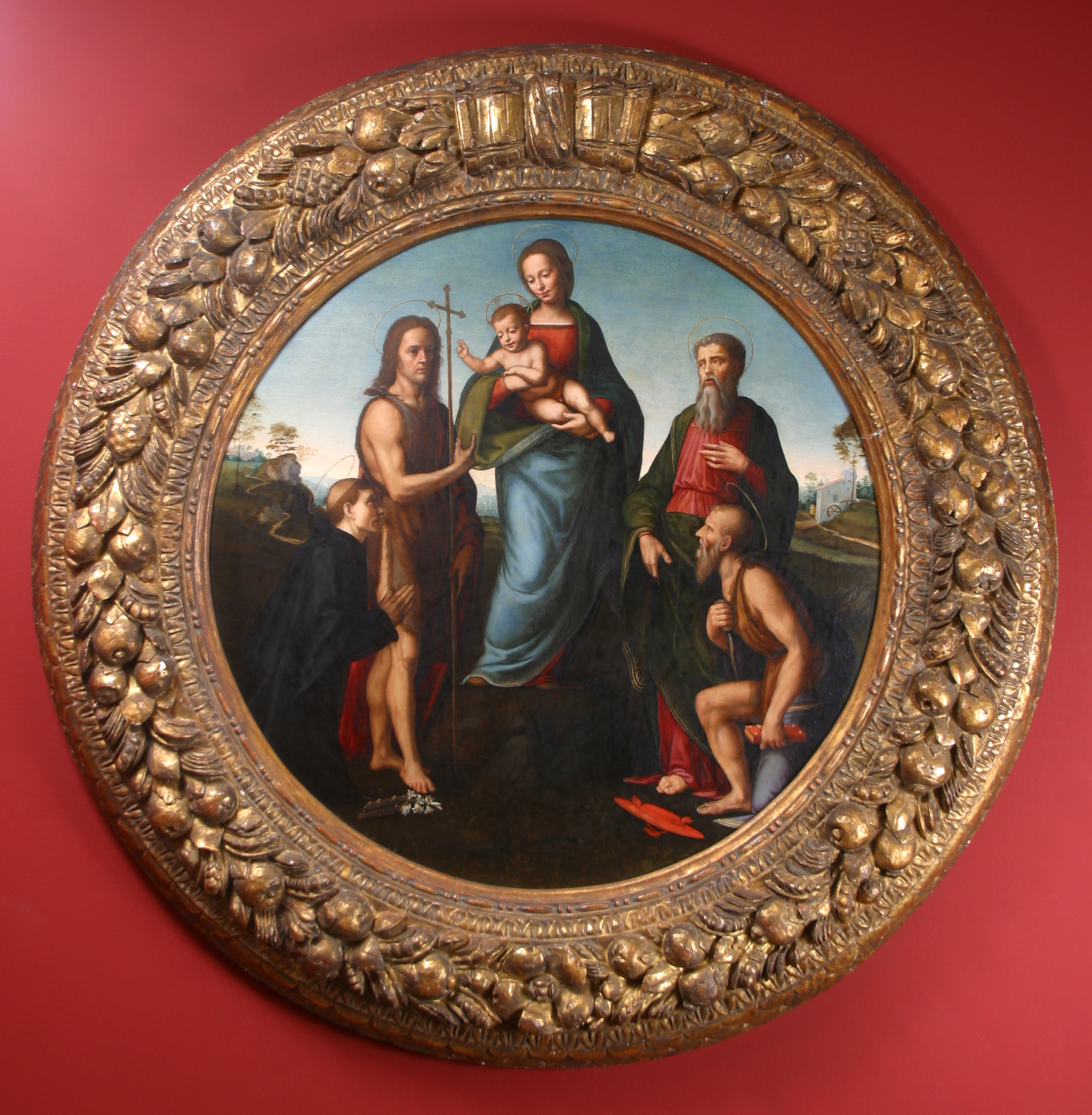
Ridolfi Ghirlandaio (Italian, 1483-1561) Madonna and Child with Four Saints, circa 1515, oil on canvas. Gift of Mr. Samuel H. Kress. 1943.2
Madonna and Child with Four Saints
Every culture has images celebrating the unique bond between mother and child and such images became a staple of Christian iconography, as well. Medieval and early Renaissance representations tended toward a formal Mary who served as a support for a wise Christ, small in size, but mature in face. In the High Renaissance when Ridolfi Ghirlandaio painted, the Catholic church sought to portray a more empathetic, relatable Holy Family. Images of Mary and Christ softened, moving from ornate thrones to verdant fields and from stiff poses to loving embraces. The four apostles make the religious connotations immediately clear, but if they were removed, the mother and child could be a maternal image from any time, any place: a mother adjusting her weight to accommodate a squirming infant who reaches inquisitively for an object nearby, watching his movements with a gentle love. —Jen Sudul Edwards, PhD, Chief Curator and Curator of Contemporary Art
[cs_divider]
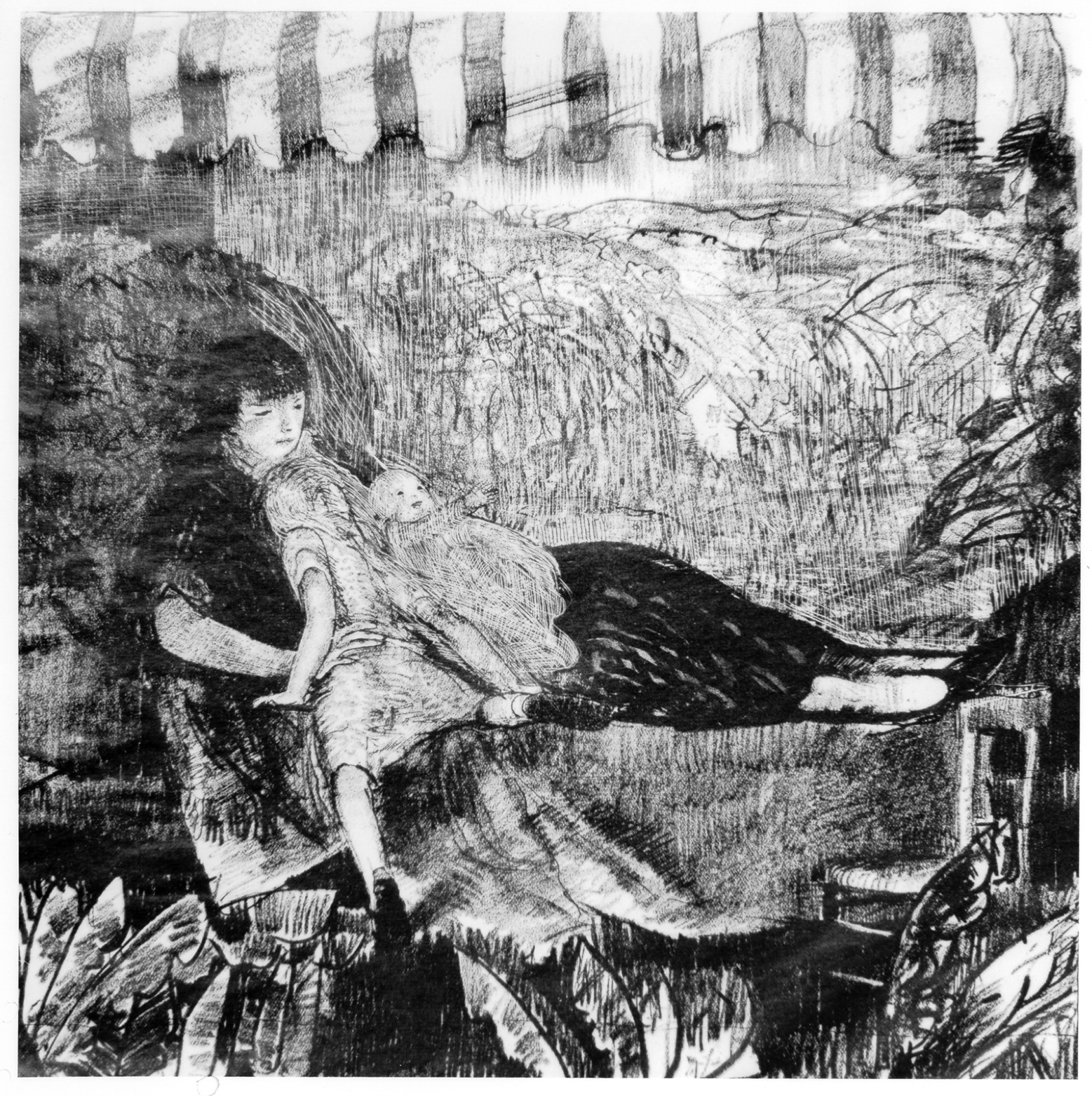
George W. Bellows (American, 1882–1925). Mother and Children, 1916, Japan paper. Gift of the Friends of the Mint on the Occasion of its 20th Anniversary (1965-1985). 1985.48.1
Mother and Children
Although George Bellows made a name for himself with paintings and drawings that showed the grittiness of urban life, he also produced more tender images, like this one. Mother and Children depicts the artist’s wife Emma and their children, Anne and Jean, relaxing outside under a striped awning. —Jonathan Stuhlman, PhD, Senior Curator of American Art
[cs_divider]

Paul Bartlett (American, 1881–1965). Ogunquit Morning (Morning Conclave), 1925, oil on canvas. The Harry and Mary Dalton Collection. 1990.72.1
Ogunquit Morning
This sun-filled scene, created at an artist’s colony in Ogunquit, Maine, nearly a century ago, features three women and three young children enjoying a sun-drenched morning by the sea. —Jonathan Stuhlman, PhD, Senior Curator of American Art
[cs_divider]
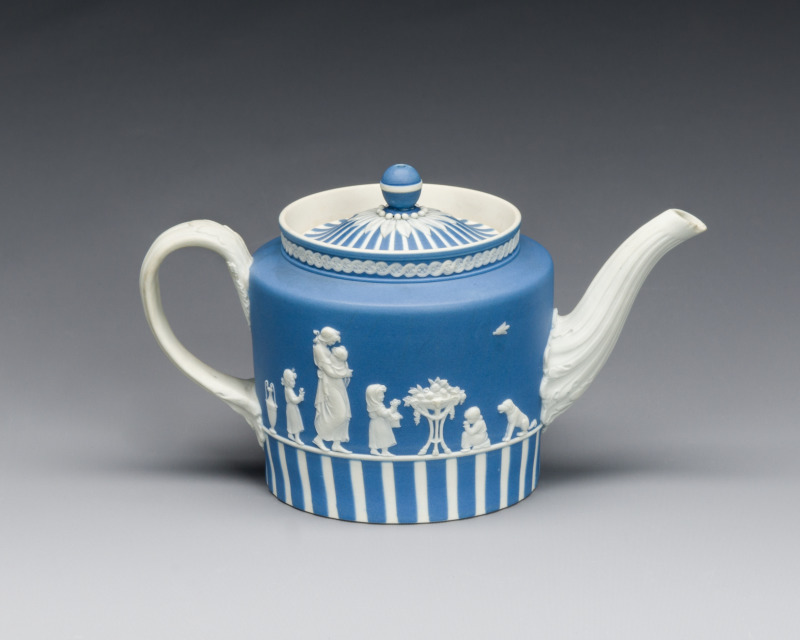
Wedgwood. Staffordshire, England, 1759–present; Teapot, circa 1785–1790, stoneware (jasperware). Museum Purchase: Funds provided by the Wedgwood Society of Washington DC. 2018.5.1a-b
Wedgwood Teapot
The figures in relief on this jasperware teapot include a mother and her children as they approach a tripod table supporting a basket filled with fruit. The scene was designed by Elizabeth Upton, Lady Templetown (1747–1823), as part of her Domestic Employment series, and it was modeled in three-dimensional form by William Hackwood, a talented sculptor at the Wedgwood factory. —Brian Gallagher, Curator of Decorative Arts
[cs_divider]
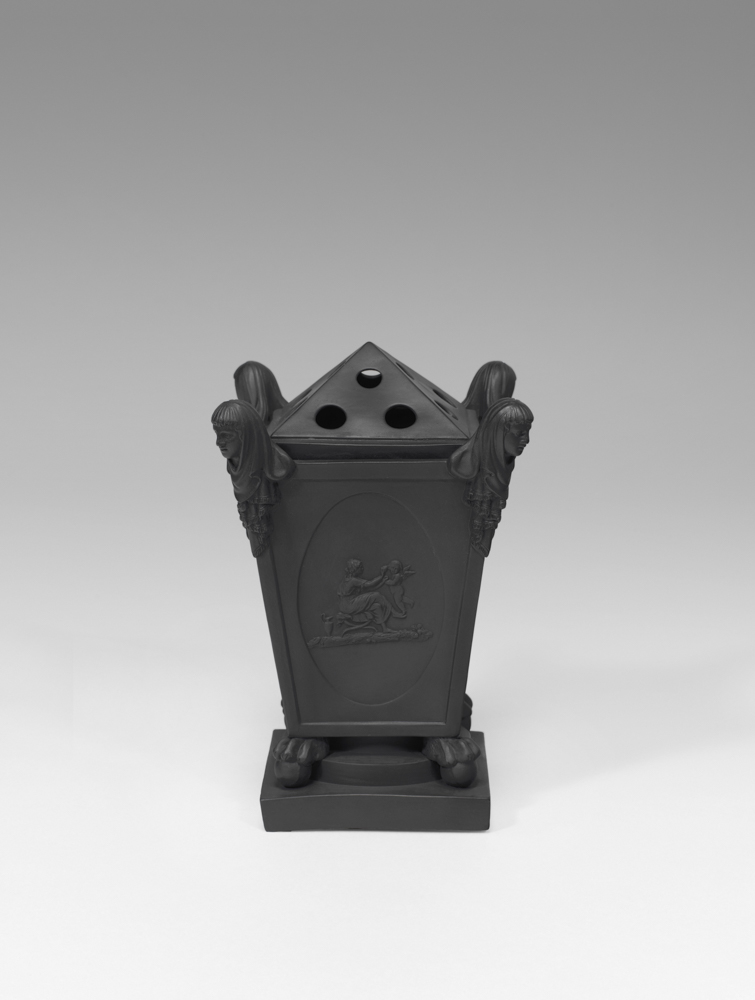
Turner. Staffordshire, England, circa 1760–1829; Bough Pot, circa 1800, stoneware (black basalt). Collection of Lucie and Bob Reichner
Bough Pot
The relief decoration on one side of this bough pot—on view in the Classic Black: Basalt Sculptures of Josiah Wedgwood and His Contemporaries exhibition—features the Roman goddess Venus balancing her son Cupid on her right foot. Known as Sportive Love, the relief was designed by Elizabeth Upton, Lady Templetown (1747–1823), a talented, amateur artist who sold her designs to various Staffordshire potteries. —Brian Gallagher, Curator of Decorative Arts
BURN YOUR ASSUMPTIONS
Star Gallery | Spring-Summer 2020
Inspired by the Immersed In Light: Studio Drift at the Mint exhibition, Hough High School students worked to create pieces of art for the Star Gallery that explored the relationship between humanity, nature, and technology. Creating a dialogue about the in and out of body conversations we have with these relationships was our main focus. Throughout the work you can see that students worked with many materials, both tangible and digital. These works are from Katherine Allen’s Visual Art Honors and AP classes as well as Justin Pierce’s Media Arts Honors and AP classes
Katherine Allen’s Visual Art Honors and AP classes
Justin Pierce’s Media Arts Honors and AP classes
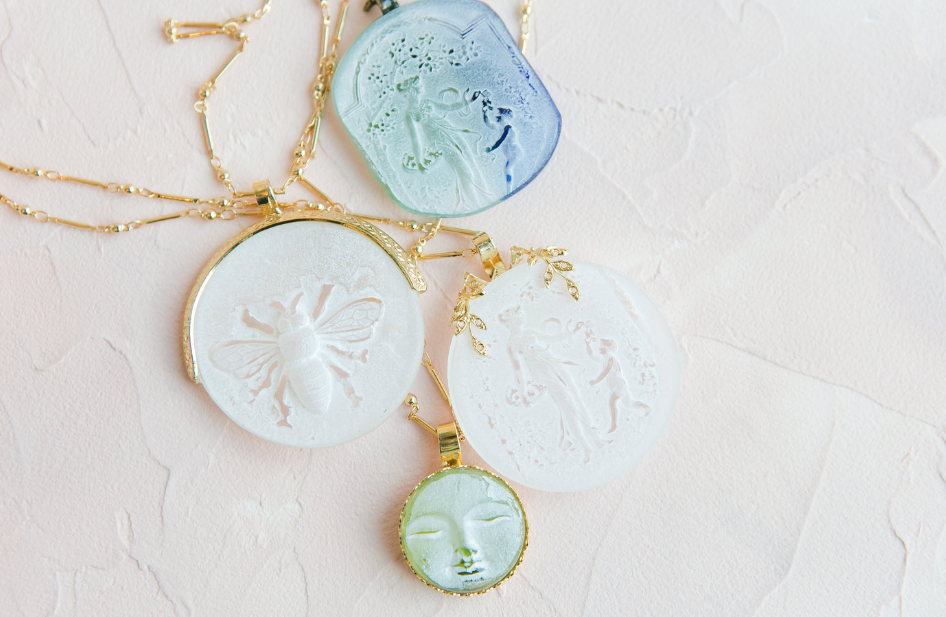
Stéphane Dunoyer Pâte de Verre jewelry. Small Moon Ring, $120; Mother and Child Necklace Round, $128; Mother and Child Necklace Blue/Green, $108; Bee Necklace. $148.
12 gifts hand selected for Mother’s Day
Give the moms in your life something thoughtful for Mother’s Day from the Mint Museum Store. Shopping by appointment is now available by calling the store at 704-337-2061, or direct message @mintmuseumshops on Instagram or email hannah.snyder@mintmuseum.org to shop these items or others. Items can be picked up curbside at Mint Museum Uptown or shipped direct to any address in the United States. The store is open to fulfill orders Monday through Friday, 10:30 AM-1:30 PM.
Below are 12 items hand selected by Mint Museum Store staff members as favorites to celebrate Mom. Bundle a bunch and send something extra special to celebrate the first lady in your life.
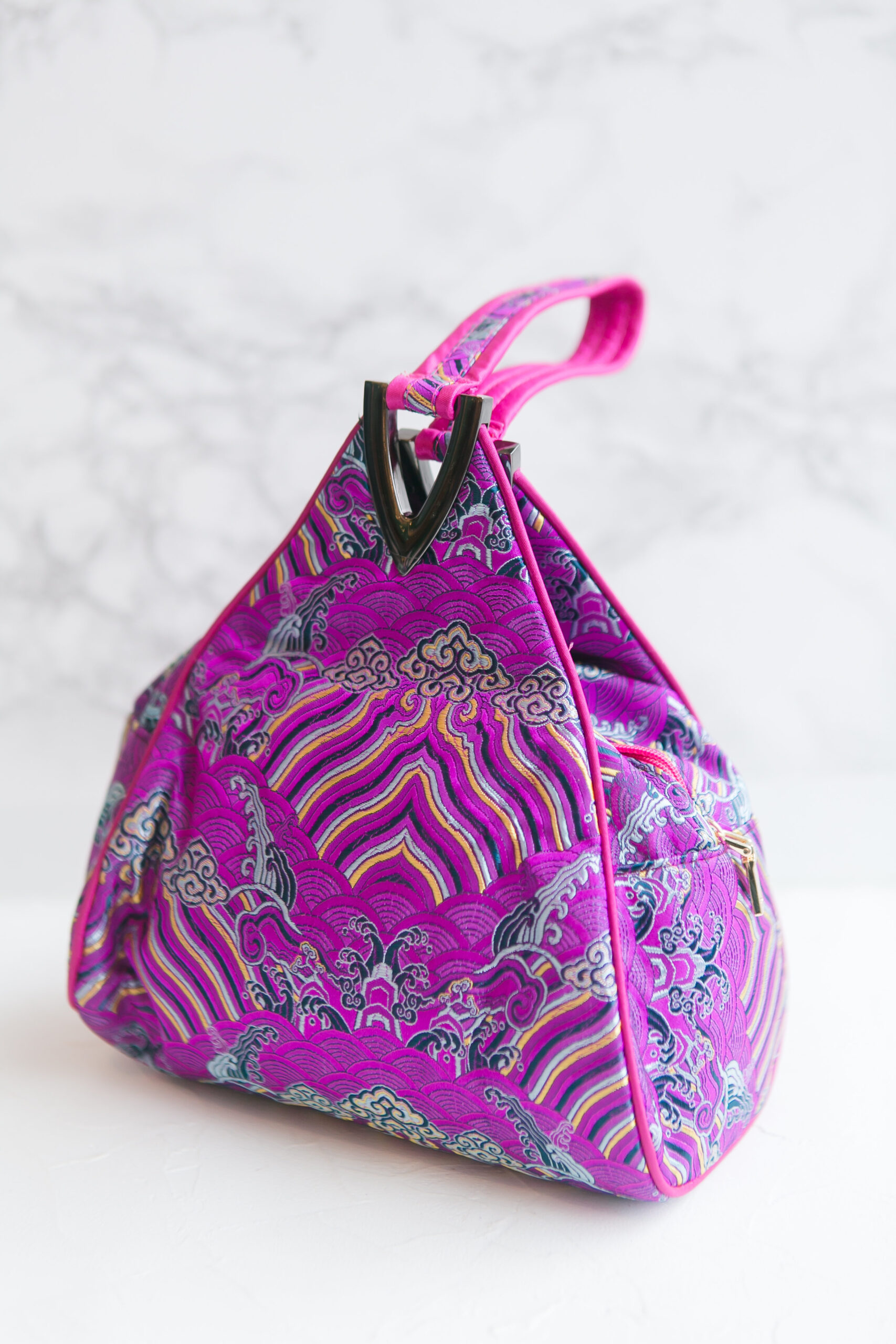
Emperor’s Brocade Triangle Bag, $36.
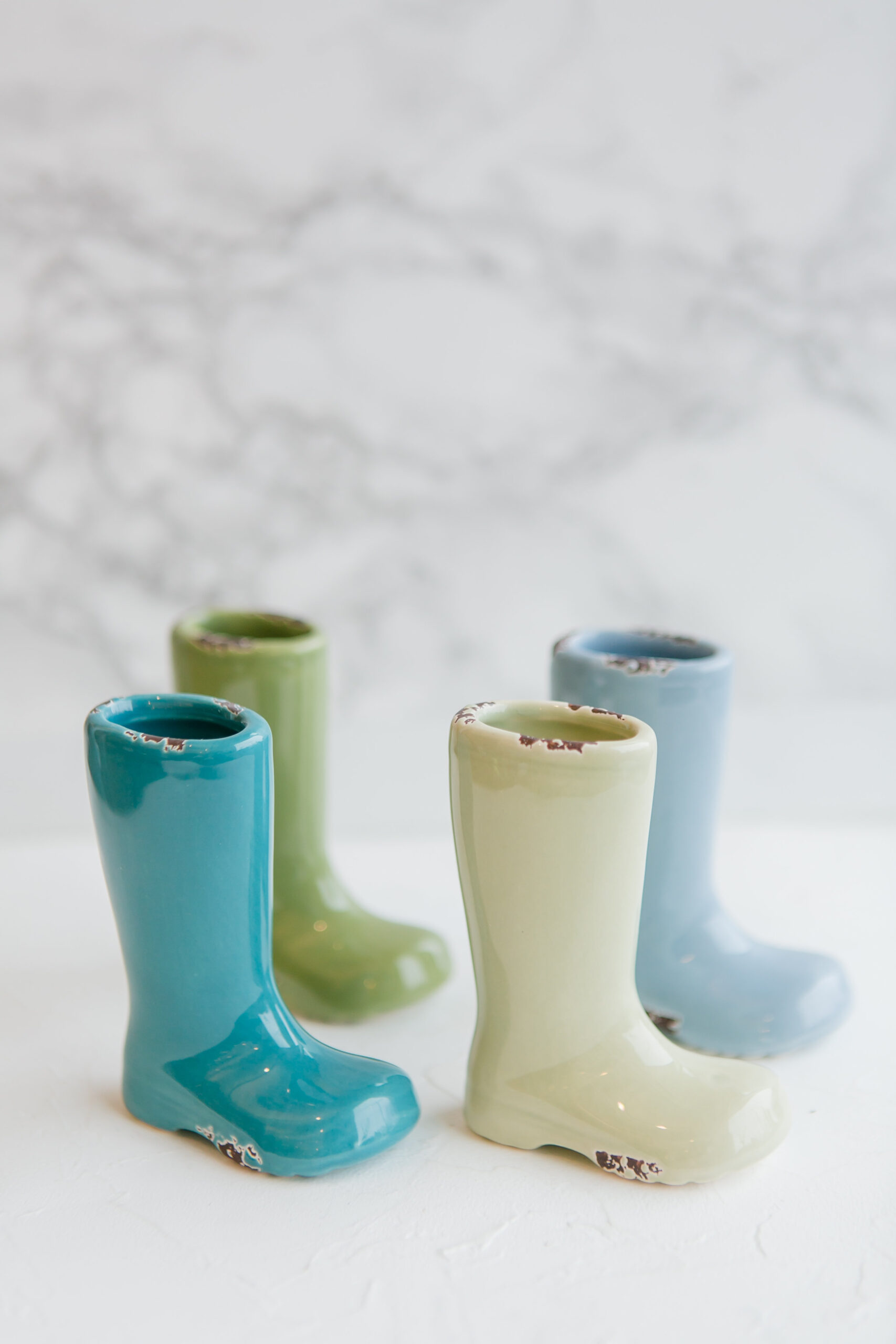
Weathered boot vases, $6 each.
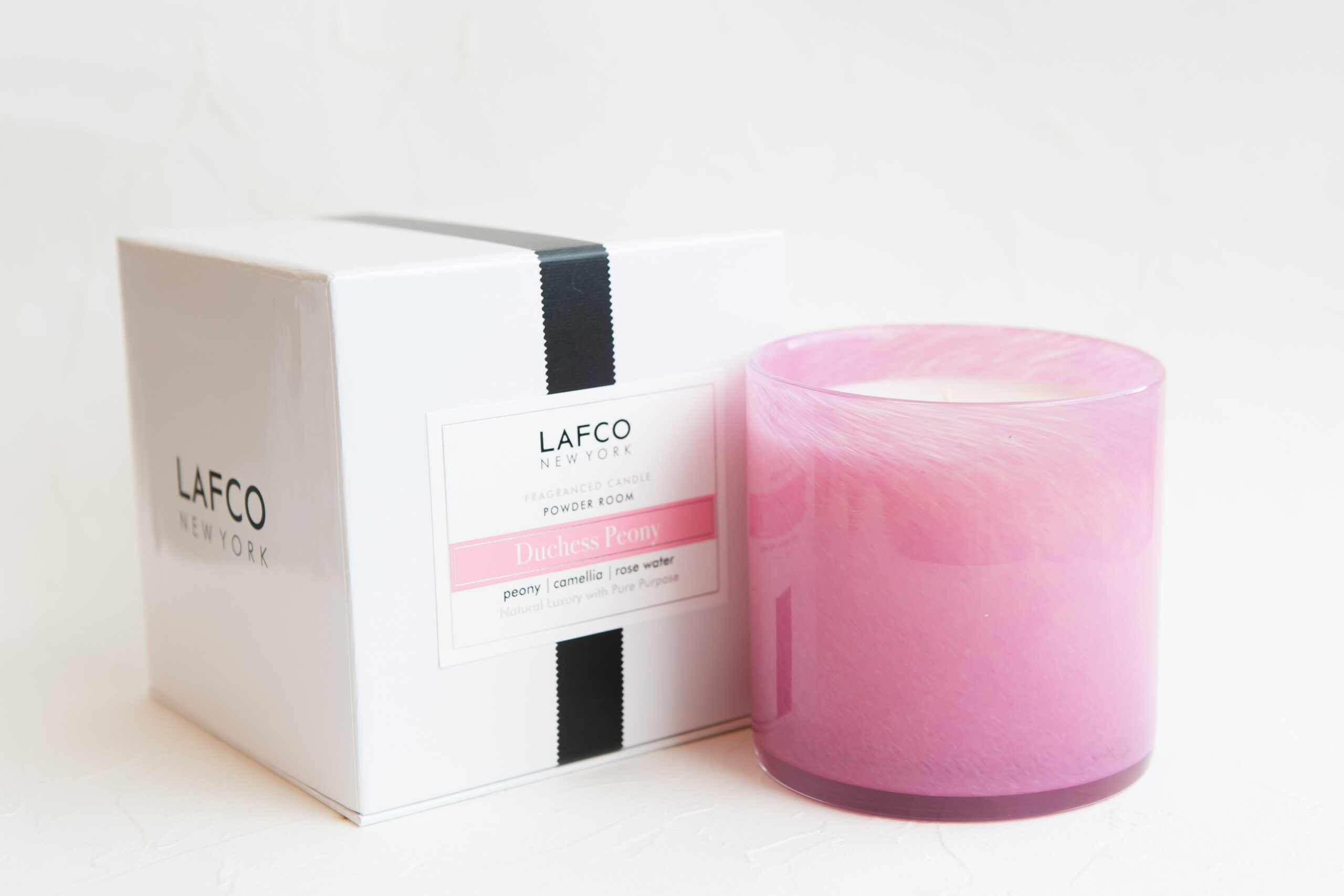
Duchess Peony Lafco New York Candle, $62.
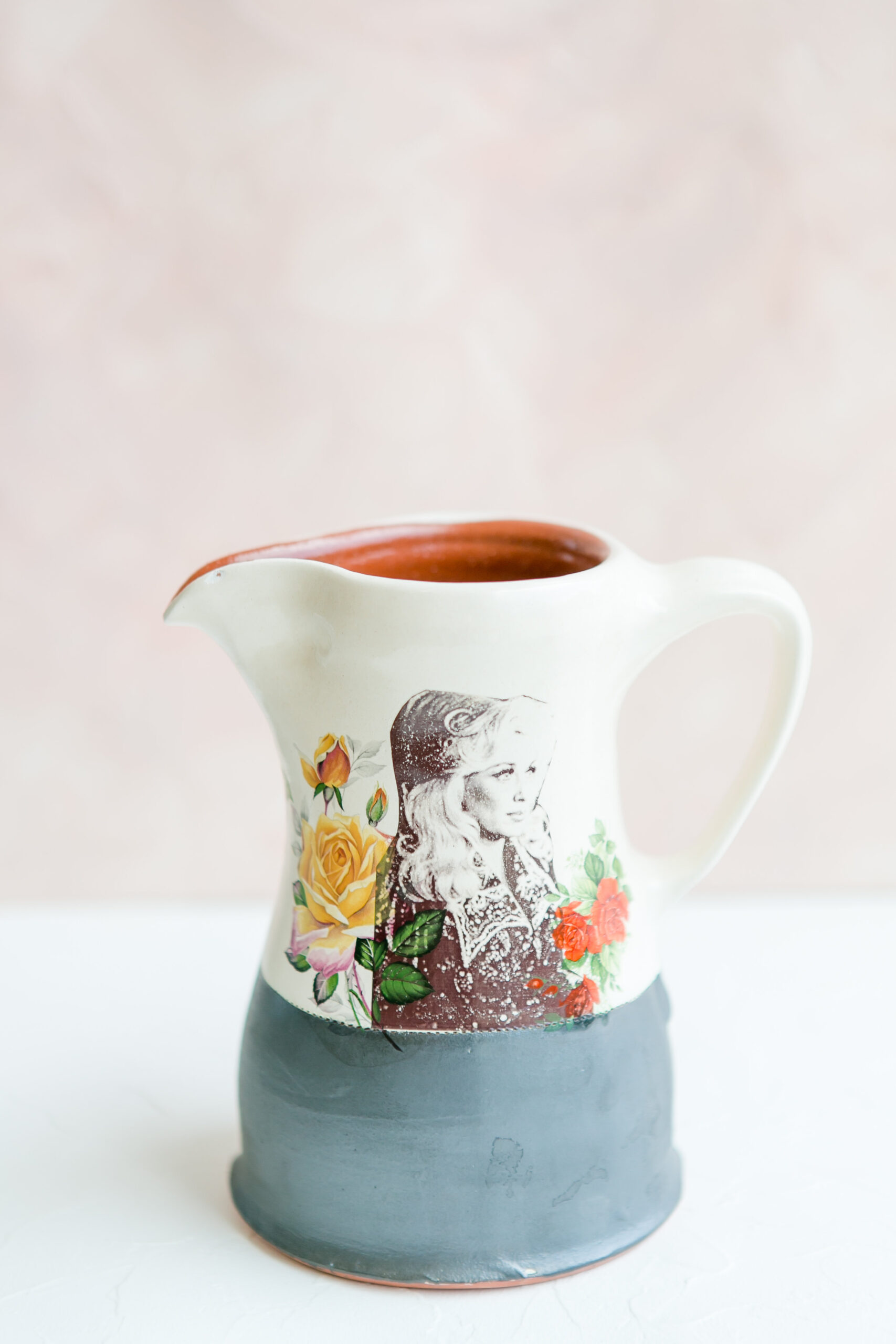
Dolly Parton Pitcher by Local Dean and Martin Pottery, $198.
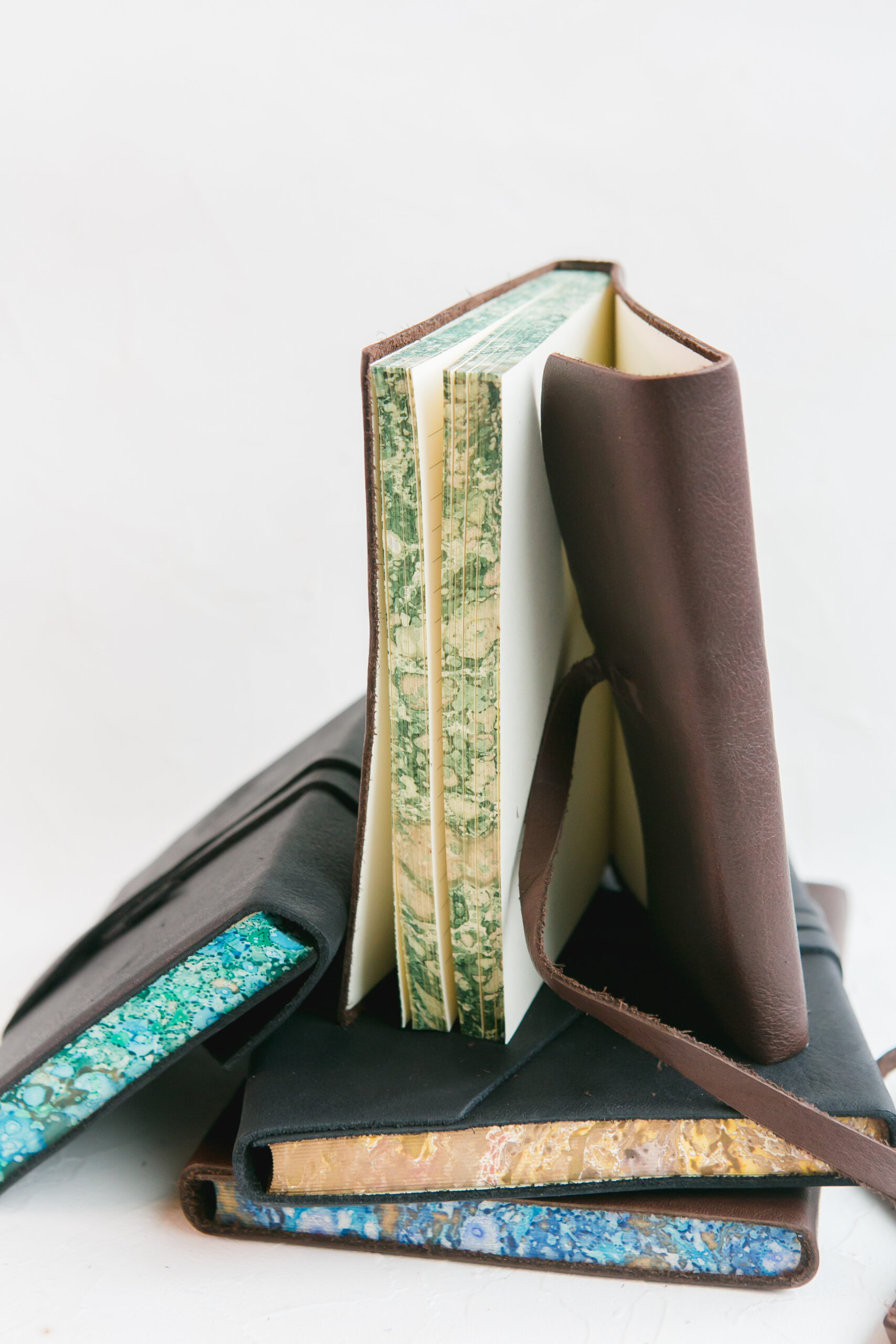
Leather journals with marbled edges, small, $46/large $56.
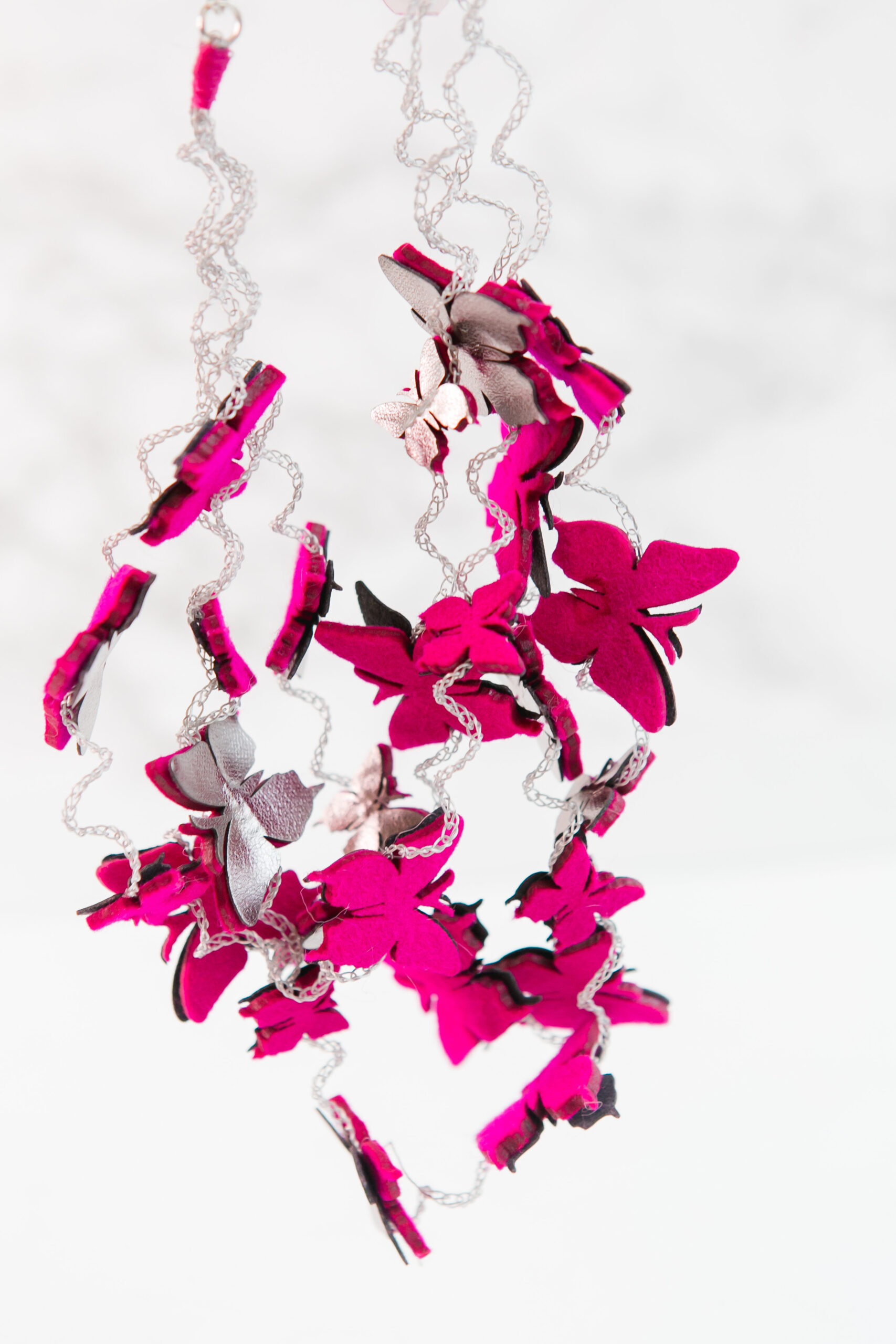
Butterfly necklace, on sale for $49 (original price $98).
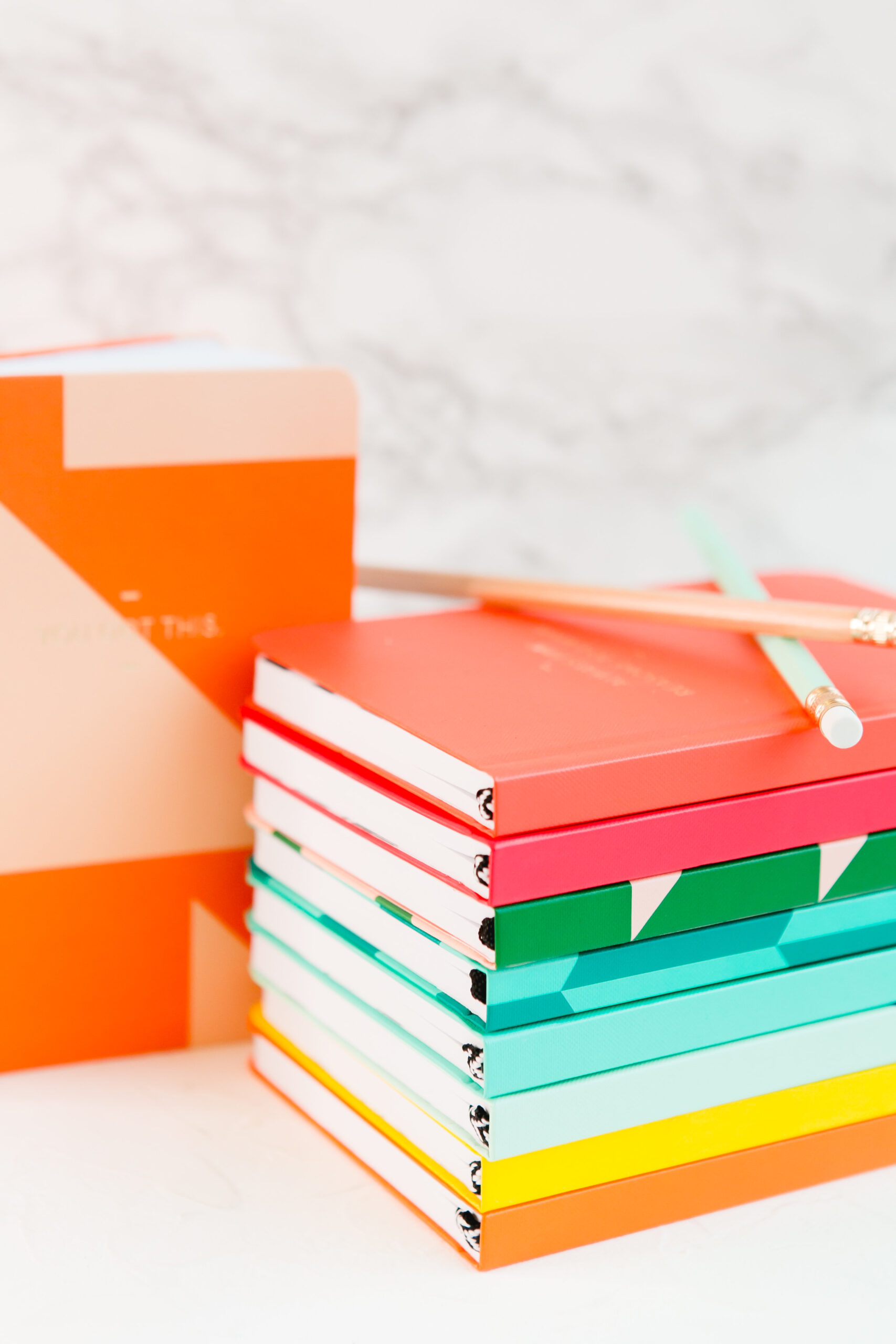
Colorful journals, $12 each.
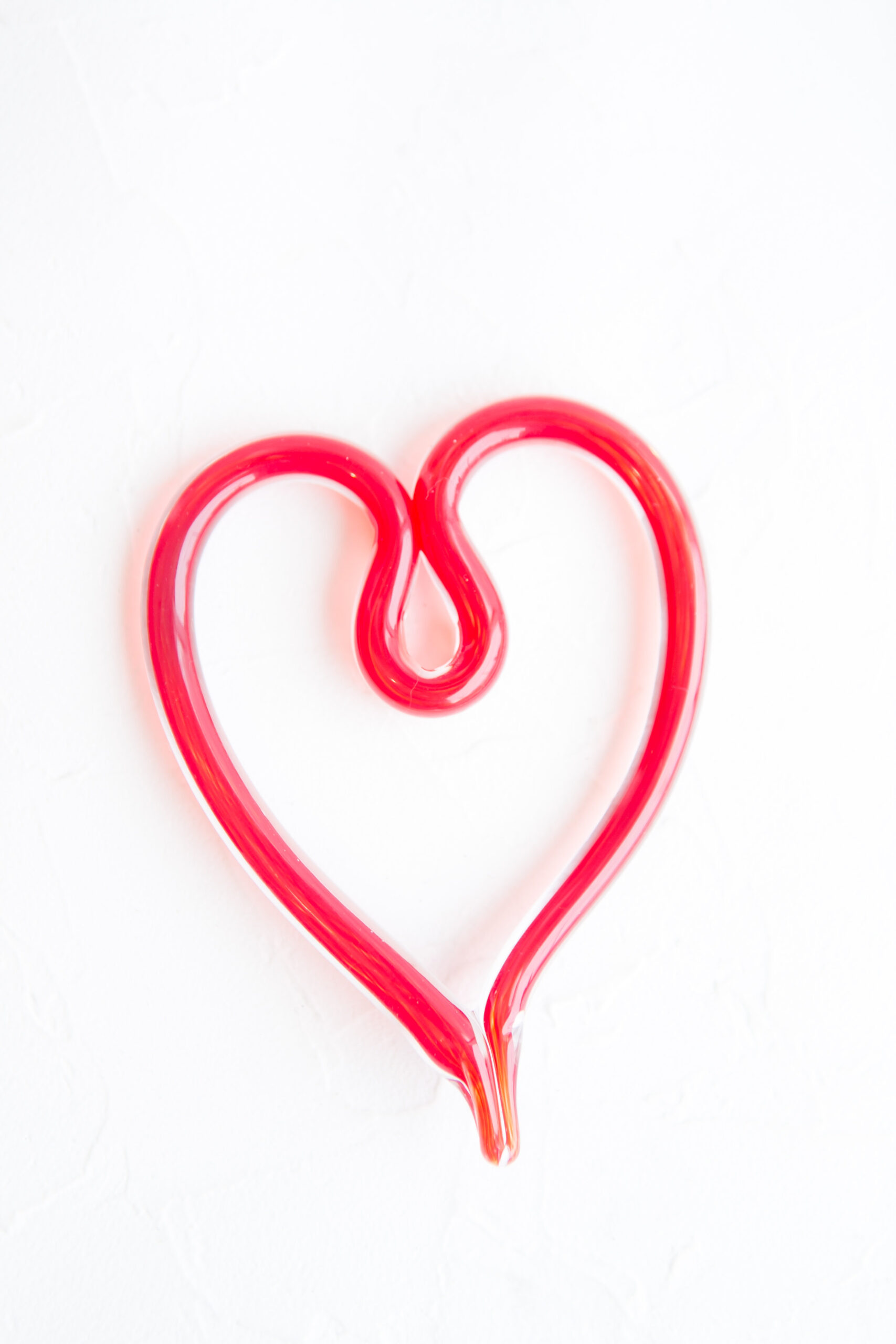
Hand blown glass heart by local artist Joe Grant, $38.
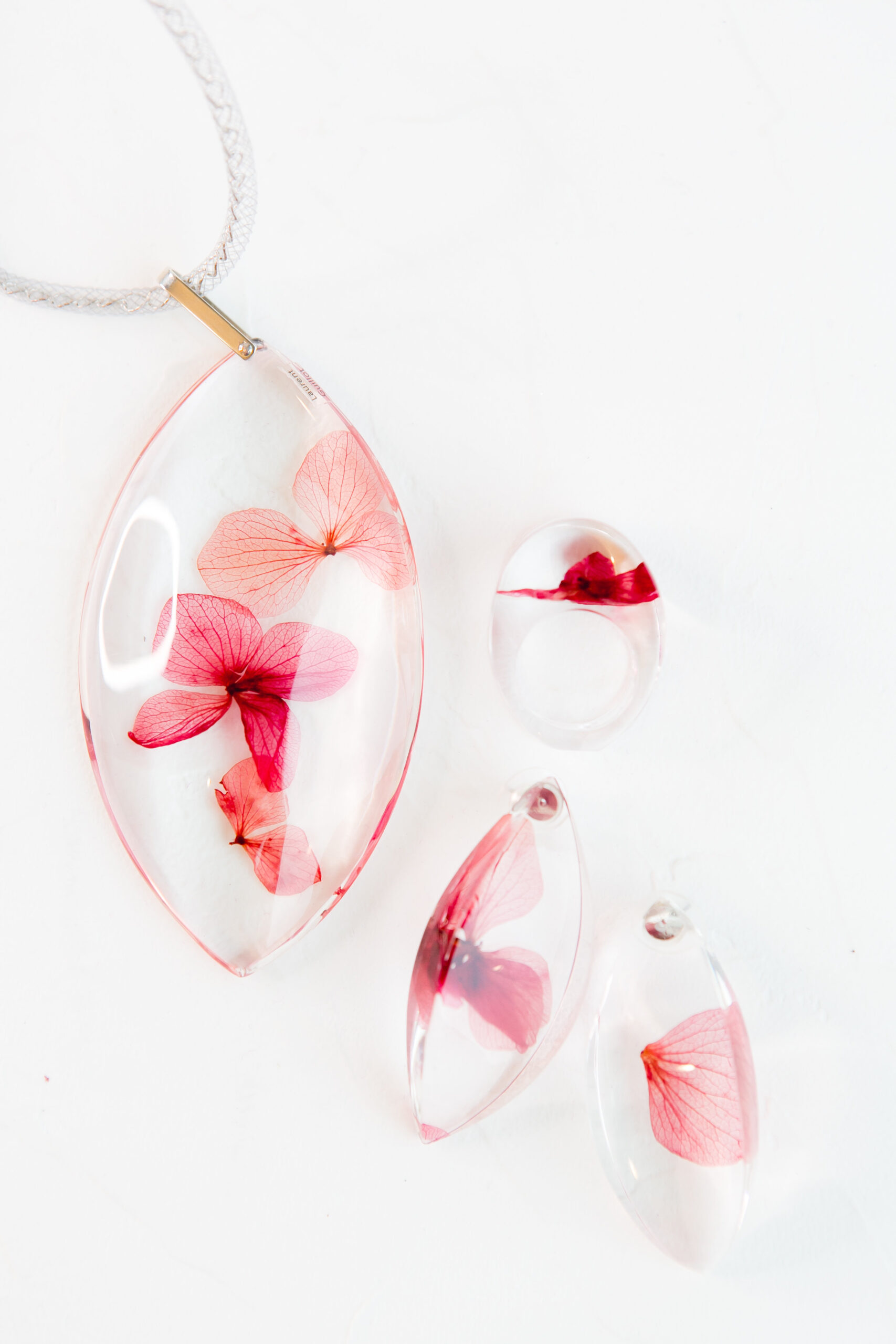
Laurent Guillot lucite jewelry with real flower petals, pendant $260; almond shaped earrings; $150; and elegance ring $150.
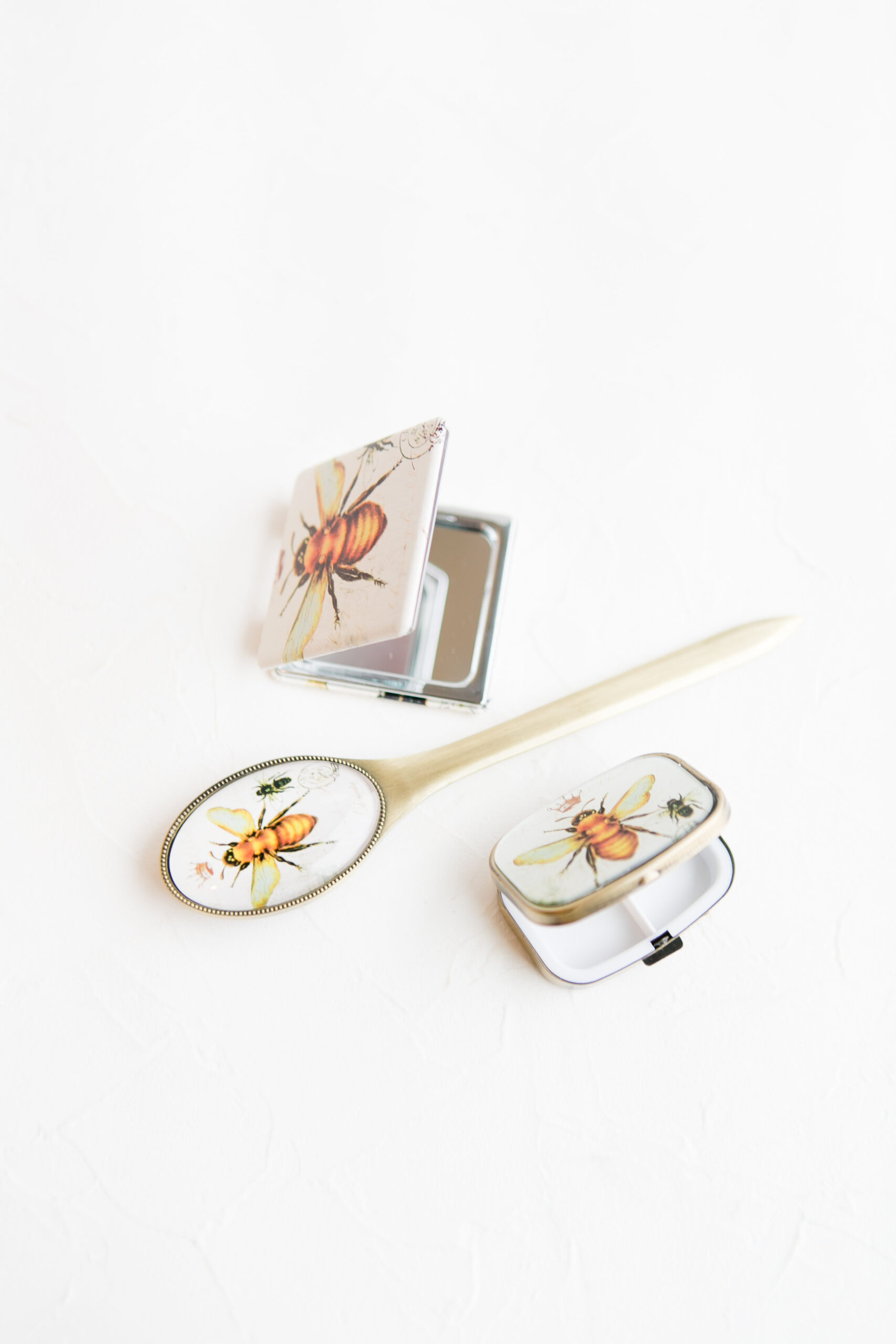
Queen Bee Letter Opener, $16; Queen Bee Pocket Mirror, $8; Queen Bee Pillbox, $12.
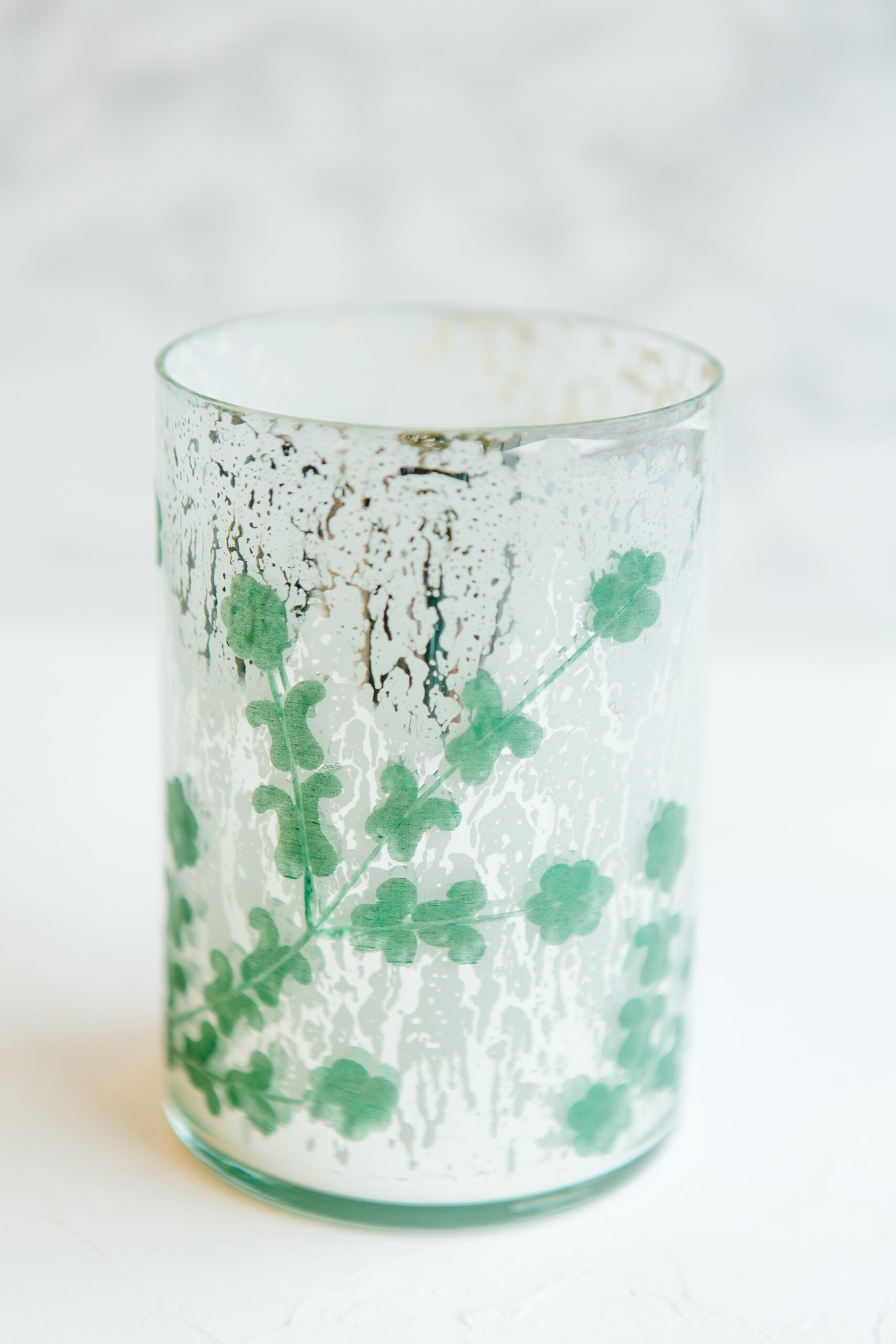
Etched Mercury Glass Votive (Large), $18.
Make Your Own Spring Flower Necklace
Spring is a time of rebirth. Flowers are popping up and bringing color back into the world. This project was inspired by Frozen, 2011, a nature-themed necklace by artist Sam Tho Duong. Imagine what the frozen seeds would look like if they thawed and bloomed.
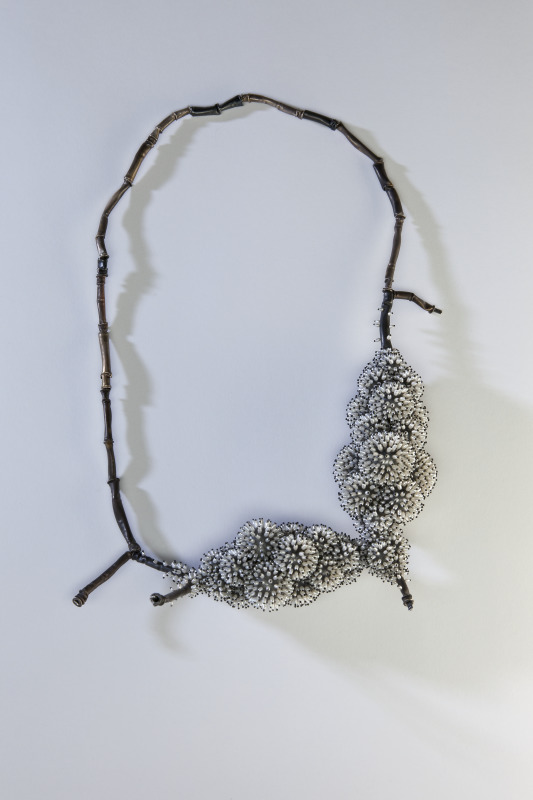
Sam T. Duong (Vietnamese, 1969 – ). Frozen, 2011, silver. Museum Purchase: Exchange Funds from the gifts of various donors in fond memory of Edward K Jones (6/3/1970-7/1/2010) and his many contributions and enthusiastic support of the Mint Museum of Craft + Design. 2011.28
This project has lots of room for creative variation. It can work with felt or paper. The necklace can be made with pipe cleaners, ribbon, or string. Another option is to use the flowers to create a wreath or a card to give to someone you love for spring holidays, birthdays, or Mother’s Day. Experiment with texture and color to create a unique arrangement.
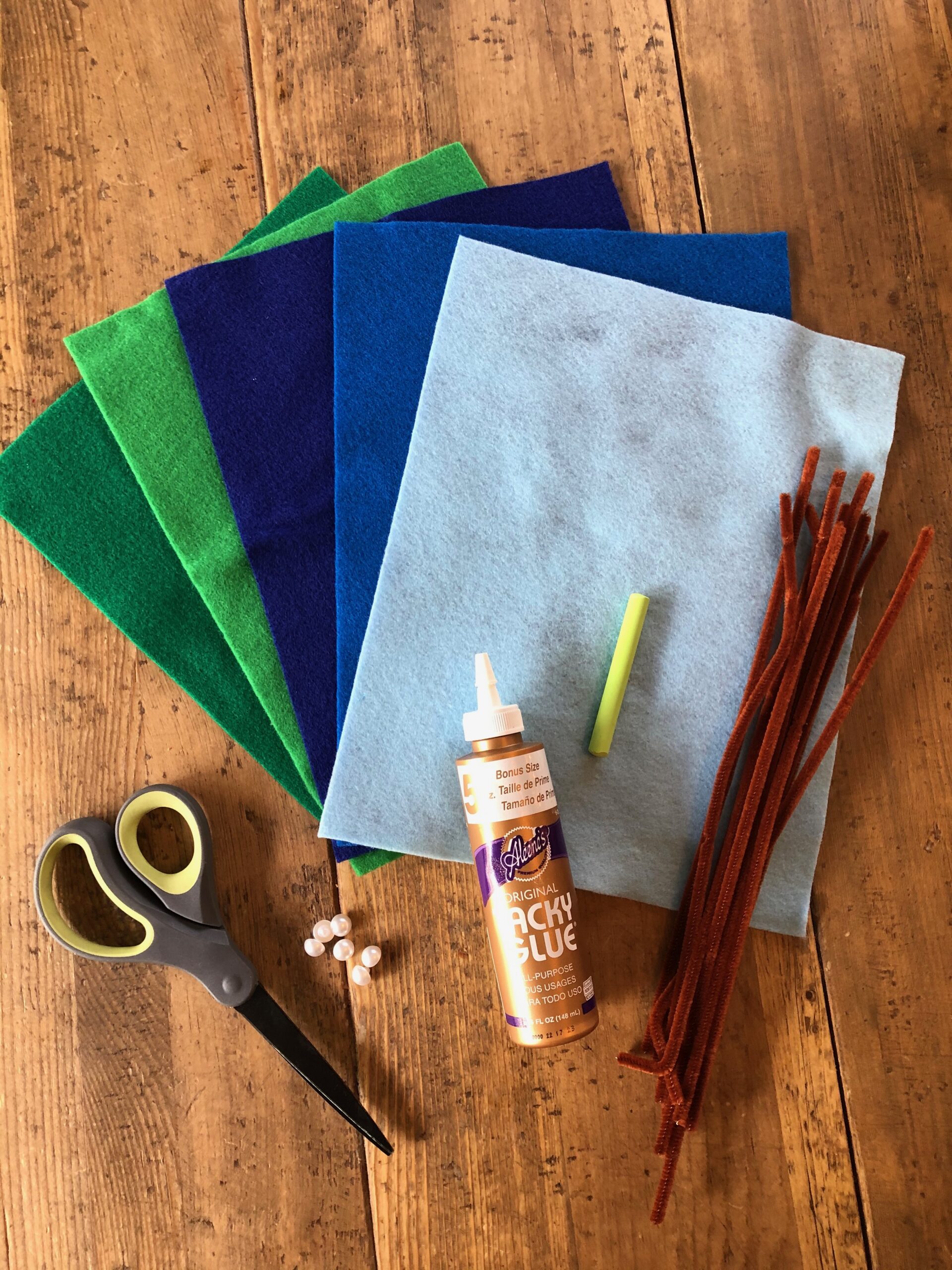 SUPPLIES:
SUPPLIES:
- Felt or colored paper*
- Pipe cleaners, ribbon, or string (optional)
- Pencil or chalk
- Scissors
- Liquid glue (tacky works best on fabric)
- Round object such as a mason jar or roll of tape to trace different size circles
- Buttons or beads for decoration (optional)
*Note: if you don’t have felt or colored paper, no problem. Just use plain paper and color with crayons, colored pencils, watercolors or markers.
STEPS:
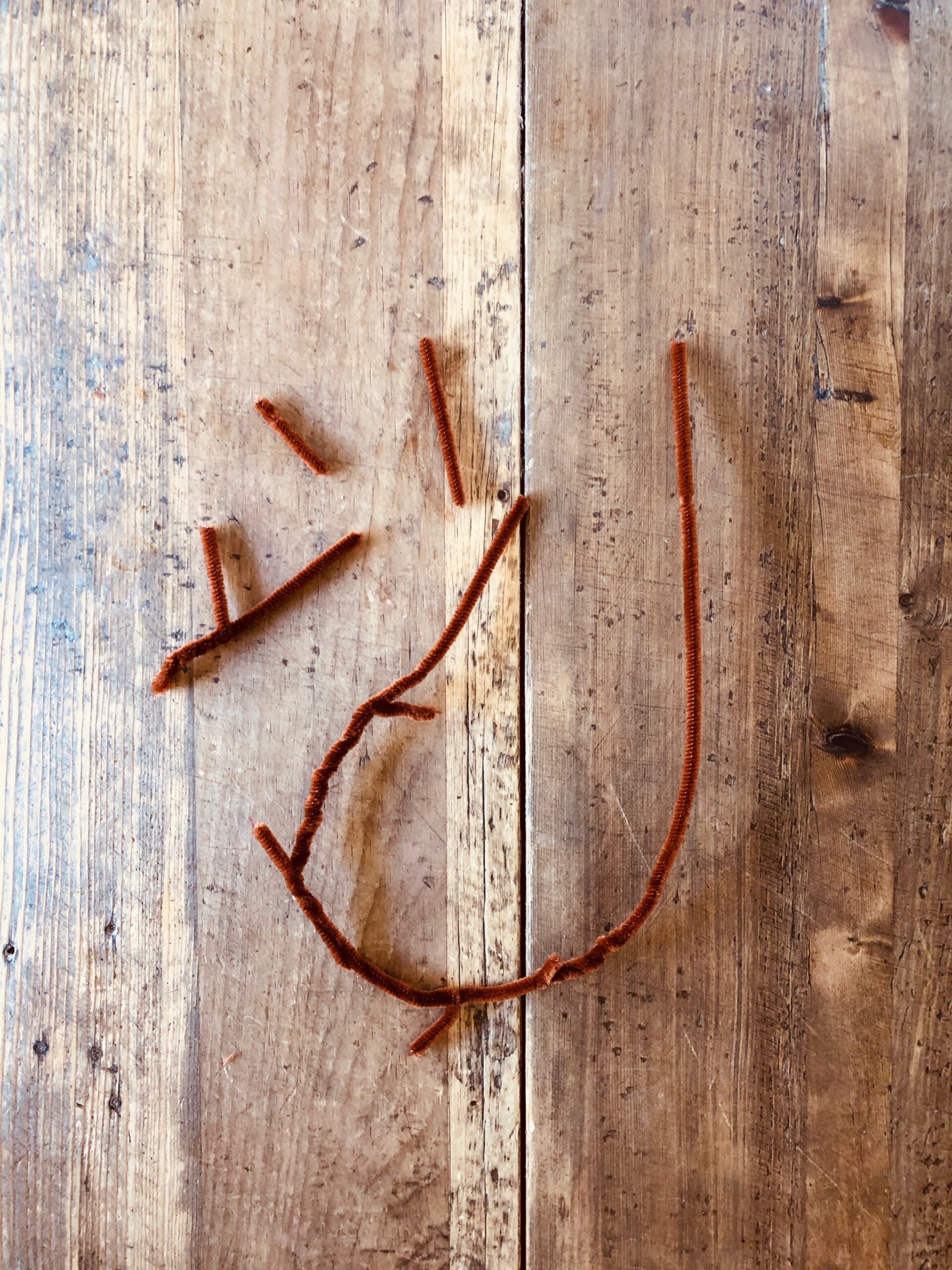
Use pipe cleaners to form a necklace. Cut and twist smaller pieces to create knots or branches. Do not join the two ends together yet; you will attach them to the base later.
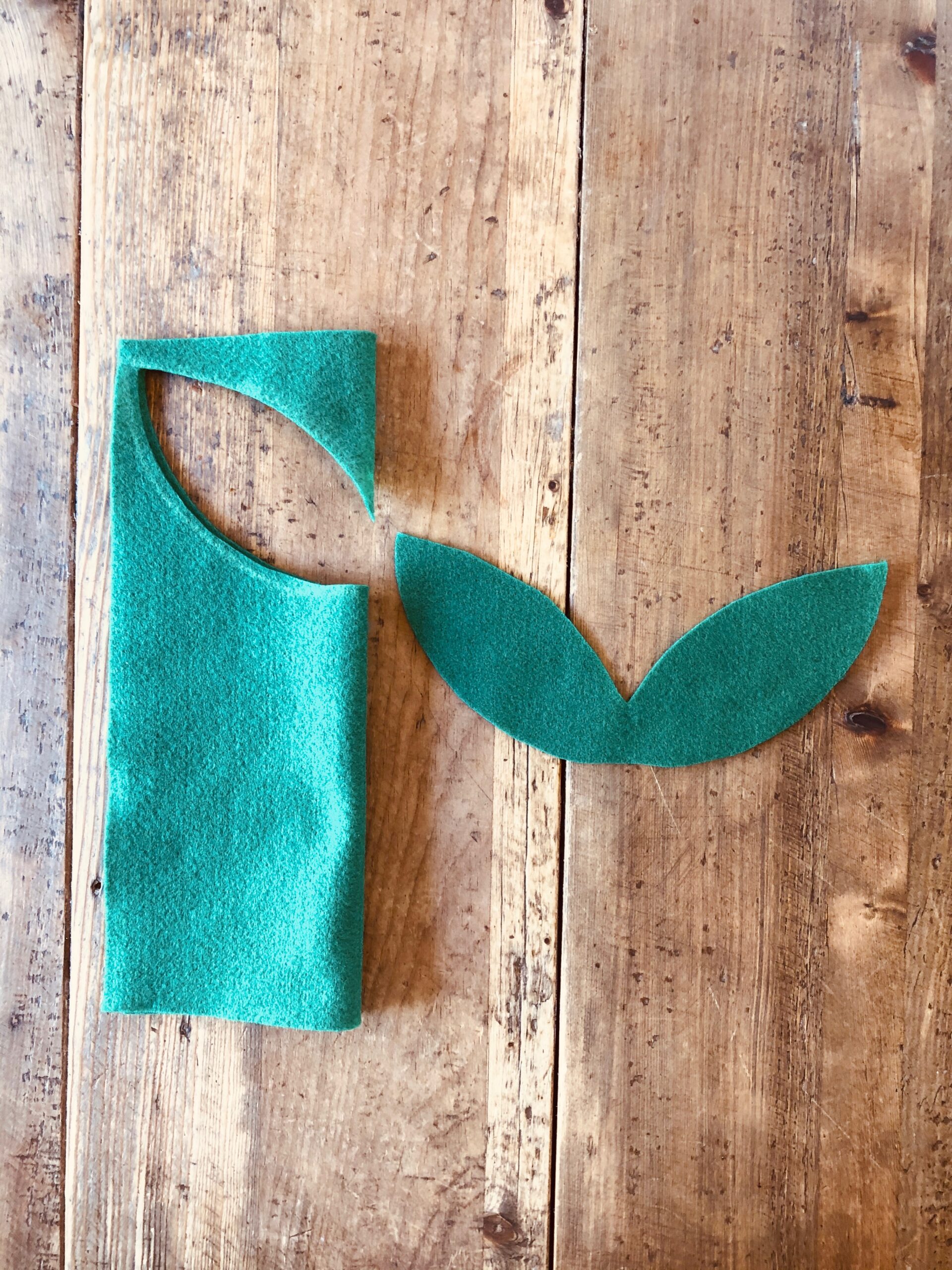
Fold green material in half and cut out a leaf shape. Be sure to avoid cutting on the fold. When you open it, it will look like two leaves connected. This will be the base on which you will glue your flowers.
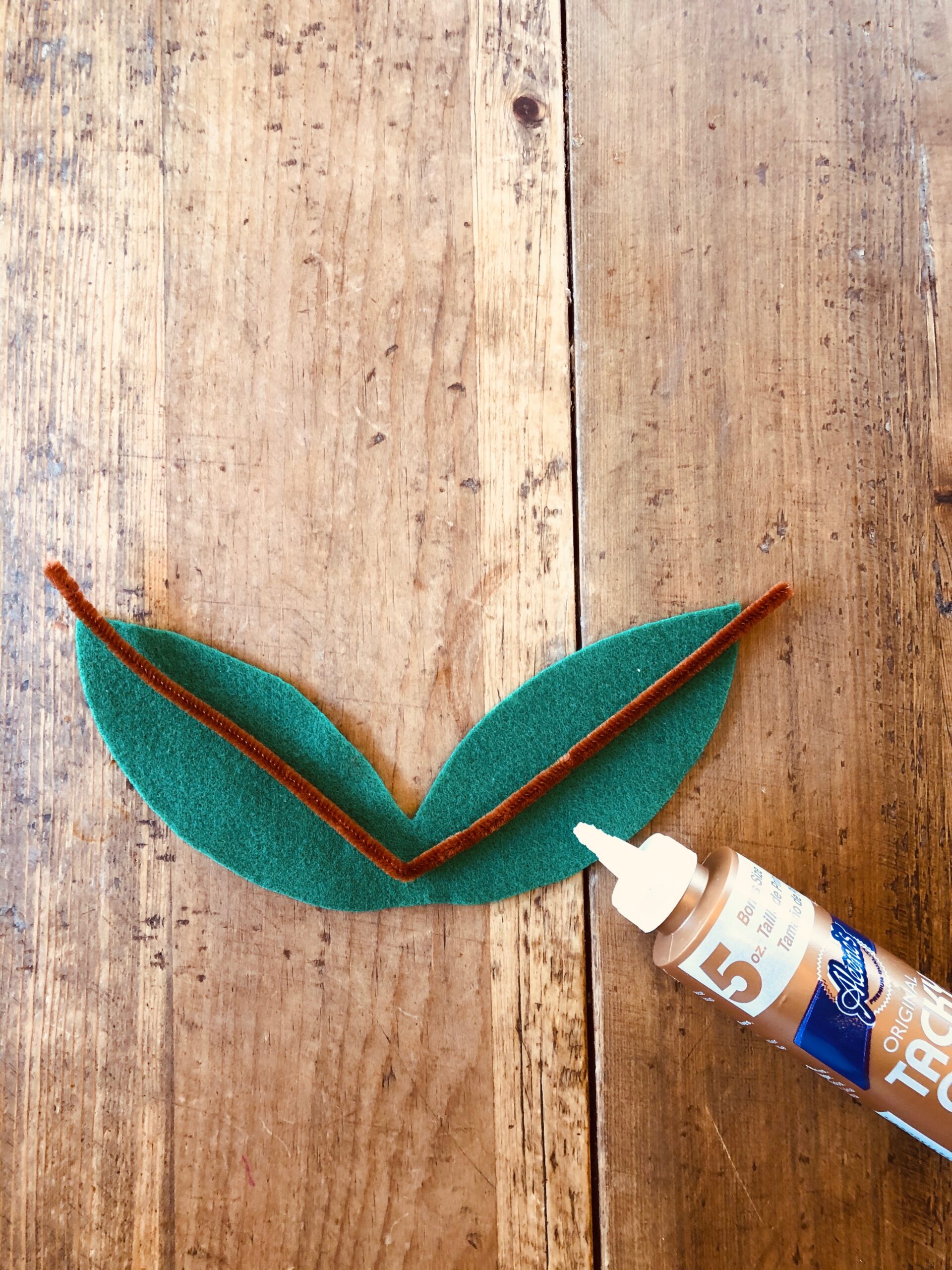
Bend and glue a pipe cleaner to the back of the leaves and let dry. The two ends of the pipe cleaner should extend beyond the leaves; this is where you will attach the necklace later.
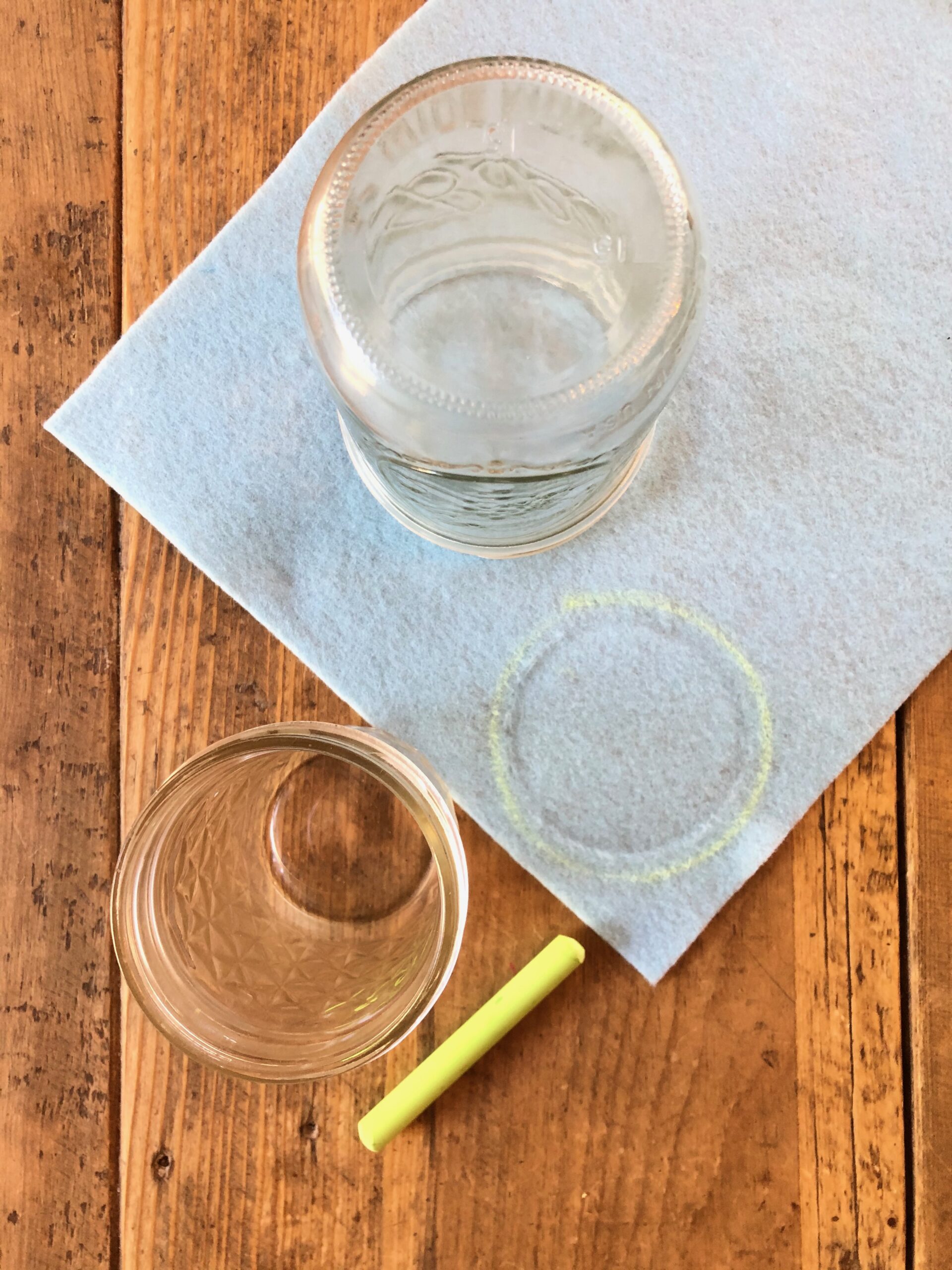
Start with a piece of felt or colored paper. Trace and cut out a circular shape. (It does not need to be perfect!)
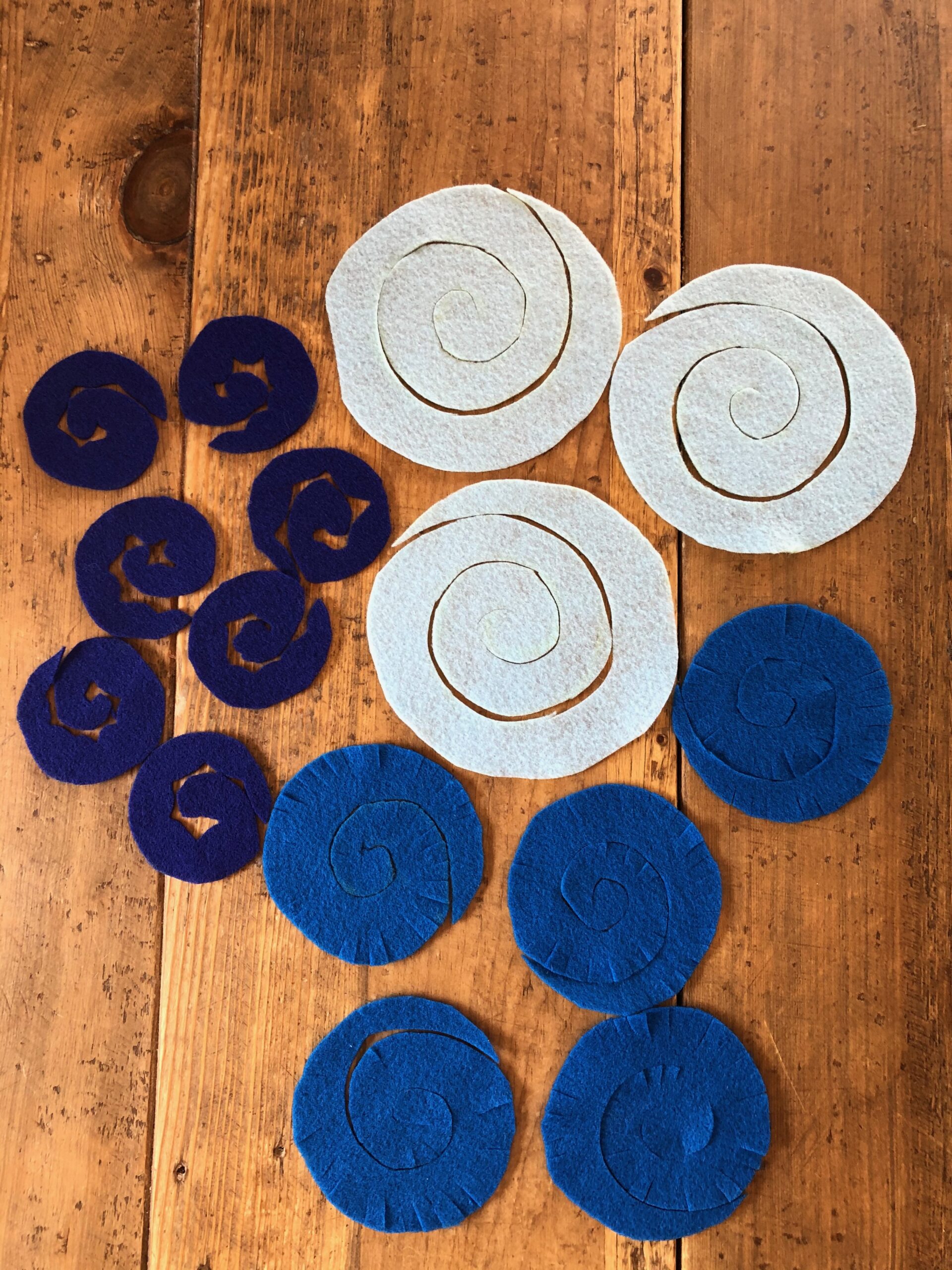
Using a pencil or chalk, draw a spiral from the outer edge to the middle of the circle. Cut along your pencil line.
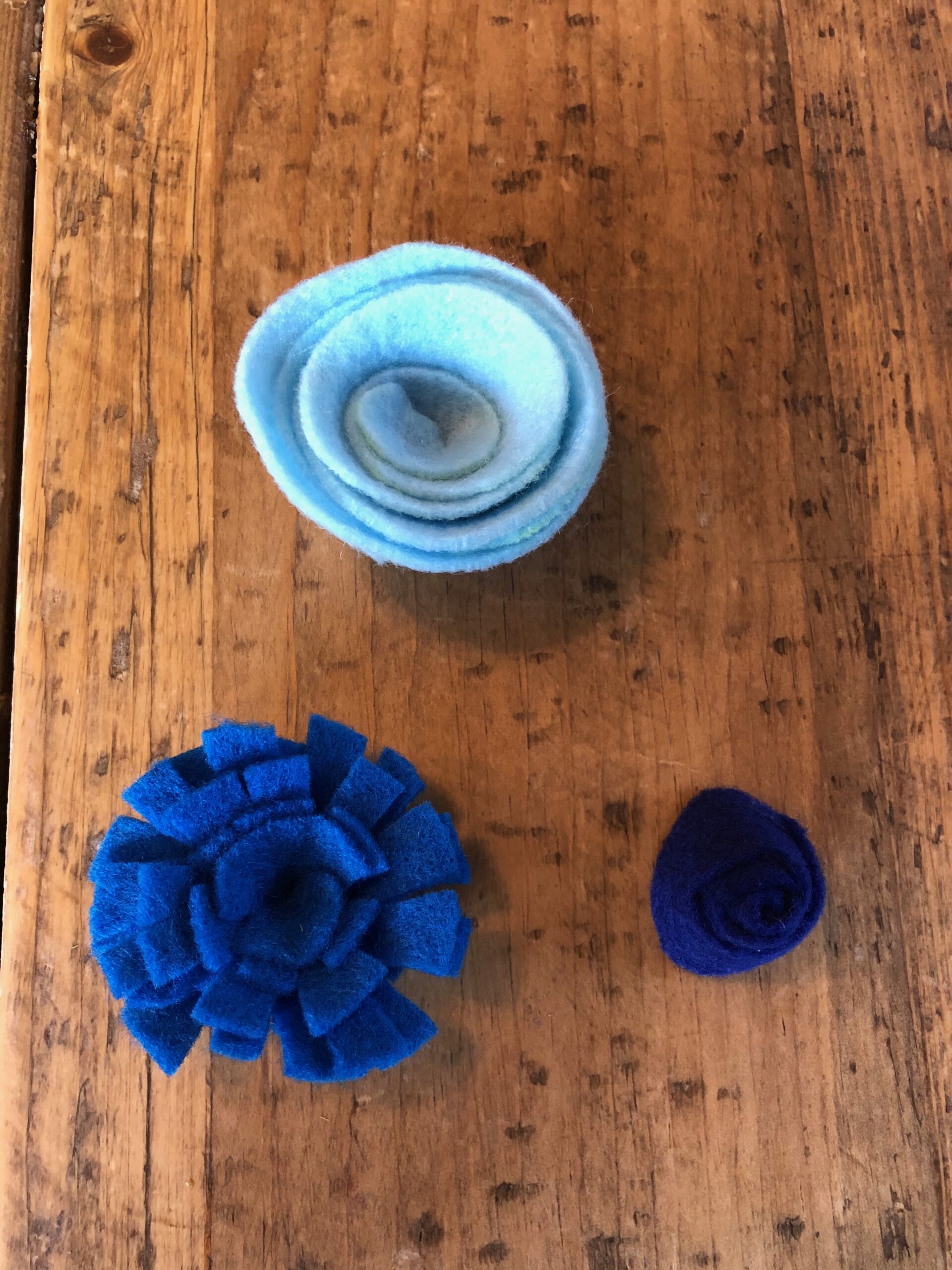
Beginning with the inside end of your spiral, roll your material tightly using your thumb and forefinger to hold it in place as you add layers. Put a small amount of glue on the tail end to keep it together and let dry. Continue making different size and color flowers. You can turn one of the smaller size flowers upside down and it will look like a bud.
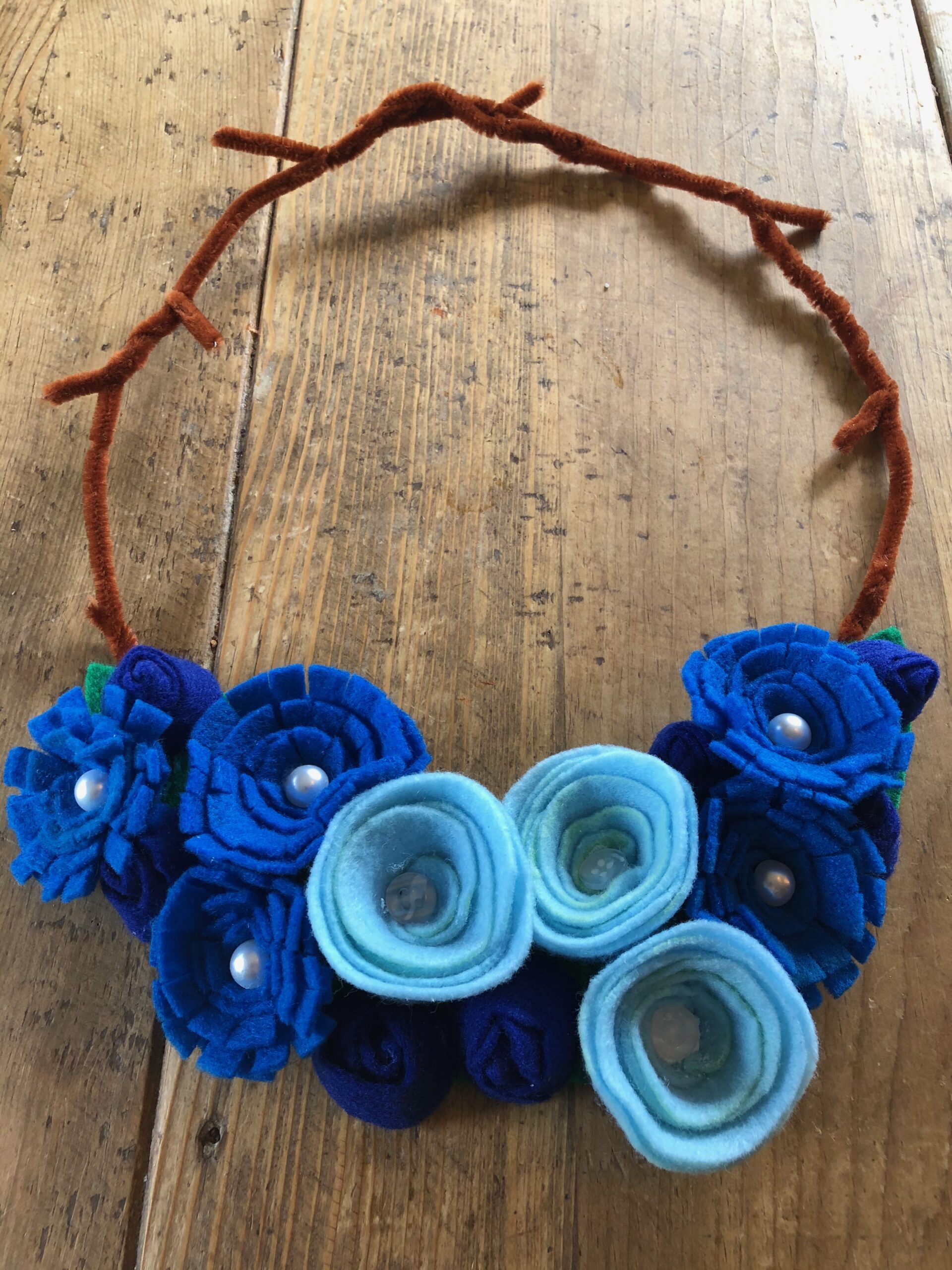
Once all your pieces are finished, glue the flowers to the base. Use old buttons or beads to decorate the center. Once everything is dry, connect the base to the other two branches of the necklace by twisting them together.
Option: If you prefer to make a card, fold a piece of paper in half and glue the paper flowers to the front.
Challenge: Instead of cutting right on the line, cut a scalloped edge or use patterned craft scissors for visual interest. Add details such as leaves.
Simplify: Use larger paper and/or pre-cut spirals.
This idea brought to you by Maggie Burgan.
The Mint Museum From Home is Presented By Chase.
14 pro tips to take your best snapshots while sheltering at home and beyond
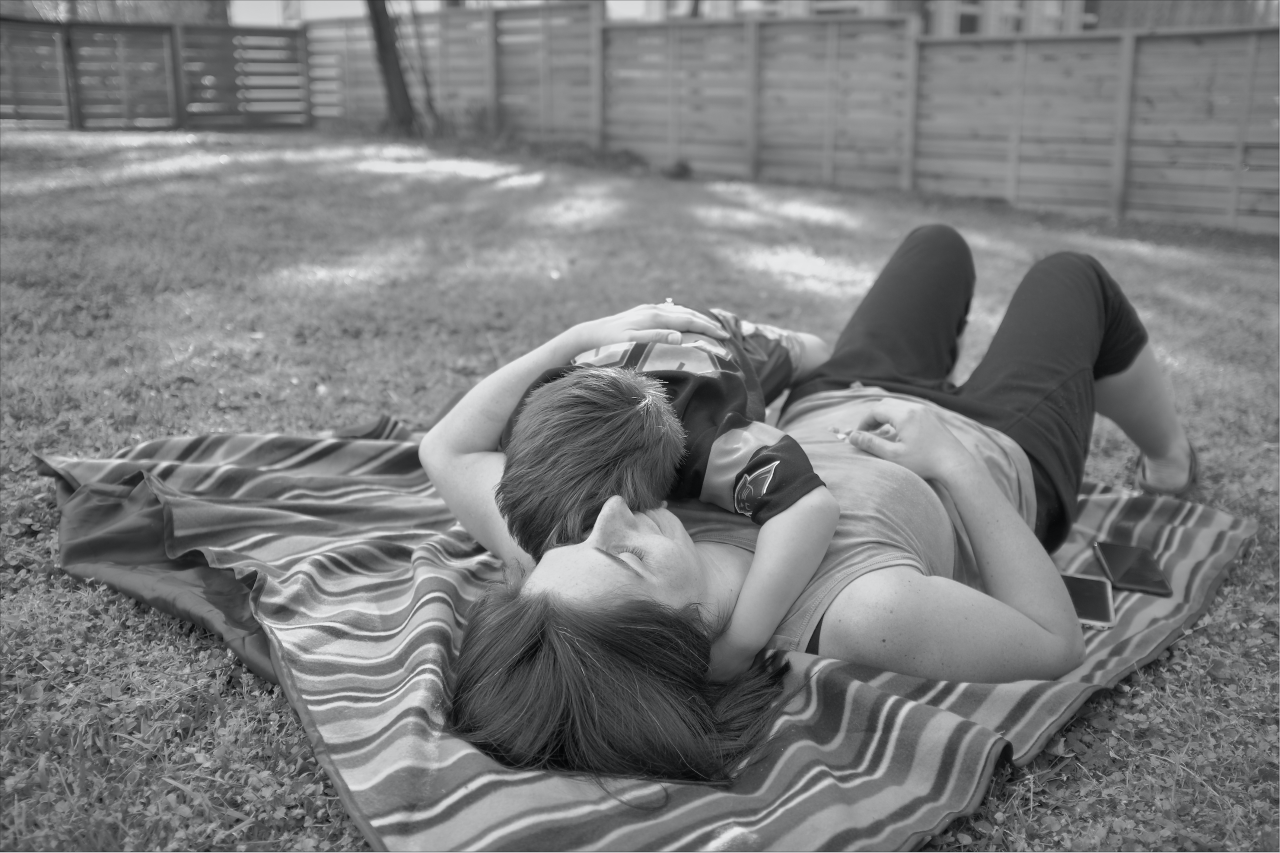
“Always try to have something to make a picture within arms reach. Moments happen quickly. The camera on your phone is probably your best bet,” says Logan Cyrus. Photo by Logan Cyrus
As we continue to make sense of our reality, many are taking notes, and finding other ways to document their daily experiences. Snapshots of day-to-day adventures at home and front porch photo sessions are ways to capture life during a pandemic that we aren’t soon to forget.
Capture the Moment
Look for context
“Think about your pictures as lasting documents of how things were in this very surreal moment in all of our lives,” says Logan Cyrus, a photojournalist based in Charlotte whose work has published in The New York Times, Washington Post and The Wall Street Journal. “Try not to stage things.”

No need to social distance when snapping pictures in the backyard. Move in. Photo by Micah Cash
Get a close-up
While we’re practicing social distancing in our communities, we don’t have to do that in our backyards, says N.C.-based visual artist Micah Cash, whose installation Waffle House Vistas was featured in The Mint’s Coined in the South exhibition. “Get close to your subject and remove wasted space in your images. If I’m photographing a tomato plant, then I need to get close to it. Same with an image of my son watering the garden: The camera needs to be close enough to show that he is the subject. Don’t crop it later. Zoom with your feet and get close,” he says.
Close-ups are particular great when photographing children. “Get the camera on their level or lower, and in their space,” says commercial photographer Adam Whitlow who owns Latch Creative. “You never know what they’re going to do next, and if you are too far away the moment won’t have the same impact.”
Sneak a snapshot
Capture a truly candid moment by snapping a picture when your subject isn’t looking or is busy doing something, suggests Kim Hutchinson, whose work has been featured at various galleries in the city. “Go abstract. Not every image has to be crisp and perfectly balanced. Find joy in imperfection,” she says.
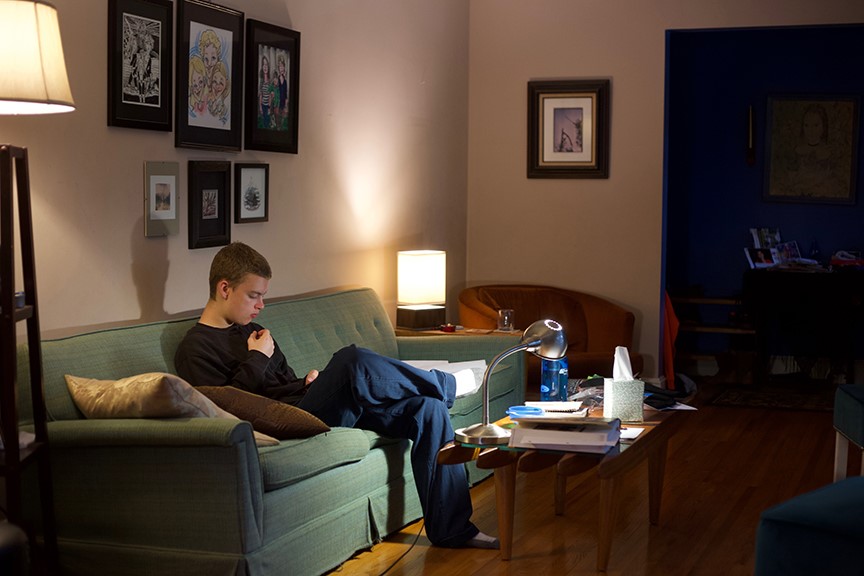
Use mixed lighting sources, and capture moments of life at home during a pandemic. Photo by Kim Hutchinson
Still life is real life
Humans and pets aren’t the only interesting subjects to photograph. Consider a still photo set up of spring flowers, pandemic puzzle projects, or new recipes simmering on the stove.
“Spring brings an abundance of color and life. Try macro photography and put together arrangements of items that capture your story now. Play with different backgrounds and moody light to create drama,” Whitlow says.
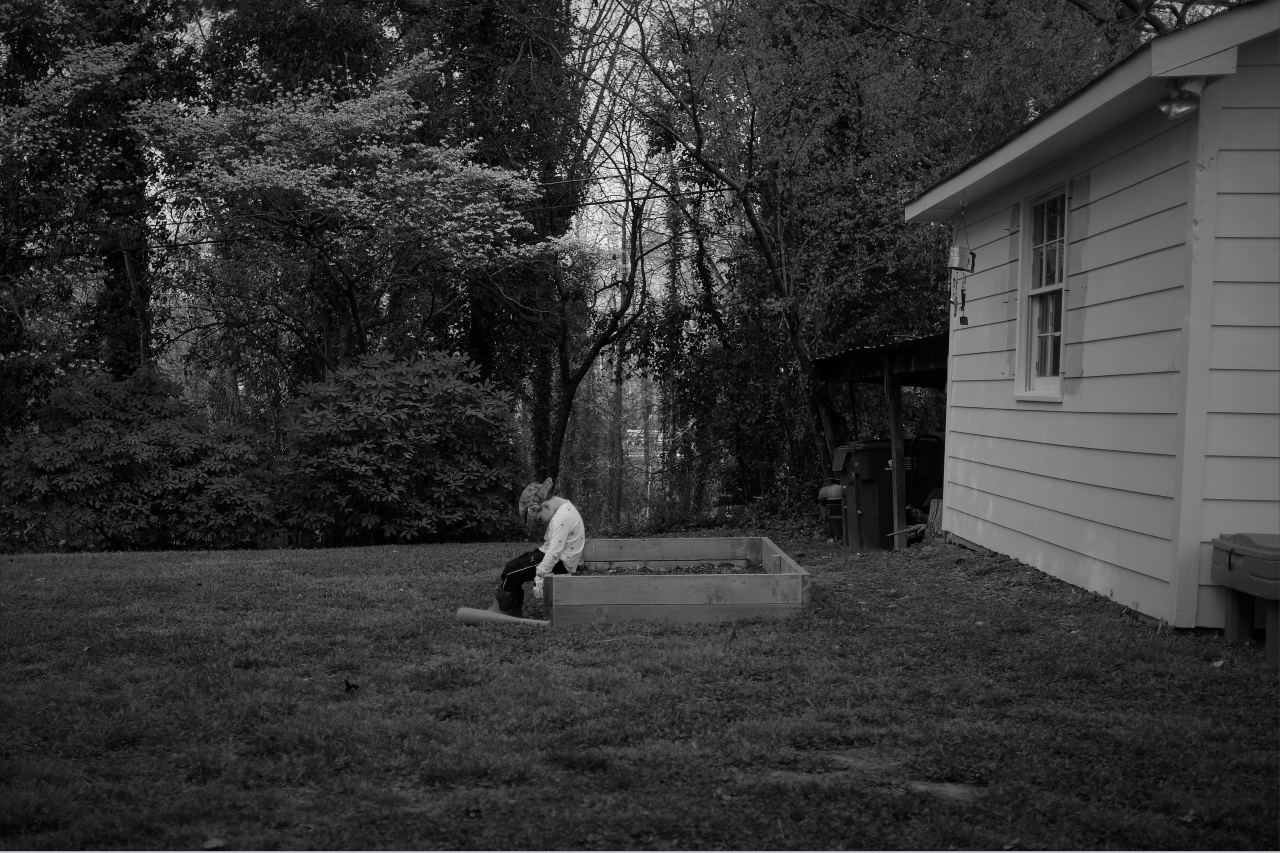
Not all photos have to be of the happiest moments. Capture real feelings in real time. Photo by Logan Cyrus
Think about the “why”
Are you a parent? Is your child in the middle of a temper tantrum? Maybe that’s a good time to make a picture, Cyrus says. “We want to remember the fun of writing inspiring messages on a sidewalk with chalk but we also want to remember the difficulty of being at our homes all day and how we managed to get through it.”
The best photos aren’t posed
Make a game of it, says Elly Kinne, CEO and lead photographer for Weddings by BlueSky. “Play with your child, pup or catch your spouse in a laugh. When you see a beautiful moment, take that photo.”
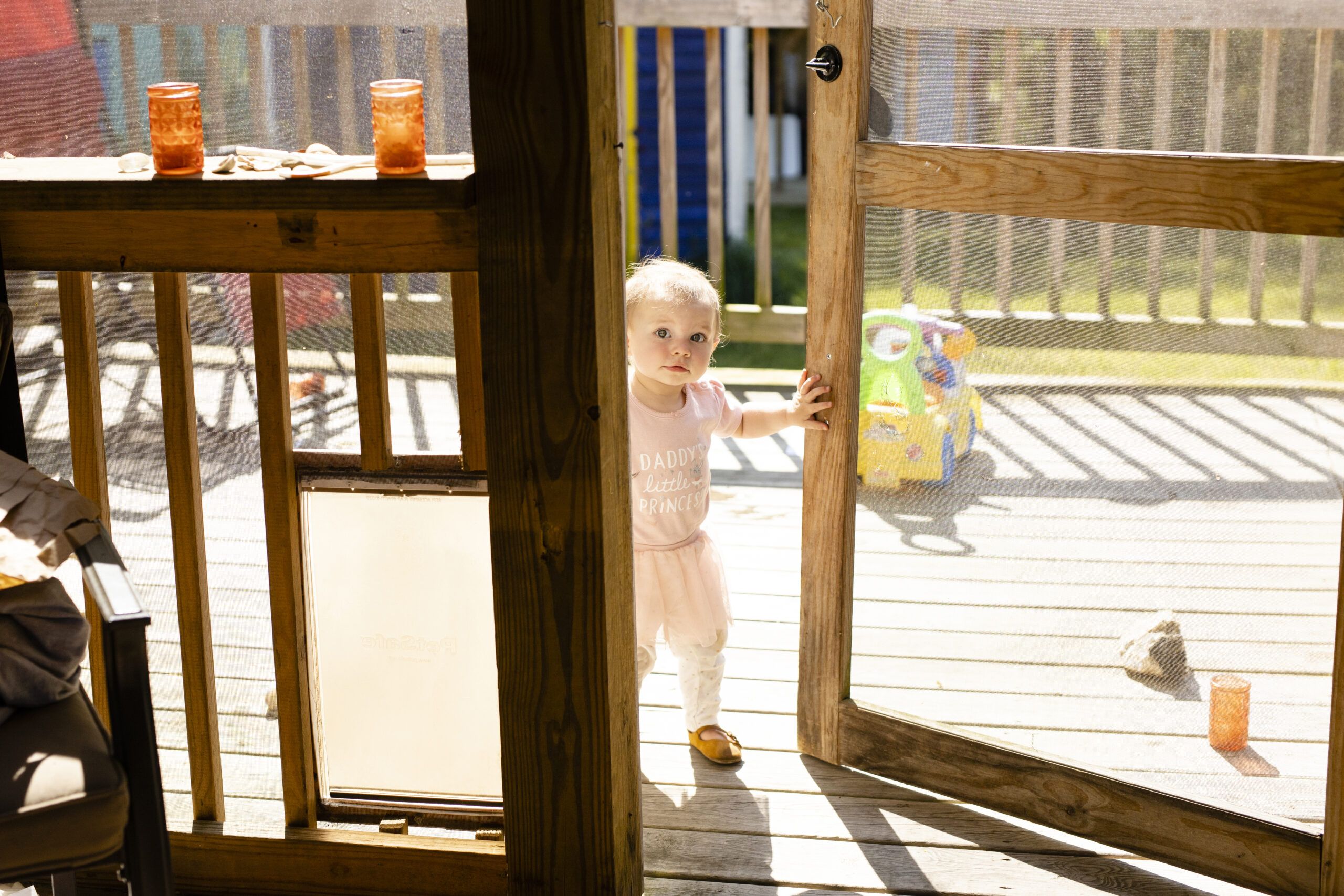
“Pay attention to your light source (or the position of the sun if you are outside). Make sure the light source is either in front of or behind your child,” says Elly Kinne. Photo by Elly Kinne
Think Outside the Frame
Find a new angle
Break away from the convenient eye-level camera angle says Jeff Cravotta, owner of Cravotta Photography and one of the talents behind Charlotte Ballet’s beautiful photography. “Lay down on the ground to either have an ant’s-eye view or look up to your subject, climb up someplace high to look down at your subject,” he says.
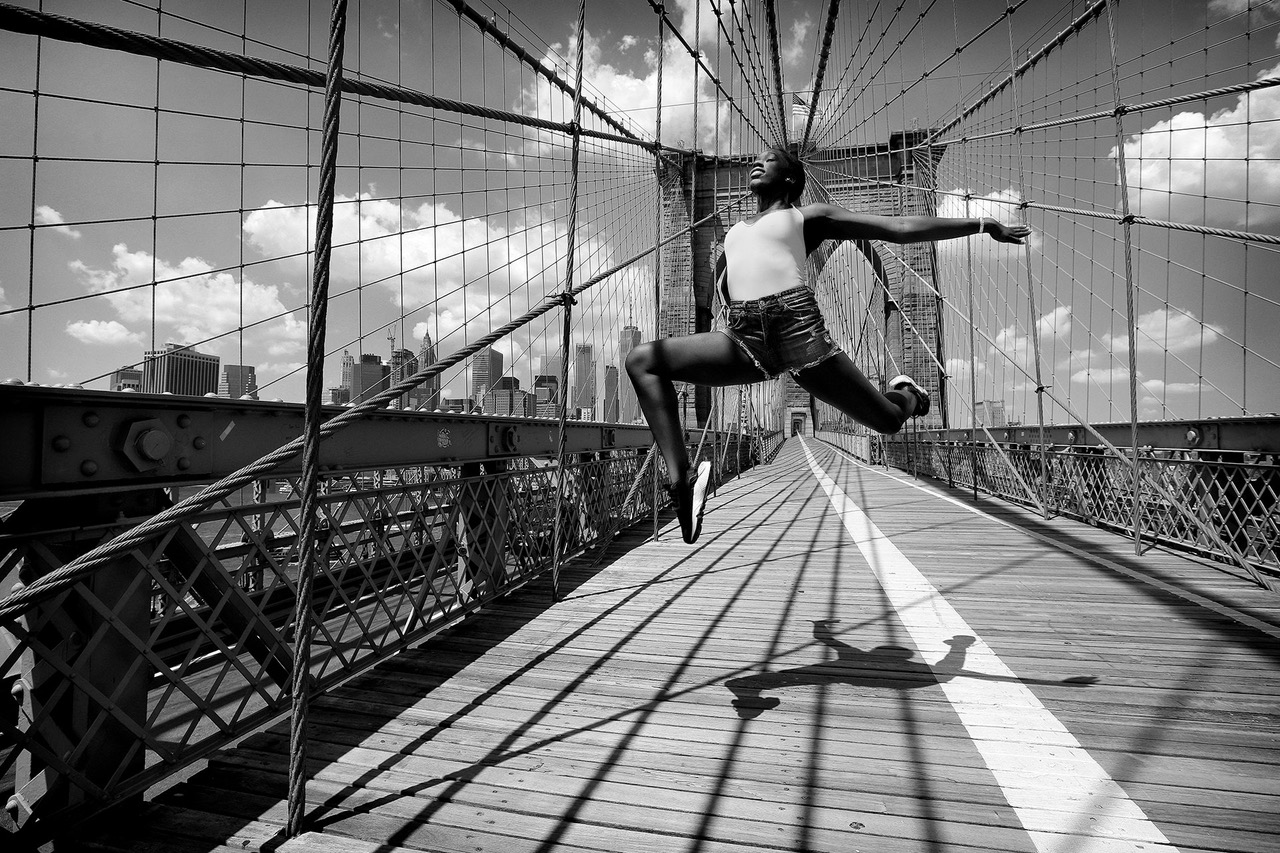
Take a shot from a unique angle to capture motion and a different perspective. Photo by Jeff Cravotta
Be aware of what’s in the background
Don’t want that trash can in the background? Move it or move yourself, advises UNC Charlotte associate professor of photography Aspen Hochhalter. “Make sure everything that’s included in your viewfinder or on your screen is something you want in your photo. You have ultimate control of what is included in your frame, all you need to do is notice the details in your scene.”

A background can be something unconventional. This photo was taken by a dumpster. Photo by Richard Israel
Look for the novel and unexpected
“The photo (above) was taken at a dumpster,” says wedding and portrait photographer Richard Israel. Look for unusual locations and let the reflective colors soak onto your subject.”
Keep your subject in open shade for flattering light, and use as small an aperture as possible or portrait mode on your phone for that out of focus background, he says.
The Right Light
Embrace the “magic hours”
The first hour of the day and the last hour of the day are the best opportunities for photography,” Hutchinson says. “This is due to the lower angle of the light and how it is filtered through the atmosphere and the environment. If you can manage to shoot either earlier or later in the day you will get better results with natural light.”
Harsh midday sun isn’t flattering and is difficult to control, Whitlow says. “Try to find a shady spot or position for your subject so the sun is behind them, and use your flash to light their faces.” If you feel like adding other techniques, find some white foam core or poster board and try to bounce light back into your subject or use a thin white fabric to diffuse harsh sun, he says.
Don’t be afraid to play with exposure
Many photographers prefer to put their subjects in shade, so that the lighting is more balanced. If you usually shoot at 200 ISO in sunlight, try shooting at 400 ISO in the shade, says music and event photographer Daniel Coston.
If your subject is in the sun and they look too bright, just drag your exposure down before you take the photo, Kinne says. “On an iphone, just click on your subject on your screen, a bar will show up, drag the exposure up or down depending on the look you are going for.”
What about lighting inside?
“Window light, window light, window light,” says wedding photographer Casey Hendrickson. But not directly hitting your subjects. “I always like to photograph at a 90-degree angle to my subject when shooting inside to have the proper depth and shadows, but also ensure that colors remain true.” If the light is too harsh, and shadows are too contrasted, try placing sheer white/ivory curtains over the window to diffuse the light, she says.
Technical Tips
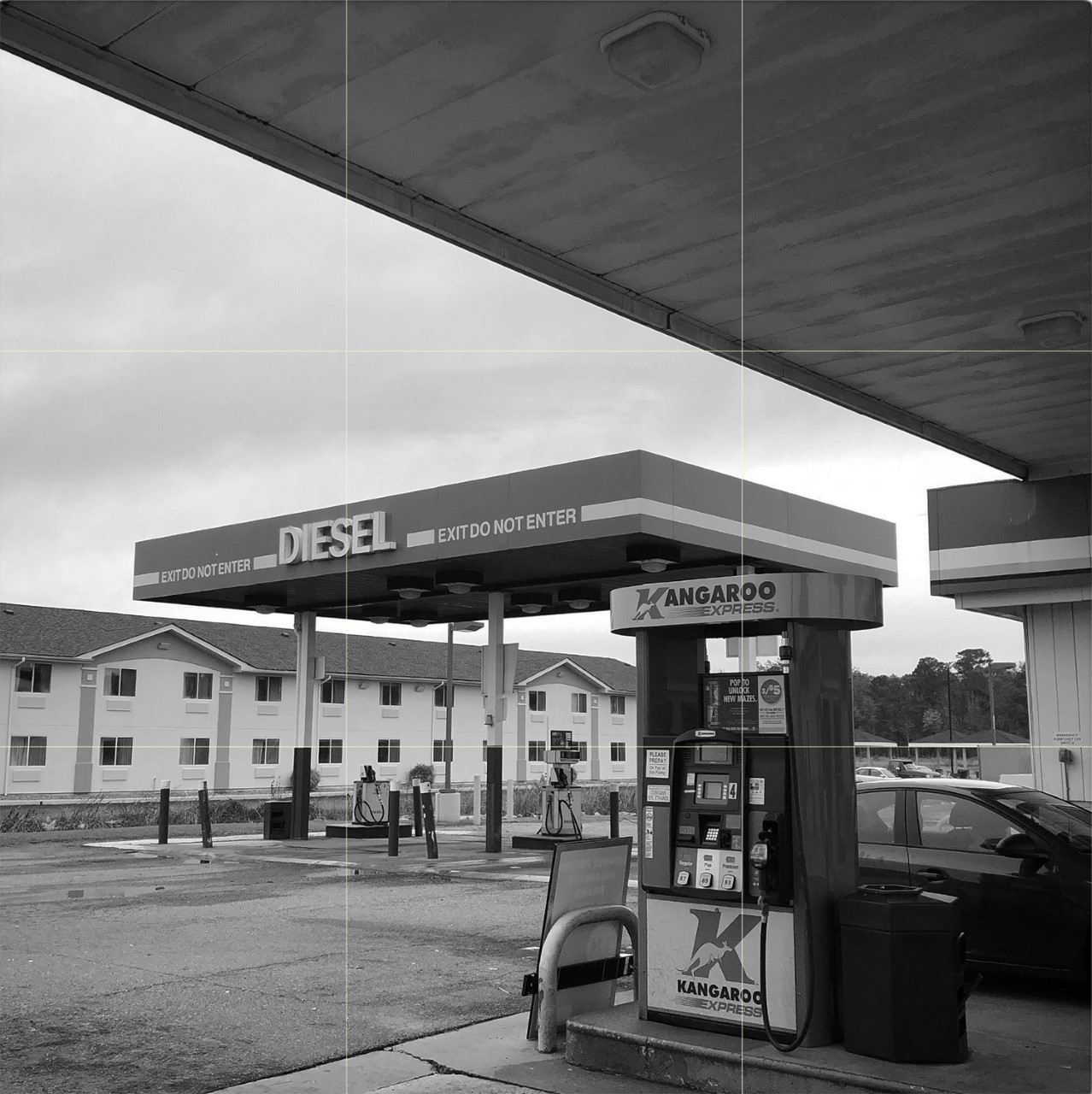
Use the grid on your camera to help compose a photo. Photo by Micah Cash
Let the grid be a guide
Use the grid setting on your camera to compose your image according to the rule of thirds, says Cash. “When turned on, you can line the subject matter onto one of the intersections or along one of the lines to make a more natural and balanced photograph. But feel free to break this rule when you want an image to be more formal, jarring, or stark. Knowing the rule allows you to break it creatively when your image needs it.”
Create motion and try time-lapse
“For many people, time is practically standing still. Time-lapse can provide that much needed assurance that life is still moving forward,” Whitlow says. Find a scene that has repetitive action and is evolving within the frame. “This could be as simple as someone perpetually throwing a ball to the dog or the endless stream of walkers and bikers on your street. Set your camera on a tripod or stabilize it somehow and be patient.”
Israel suggests creating a sense of motion by panning the camera with your subject.
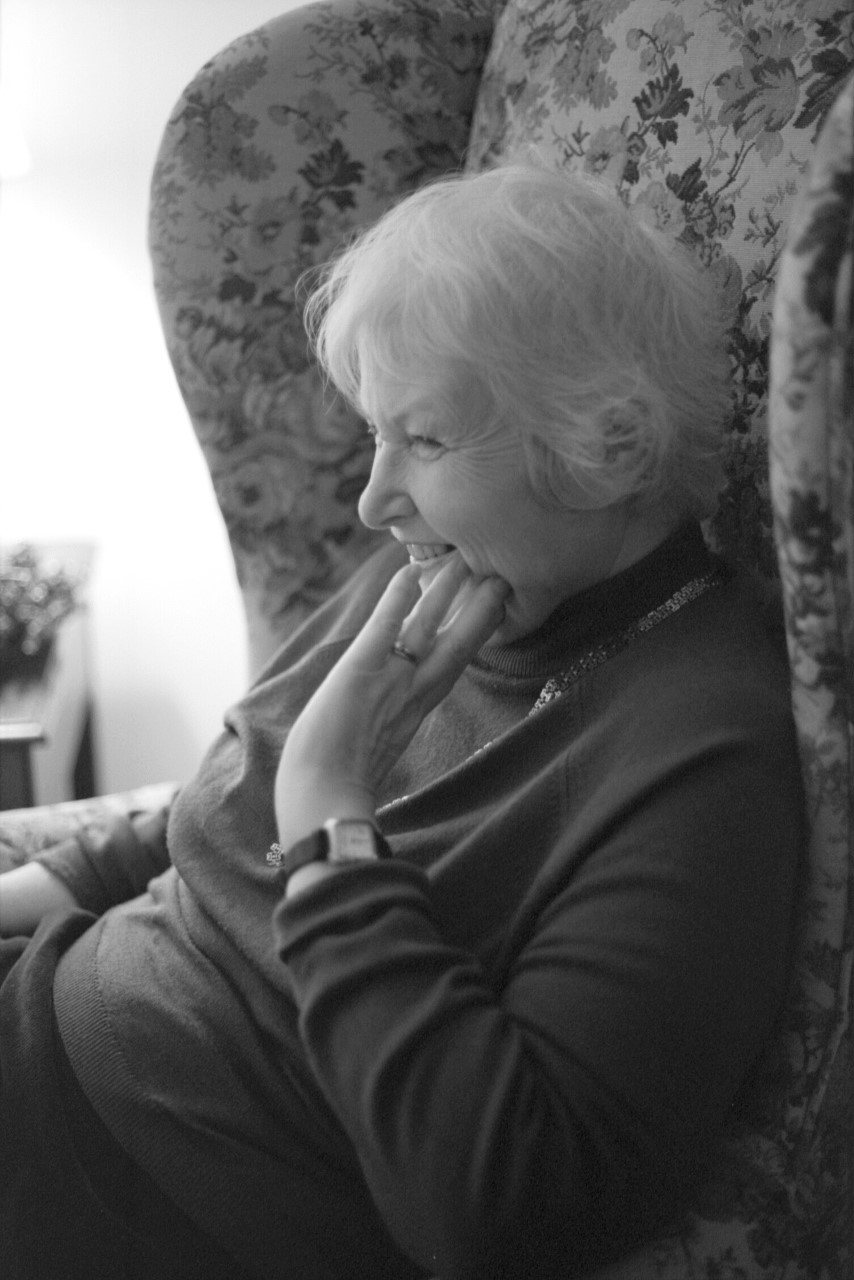
Using a flash is good if you are in a room with very little light, or just want to get that perfect posed photo. Photo by Daniel Coston
Flash or no flash?
Using a flash is good if you are in a room with very little light, or just want to get that perfect posed photo of a group of people. However, using a flash can seem a bit much to some people and kids, Coston warns.
“Look up your camera’s ISO setting, take it off of the auto setting, and increase the ISO to 800 or 1600 if you are indoors. This way, you can take photos without a flash, and there will be less motion in the photos,” he says. “Whatever you are into, whether it’s your family, job, travel or everyday life, it all means a lot to you. If you want to document it, you should. No matter how good or bad of a photographer that you think you are. It’s your eyes through whichever camera you have with you, even if that’s just your phone.”
The Mint Museum From Home is Presented By Chase.
These Zoom backgrounds will transform your next meeting into a work of art
‘I know that everything is changing around us and we are profoundly changing our being in this world.’
Argentinian-born artist Silvia Levenson, now a resident of Italy, has hopes that the pandemic will help people to come together to break cultural barriers and overcome xenophobia. Her glass sculpture Until Death Do Us Part is part of The Mint Museum collection.
Studio location: Lesa, Maggiore Lake, Italy
Who are artists that inspire you and your work?
Louise Bourgeois, Doris Salcedo, Loris Cecchini, and Eva Hesse
What is your favorite piece or artwork that you created and why?
I have two favorite pieces: Until Death Do Us Part and She Flew Away.
Until Death Do Us Part conveys my answer to the violence in homes, when someone who would protect and love you became the perpetrator. This topic is so actual now, as thousands of women and girls found the bravery of report abuse. Every year 50.000 women and girls are killed by a partner, ex-partner or relative. An now with the pandemic, lots of women are trapped. The fact that the cake is beautiful and made of glass is very functional to my idea.
She Flew Away started from a childhood memory. In Buenos Aires, Argentina I played for hours on the swing. At a certain moment I took off my shoes and climbed up on the wooden surface. I remember that ambiguous feeling. On the one hand I wanted to fly away, but on the other I was terrified of that possibility. Later that sculpture represented a loss: the loss of childhood, life or visibility.
How does your environment influence your art?
I need calm and loneliness to create. Living in an small village, in an old paper factory is great for me. But my inspiration comes from books, news and my memories.
Tell us about your new morning routine, including when you start your day and how you spend the early hours.
I start my day at 7 or 8 AM. Sometimes I walk for one hour, sometimes I start my day with meditation, and sometimes I feel the urgency of working in my studio. I can say that I have more energy in the morning. I usually don’t answer to my phone until 3 PM.
Are you finding new inspiration for your art during this shift of perspective in the world?
Now I am working on the idea of invisibility. Invisibility can be a joy or a sentence. I know that everything is changing around us and we are profoundly changing our being in this world. I will see how all this will influence my art work.
Tell us about your afternoon. Are you working from home, going to your studio?
I am so lucky to have my home and studio together. I combine my life between the two. I spend lots of my time on the computer in any case, but now my assistant cannot come to work with me, so I am making everything for myself and the process of producing sculptures in glass is very long, but I enjoy that!
What positive perspective changes in society would you like to see come from the pandemic?
I would like to see more empathy. When the virus started in China, in Italy several people in Italy thought that it was a “Chinese problem.” Many politicians and people were so racist even with citizens from China living in Italy. But after few days, Italians become the “new Chinese.” The same in the U.S. and United Kingdom. I hope people will understand that we are all humans, and that if the Coronavirus can expand and cross borders, why we are so connected to walls and borders?
How are you winding down your day? Have any recommendations for stress relievers to settle after another day done?
My advice would be to pay attention to the fake news. Being critical and looking for the right information is a sort or resistance high now.
What are you cooking? What’s your comfort food of choice?
My partner Marco is cooking and I love everything he makes.
What are you currently reading?
The Lies That Bind by Kwame Anthony Appiah.
What is your favorite music choice?
Mercedes Sosa
The Mint Museum From Home is Sponsored by Chase.
The Mint Museum celebrates the life of Dr. Francis Robicsek, a pioneering heart surgeon, art collector and Renaissance man
It is with heavy—yet grateful—hearts that The Mint Museum recognizes and celebrates the life and legacy of Dr. Francis Robicsek, who passed away peacefully at his Charlotte home on April 3, at the age of 94.
Robicsek was best known for being a world-renowned heart surgeon who performed some of Charlotte’s first open-heart operations. Over his 64-year career, he performed the city’s first heart transplant, founded the Sanger Clinic (now Atrium Health Sanger Heart & Vascular Institute), and was known for his steady hand — and improvisation — in some extraordinary situations. (Consider this: On New Year’s Eve in 1964, when a fellow doctor’s heart stopped on a hospital elevator, Robicsek proceeded to cut the man’s chest open with suture scissors, massage the heart, and then shock it back into rhythm with the cord from a table lamp.)
But the doctor who fled Soviet control in his native country of Hungary in 1956 with his six-months-pregnant wife, Lilly, was also a student of the world. Robicsek saw beauty in the old and was an avid art collector who generously helped establish, grow and develop the Mint’s pre-Columbian, Spanish Colonial, and European painting collections. Many of the works of art are on display in Mint Museum Randolph’s Lilly and Francis Robicsek Galleries.
“I only had the pleasure of meeting Dr. Robicsek once, but he was a figure who had an aura of well-deserved respect, almost reverence,” says Mint President and CEO Todd. A Herman, PhD. “And if you paid attention, he had a sense of humor that those willing to see past the aura would appreciate—with a twinkle in his eye and a slight rise to the edges of his mouth.”
Robicsek became interested in archaeology in the 1960s. “I have never enjoyed a vacation where you just go and sit around, and I have never enjoyed walking around a golf course,” Robicsek wrote in the 2008 book Pioneers of Cardiac Surgery, by Dr. William S. Stoney. “I have always needed an excuse or a reason for going from A to B.”
So it was auspicious when Robicsek saw an ad in the Annals of Thoracic Surgery for a hospital in Honduras that needed a surgeon with experience in tuberculosis surgery. Robicsek began spending summer vacations there. And when the hospital could only handle one thoracotomy per day, he spent his downtime “prowling around the ruins.”For decades, Robicsek worked to expand healthcare facilities and operations in Central American countries, including Honduras, Guatemala, Nicaragua, Belize and El Salvador. He helped build pediatric and neonatal intensive care units, and he raised money to take pieces of equipment deemed obsolete by U.S. standards and have them refurbished and shipped to Central America, where he’d also train staff how to use them. Then, whenever possible, Robicsek would change out of his scrubs, pull out his camera, and go exploring.
Of course, he couldn’t have done it without Lilly. A medical doctor herself—she did two residencies in pathology and pediatrics—Lilly retired from medicine to help raise the four children and afford her husband the opportunity to work, study and travel around the world, often with Lilly by his side.Dorie Reents-Budet, PhD—a former visiting curator for native art of the Americas at the Mint—spent years working with Robicsek and exploring his vast collection. But they first met in 1982 when Robicsek attended the Maya Hieroglyphic Workshop at the University of Texas at Austin. Reents-Budet was a graduate student at the time and was helping put on the workshop
The crowd was an insular group of art history and anthropology scholars from the U.S. and Canada. Reents-Budet, eager to make sure all attendees felt welcome, offered to drive Robicsek to all of the after-hours workshop cocktail parties, to introduce him to her professors. “It was memorable getting him to fold up those long legs so he could fit in my 1967 Nova,” she says.
Robicsek authored five books on Mayan culture and art, and just as he was a pioneer in the medical field, he was also an early adopter in the field of art history. He was publishing books on pre-Columbian art long before the National Gallery of Art even recognized it as art and not just a facet of anthropology, says Reents-Budet.
To Robicsek, she adds, these works were equally as poignant as any Grecian ceramic, Egyptian artifact, or Renaissance painting.Michael Tarwater, formerly the president and CEO of Carolinas Healthcare System, first met Robicsek in June 1981. Tarwater was a vice president at the time and part of his purview included overseeing the hospital’s cath lab, where doctors studied the heart. He and Robicsek became fast friends, and for a period of about 15 years, Tarwater and his wife, Ann, would travel the world with Robicsek and Lilly—from Romania, where the ancient monasteries are painted with exquisite Biblical scenes, to Antigua, Guatemala, home of the world’s largest Easter celebration.
“To the very end, he had this beautiful youthful curiosity about life that you just wanted to tap into,” says Ann Tarwater, one of the Mint’s Board of Trustees. “He wanted to show you the world.”
That sense of curiosity didn’t wane after Robicsek retired in 1998. If anything, it picked up. “He was an inventor, an innovator, a scientist, a scholar, a humanitarian,” says Michael Tarwater. “And,” he added, “a prankster.”
In the mid-1980s, Carolinas Medical Center experienced a few power failures, which always caused a scramble, Tarwater said. A few days after one, the hospital administration announced to staff that they’d found the problem and resolved it. Afterward, Robicsek stopped by Tarwater’s office for a quick chat.
Minutes after Robicsek left, Tarwater saw the power go out yet again. “The first thing you think about are all the people in the operating room, all the things we rely on, all the people on ventilators,” he said.
Frantic, Tarwater raced out of his office. That’s when he realized that the power outage was isolated. The mischievous Robicsek had found the circuit breaker for just the administrative offices and flipped the switch.Francis and Lilly Robicsek took every opportunity to travel with their children—Steven, Susanne, John and Frances—and later with their five grandchildren. They instilled a love of art, music and culture in all of them.
Robicsek’s daughter Frances Furr, the youngest of the four children, studied art history in college and went on to be an art teacher, a member of the Delhom Service League, and a docent at the Mint.
Furr recalls the time when, as a lover of North Carolina ceramics, she took her father to Seagrove to view the pottery. “In that thick Hungarian accent, he said, ‘There aren’t any cracks in it. I don’t like it,’” Furr recalls, laughing.
He later recanted, she says, but his premise remained: There was beauty and value in old things. Whether traveling the world with family and friends or simply browsing a flea market or art gallery with his children, Robicsek espoused the power of learning about the past, of finding beauty in artifacts.
Two weeks before her wedding day, 27 years ago, Robicsek took Furr to the jungles of Mexico, where he was on a mission to photograph Mayan ruins. There were no hot showers, they slept in hammocks, and she remembers looking out the back of a truck and realizing they weren’t on a road. But then they arrived at the most amazing old mounds in the middle of nowhere.
“I love how he taught me to see life through the lens of culture and art,” says Furr. “And that I’m very grateful for.”
We at the Mint are also grateful to Robicsek and his family for sharing the life and legacy of the remarkable doctor, buried in his scrubs, who saved lives and championed art in equal measure.
Sincerely,
Todd A. Herman, PhD
President & CEO
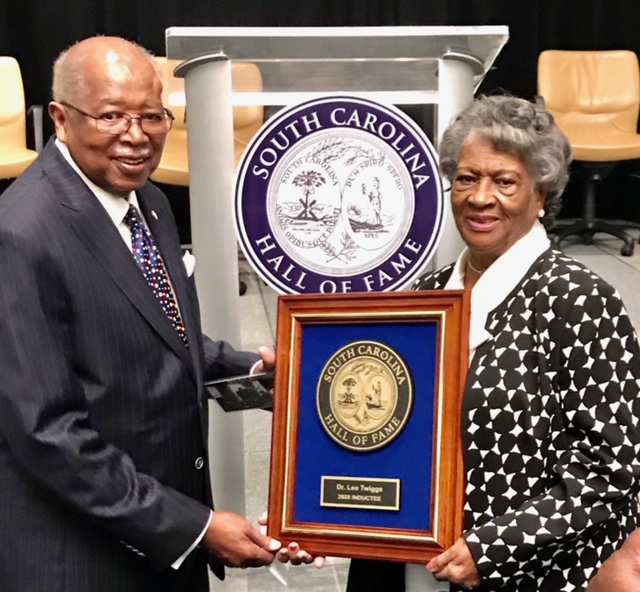
Dr. Leo Twiggs and his wife at his induction to the South Carolina Hall of Fame.
After years of exploring racism, inequalities, and crises through his art, Dr. Leo Twiggs feels pull of pandemic
An American painter, artist, and educator who grew up in the South, Dr. Leo Twiggs’ phenomenal exhibition Requiem for Mother Emanuel was showcased at the Mint Museum Randolph. Requiem was his artistic response to the massacre of nine church members during a prayer meeting in the historical Charleston house of worship, Mother Emanuel AME Church. Here he shares his thoughts on how the pandemic is affecting his daily routine and inspiring his art, as well as the positive effects he hopes to see after.
Studio location: Orangeburg, S.C.
Describe the artwork you create and medium you use.
Innovative batik painting—wax and dyes on cotton fabric mounted on hard board.
Who are artists that inspire you and your work?
Hale Woodruff, Aaron Douglas, Jackson Pollock, and Joan Miro, among others.
What is your favorite piece or artwork that you created and why?
I work in series. The Commemoration Series (Flags) and the Targeted Man series evolved into Requiem For Mother Emanuel, a series of nine paintings lamenting the victims of the shooting at Mother Emanuel AME Church in Charleston, South Carolina. It is a favorite because it is a place I arrived at after years of exploring the issues of racism and inequalities in our country. Mother Emanuel challenged me to vent my emotions while maintaining the aesthetics and integrity of the creative process. Conversation, the painting at the Mint, is an extension of that new exploration.
How does your environment influence your art?
I was born in the South. The sights, smells, sounds and traditions of the region impact my work, especially the southern African American experience.
Tell us about your new morning routine, including when you start your day and how you spend the early hours.
I paint in spurts, allowing lots of time in between for contemplation. Batik is a slow process and it fits my tempo. I am currently working on a painting commissioned by the Inaugural Committee at Claflin University. When it is complete, I will get back to my regular routine.
Are you finding new inspiration for your art during this shift of perspective in the world?
Yes, just as it was when Hurricane Hugo came through and after 9/11. The Hugo series is on YouTube.
Tell us about your afternoon. Are you working from home, going to your studio?
My studio is attached to my house so I can work all night if I wish. More often I work until late hours after midnight. There is a solitude about the night that I find invigorating.
What positive perspective changes in society would you like to see come from the pandemic
Learning how fragile humanity is, and how insignificant bickering and harboring racial animosities are.
How are you winding down your day? Have any recommendations for stress relievers to settle after another day done?
I am catching up on some reading and some great biopics on Netflix. I like listening to jazz, and the documentary of Miles Davis is elegantly filmed and the music is powerful. I began my work life in 10th grade as a projectionist, so I saw hundreds of movies through high school and college. Now I look for storyline, editing and cinematography. There are some good things out there.
What are you cooking? What’s your comfort food of choice?
My wife is such a good cook that I am spoiled, relegated to great aromas and looking in the pot. Anything she cooks is comforting.
What are you currently reading?
The New York Times Series 1619.
What is your favorite music choice?
All that is jazz.
What is your favorite podcast(s)?
PBS, All Things Considered, and sometimes Phil in the Blanks.
Ice investigations: A ‘cool’ project for kids
Freeze odds and ends from around the house in a water-filled resealable bag or plastic container, and dig them out again using tools you have on hand. Inspired by artist Danny Lane’s Threshold—a sculptural glass installation comprising an undulating wall of glass rods with colorful objects and lights placed behind—the process-based project promotes eye-hand coordination, builds vocabulary and critical-thinking skills, and is lots of fun.
Supplies
- Water
- Large zip lock bag or plastic container (make sure it fits in your freezer!)
- Objects to freeze
- Real or toy hammer, metal or wooden spoon, chopsticks, peeler etc. (depending on the age and ability of the child)
- Optional: gloves, safety goggles or sunglasses, food coloring, magnifying glass
Assemble your excavation tools. Be sure to take safety precautions if using any sharp tools! Once your ice is frozen, remove from container. Make observations about shape, weight, texture. Are there air bubbles? Do the objects look different from different angles?
While you wait for the water to freeze, watch this short video about the sculpture, Threshold, that inspired this activity.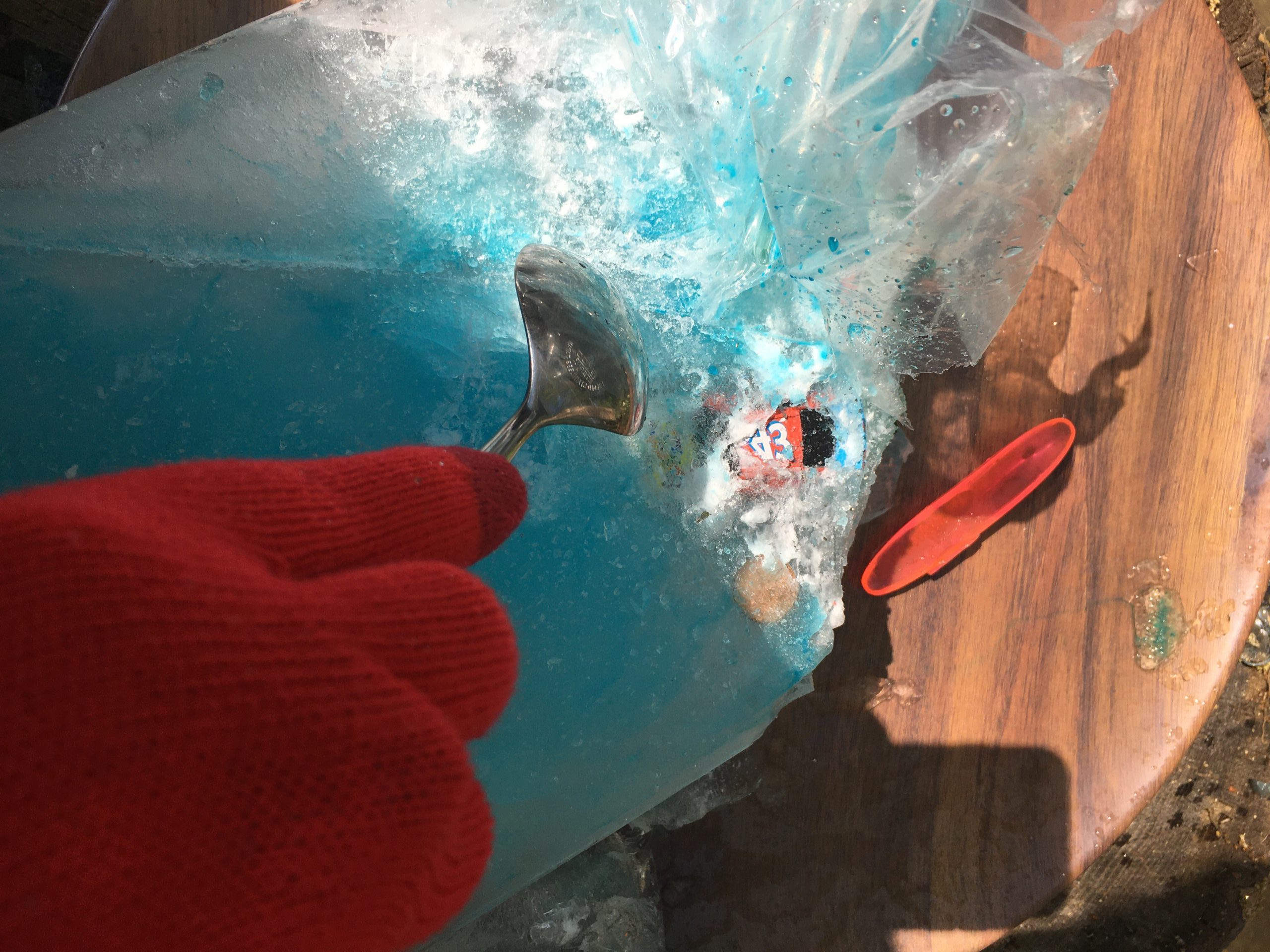
Once frozen, take everything outside if you can, or place it in a tub or larger container. Experiment with chipping away at the ice with different “excavation” tools to reveal hidden objects. 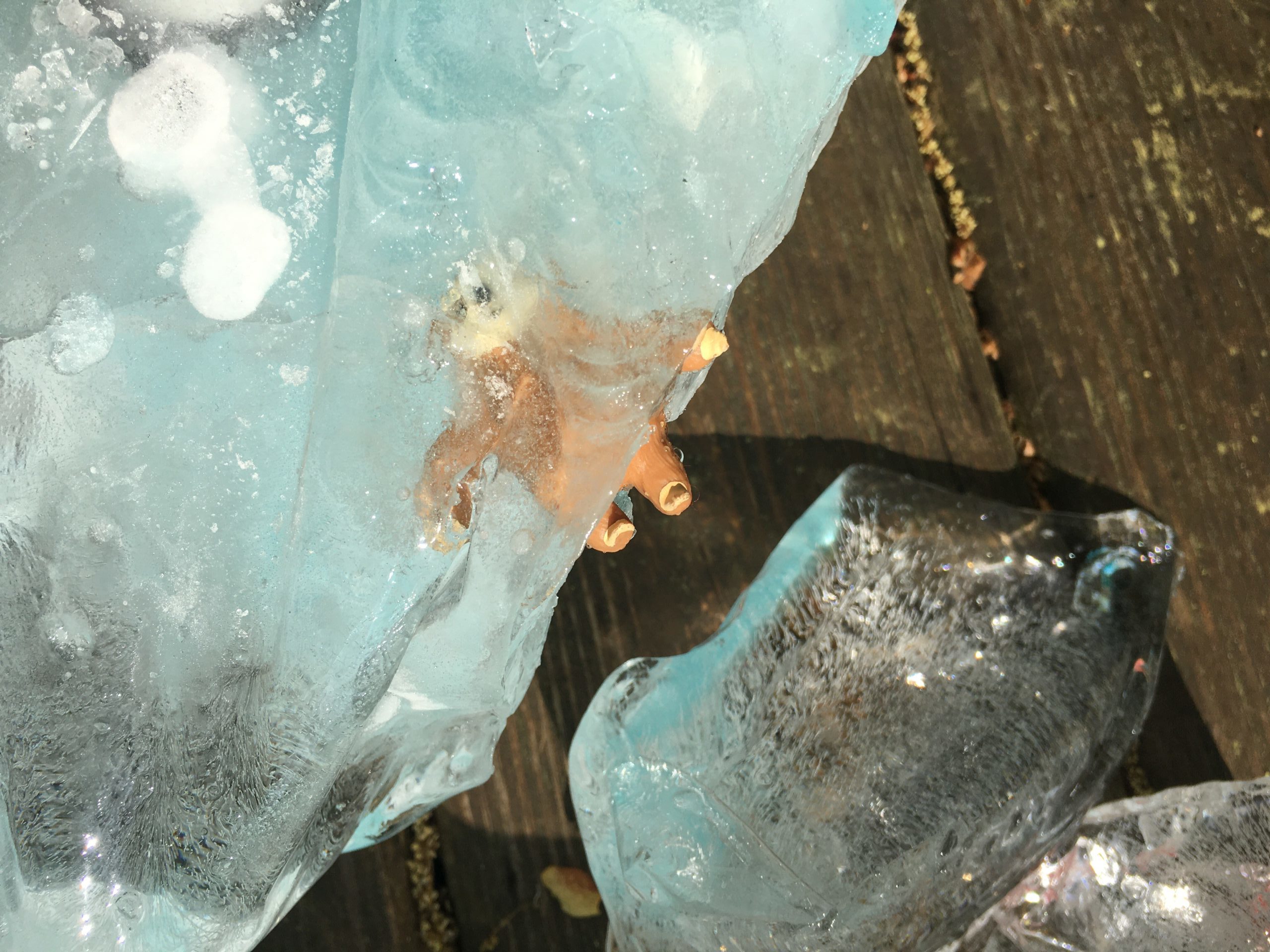
Encourage children to freely experiment and experience the process, and talk about what you see and feel as the melting process occurs.
The Mint Museum From Home is Presented By Chase.
Spring cleaning during shelter-in-place? Here are tips for preserving all your favorite things, from photos to clothes to important documents
Spring cleaning is taking on a whole new meaning while we’re all cooped up and social distancing inside. Whether you’re cleaning out your closets or that pesky home office, here are some tips from the Mint’s Library & Archives team on how to preserve the stuff you actually want to keep.
1. Always opt for cardboard storage bins
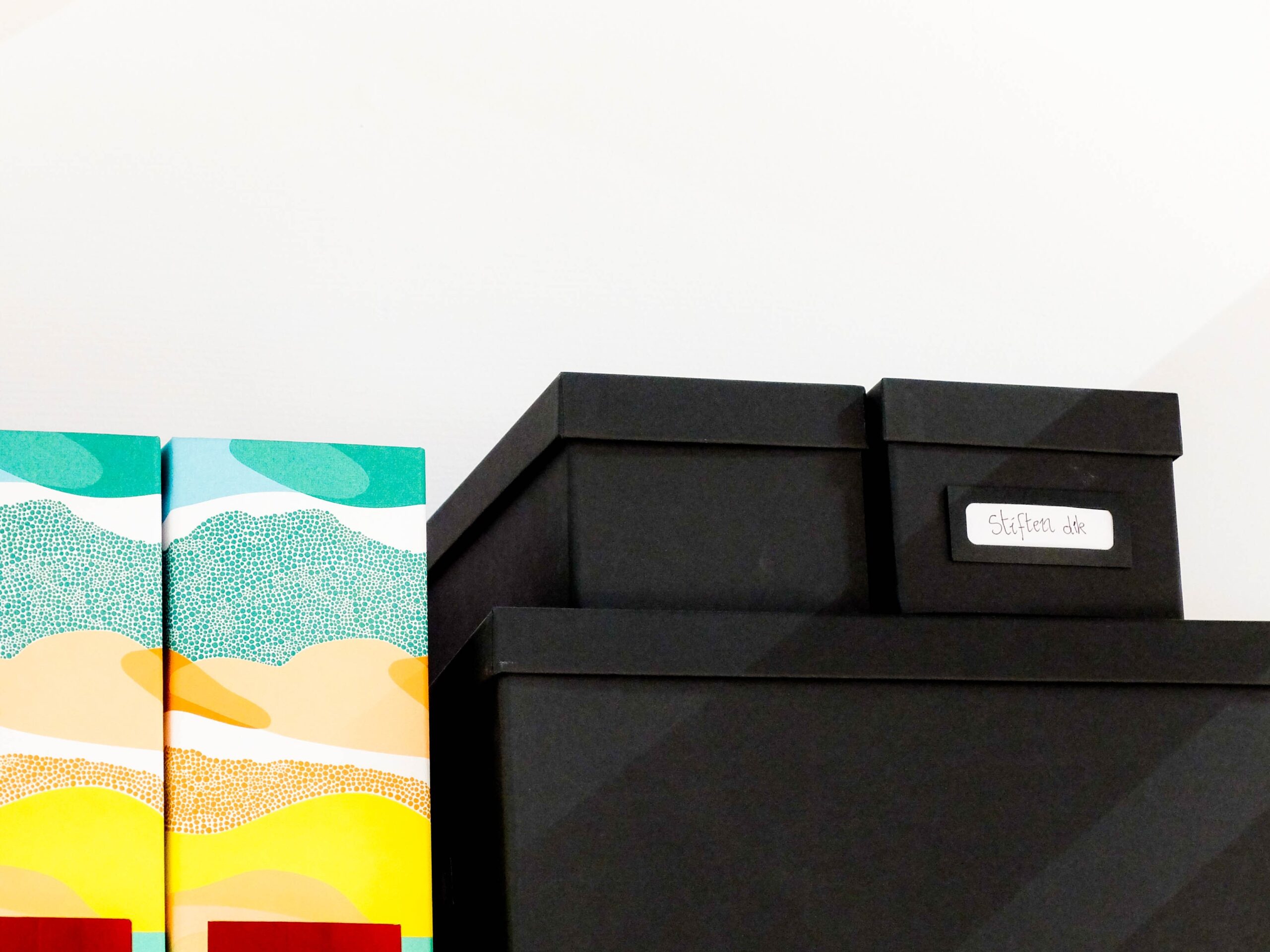
Contrary to what you see on the stocked shelves at the Container Store, cardboard boxes are usually better than plastic bins for storage. Why? Plastic bins can breed mold since they can seal in moisture. (Pro tip: You know those little packets in new shoe boxes? Those absorb moisture. Hang on them to use to throw in plastic storage bins. Just make sure to keep them away from pets and kids!)
2. With cherished papers, skip the paper clips, staples
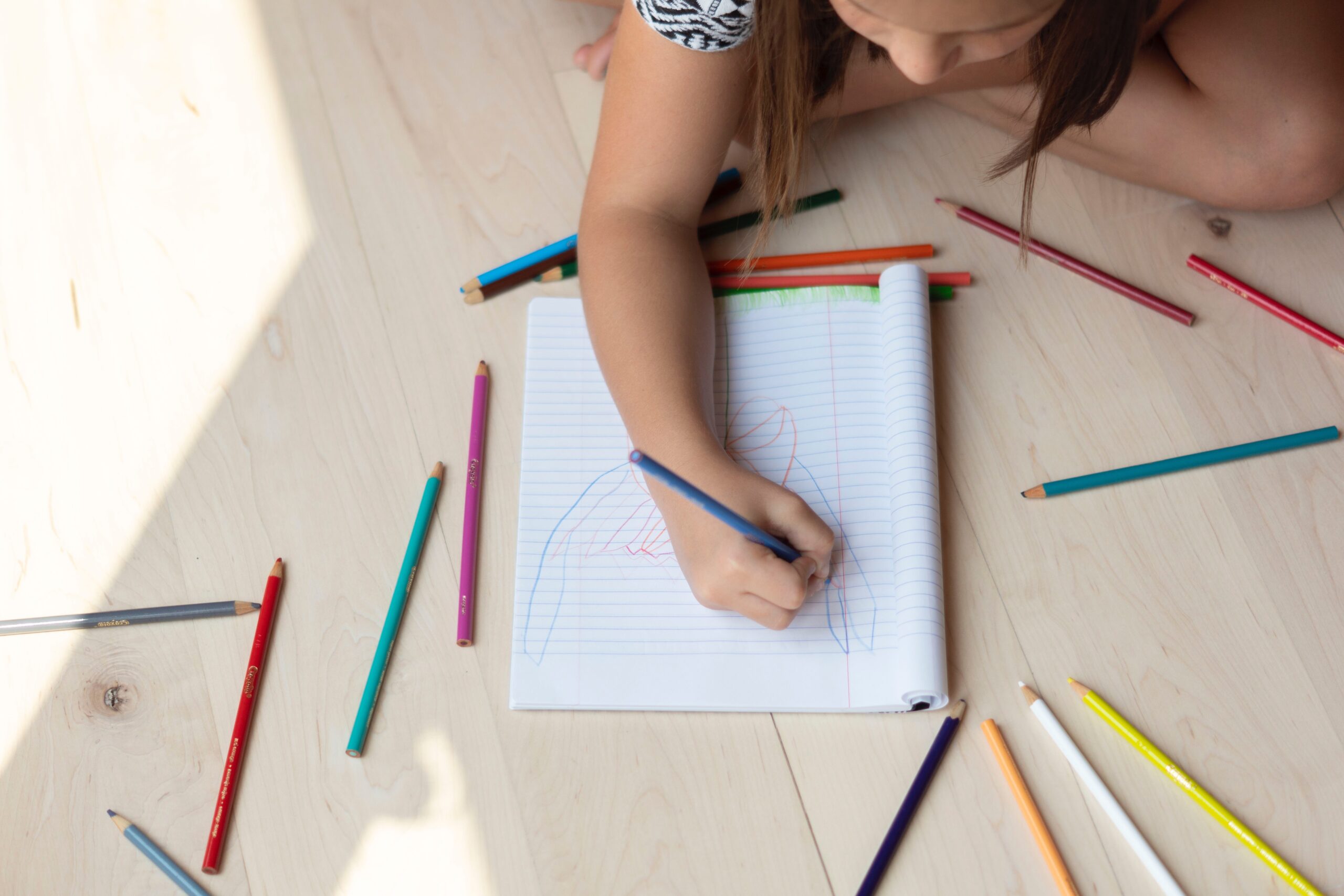
From kids artwork on the fridge to awards and certificates, it can be hard to know how to best store our cherished paper possessions. For starters, paper is best kept flat. You’ll want to make sure you papers are unfolded and laid flat for storage. If possible, storing in acid-free file folders will help with preservation (these can be easily ordered online if you don’t have any on hand). You’ll also want to remove any paper clips or staples, as these can rust and ruin your papers. Finally, if your item is too large for a folder, rolling it up will always be better than folding.
3. Embrace acid-free paper with photo albums and scrapbooks
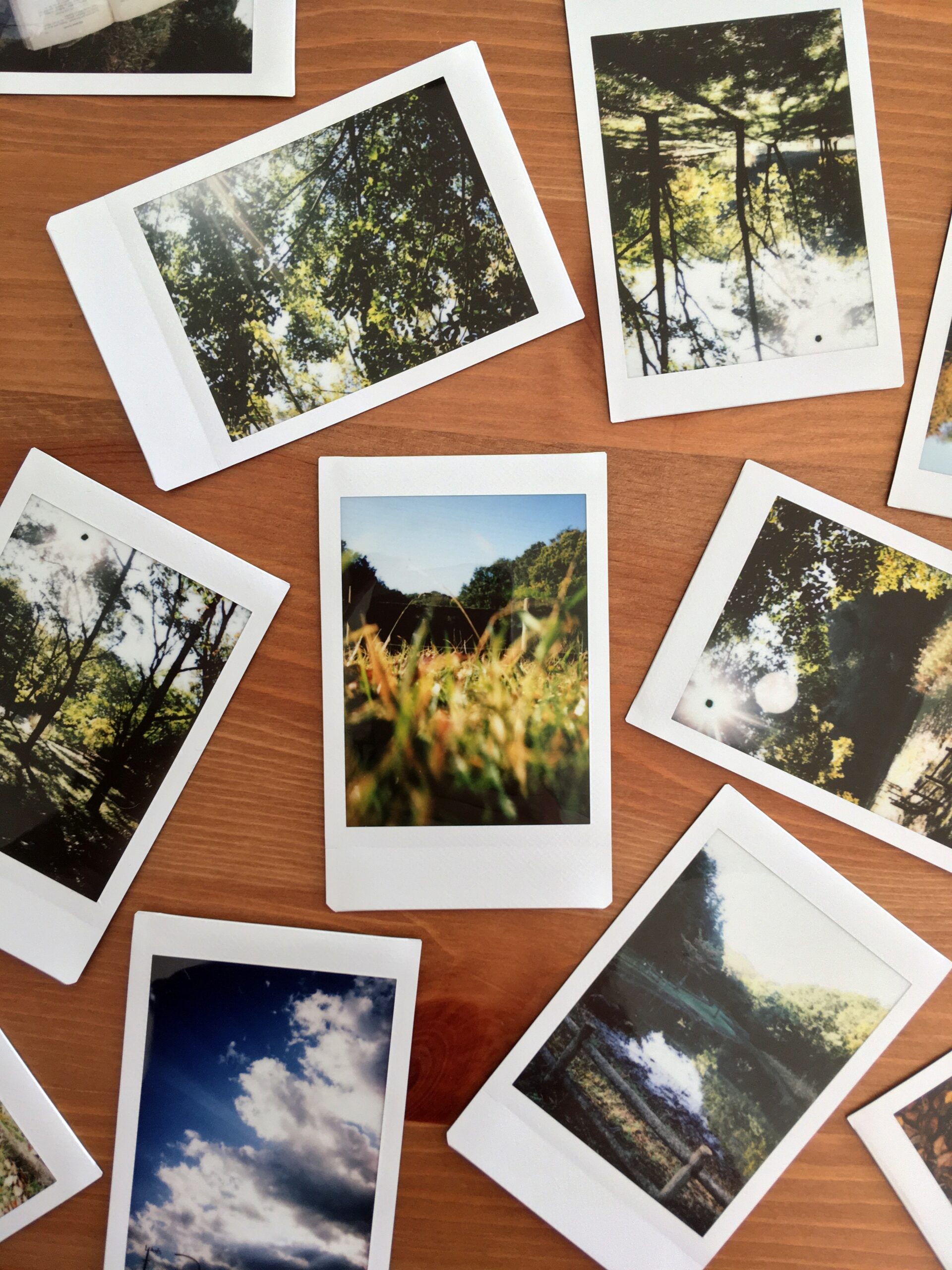
Photo albums and scrapbooks are another tricky item to know how to preserve. The first question here: Is everything glued down? If so, just leave it. The photos can be damaged by trying to remove them. You can add sheets of acid free paper between the pages to help prevent acid from the album pages to migrate and deteriorate your mementos. To save a few bucks, check your printer paper if you have any because it might just be acid free. Put the album in a box for extra protection.
4. Here’s how long you should keep tax and loan docs

Most of us have—but don’t want to admit to—a stack of miscellaneous papers in our homes that seem important and probably shouldn’t be thrown away. But knowing when to actually throw away that tax return or bank statement from three years ago can feel really overwhelming. As a rule of thumb, you should plan to keep tax returns for seven years, loan documents until the loan is paid off, and any one-time documents like social security cards and birth certificates forever, according to Consumer Reports.
5. With clothes and fabric, pack flat and wrap strategically
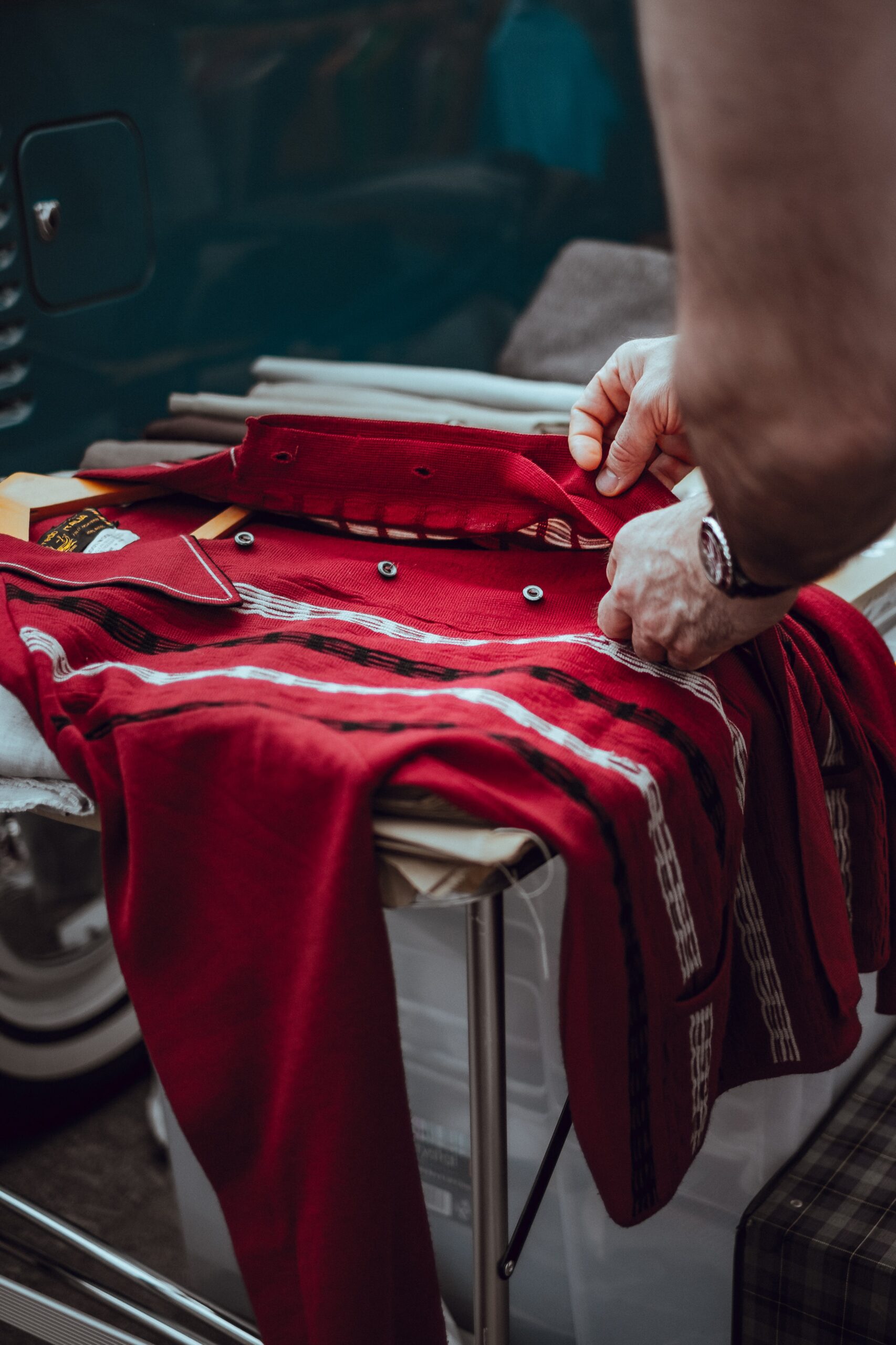
Well, Joan Crawford was right. No wire hangers! Wood, plastic, or padded hangers are a much better choice to preserve your garments. When saving older garments, they should be packed flat and wrapped in acid-free tissue. Quilts and other fabrics should be handled gently and with care, stored in a cool, dry location, and avoid any cleaning or washing if the fabrics are antiques or may have monetary or sentimental value. Read this article from the National Archives for more quilt and fabric preservation tips.
6. Embrace vampire tendencies
Whether you are storing paper, photos, or clothing, keep them out of the sun and away from heat sources to prevent fading and damage. In addition to light sources, keep your valuables away from sources of moisture or water to avoid mold. Keep away from pipes as well, as they can burst and water damage your items. Garages and basements are not the best places for storage; try keeping cherished items stored inside the house where there is more temperature control instead.
We on the Library & Archives team at the Mint know a thing or two about preservation, but this is just a primer. There are loads of online resources for every type of item you can think of. One of our favorite trusted sources is the North Carolina Preservation Consortium; the Mint is a member!
Let your mind wander with watercolors
In this brief Museum from Home video, Mint staffer Leslie Strauss leads viewers through a simple painting and drawing activity, good for all ages. Don’t have paints at home? Grab some magic markers instead and get ready to be creative.
Supplies
- Paper
- Water cup and paint brush
- Watercolor paints or washable magic markers
- Sharpies, colored pencils, or any drawing tools
The Mint Museum From Home is Presented By Chase.
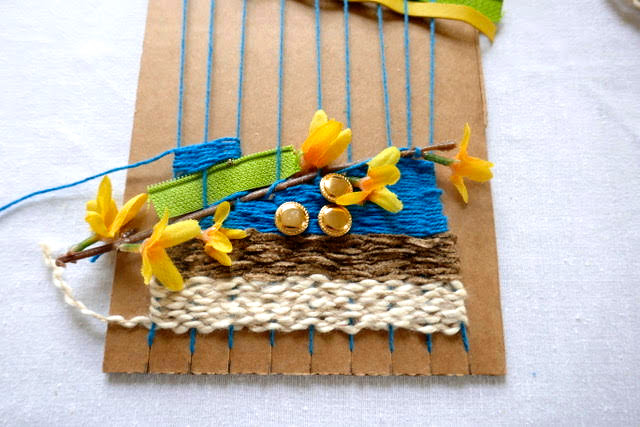 Get your weave on with items you have at home
Get your weave on with items you have at home
All you need is a piece of cardboard and a few basic materials to create your own portable loom at home. This weaving project is inspired by John Garrett’s piece, Tales Told on a Sunday Afternoon Between Los Cordovas and the Pilar Landslide, in which he incorporates found objects from a hike he took in his home state of New Mexico.
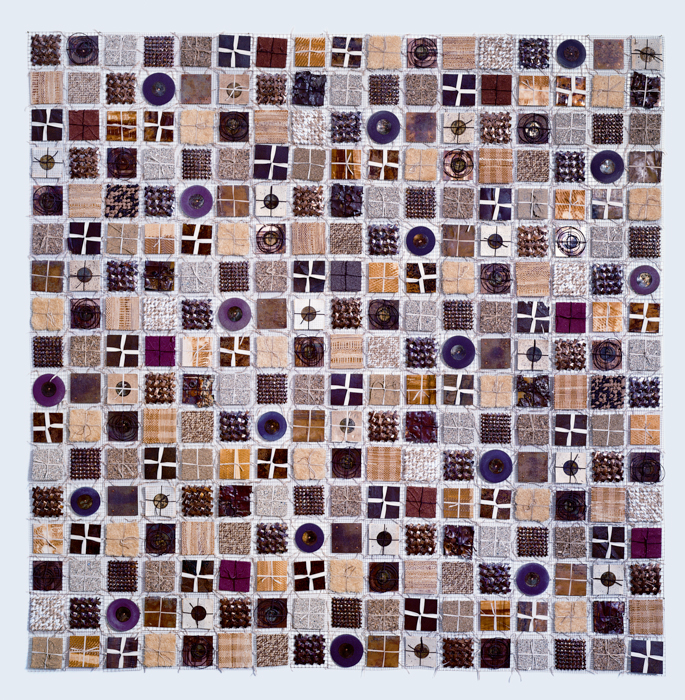
John Garrett (American, 1950– ). Tales Told on a Sunday Afternoon Between Los Cordovas and the Pilar Landslide, 1997, fiber, metal, found objects. Museum Purchase: Funds provided by Fred and Emily Gurtman. 1997.109. © 1997 John Garrett
Supplies
- Cardboard
- Ruler
- Pencil
- Scissors
- Large-eye blunt needle (try finger weaving if you don’t have a needle)
When weaving with yarn, cut pieces to 10-12 inches. This gives you a reasonable length to work with while avoiding it turning into a tangled mess. Don’t pull the yarn too tight, as this can cause your whole piece to become warped.
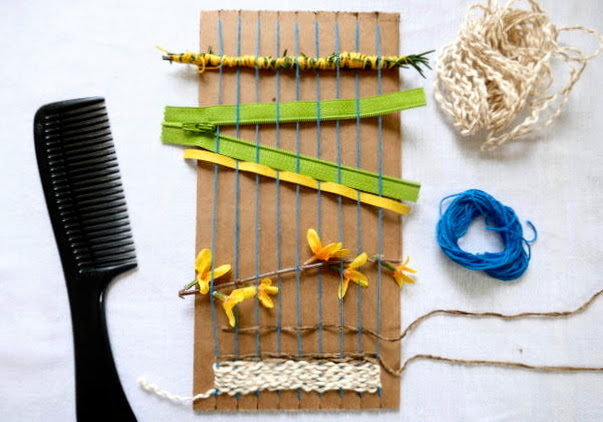 When you reach the end of your working yarn, tie a knot around the final strand of warp and either use a needle to tuck it into your piece, or just trim the tail off. To begin a new row, simply cut a new piece of yarn and begin again, leaving a 6 inch tail. If you have one, use a comb or a fork to even out rows.
When you reach the end of your working yarn, tie a knot around the final strand of warp and either use a needle to tuck it into your piece, or just trim the tail off. To begin a new row, simply cut a new piece of yarn and begin again, leaving a 6 inch tail. If you have one, use a comb or a fork to even out rows.
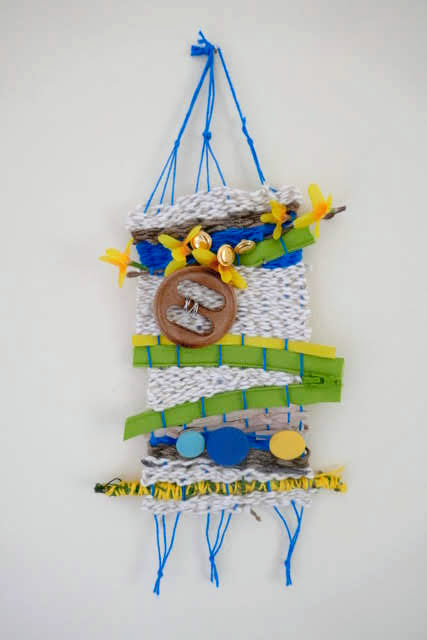
The Mint Museum From Home is Presented By Chase.
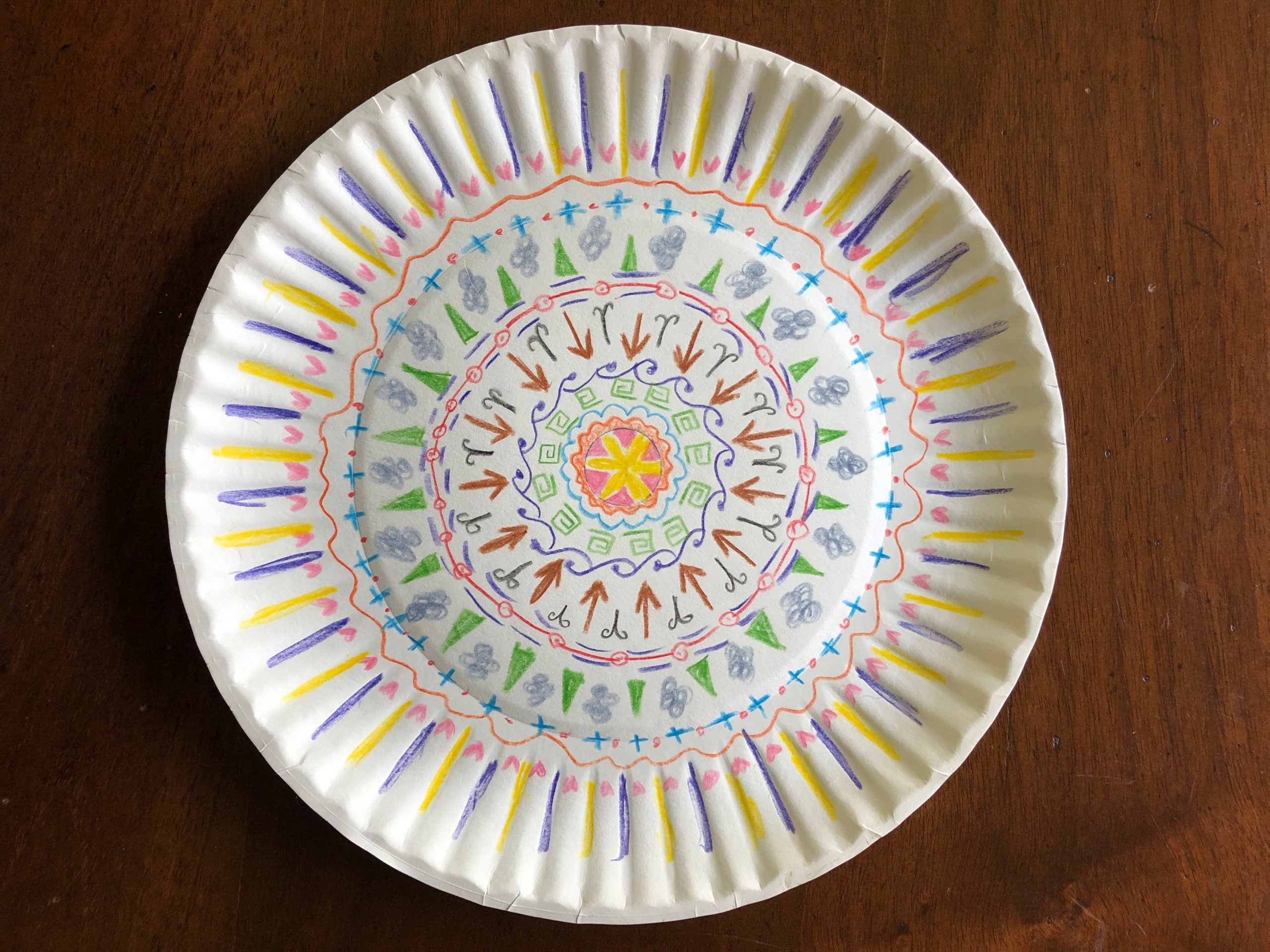 De-stress making a mandala
De-stress making a mandala
A mandala is a circular geometric configuration of symbols. With roots in Southeast Asian spiritual tradition, many today use these as a form of focused concentration, meditation, and relaxation. Art making also helps to identify and express emotion. This exercise uses symbols and colors to convey feelings.
Supplies
-
Sheet of paper or paper plate
-
Colored pencils, markers, or crayons
-
A small round object such as a penny
-
Ruler or measuring tape (or you can just eyeball it)
Start by thinking of symbols that you like or that have meaning in your life. You can sketch some out on a separate piece of paper.
Next, think of a list of feelings and write them down. Decide which color best matches the feeling and make a mark for yourself so that you can look back at it as you create your mandala.
The Mint Museum From Home is Presented By Chase.
The inimitable Anne Lemanski talks life in the mountains, ‘gin and tonic season,’ and her epic life-size tiger on a ball
Multidisciplinary artist Anne Lemanski, based in the Blue Ridge Mountains of North Carolina, creates everything from two-dimensional collage to three-dimensional sculptures. An artist of the natural world, she focuses on the complex, sometimes tense relationship between humans and animals, and her work is part of the Mint’s permanent collection. Here, she shares her favorite creation to date, how her mountain life influences her work, and the way Mother Nature always “will take care of business.”
Studio location: Blue Ridge Mountains, NC
Describe the artwork you create and medium your use
I make sculpture that is constructed by hand stitching a skin, often paper, unto a copper wire framework. I also transform small hand-cut collages into large format digital prints.
Who are artists that inspire you and your work?
Joseph Cornell is always a go-to when I need a pick me up. Contemporary peers whose work I greatly admire include Adonna Khare, Josie Morway, Walton Ford, Hilary Pecis, Alex Dodge. I also find kindred spirit in quilts and folk art.
What is your favorite piece or artwork that you created and why?
To date, it is Tigris T-1, a life size tiger balancing on a ball. It was an engineering feat. I wanted it to be freestanding, and it is. I also love the color and pattern of the skin, which consists of a print that I created using straws. It has many cultural references without being specific.
How does your environment influence your art?
I live and work in the Blue Ridge Mountains. I see something in nature on almost a daily basis that is beautiful, surprising, or even tragic. I am hyper-tuned to my immediate surroundings. There is really no separation between the way I live my life and my artwork.
Tell us about your morning routine right now.
My morning routine is the same: coffee and the New York Times.
Are you finding new inspiration for your art during this shift of perspective in the world?
No. I have been raising alarm via my artwork regarding environmental issues and the exploitation of resources and man’s impact on the earth for years. Eventually, Mother Nature will take care of business.
Tell us about your afternoon. Are you working from home, going to your studio?
My studio is right next to my house, so my routine hasn’t really changed. I’m finding it difficult to concentrate.
What positive perspective changes in society would you like to see come from the pandemic?
I’m a bit of a pessimist, so I’ll keep my thoughts to myself for now.
How are you winding down your day? Have any recommendations for stress relievers to settle after another day done?
In my house, gin and tonic season has officially started.
What are you cooking? What’s your comfort food of choice?
My cooking habits haven’t changed. Last night I made a delightful asparagus and mushroom risotto. We make everything from scratch, and that won’t change. My favorite comfort food is fettuccine alfredo with homemade pasta.
What are you currently reading?
The news. I listen to audiobooks when I work, but I am not currently listening to any.
These documentaries will help you get your art fix from home
Craft in America
The Peabody Award-winning series on PBS explores America’s creative spirit through the language and traditions of the handmade. The series takes viewers on a journey to the artists, origins and techniques of American craft. Two artists in our collection, Diego Romero and Cristina Cordova, are featured on the episode “Identity.”
Where it’s streaming: PBS. https://www.craftinamerica.org/episodesExit Through The Gift Shop
Talk a stroll through the ever-evolving world of street art. This documentary follows Thierry Guetta, a French native living in Los Angeles as he explores his own work, and the work of famous street artists like Banksy and Shepard Fairey (whose work was featured in the Mint’s Under Construction exhibition). Street art also plays a huge role in our special exhibition Classic Black, which combines the work of local mural artist Owl with the basalt sculptures of Josiah Wedgwood.
Where it’s streaming: Amazon Prime, Google Play and digital rental services.Abstract: The Art of Design
A look beyond blueprints and computers into the art and science of design, showcasing great designers from every discipline whose work shapes our world.
Where it’s streaming: Netflix. Out of the Fire: The Art and Science of Ceramics
Join Dr. Alexis G. Clare, professor of glass science at the New York State College, Alfred University, on a journey of ceramics from past to present.
Where it’s streaming: PBS.
5 podcasts that make us excited about art, even if we can’t see it
ArtCrush
Catch up on both seasons of the Mint’s very own podcast. Hear interviews with artists from our collections and special exhibitions, hot takes from Mint curators, and even our very own President & CEO, Todd Herman.
Listen here, or wherever you get your podcasts.
Museum Confidential
Love any and all museums? Museum Confidential gives you a behind-the-scenes look at the inner workings of your favorite museums. From an interview with Killer Mike, High Museum Board Member, to chatting about visitor data with Colleen Dilenschneider, this one goes out to all the proud museum nerds out there. Listen on NPR
Talk Art
Hosted by actor Russell Tovey and gallerist Robert Diament, Talk Art is a podcast dedicated to the world of art featuring exclusive interviews with leading artists, curators & gallerists. Listen here, or wherever you get your podcasts.
ArtCurious
True Crime, rivals, and shock value? No, this isn’t the next Netflix docu-series. It’s ArtCurious, an art history podcast hosted by Jennifer Dasal that is sure to delight and awe like no school art history class ever could. Listen on the ArtCurious website or via Apple podcasts
Art Movements
Brought to you by Hyperallergic, an art forum and website created in 2009, Art Movements podcast brings you all the up-to-date happenings from across the art world. Hosted by Hrag Vartanian, co-founder and editor-in-chief of Hyperallergic, Art Movements talks about everything from what artists need to know about taxes, to art history, to arts pop culture and everything in between. Listen on the Hyperallergic website.
14 more books to delve into while staying in during COVID-19
ARTFUL READS
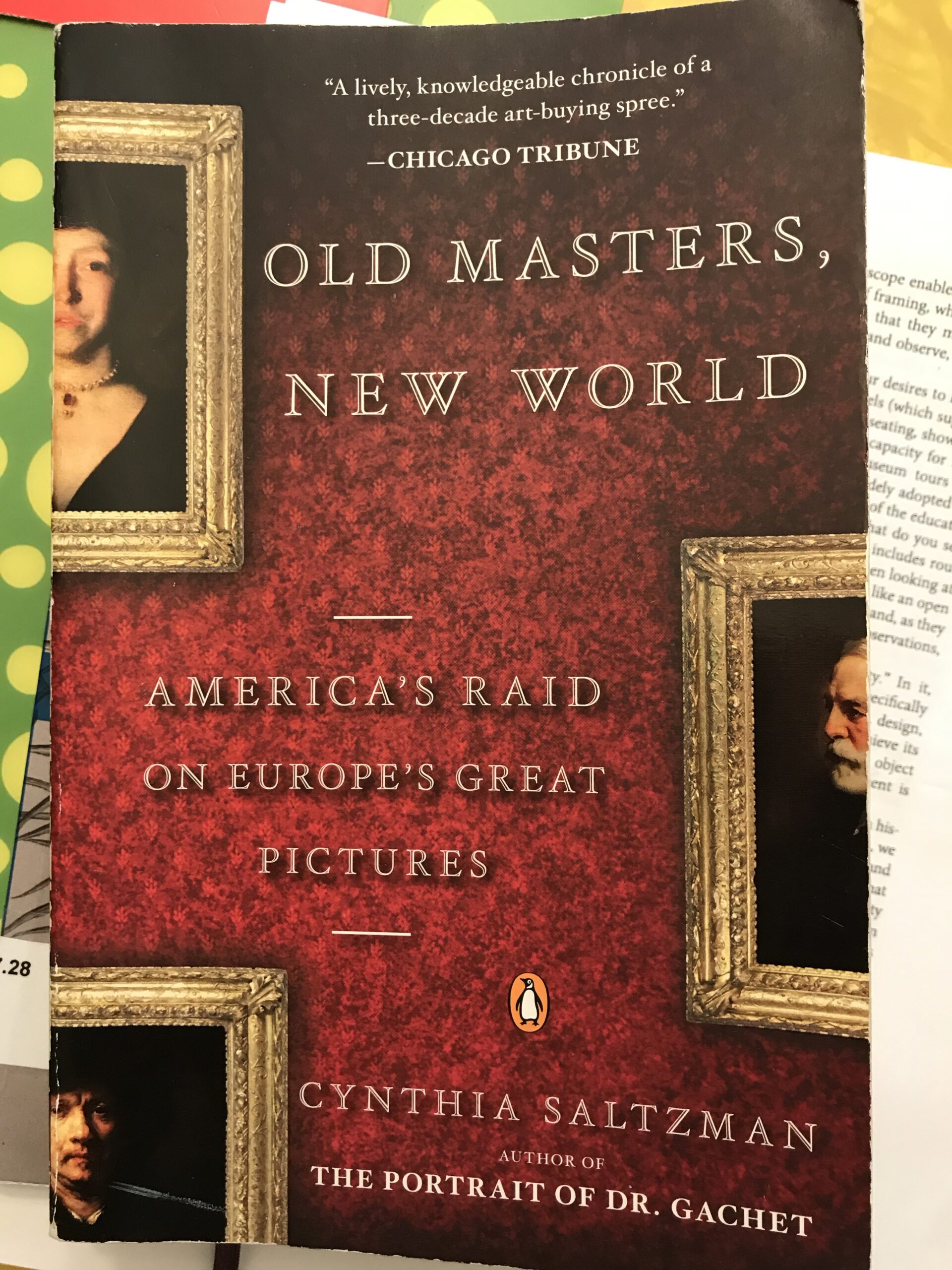 Old Masters, New World: America’s Raid on Europe’s Great Pictures by Cynthia Saltzman
Old Masters, New World: America’s Raid on Europe’s Great Pictures by Cynthia Saltzman
“This book answers the question: How did big American art museums acquire so much European art? Wealthy Gilded Age American entrepreneurs jostled with one another to collect and bring known works of art across the Atlantic — Rembrandts, Raphaels, etc.
—Joel Smeltzer, Head of School and Gallery Programs
The Popes of Avignon: A Century in Exile by Edwin Mullins
As an Italian Renaissance scholar, I have usually looked at this period in the history of the Catholic Church from the Italian perspective and not the French. Well written and a good read.
—Todd Herman, President and CEO
NOVELS
The Hobbit by J.R.R. Tolkien
I’m spending lots of time reading to my kids these days. This week we started reading “The Hobbit” by J.R.R. Tolkien to my eldest daughter. She may be a bit young for some of the material, but our family has been enjoying reading a “big girl book” nightly. It provides us all a chance to escape, and have an adventure without leaving our house — something that is becoming more challenging everyday. This copy actually belonged to my mother when she was a child, and she read it to me when I was young, so it has been well loved.
—Rebecca O’Malley, Exhibition Coordinator
The Hundred Story Home by Kathy Izard
I saw Kathy Izard speak and was so inspired by her story that I bought her book. I started reading it this week and was reminded of how helping others changes us. Her work with homelessness in the Charlotte area led to the city-wide effort to build Moore Place. This book has reminded me of the importance of listening to your inner voice. It’s helpful for us, especially now, to find ways to practice compassion – even if we have to do it with a mask on.
—Maggie Burgan, Public Programs Coordinator
Introducing the Honourable Phryne Fisher by Kerry Greenwood
The adventures of a sassy flapper in 1920s Australia who just happens to be a private detective. She’s daring, independent, and smarter than all the men around her. What’s not to like?
—Ellen Show, Archivist
Oryx and Crake by Margaret Atwood
Oryx and Crake is from the same author as A Handmaid’s Tale, and is centered around a man living in the post-apocalyptic ruins of a world he helped create, after humanity is near-entirely killed off by a bio-engineered plague. It’s the first book in the MaddAddam trilogy, and was a very good read.
—Benjamin Elrod, Graphic Designer
NONFICTION
A Little History of The World by E.H. Gombrich
I keep this book on my nightstand. It was recommended to me by one of my favorite art history professors. It’s not filled with names and dates, but is a collection of 40 short chapters about human experience and achievement — a fairy tale-like history of the world. Perfect for young readers and fun to read aloud to smaller children.
—Maggie Burgan, Public Programs Coordinator
Poetics of Space by Gaston Bachelard
This enchanting book uses a mouthwatering metaphor to unlock the magic in interior spaces. The chapters delve into the hidden life of the house, rooms, nests, shells, attics and cellars. Adult readers will enjoy sharing excerpts and helpIng their family to find and savor familiar spaces. Miniatures and shells are some of my favorite chapters. (Free download available.)
—Cynthia Moreno, Director of Learning and Engagement
On Looking by Alexandria Horowitz
A walker’s guide to the art of observation. I am enjoying it because Horowitz shows is how much more there is to see if we only take the time to look.
—Diane Lowry, Guest Services Associate
My 25 Years in Provence-Reflections of Then and Now by Peter Mayle
Easy, fun read that breaks up the more academic books. Wonderfully written.
—Todd Herman, President & CEO
Life on Mars by Tracy K. Smith
I always try to have one book of poetry going for when I need an escape from reality, but I only have five minutes to make the trip. Tracy K. Smith’s books have been in rotation for a while, but her Life on Mars collection is a favorite because it not only plays off her love for David Bowie, but the title is my favorite Bowie song. Also, rereading it, I’m surprised by how much it captures the hope in the bleak unpredictability of every day. Take the end of her poem, Sci-Fi:
. . . Weightless, unhinged,
Eons from even our own moon, we’ll drift
In the haze of space, which will be, once
And for all, scrutable and safe.
—Jen S. Edwards, PhD, Chief Curator and Curator or Contemporary Arts
Powership: Transform Any Situation, Close Any Deal, and Achieve Any Outcome by Daymond John of ABC’s Shark Tank
I have followed Daymond’s career and wanted to hear his advice on taking control of your destiny. So far it’s been lots of good tips and advice on how to make connections. It’s good listening while we work from home.
—Thesha Woodley, Associate Director of Visitor Experience and Membership
Just for Fun
The Dangerous Book for Dogs by Rex & Sparky
We have four legged “kids,” so just for fun we are reading The Dangerous Book for Dogs by Rex & Sparky.
—Lori Rogers, Visitor Experience and Membership Coordinator
Magazines
I’ve not really been able to concentrate on a book, but I am loving magazines for a bit of respite from the surreal week we’ve had. The colorful and inspiring pages of House Beautiful, Artist magazine and Traveler from AAA have been a feast to the eye.
—Angela Lubincky, Guest Services Associate
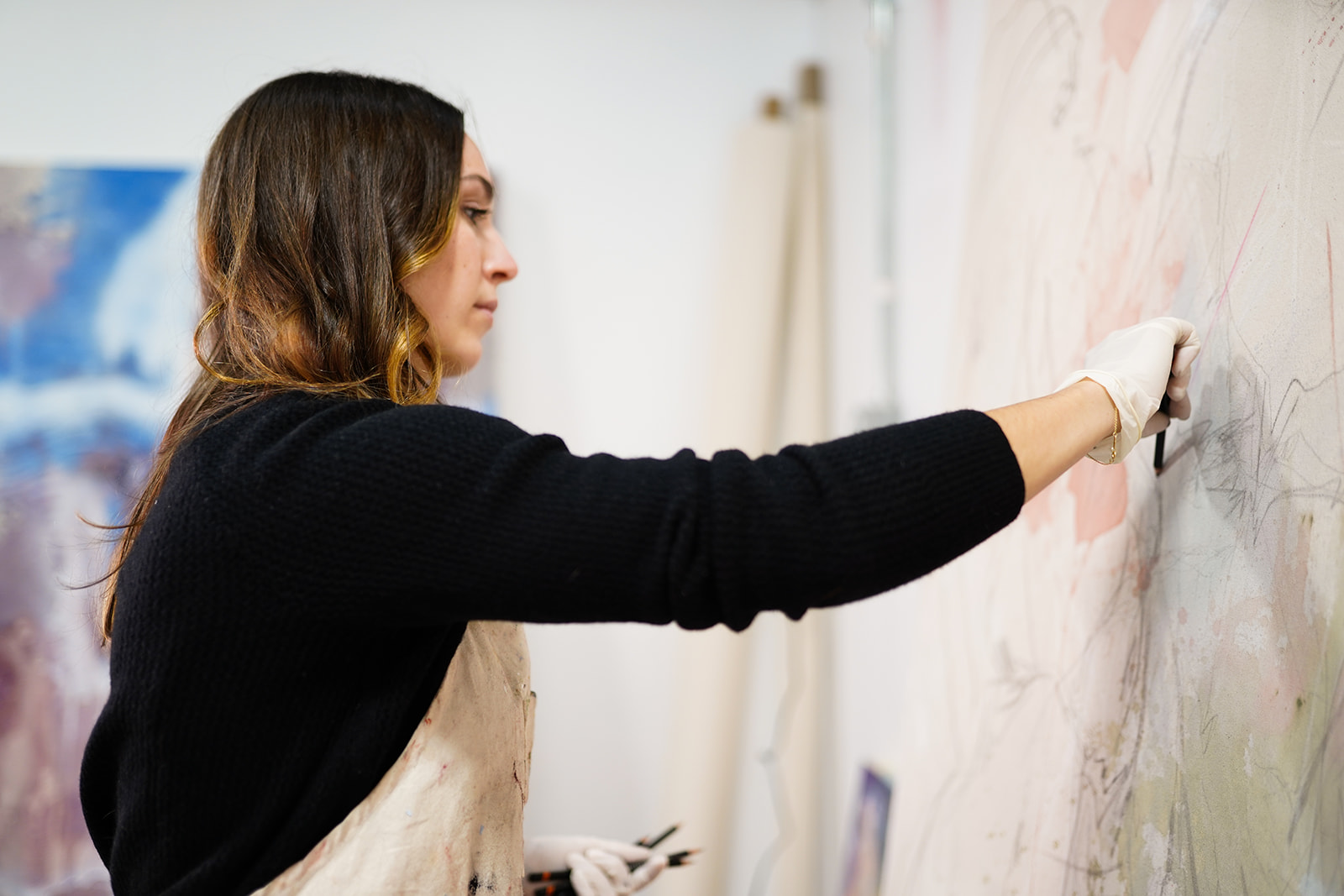
Artist Katherine Boxall on virtual connections, mental blocks and 6 AM puppy cuddles in COVID-19 crisis
Katherine Boxall is the most recent artist to have an installation hanging at the Mint Museum Uptown as part of Constellation CLT. She’s also the first of many artists that we are asking about how the coronavirus — and shift in the world — is affecting their day-to-day lives, as well as the art they create.
Studio location: West Charlotte
Describe the artwork you create and medium your use.
I paint and draw using graphite, pastel, acrylic, oil, and spray paint. Although mostly abstract, I do work representationally as well.
What artists inspire you and your work?
I am inspired by lots of artists, dead and alive. They are not restricted to the visual landscape, writers and musicians are huge sources for me too. Right now I am thinking a lot about my MFA mentors from the Bay Area such as Alicia McCarthy, Brett Reichman, Maria Elena Gonzalez, Jeremy Morgan, Danielle Lawrence, Terry Powers, Felicita Norris … just to name a few.
What is your favorite piece or artwork that you created and why?
I don’t have a favorite piece(s). Everything that I make comes out of a certain time and context. Each work has it’s own stories and reasons, so it isn’t obvious to me how I would judge them on the same playing field.
How does your environment influence your art?
Environment influences your mind, body, and being all the time. I’ve heard people say you’re only as smart as the five people you surround yourself with. I don’t know if that’s true, but surrounding myself with other creative and inspiring people has helped me reach my highest potential in the past. It’s obviously very challenging to do that right now, so I am trying to connect virtually as much as I can with the people I love and keep my environment as uplifting as I can. Being a painter is about being aware of your ways of seeing, then learning to adapt and use them. Even though my environment is physically the same (in my studio) the psychological environment is different. So I’m working to find a way to level my emotions towards to the crisis and transform them into a positive output.
Tell us about your new morning routine, including when you start your day and how you spend the early hours.
I usually start my day with coffee and petting my golden retriever puppy Sophie. The pandemic hasn’t dawned on her so she continues to wake me up at the usual time (6am). Now that I don’t leave the house to exercise, we’ve been going on longer walks instead and calling family to check-in.[cs_divider align=”center”]
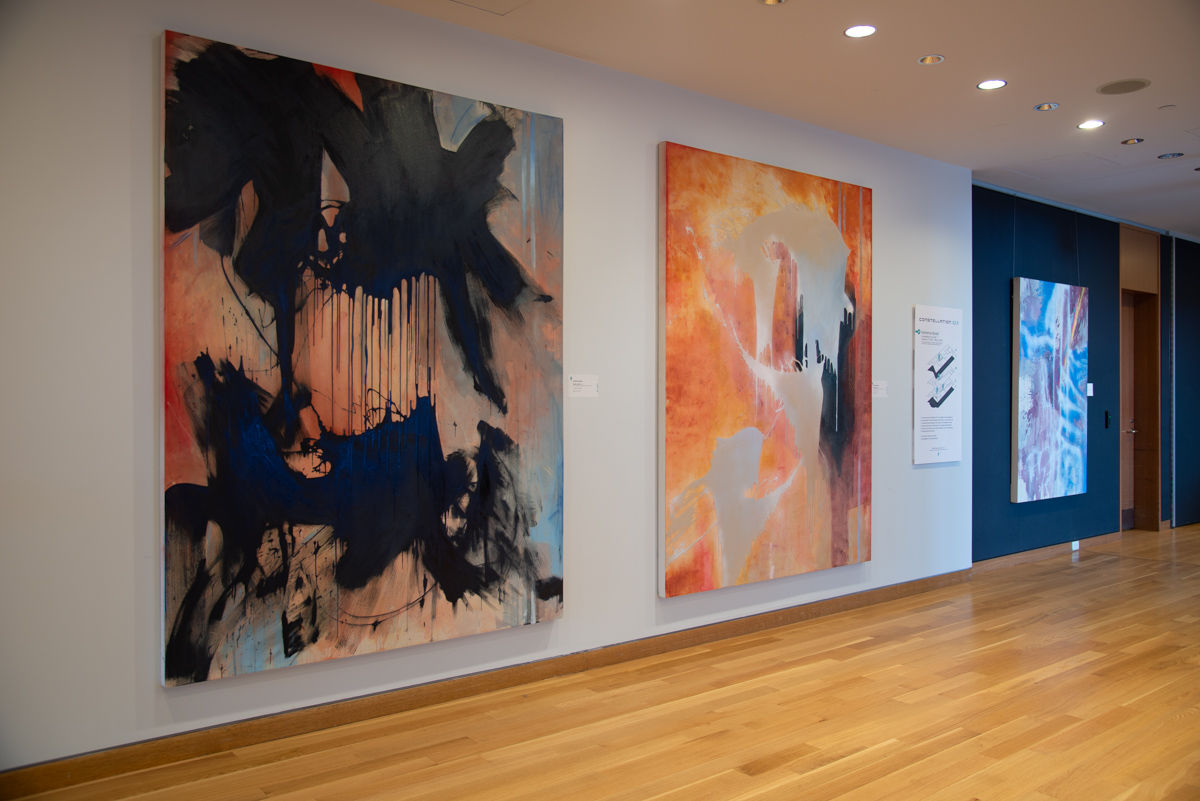
(from left to right)
Katherine Boxall. Black Licorice, 2020, acrylic, pastel, spray paint, and oil on canvas. Courtesy of the artist
Katherine Boxall. Maple Candy, 2019, acrylic, oil, spray paint, and pastel on canvas. Courtesy of the artist
Katherine Boxall. Tread, 2020, acrylic, pastel, spray paint, and oil on canvas. Courtesy of the artist
[cs_divider align=”center”]Are you finding new inspiration for your art during this shift of perspective in the world?
I feel grateful that my work is already self-directed and motivated, but the toll of this crisis is making it challenging to feel ‘inspired’. Right now, I am working to break down those mental blocks and use the opportunity to push myself and my work.
Tell us about your afternoon. Are you working from home or going to your studio?
Both. I am working from home for Jerald Melberg Gallery as much as I can and then spending the rest of my time in the studio. I am the only tenant in the warehouse, so my studio is literally the ultimate place to work while social distancing. I’ve also set up a space at home for small drawings and watercolors for a more low key/meditative creative vibe. I had a really busy winter with exhibitions and projects, so at the moment I am enjoying slowing own a bit.
How are you winding down your day? Have any recommendations for stress relievers to settle after another day done?
Lots of cuddling with the dog and spending time with my partner at home. I’ve added some exercise later in the day to fuel myself with endorphins and a few extra skincare steps because I no longer have any excuses. I guess my #1 recommendation (if you can) would be to eat chocolate while wearing a bathrobe on the couch watching your favorite show. In my experience, few things in life feel as luxurious. I’d also treat yourself to reading fiction and steeping some tea, anything to get a good night’s sleep.
What are you cooking? What’s your comfort food of choice?
I’m always cooking and we do it all. Breakfast has expanded beyond the smoothie to eggs, banana breads, muffins, etc. For lunch we have the leftovers from the previous night’s dinner which is usually salmon, cod, steak, chicken, homemade pizza, it just goes on. Cooking has always been a creative outlet for me so if anything the pandemic has just ramped that up. Watching my Instagram story will usually leave you hungry.
What are you currently reading?
The New York Times (it’s not for the weak)
What is your favorite music choice?
All kinds of things as the day goes, but Medasin, Future, and Lane 8 seem to be dominating my current playlists.
What is your favorite podcast(s)?
The Daily, The Journal, How I Made This
What positive perspective changes in society would you like to see come from the pandemic?
I know for myself that being a busy body can sometimes act as a distraction from the things I really need to work on or slow down to appreciate. Socially, I hope this will put in perspective our real values and help us prioritize them in more human way. Systematically, I am hopeful to see protection for those who need it most. Only a fraction of us have the luxury to work from home or take time off (and even fewer for long periods), so I hope that our government and community really pulls together to support one another.
Look inside Charlotte-based artist Katherine Boxall’s west Charlotte studio. Boxall was the Mint’s first Constellation CLT artist of 2020, and in partnership with the Young Affiliates of the Mint, the Mint’s Chief Curator and Curator of Contemporary Art Jen Sudul Edwards, PhD, chats with Boxall to give us a glimpse into the artist’s creative process, her striking works of art, and the studio where it all comes together.
Make your own marble prints with shaving cream
This fun (and messy) project for all ages is inspired by the paintings of Harlem Renaissance painter, Beauford Delaney. Your final creation can be displayed as a print, folded into a card, or used as the background for a collage or drawing. Share what you make by tagging us on Instagram @themintmuseum.
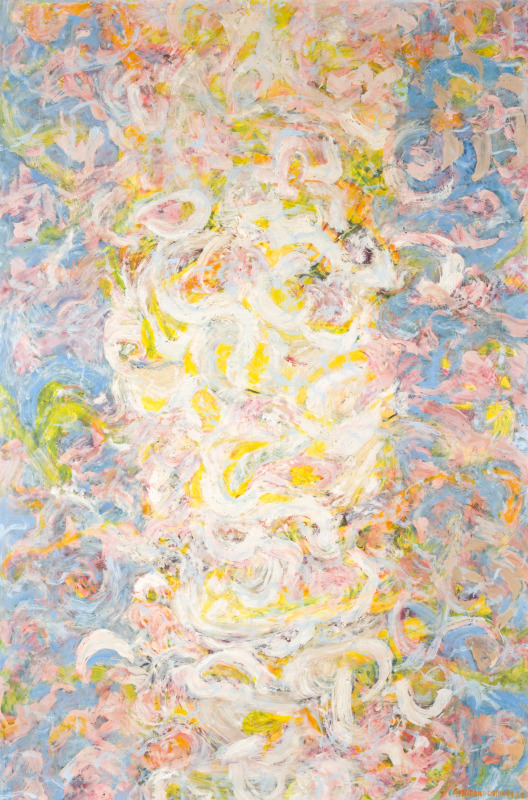
Inspired by Beauford Delaney (American, 1901–79). Untitled, 1959, oil on canvas. Museum Purchase: The Katherine and Thomas Belk Acquisition Fund. 2017.7
SUPPLIES
- Baking sheet or tray (large enough to fit your paper and deep enough to hold shaving cream)
- White shaving cream
- Paint or food coloring
- Stick or toothpick (end of paintbrush works too)
- Plastic ruler or other flat edge that can get wet
- Paper
- Paper towels or cleaning cloth
- Open space to lay out your prints
STEPS
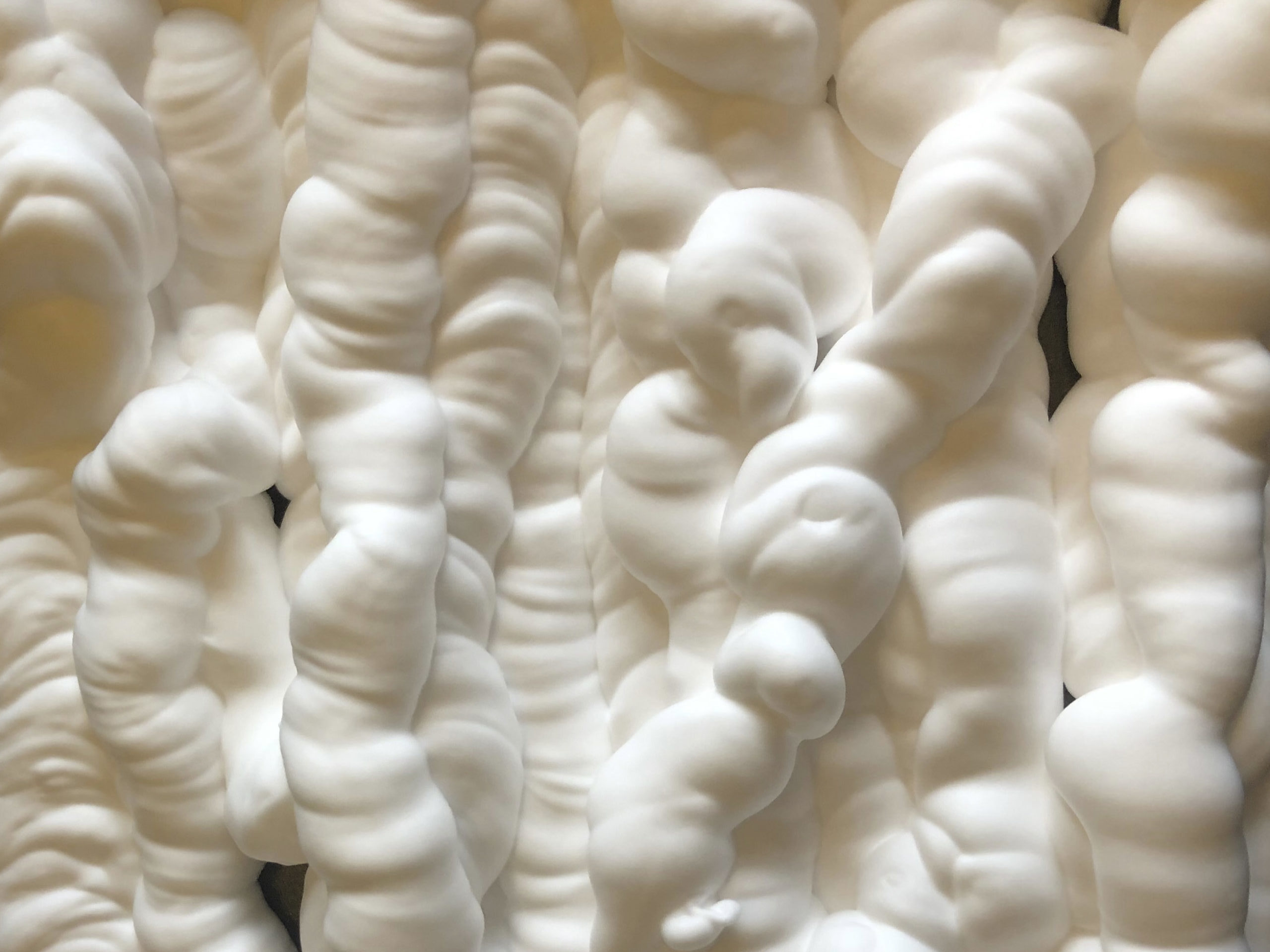 1. Cover bottom of sheet pan with shaving cream.
1. Cover bottom of sheet pan with shaving cream.
The Mint Museum From Home is Presented By Chase.
12 Books Mint Staffers Are Reading During These Crazy COVID-19 Times
ARTFUL READS
Of Cats and Men: Profiles of History’s Great Cat-Loving Artists, Writers, Thinkers, and Statesmen by Sam Kalda
My niece sent me this book, assuming I would enjoy it because No. 1, I’m a man, and No. 2, I have six cats. She was right! This small, but completely delightful book profiles 30 famous and talented men — Mark Twain, Romare Bearden, Freddie Mercury, and Sir Isaac Newton, to name a few — and their love for their cats. Sam Kalda’s breezy, anecdote-laden write-ups, and wonderful color illustrations make this the purr-fect publication to pick up this reader’s mood every time he opens it.
—Brian Gallagher, Curator of Decorative Arts
Vincent Van Gogh: Letters from Provence by Martin Bailey
An important moment in the history of this region of France. I always think it’s very important to hear the firsthand accounts from historical figures whenever possible. You get to know them better and often gain insights into their daily lives that never make it into biographies.
—Todd A Herman, PhD, President and CEO
Ninth Street Women: Lee Krasner, Elaine de Kooning, Grace Hartigan, Joan Mitchell, and Helen Frankenthaler: Five Painters and the Movement That Changed Modern Art by Mary Gabriel
I first began this book because of my love and curiosity for the Abstract Expressionist and the movement that changed the art world with swirls of color, often rooted in emotion rather than subject matter. But more specifically, I dove head first in this book because it features five of the women that passionately threw themselves into the middle of this movement. These artists, against all odds, used art to understand the chaos that surrounded them during a time when the world was changing drastically. When I first started reading it, we were not yet in the midst of a pandemic, but now as I read, it gives me hope that on the other side of our current situation there will be a lot of beautiful creativity… Who knows, maybe even a new art movement.
—HannaH Crowell, Exhibition Designer
NOVELS
The Radium Girls by Kate Moore
This book is about girls who applied radium to wash their faces before it was known how dangerous it was. Great lesson in history.
—Lyndee Champion Ivey, Executive Assistant
The Goldfinch by Donna Tartt
I am reading The Goldfinch by Donna Tartt. So far the book is about a young boy who lost his mother in a tragic accident at the Met. Theo, the young boy, survives and takes a small painting out of the museum when he escapes. The book is about love and loss, and the different people that come into Theo’s life. This is a book I haven’t been able to put down.
—Martha Snell, Grants Manager
The Girl with the Louding Voice: A Novel by Abi Daré
I just started Abi Daré’s The Girl with the Louding Voice, one of my Book of the Month Club picks. (NOTE: BOTM is perfect for self-quarantined book lovers.) It’s about a 14-year-old Nigerian girl who is first sold into marriage, then into servanthood, but remains determined to find her voice — and her future.
—Caroline Portillo, Director of Marketing
NONFICTION
The One Thing by Gary Keller with Jay Papasan
The One Thing takes the position that multitasking is ineffective and that we should concentrate on one goal at a time. The core idea is to determine what single achievement is most important in getting you toward your goals. I began reading this about 10 days ago in response to my ever-growing, unmanageable to-do list. As all of our lives go through rapid change, I’m grateful to have the reminder to slow my brain down and focus on the most important things.
—Katherine Steiner, Chief Registrar
I Am Malala by Malala Yousafzai
I started reading I Am Malala last week. It was a gift from my boss, who knows how much I love nonfiction stories, especially about women. Here’s a little summary: “When the Taliban took control of the Swat Valley in Pakistan, one girl spoke out. Malala Yousafzai refused to be silenced and fought for her right to an education. She was shot in the head while riding the bus home from school.
—Kurma Murrain, Community Programs Coordinator
Becoming by Michele Obama
This is the April discussion book for my book club. I have been a member of The No Name Book Club for over 20 years. While wine is an important part of our meetings, this is a serious group of readers. If one is present, it’s understood that you read the book! I consequently make it to about half of the meetings per year.
—Amy Grigg, Manager and Buyer for Retail Operations
The Complete Book of Garlic by Ted Jordan Meredith
I am currently re-reading The Complete Book of Garlic by Ted Jordan Meredith because:
- Garlic is one of the most fascinating crops. What else do you plant in November?
- The photographs alone are worth taking the time to crack this book open.
- It is calming to be gardening and reading about gardening during these stressful times.
—Eric Speer, Associate Registrar
FOR THE KIDS
Poe Won’t Go by Kelly DiPucchio
Poe is a friendly elephant, but when he decides to just stop moving in the middle of the town, everyone is in an uproar about how to get him moving along. After lots of silly attempts by well-meaning grown-ups, one kind girl takes the time to talk with Poe and discovers the very reason he won’t go. A story of kindness and friendship, and favorite of my 4-year-old.
—Michele Huggins, Media Relations and Communications Project Manager
Little Blue Truck Leads the Way by Alice Schertle
A recommendation from my 21-month-old son, Jacob. It’s a tale about a truck who heads to the big city and encounters lots of traffic and me-first personalities. Chaos ensues, and our protagonist has to use his country sensibilities to effect change. Jacob’s passion for “beep beep” is indefatigable. Mine? Well …
—Caroline Portillo, Director of Marketing
Large abstract paintings may be Katherine Boxall’s lifeblood, but she’s no hippie artist. In fact, the 26-year-old Ottawa, Canada native finds freedom—and creativity—in the near-scientific precision she applies to her daily schedule. Boxall, who moved to Charlotte from San Francisco in 2018, is the new Constellation CLT artist, whose work will be on display in Mint Museum Uptown’s public spaces beginning Feb. 21.
Boxall currently splits her time between her 25-hour-a-week marketing job at Jerald Melberg Gallery and her west Charlotte studio, a haven for her work with acrylics, spray paint, pastels, and oils. While wrestling her golden retriever puppy, Sophie, out of a mud puddle, Boxall walked us through her typical Wednesday.
6:10 AM I wake up. I literally do not even get out of my bed until I’ve had two espressos with some oatmeal cream that my fiancé brings to me. We have a golden retriever puppy, Sophie, who will then come in and jump on my side of the bed. So it’s double espresso, then pet the dog.
6:30 AM My fiancé drops me off at Burn Boot Camp in Elizabeth. When people say, “enjoy your workout,” I think that’s crazy. But I do it, and it feels great. Then I walk back to our home in Elizabeth.
7:20 AM I pick up Sophie and we go on a walk around the block. Everyone wants to pet her. No one knows my name, but they all know her name. She gets catcalls from across the street. It takes us 30 minutes to go one block.
7:50 AM I have a green smoothie every morning: spinach, cucumber, avocado, banana, celery, and protein powder. I try to ensure I do all my good habits Monday to Friday because I don’t want to think about doing any good habits on the weekends. Like zero.
9 AM I get to Jerald Melberg Gallery. Technically I’m the social media manager, but we don’t do titles there—Jerald and his wife, Mary, are sticklers about that: not creating a hierarchy. Everyone is expected to be a team player. We usually gather around the coffee pot for 10 minutes. Then I go to my desk in the back and edit pictures and write copy. I have a fake Instagram account, so I can test out how certain things look. I post 10 different things and then log in as a user and see how someone would see it. No detail is too small. It’s about how you make people feel when they’re interacting with your brand.
Noon I meet with Jerald for 10 minutes before I leave to go home and feed Sophie. Then she takes me for a walk. It’s usually breakfast tacos for lunch. I’ll scramble eggs and put them in tortillas or do a cheese board with cheese, crackers, and olives. It’s not measly. The worst thing I could ever do is under-eat at lunch. It will sabotage my afternoon at the studio. I can’t think about anything when I’m hungry.
1 PM For the next hour, I sit on my couch and do business and admin stuff: answering emails, scheduling art shipments, applying for new opportunities and awards, and managing my website and social networks. Then I change my clothes. I literally wear the same raggedy Lululemon sweatpants, a vintage Nike sweatshirt and a polar fleece I’ve had since I was 11 years old. 2 PM I get to my art studio on Wilkinson Boulevard. It’s 650 square feet and perfect for what I want to do.
2:05 PM I set everything up and clean up my last session. It helps me get back in the zone. I put on a couple of playlists I’ve been listening to for years. On Spotify, it’d be categorized as “brain food”—ambient, repetitive, electronic, indie. Nothing with too many lyrics or anything that would affect my mood that much because that will affect the way I paint. I usually have two or three large, 8-feet-by-six-feet paintings in my studio at a time, and I also have small ones scattered everywhere. I use the smaller pieces to test out different colors and textures. Then when I go to the big painting, I’m super confident and it just flows. A lot of times I come at the smaller ones with such an intuitive eye that they end up being just as good or better than the big ones. So, there’s not a hierarchy between the works—it’s just my process, a way for me to say, “This is low pressure.” It’s a mind game. I don’t want to see the struggle on the large works. For me, it’s also about knowing when to stop, leaving a lot of negative space. That’s control.
3 PM I take some pictures of the work. I love putting progress pictures on my Instagram. It’s fun for people to see, and it keeps me from psyching myself out.
3:30 PM I take a break. My best artist friend calls me and we talk for an hour about painting. That really helps me feel like I’m still part of the community in California. We are in two different warehouses across the world, but we’re still collaborating and thinking about the same thing.
4 PM I take the pictures I took of my work and upload them to my computer, where I test a bunch of things in Photoshop. It helps me have even more confidence in my designs. It’s a digital sketchbook.
4:30 PM This is the moment where I decide, “Am I going to beat traffic and go home, or am I going to push it until 6:30 p.m.?” It’s usually flipping a coin. Some days I need to do more thinking and work on my computer. Some days I am completely in the zone.
7 PM I’m home and my fiancé and I make dinner. I usually marinate salmon in the morning for us to have for dinner that night. He always grills the vegetables.
8 PM I take Sophie for a walk and then try to be as lazy as possible. At night, we watch a lot of Netflix and HBO. We just finished “You.”
10:30 PM Bedtime. I’m definitely not a hippie artist—I’m a type-A artist. I think if you’re trying to take it seriously, you have to take it seriously. If you don’t treat it like your day job, it’s not your day job. It takes a lot of constant effort.
— As told to Caroline Portillo, Director of Marketing & Communications
The Mint Museum’s history is women’s history
By Ellen Show
When the Mint Museum opened its doors on Oct. 22, 1936, it was thanks to the efforts of a passionate sisterhood devoted to bringing art to the Charlotte community. At the helm was the Mint’s fairy godmother Mary Myers Dwelle. Hailing from a family who made it their mission to advance culture in Charlotte, it was fitting that she was the driving force behind the creation of the first art museum in North Carolina. As Charlotte Woman’s Club art department chair, Dwelle organized art exhibitions and lectures that were eagerly attended.
Recognizing the need to give the arts a permanent Charlotte home, sights were set on the historic-but-condemned U.S. Mint building on Tryon Street. The task of transforming the Mint into an art museum was daunting until a passionate speech for saving the U.S. Mint building was presented in February 1933 at a luncheon hosted by Dwelle. The speech inspired a spontaneous donation, and a significant sum was given toward the purchase of the building—that was already in demolition—for rebuilding on another site. The generosity was contagious. Within two days, the required funds were raised and paid to the demolition contractor. A developer donated the Eastover neighborhood land on which Mint Museum Randolph sits today.
Dwelle continued with her determination to establish the art museum. She tirelessly wrote letters to government aid agencies from Raleigh to Washington, D.C. lobbying for reconstruction funds. In her Mint Museum Association leadership roles, she coordinated the rebuilding process, built relationships with other arts organizations and garnered public support. She also courted art acquisitions, including the now iconic portrait of Queen Charlotte donated by Jane Hall Liddell Battle. The Mint Museum opened its doors three years later with an inaugural gala. Dwelle’s determined efforts made what seemed impossible, possible, and her devotion to the arts is the perfect way to celebrate Women’s History Month this March.
This story first appeared in Spring 2020 issue of Inspired, the Mint Museum’s member magazine.

The Mint Museum launches new free Wednesday night event series that showcases Charlotte’s vibrant cultural scene.
Charlotte, NC (October 14, 2019):
After years of being free to the public on Wednesday nights, The Mint Museum is launching a new free event series at its uptown location called Live at the Mint, which will celebrate and highlight Charlotte’s dynamic arts community. Live at the Mint, presented by Fifth Third Bank, launches this Wednesday, Oct. 16, from 6 PM to 9 PM.
The Live at the Mint lineup will feature everything from performance art to conversations with leading artists, provocative films to gallery tours with community leaders. And with a variety of hands-on activities—and a cash bar that opens at 5:30 PM—it’s the perfect way to wind down after a long day.
Live at the Mint, presented by Fifth Third Bank, will launch with an initial eight-week run at Mint Museum Uptown, with plans to continue the series in 2020. The programming runs the gamut: The Oct. 16 night features a jazz band and conversation with celebrated SC artist Dr. Leo Twiggs and Rabbi Judy Schindler about how art can offer a safe space to discuss uncomfortable issues. The following week, Oct. 23, is all about swing dancing, with no-experience-necessary lessons from Gottaswing Charlotte.
Many of the Live at the Mint nights feature local groups and artists who are helping shape the cultural fabric of Charlotte, from renowned jazz vocalist MercuryCarter (Dec. 4) to latin fusion band Chócala, who will perform on the heels of their new album release (Dec. 11).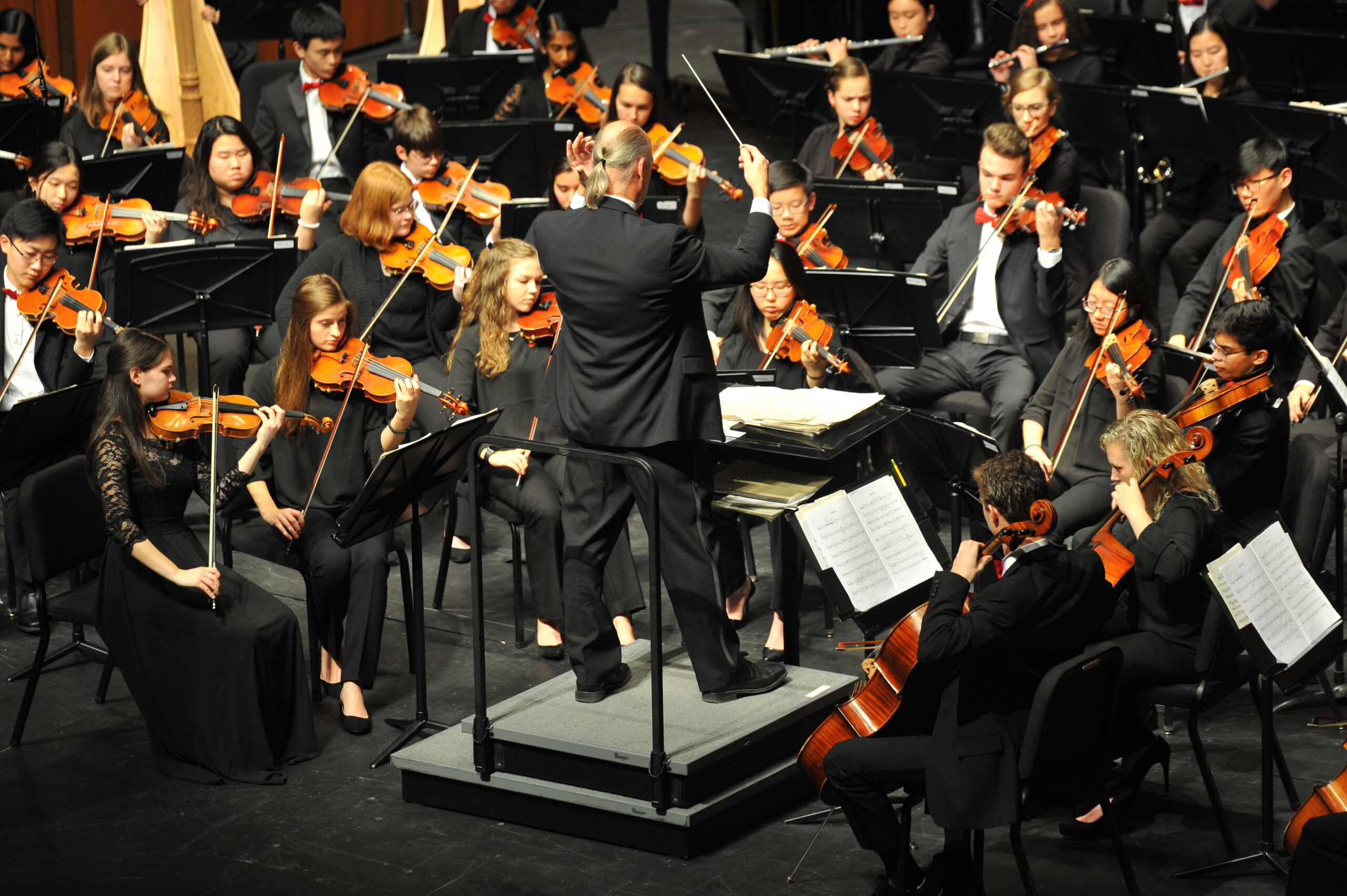
And it’s all happening on Wednesday nights, which are free and open to the public thanks to the ongoing support of generous sponsors Bank of America, the Mint Museum Auxiliary, and Publix Supermarket Charities.
“Live at the Mint is a project that the museum has initiated in order to create layered and diverse cultural programs for our visitors in collaboration with arts partners throughout the city,” says The Mint Museum President and CEO Todd A. Herman, PhD. “It was important to us that these happen on Wednesday nights, when the Mint is free to the public, so that we can become a positive cultural destination for anyone and everyone.”
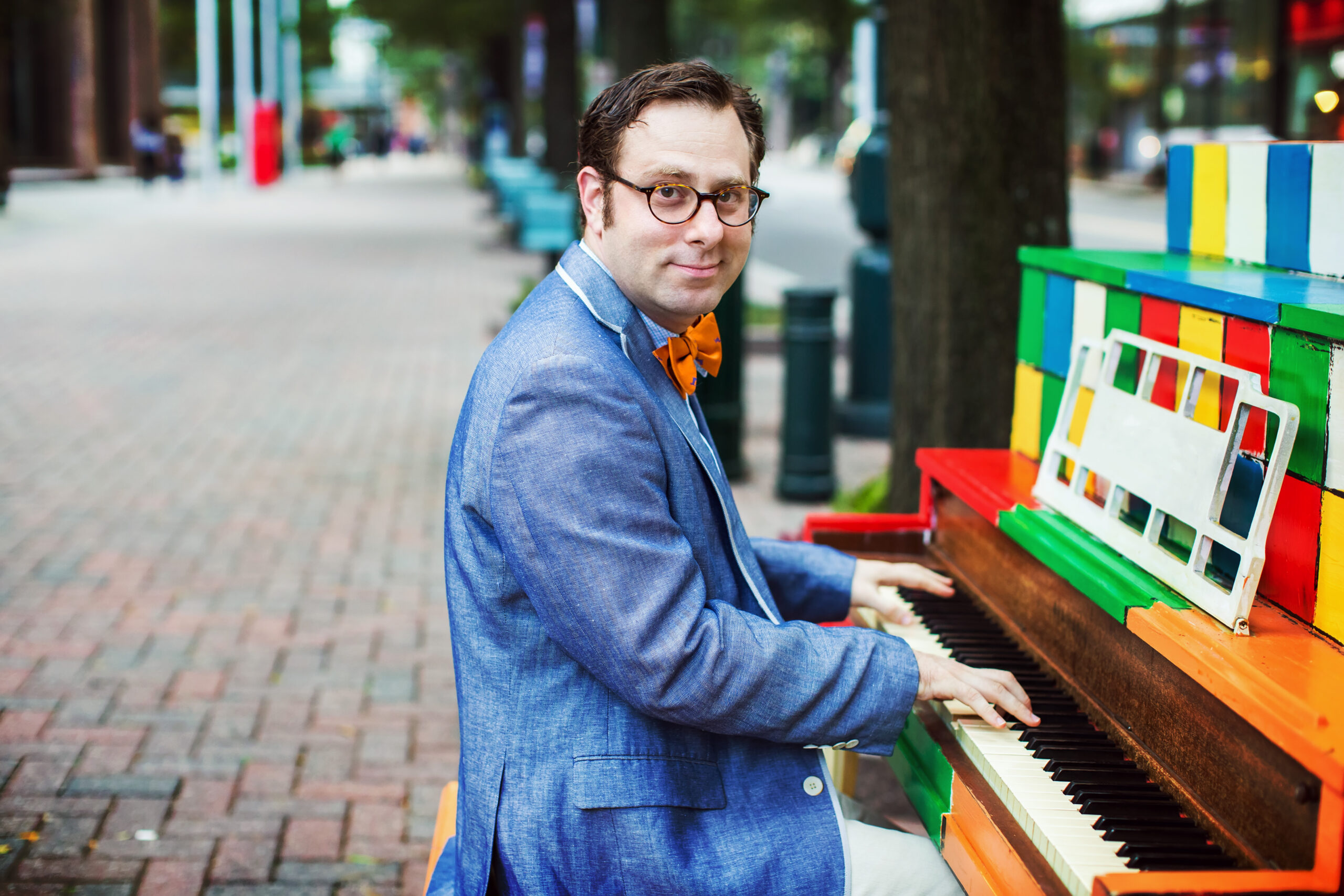 It’s the perfect time to come to Mint Museum Uptown, as two new special exhibitions have opened in the last month. Immersed in Light: Studio Drift at the Mint features breathtaking sculptures that show the intersection of art, technology and nature (think: massive glass wings that imitate the movement of a bird). And Coined in the South, which opened Oct. 10, features 64 works from some of the most innovative and emerging artists in the Southeast. Organized in partnership with the Young Affiliates of the Mint, Coined in the South features everything from the traditional (oil on canvas and collage) to the decidedly untraditional (one sculpture is made from steel saw dust, alpaca fur, and alligator skin).
It’s the perfect time to come to Mint Museum Uptown, as two new special exhibitions have opened in the last month. Immersed in Light: Studio Drift at the Mint features breathtaking sculptures that show the intersection of art, technology and nature (think: massive glass wings that imitate the movement of a bird). And Coined in the South, which opened Oct. 10, features 64 works from some of the most innovative and emerging artists in the Southeast. Organized in partnership with the Young Affiliates of the Mint, Coined in the South features everything from the traditional (oil on canvas and collage) to the decidedly untraditional (one sculpture is made from steel saw dust, alpaca fur, and alligator skin).
“Fifth Third is proud to be the presenting partner for this exciting new series,” says Lee Fite, Fifth Third Bank regional president of the Mid Atlantic. “Live at the Mint represents the same values we do – collaboration, inclusivity, and community.”
Interested in interviewing the artists, musicians, or anyone from the museum? Reach out to the Mint’s Director of Marketing & Communications, Caroline Portillo, at caroline.portillo@mintmuseum.org or call 704-337-2009.
Here’s a look at the Live at the Mint lineup: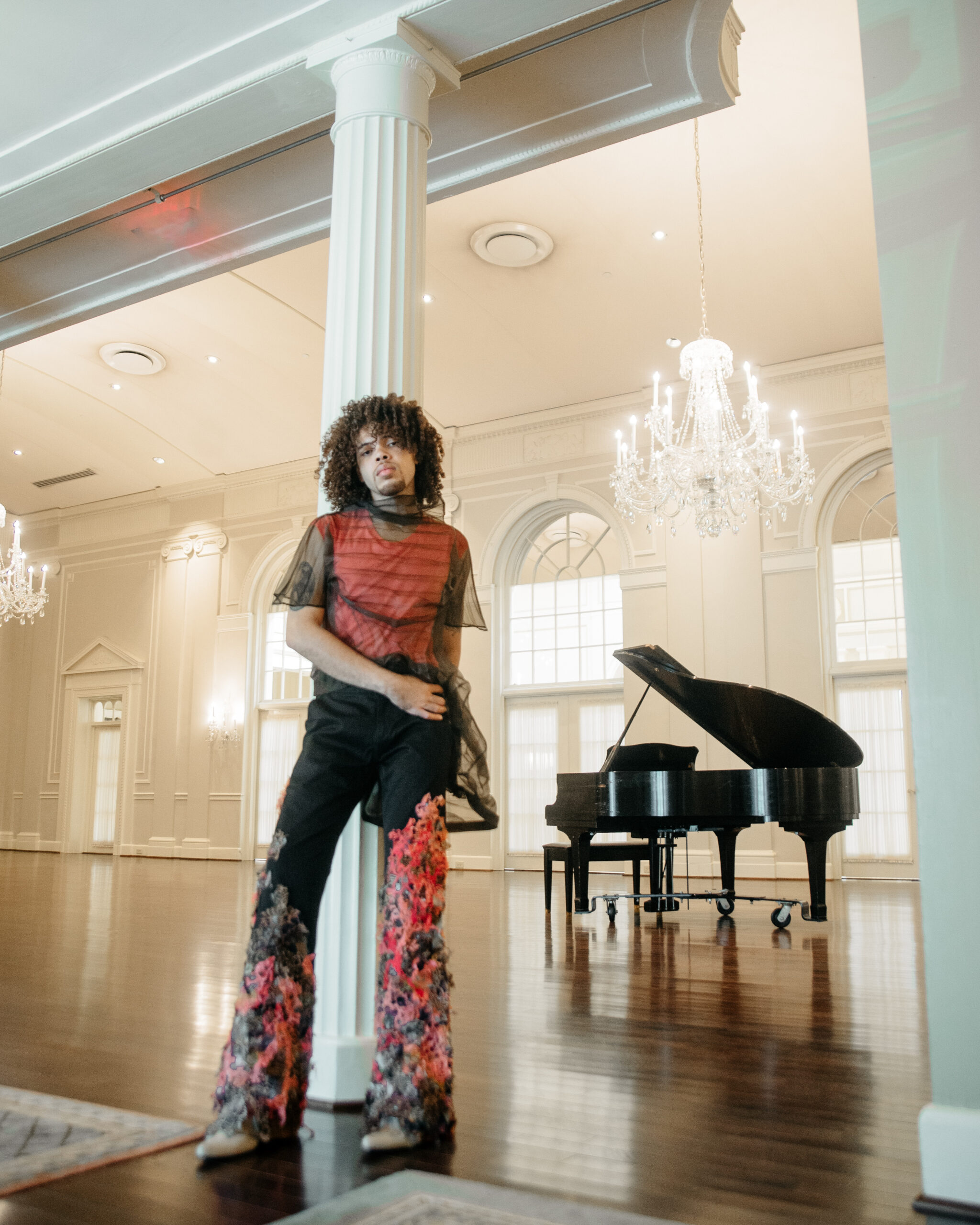
October 16
Enjoy a conversation with SC artist Dr. Leo Twiggs and Rabbi Judy Schindler, as they discuss how art can offer a safe space to discuss uncomfortable yet urgent current issues. Jazz ensemble Conversation Piece will play before and after the discussion. Twiggs made headlines for his work in the aftermath of the tragic 2015 murders at Mother Emanuel AME Church in Charleston.
October 23
Ever wished you knew how to swing dance? Join Gottaswing Charlotte for free instructions, followed by an evening of dancing.
October 30
The 90-piece Youth Orchestra of Charlotte will perform a selection of spooky symphonic masterpieces, followed by a screening of the 1982 horror film Poltergeist.
November 6
Couldn’t score tickets to Sir Elton’s farewell tour at Spectrum Center? Catch the next best thing on the same night, as Elton John impersonator Carl Rosen of Yellow Brick Road tribute band performs the Rocketman’s classics. Rose-colored glasses included.
November 13
Enjoy Buster Keaton’s classic silent film The Freshman, as the brilliant and award-winning Ethan Uslan accompanies on piano. In partnership with Charlotte Mecklenburg Library.
November 20
The lauded Charlotte Storytellers will perform four original works created in response to pieces on view in Immersed in Light: Studio Drift at the Mint and Coined in the South. This one-of-a-kind experience will help you bring fresh eyes to the stunning exhibitions.
November 27
No programming – Happy Thanksgiving!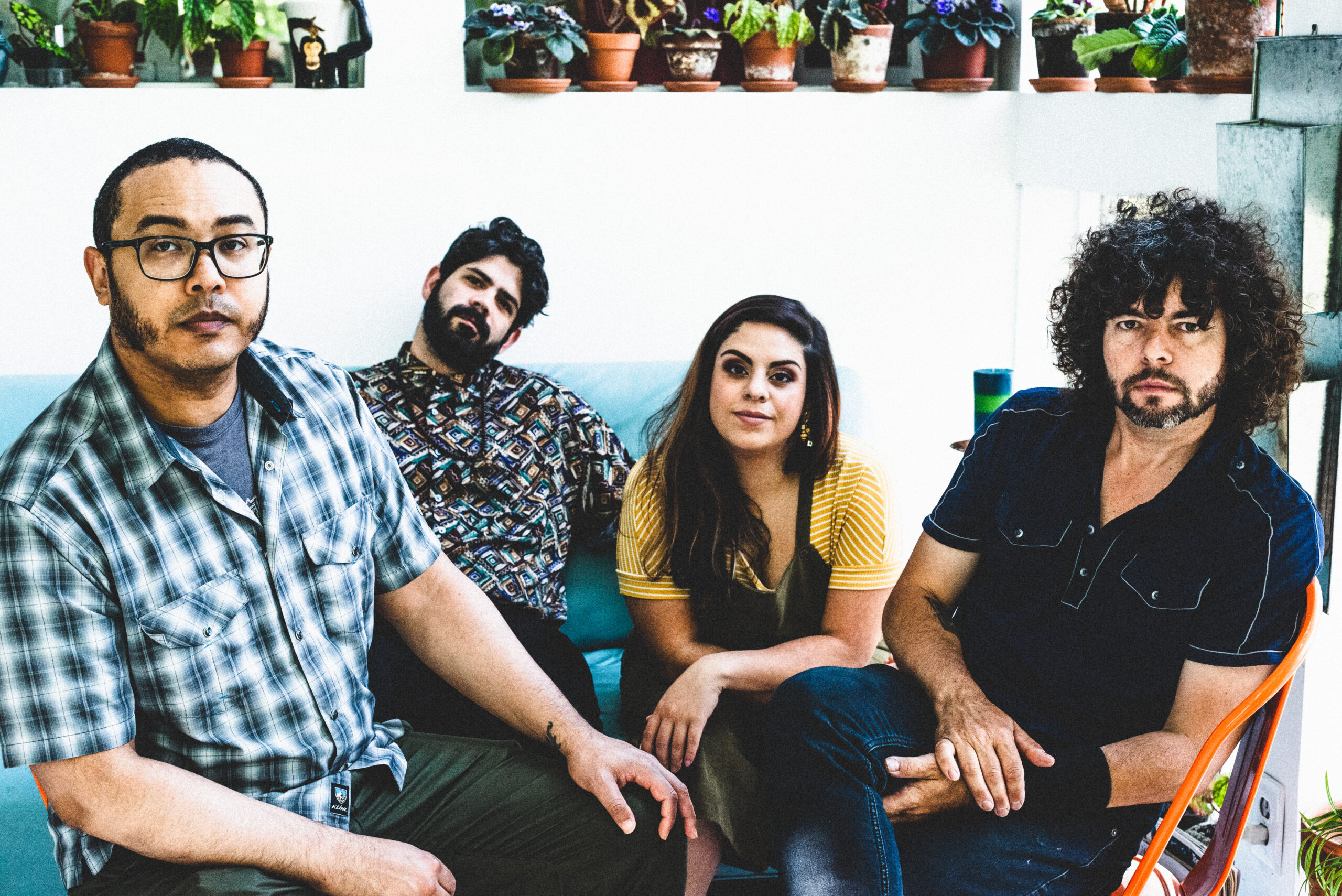
December 4
Relax and unwind with internationally renowned jazz vocalist MercuryCarter. It will be an evening of old standards and new songs destined to become classics.
December 11
Enjoy the inventive sound of Latin fusion band Chócala, as they ride the tide of their new record release this fall.
About The Mint Museum
Established in 1936 as North Carolina’s rst art museum, The Mint Museum is a leading, innovative cultural institution and museum of international art and design. With two locations—Mint Museum Randolph in the heart of Eastover and Mint Museum Uptown on South Tryon Street—the Mint boasts one of the largest collections in the Southeast and is committed to engaging and inspiring members of the global community.
About Fifth Third
Fifth Third Bancorp is a diversified financial services company headquartered in Cincinnati, Ohio and the indirect parent company of Fifth Third Bank, an Ohio-chartered bank. As of June 30, 2019, Fifth Third had $169 billion in assets and operated 1,207 full-service Banking Centers and 2,551 ATMs with Fifth Third branding in Ohio, Kentucky, Indiana, Michigan, Illinois, Florida,
Tennessee, West Virginia, Georgia and North Carolina. In total, Fifth Third provides its customers with access to approximately 53,000 fee-free ATMs across the United States. Fifth Third operates four main businesses: Commercial Banking, Branch Banking, Consumer Lending and Wealth & Asset Management. Fifth Third is among the largest money managers in the Midwest and, as of June 30, 2019, had $399 billion in assets under care, of which it managed $46 billion for individuals, corporations and not-for- pro t organizations through its Trust and Registered Investment Advisory businesses. Investor information and press releases can be viewed at www.53.com. Fifth Third’s common stock is traded on the Nasdaq® Global Select Market under the symbol “FITB.” Fifth Third Bank was established in 1858. Deposit and Credit products are offered by Fifth Third Bank. Member FDIC.
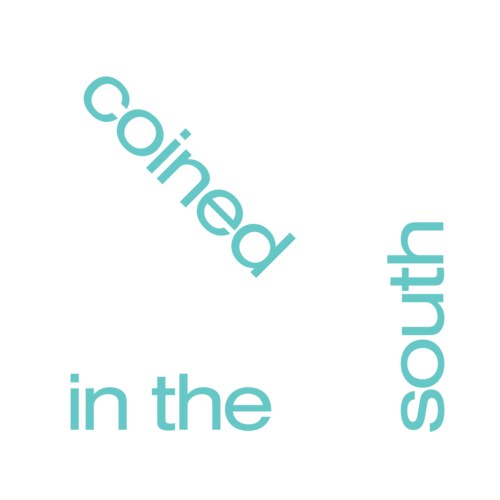
Major juried exhibition with $16,000 in cash prizes to open on Oct. 10 at The Mint Museum
Charlotte, NC (October 1, 2019): The Mint Museum is pleased to announce its upcoming presentation of Coined in the South, a major juried exhibition with $16,000 in cash prizes that will showcase some of the most innovative and emerging artists in the Southeast. Organized in partnership with the Young Affiliates of the Mint, the show will be on view from October 10, 2019 through February 16, 2020 in Mint Museum Uptown’s Level 4 Brand Special Exhibition Galleries.
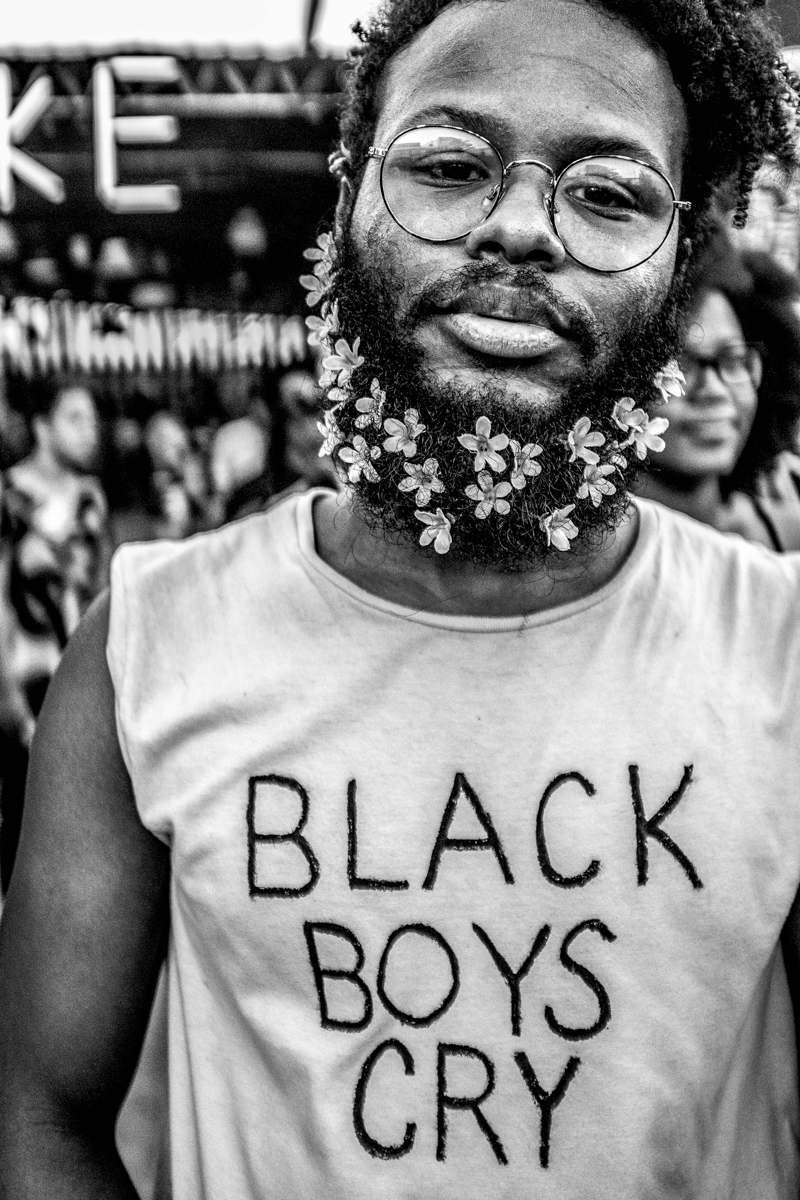
Ken West. Black Boys Cry, 2018, metallic paper. Courtesy of the artist.
The purpose of the exhibition is simple: to bridge the gap between the museum, gallery and studio, and to present fresh and innovative works that have not yet been seen by a broader audience. Nearly 2,000 works of art were submitted for consideration; 65 were selected. The artists range in age from 23 years old to 82 years old, and hail from North Carolina, South Carolina, Georgia, Tennessee, and Virginia.
Unconfined to any aesthetic, the works of art are made from materials ranging from the traditional (oil on canvas and collage) to the decidedly untraditional. Consider one piece made from concrete, brass-plated chains, and human hair, or another made from steel saw dust, alpaca fur, and alligator skin. Some explore personal and familial histories, while others explore notions of place and identity. Some are gurative, others abstract. They evoke humor, tenderness, whimsy, and awe.
The 65 works were selected by jurors Adam Justice, Jonell Logan, and Marilyn Zapf—all well respected in uencers in the southeast’s art scene. On the night of the opening, Oct. 10, the jurors will announce the $10,000 Atrium Health Prize, and the Young Af liates of the Mint (better known as the YAMs), will award a $5,000 winner. Over the next few months, visitors will have the opportunity to vote in the gallery on the $1,000 “People’s Choice” award, which will be named at the end of the year.
“One of the roles of a museum is to reflect the pulse and energy of the artistic community where it resides,” says The Mint Museum’s President and CEO Todd A. Herman, PhD. “Coined in the South shines a spotlight on the quality, themes, and diversity of narratives that are being generated by artists in our own backyard.”
The name Coined in the South refers to both The Mint Museum’s origins as the first branch of the U.S. Mint, as well as to the act of inventing. Many of the artists have created works so unforgettable they’re in a class all their own.
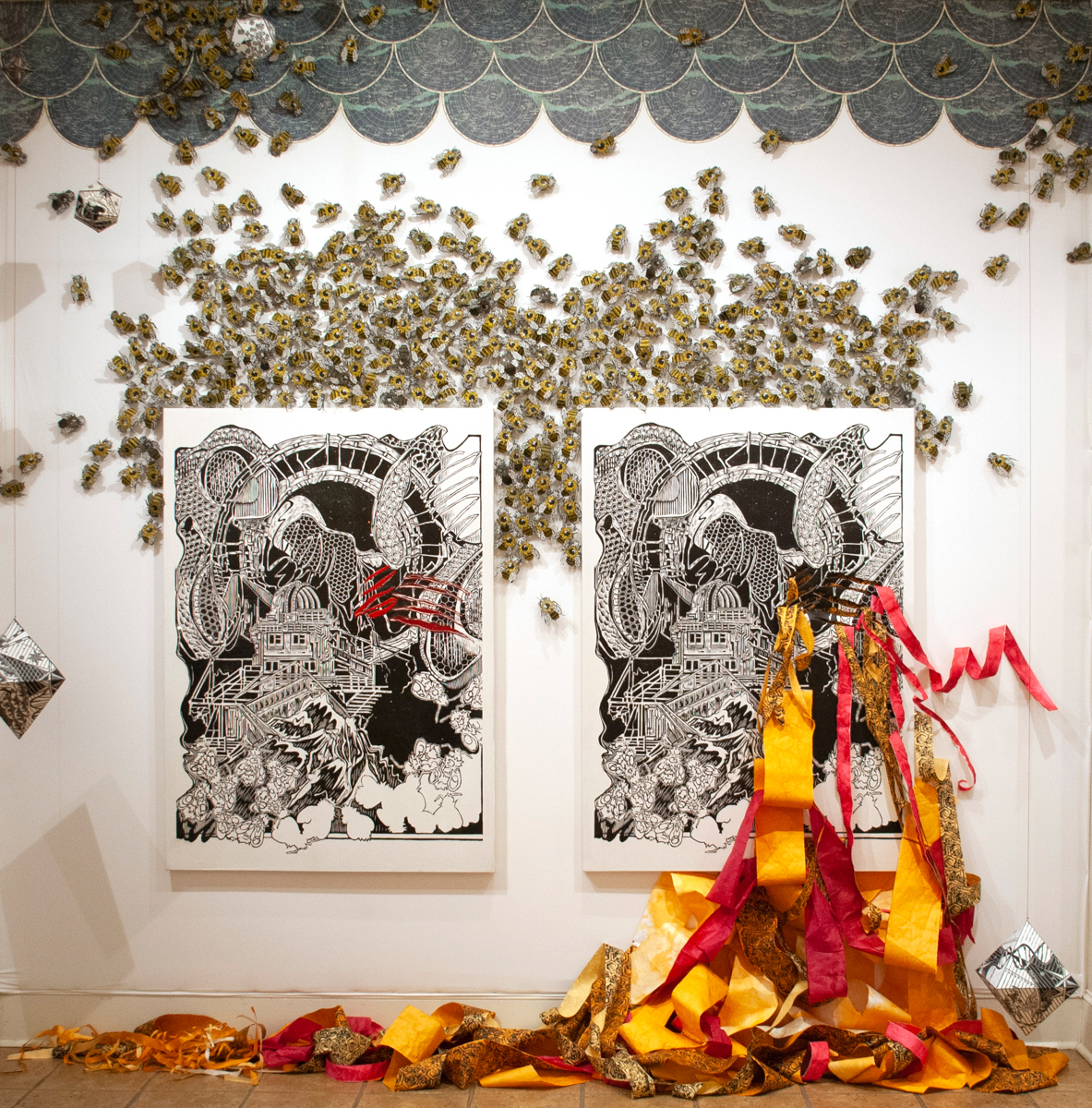
Adrian Rhodes. Searching for Callisto (detail), 2018, woodcut print installation with dyed paper and sky chart wall collage. Courtesy of the artist.
This is the fourth juried exhibition put on by the YAMs, following on the successes of 80×80 (2016), Gendered (2017), and Mainframe (2018). These exhibitions revived a tradition of the museum—from the 1950s through the 1990s, the Mint hosted a number of juried shows, highlighting the work of talented local artists.
“When we sat down and cooked up the idea for 80×80, the Young Affiliates’ inaugural art show in 2016, we had no idea what would unfold,” says Lauren Harkey, former president of the YAMs and co-creator of the YAMs inaugural art show.
“We were instantly humbled by the response and energy our ‘little show that could’ created. And today, in its fourth iteration, it is a proud moment to see the YAMs partner with The Mint Museum and witness this show really grow up and into its own.”
Senior Curator of American Art Jonathan Stuhlman, PhD, served as the Mint’s curator of the show. Kaitlyn McElwee and Anna Hamer served as the YAMs art show co-chairs.
Coined in the South is generously sponsored by Atrium Health, with additional support from Cran ll Sumner & Hartzog LLP.
Interested in interviewing artists, show organizers, jurors, or anyone from the museum? Reach out to the Mint’s Director of Marketing & Communications, Caroline Portillo, at caroline.portillo@mintmuseum.org or call 704-337-2009.
About The Mint Museum
Established in 1936 as North Carolina’s rst art museum, The Mint Museum is a leading, innovative cultural institution and museum of international art and design. With two locations—Mint Museum Randolph in the heart of Eastover and Mint Museum Uptown on South Tryon Street—the Mint boasts one of the largest collections in the Southeast and is committed to engaging and inspiring members of the global community.
About the Young Affiliates of the Mint (YAMs)
The Young Af liates of the Mint (the “YAMs”) is a diverse group of young professionals promoting and supporting The Mint Museum through cultural engagement, social leadership, and fundraising events. Established in 1990, the YAMs are the premier social arts organization for young professionals in Charlotte. All proceeds raised by the YAMs sponsor free tours of The Mint Museum for local school students to inspire a new generation of artists, art enthusiasts, and leaders.
Deighton Abrams (Seneca, SC)
Eleanor Annand (Penland, NC)
Yvette L. Cummings Arendt (Conway, SC)
Austin Ballard (Charlotte, NC)
Johannes Barfield (Winston-Salem, NC)
Ivana Milojevic Beck (Raleigh, NC)
Susan Brenner (Charlotte, NC)
Amanda Britton (Athens, GA)
Danielle Burke (Asheville, NC)
Thomas Campbell (Penland, NC)
Erin Canady (Durham, NC)
Micah Cash (Charlotte, NC)
Erin Castellan (Penrose, NC)
Kevin Cole (Fairburn, GA)
Sarah Elizabeth Cornejo (Carrboro, NC)
Travis Donovan (Banner Elk, NC)
Robert Fritsche (Huntersville, NC)
Riley Hammond (Richmond, VA)
Caroline Hatfield (Carrolton, TX (formerly Claiborne County, TN)
Donna Cooper Hurt (Charleston, SC)
Joyce Watkins King (Raleigh, NC)
Kenn Kotara (Asheville, NC)Nathaniel Lancaster (Charlotte, NC)
Jasper Lee (Birmingham, AL)
Elizabeth Lide (Atlanta, GA)
Jackson Martin (Asheville, NC)
Rachel Meginnes (Bakersville, NC)
Chieko Murasugi (Chapel Hill, NC)
Claire Pope (Hickory, NC)
Chloé Rager (Durham, NC)
Adrian Rhodes (Hartsville, SC)
Kristi Ryba (Charleston, SC)
Katie St. Clair (Davidson, NC)
Tom Schmidt (Charlotte, NC)
MJ Sharp (Durham, NC)
Beverly Smith (Charlotte, NC)
Tema Stauffer (Johnson City, TN)
Denise Stewart-Sanabria (Knoxville, TN)
Stephanie Sutton (Buford, GA)
Harrison Walker (Athens, GA)
Jan-Ru Wan (Chapel Hill, NC)
Shane Ward (Chattanooga, TN)
Ken West (Mableton, GA)
Fletcher Williams, III (North Charleston, SC)
Stephanie J. Woods (Charlotte, NC)
The Mint Museum to Play Host to Nike and Jordan Brand NBA All-Star Weekend Events
North Carolina’s first art museum joins forces with Nike and Jordan Brand as Charlotte hosts the biggest event in basketball.
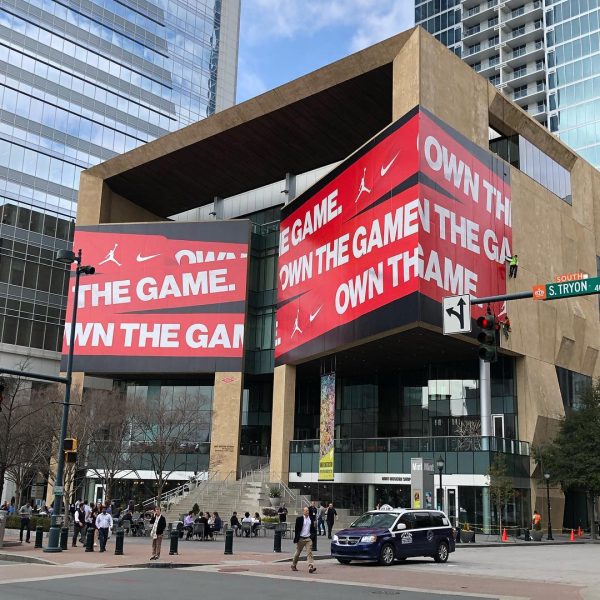
Image from Instagram user @yelocab01
Visitors, staff will focus on Mint Museum Randolph during interval
Mint Museum Uptown, a soaring architectural marvel in the heart of Levine Center for the Arts, must close its doors to the public from July 10 through approximately August 17, 2018. The closure is necessary to refinish the building’s heavily-visited hardwood floors for the first time since the building opened to the public in 2010. (more…)
